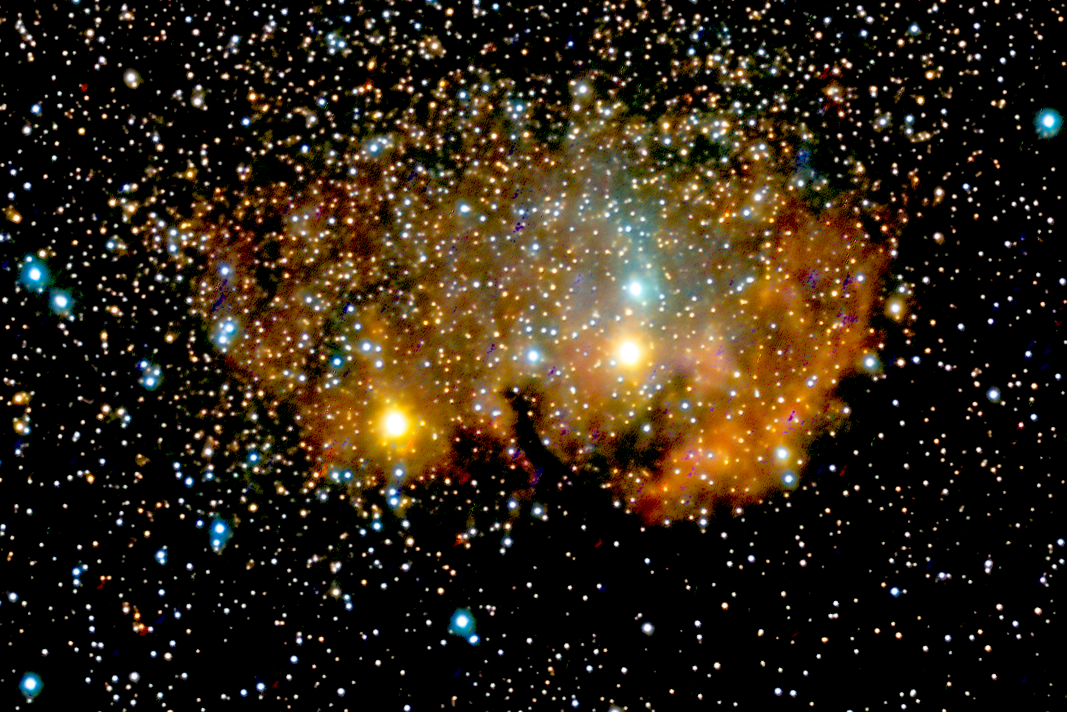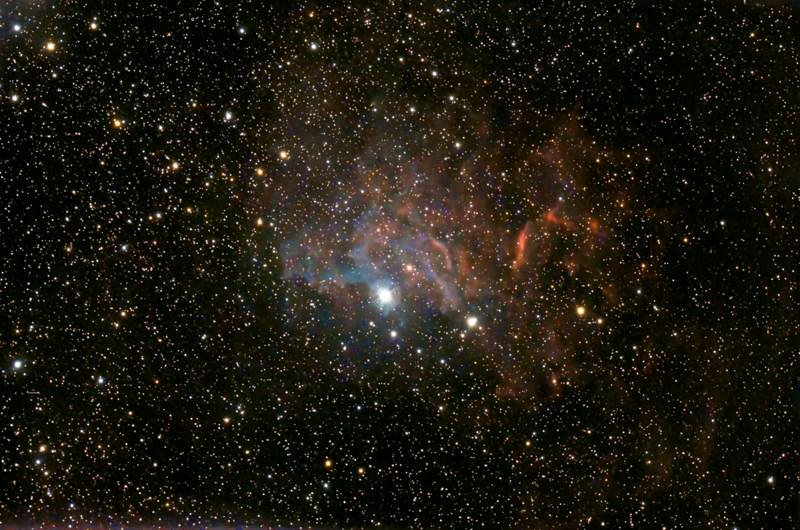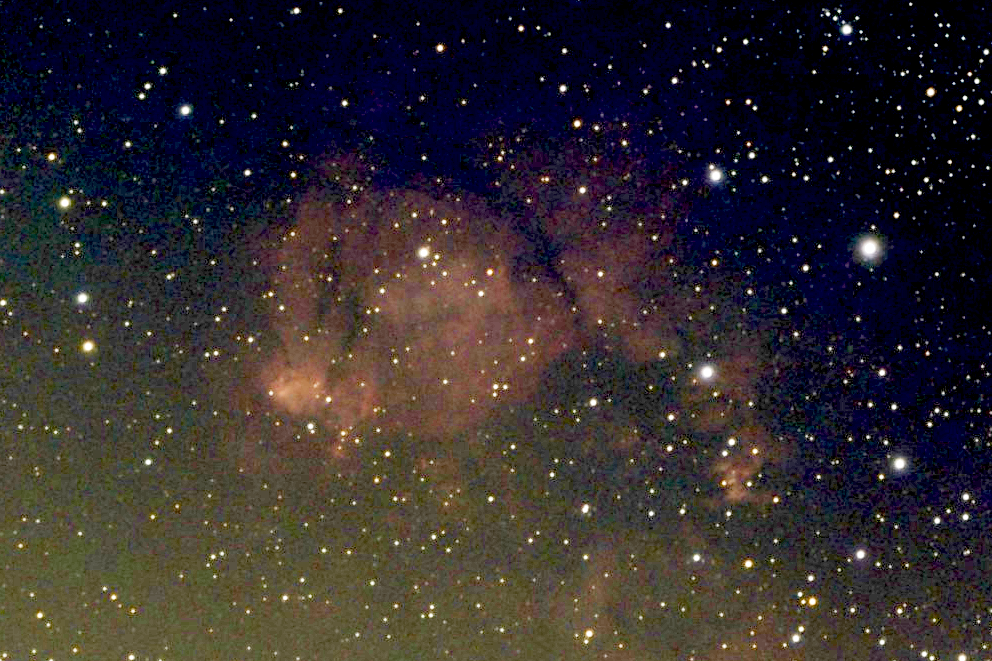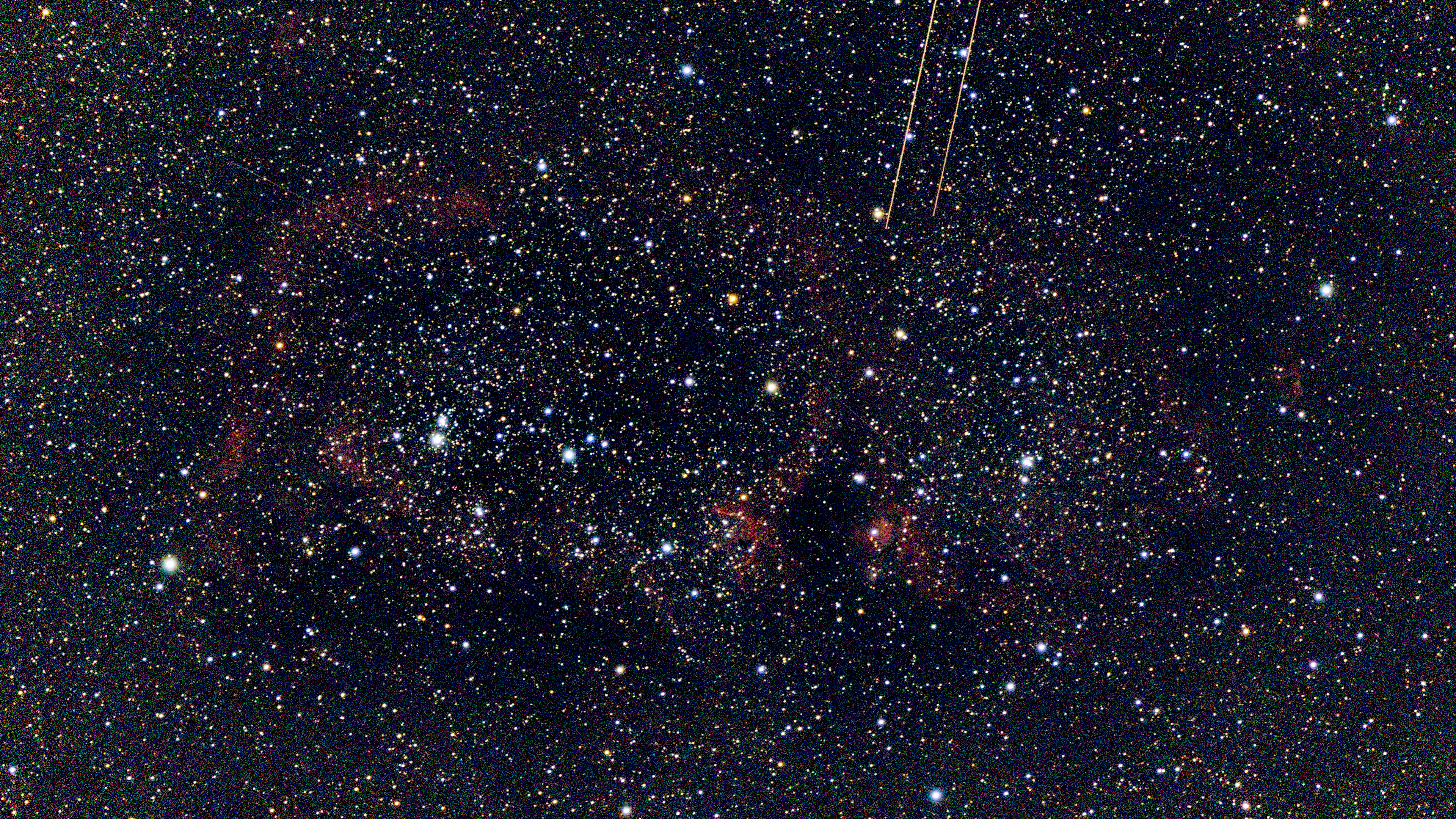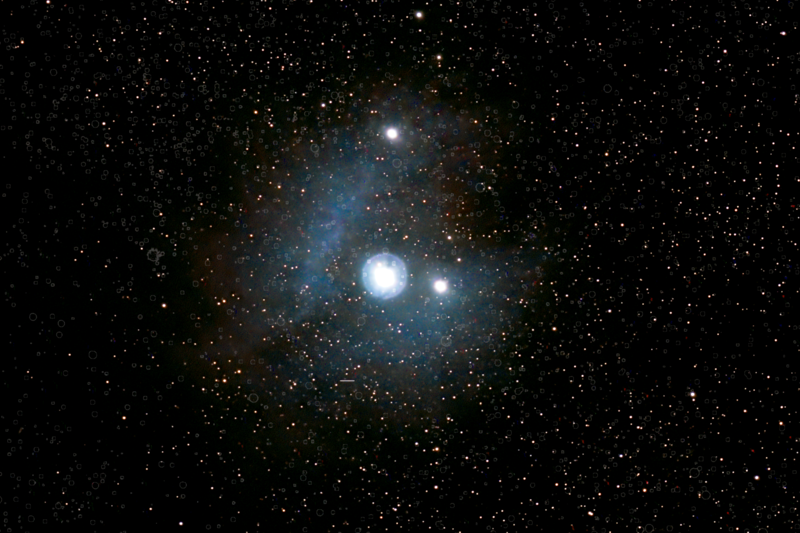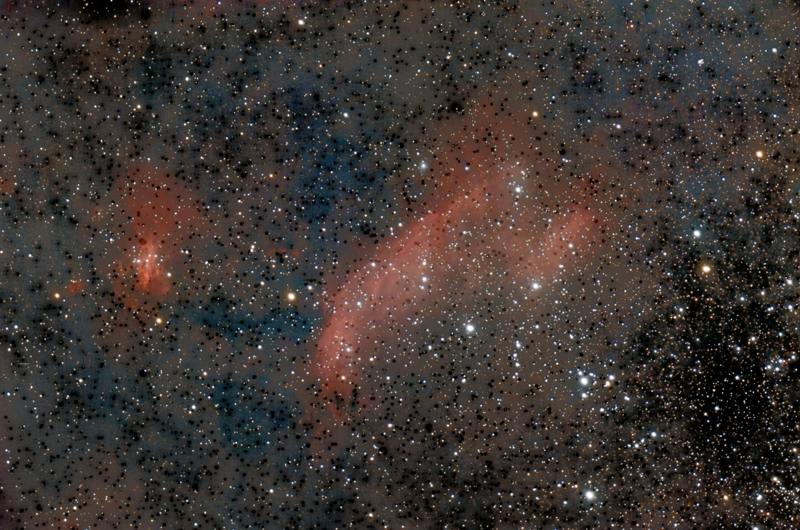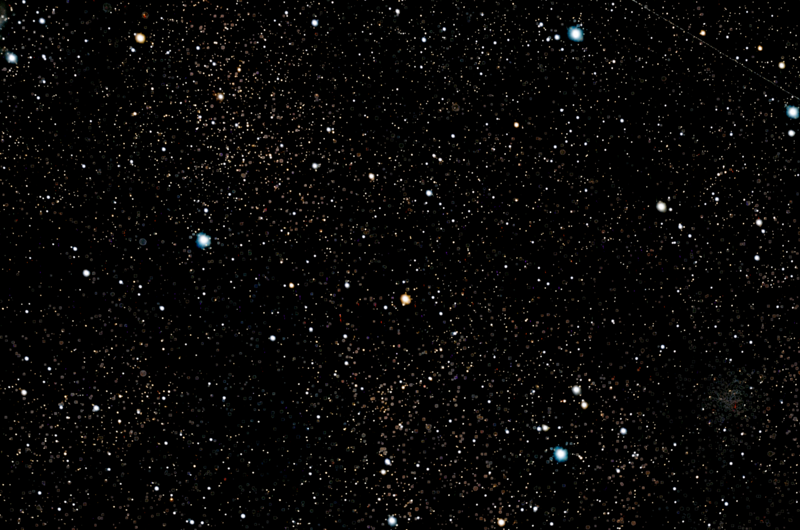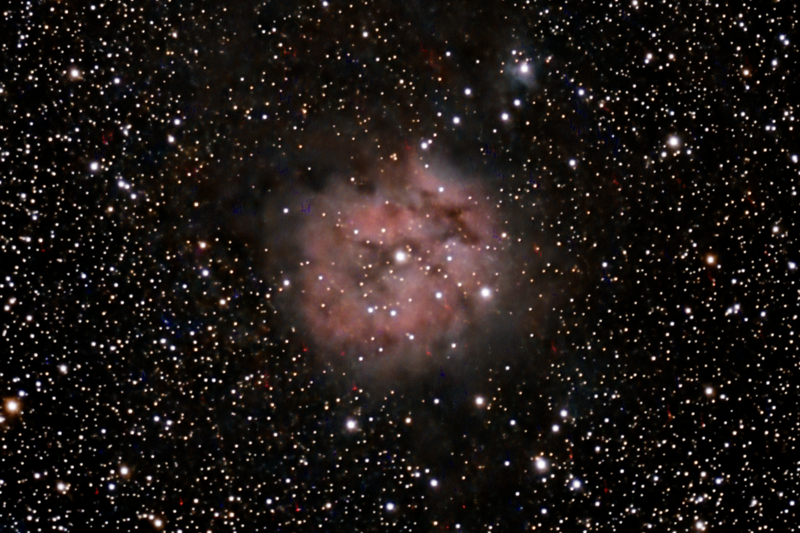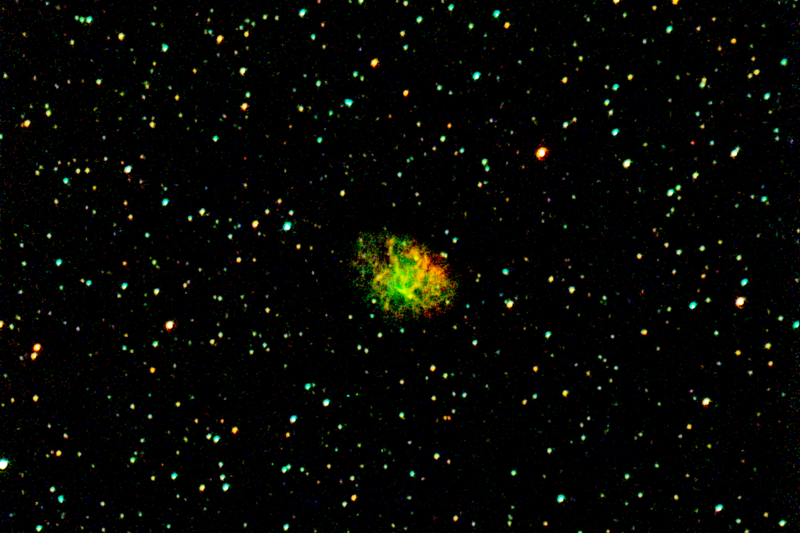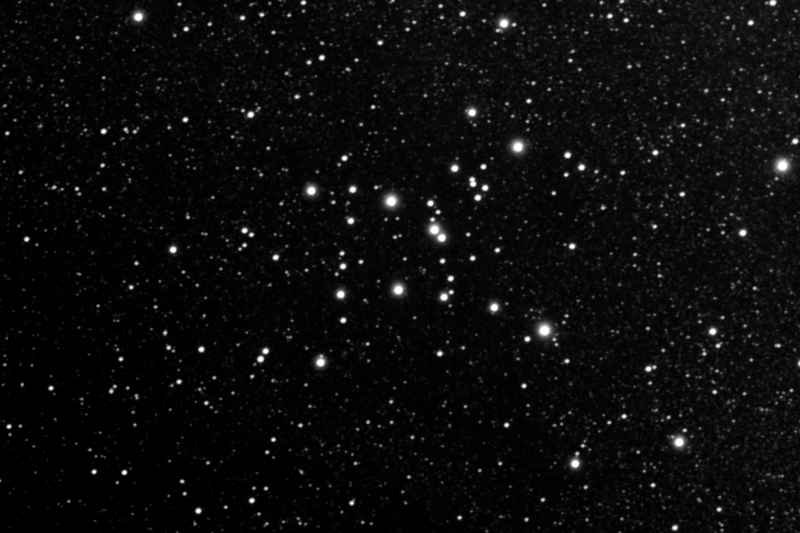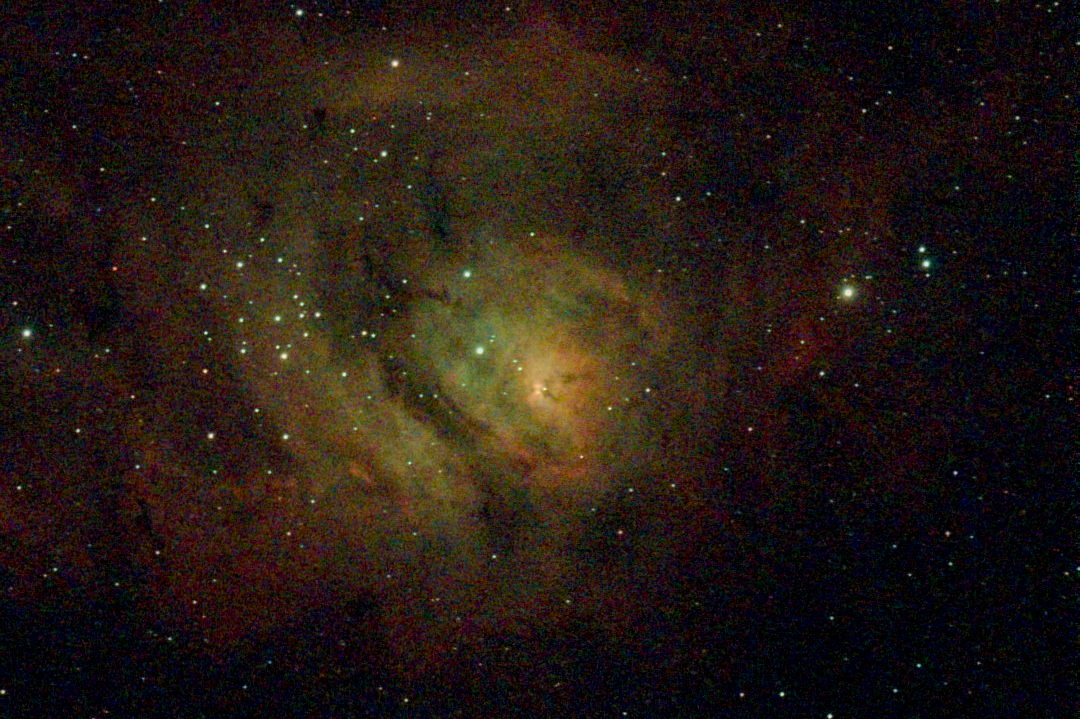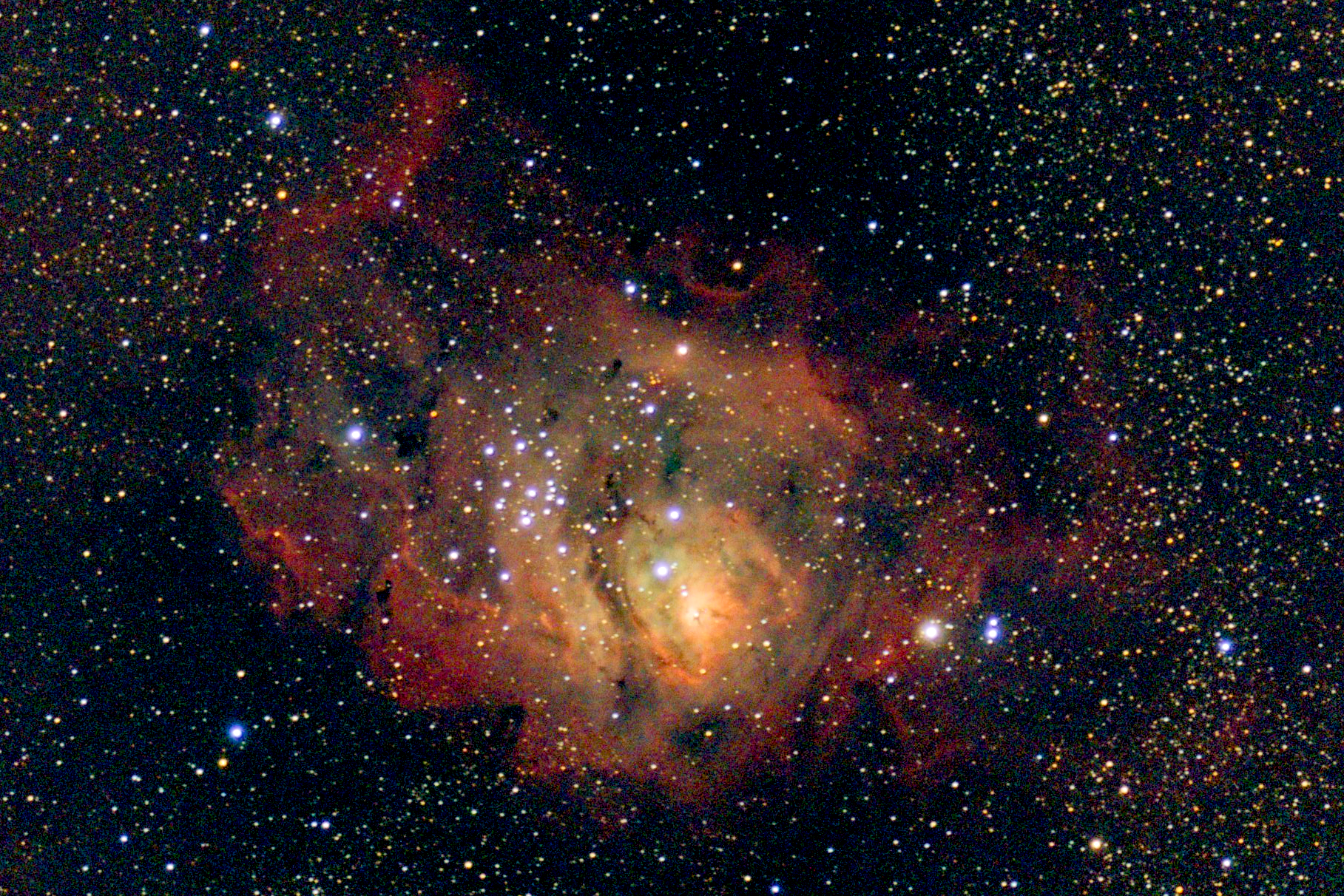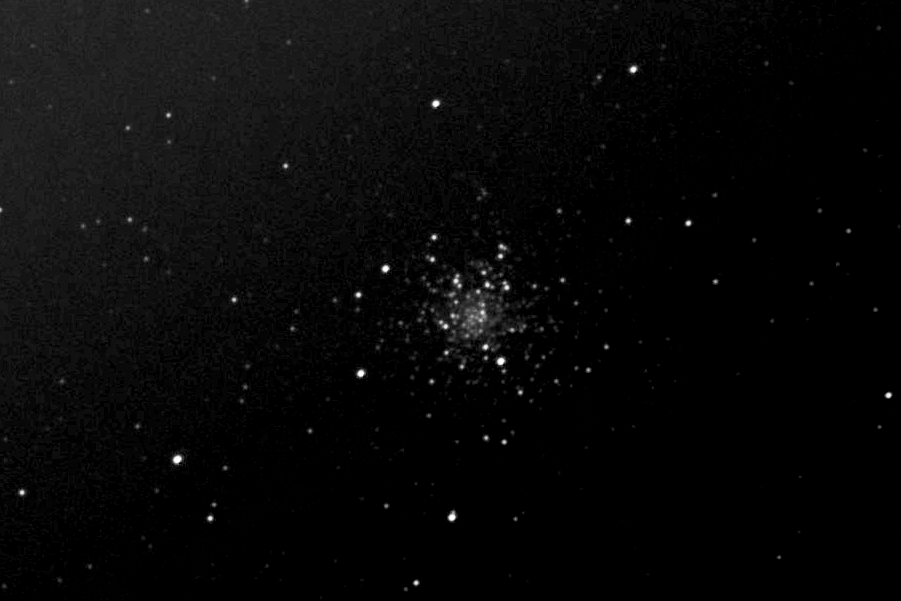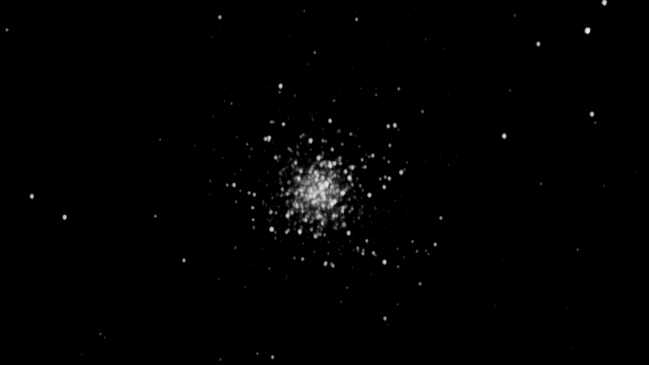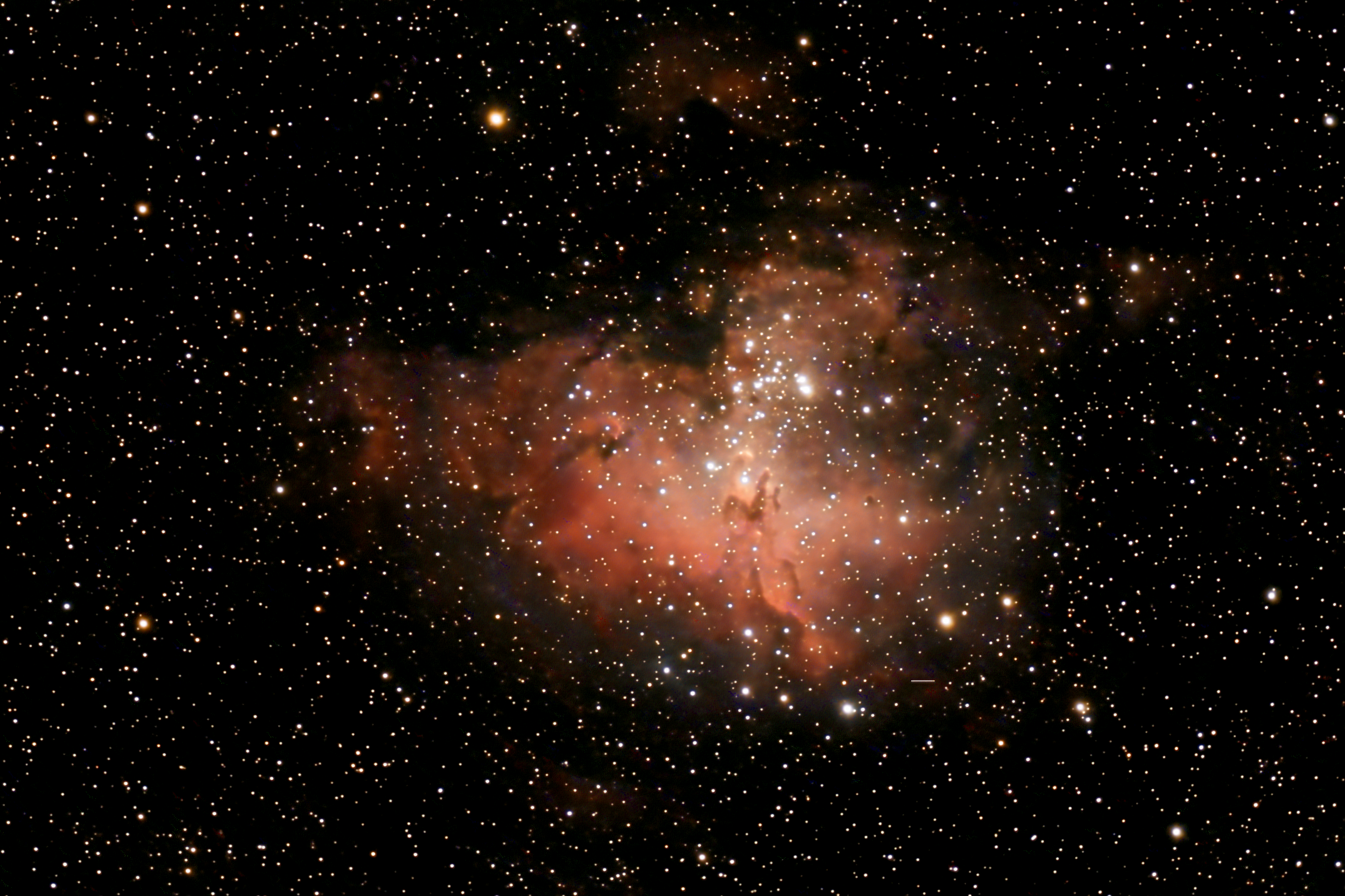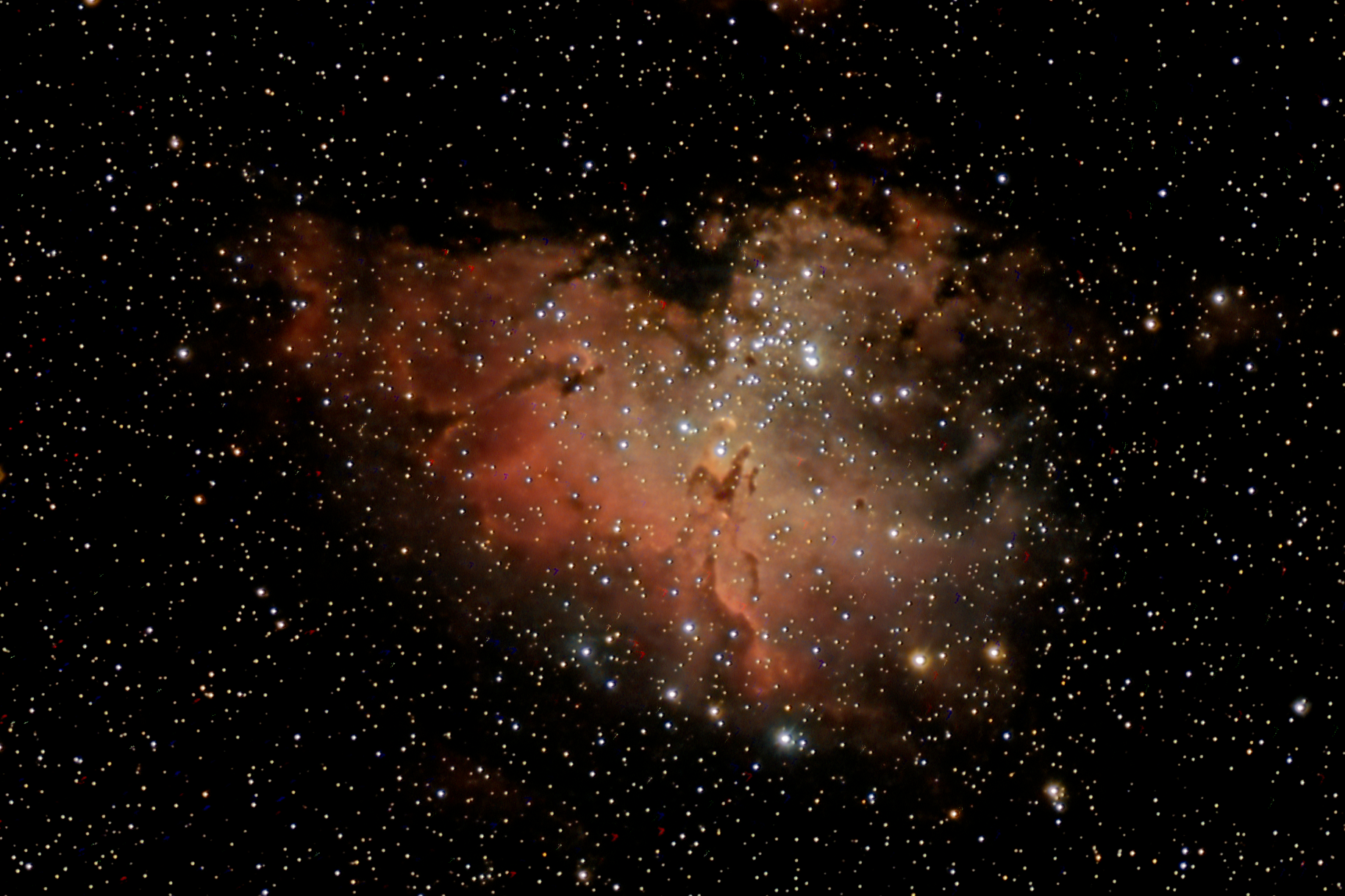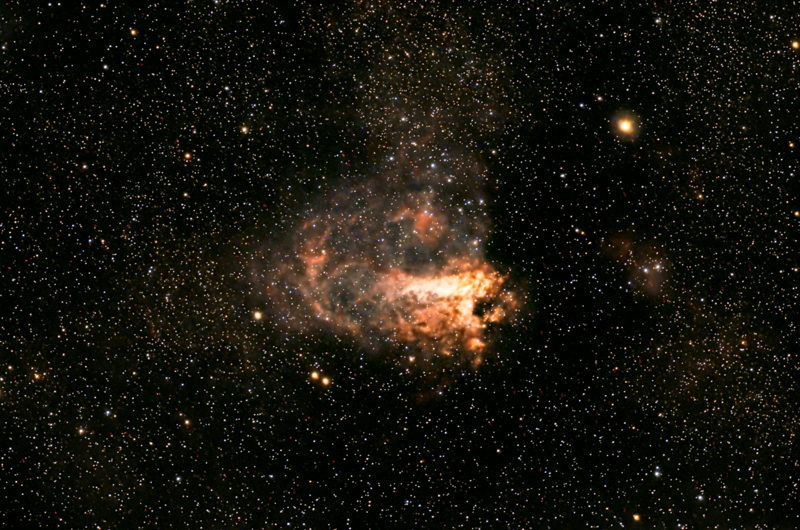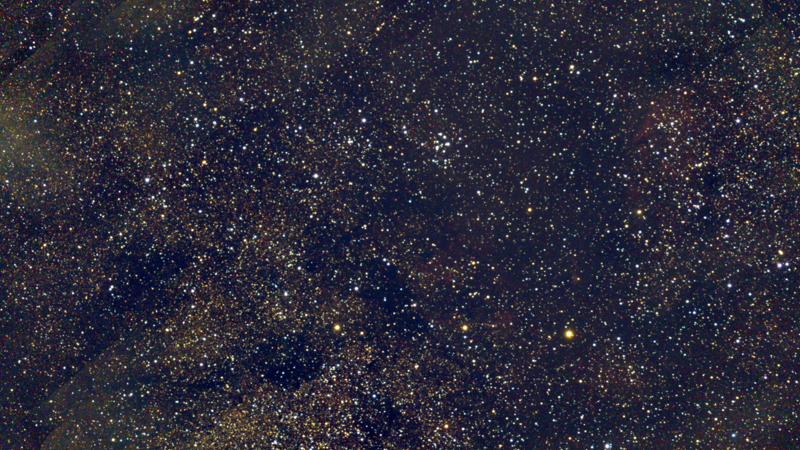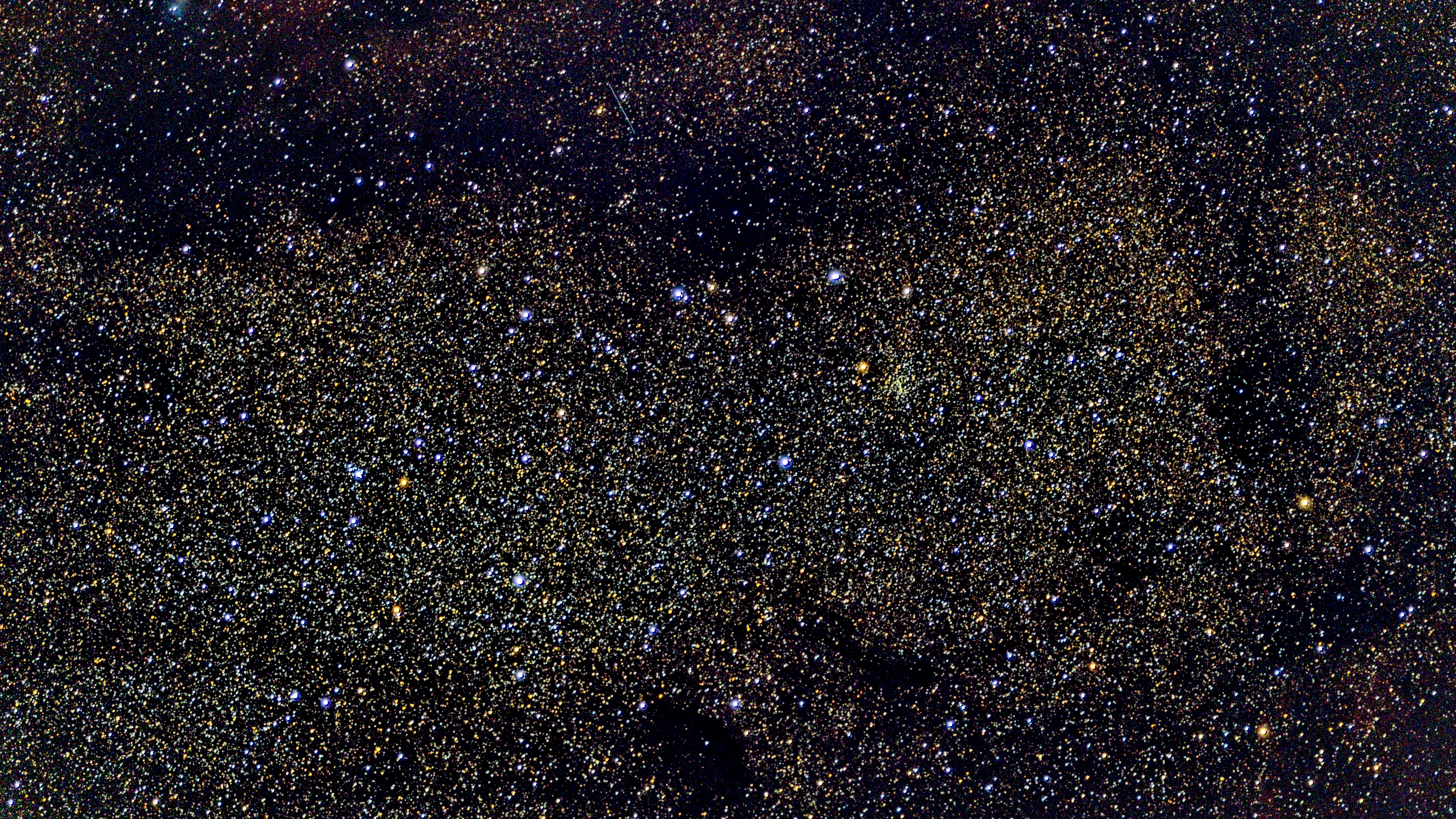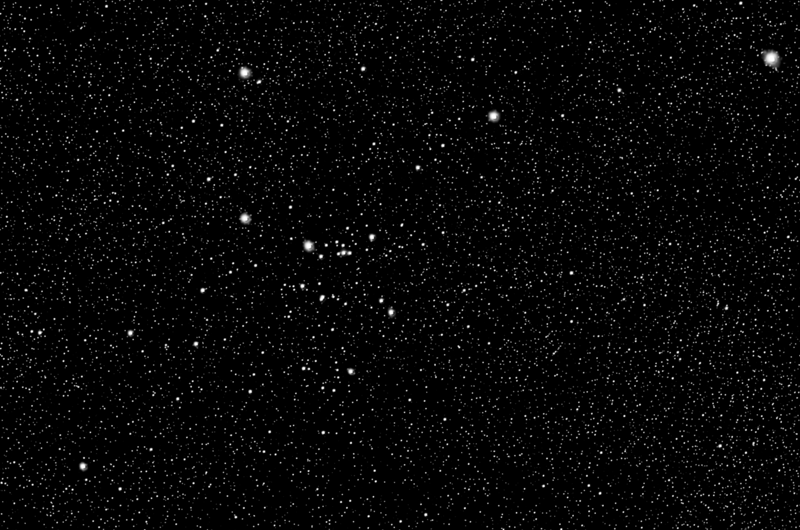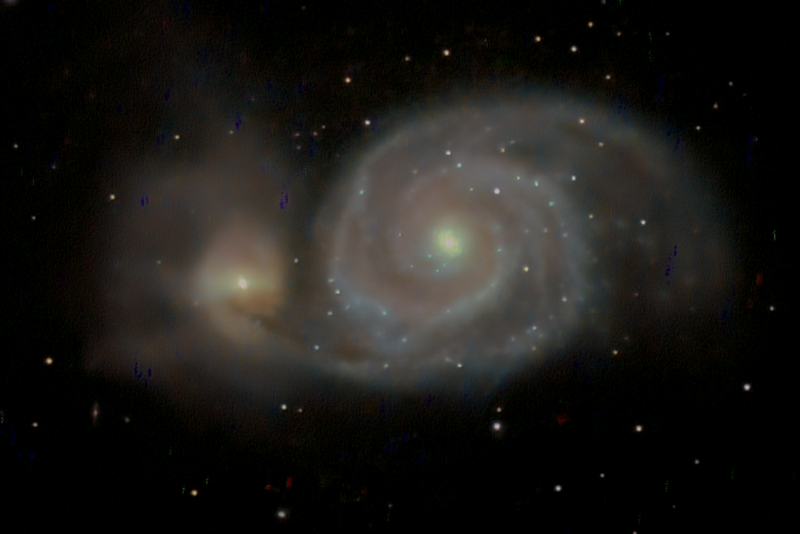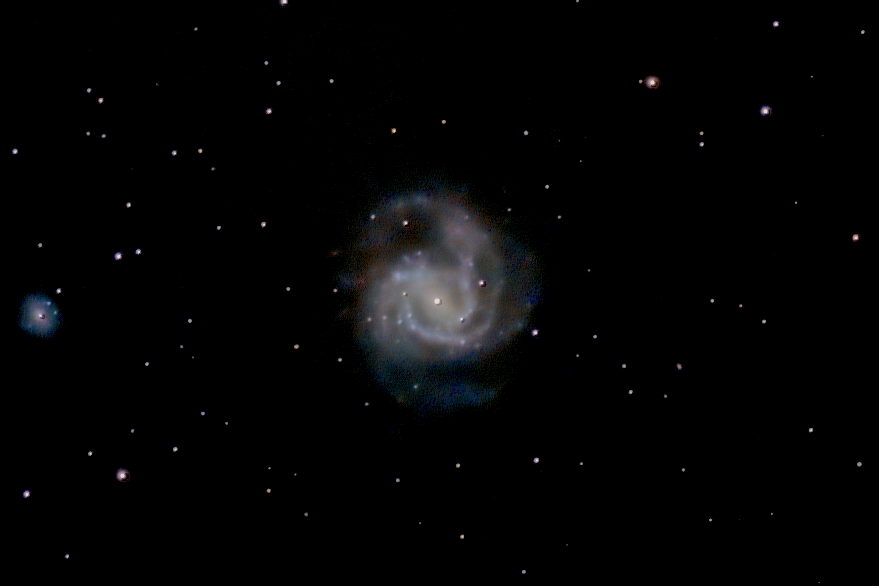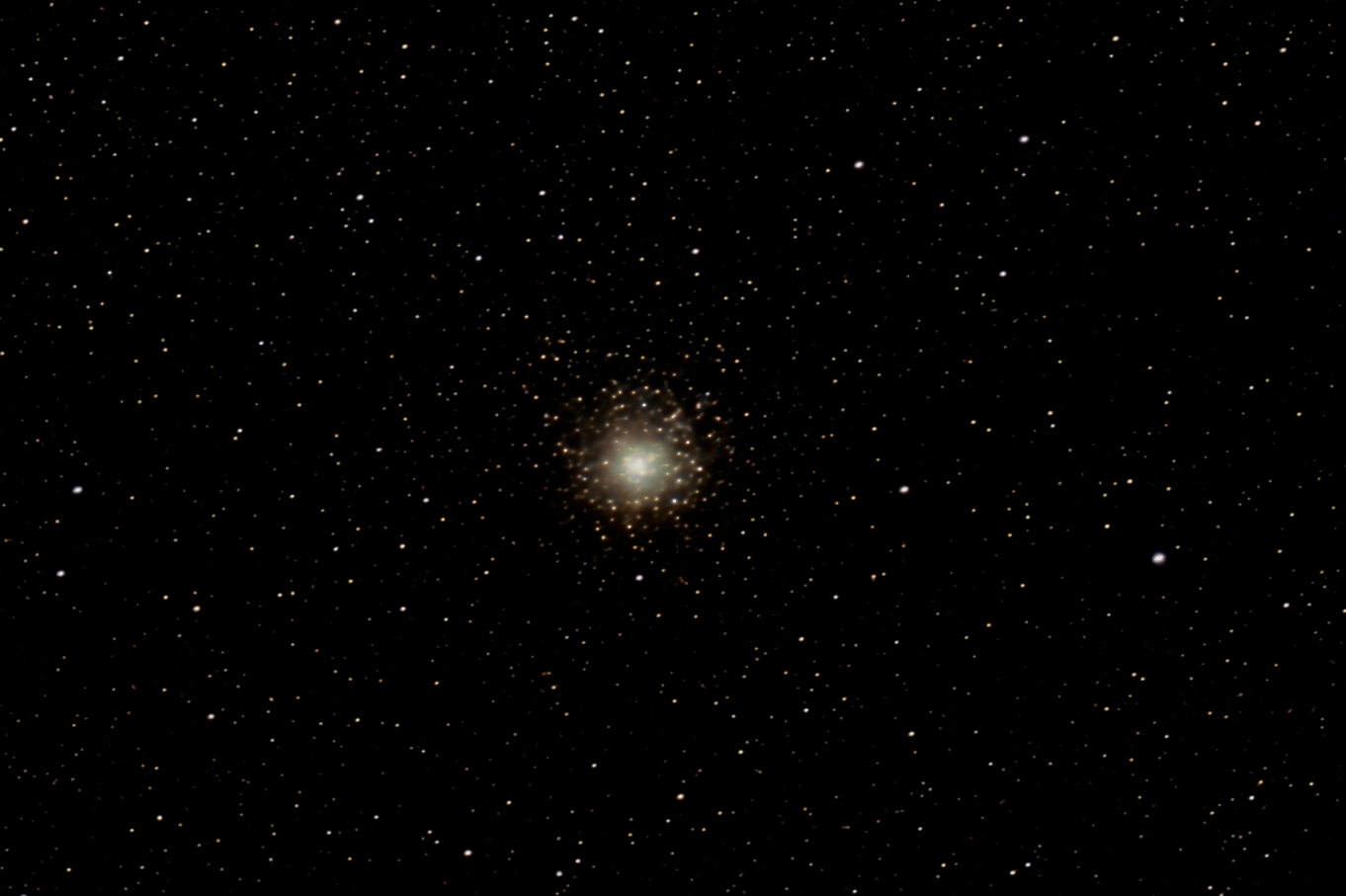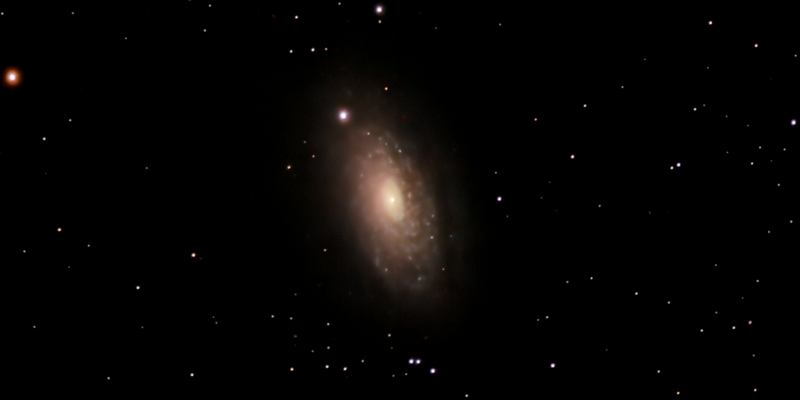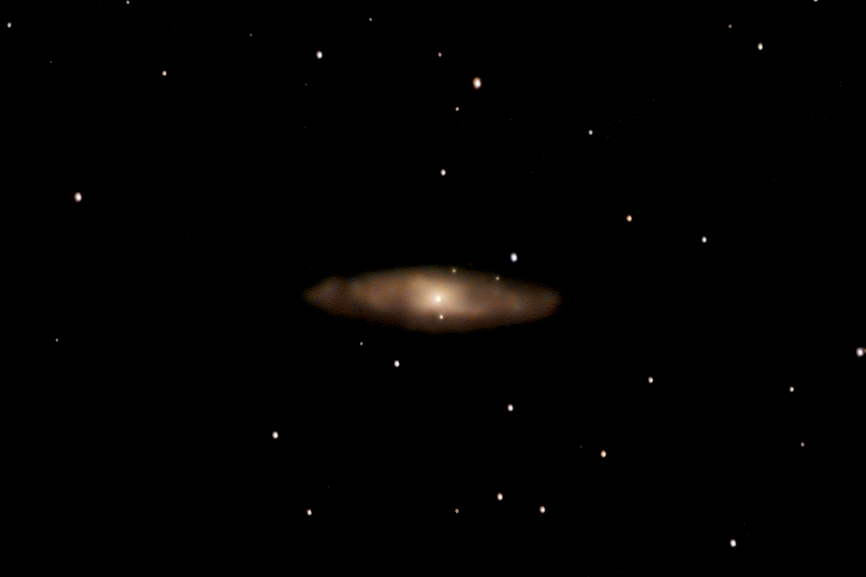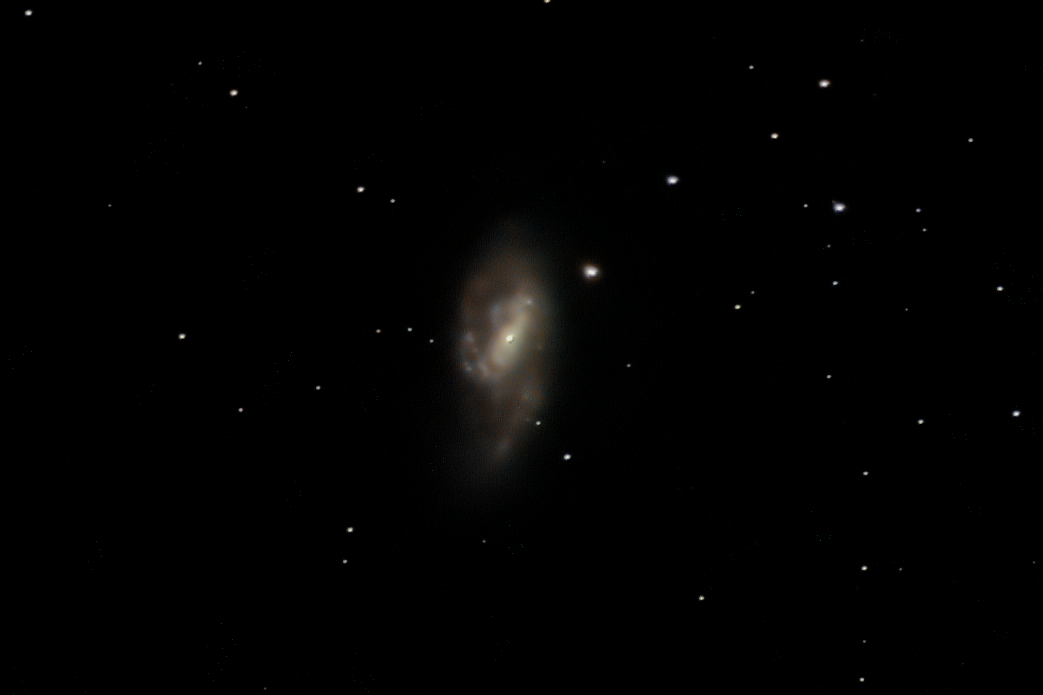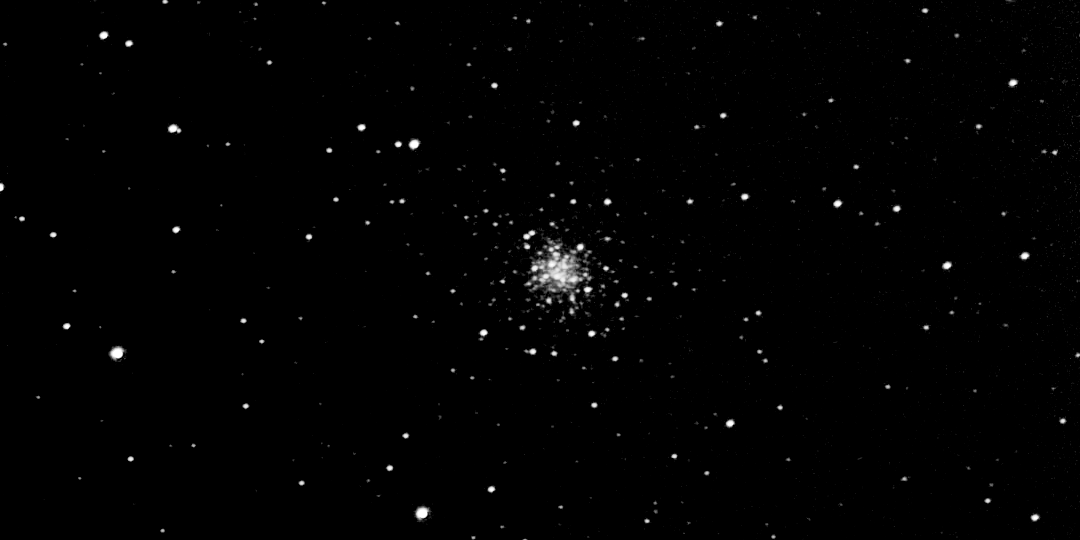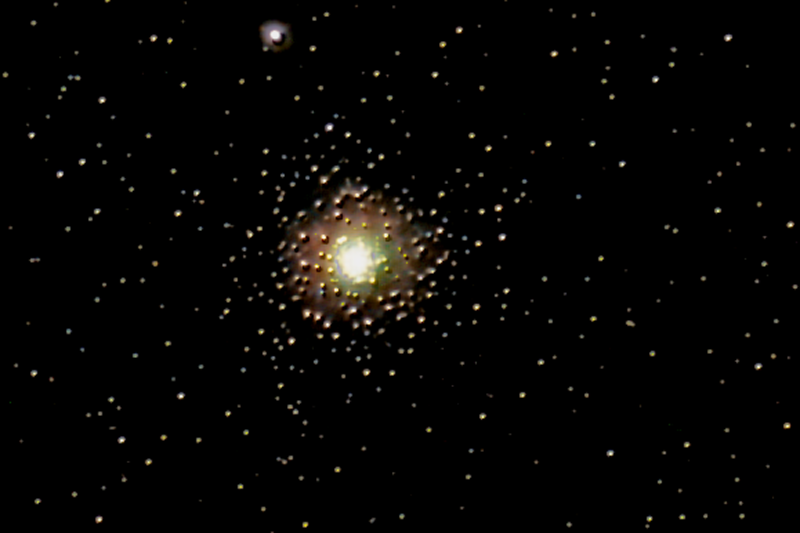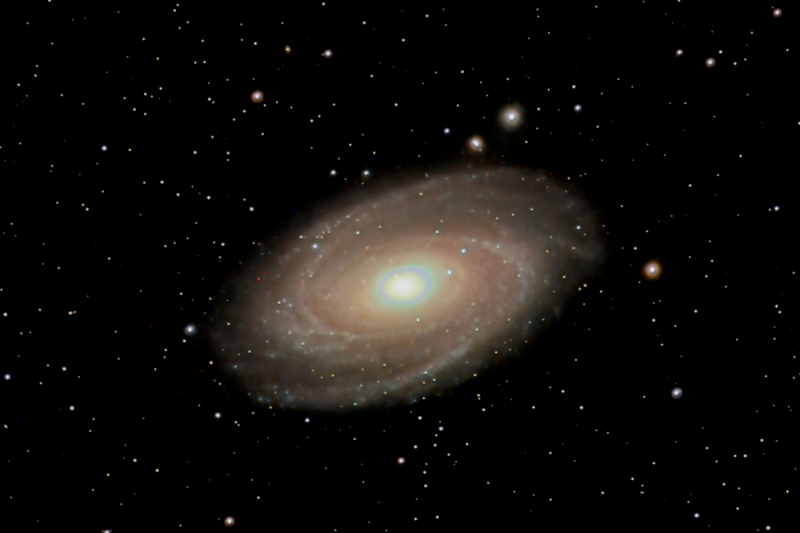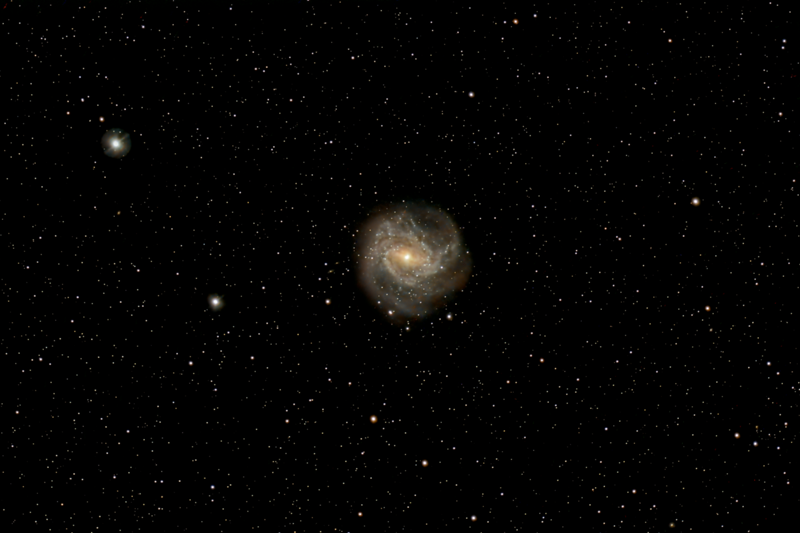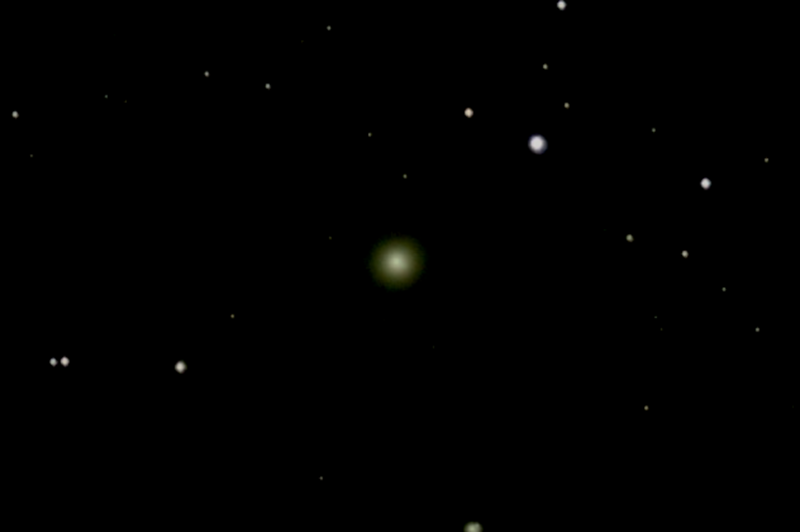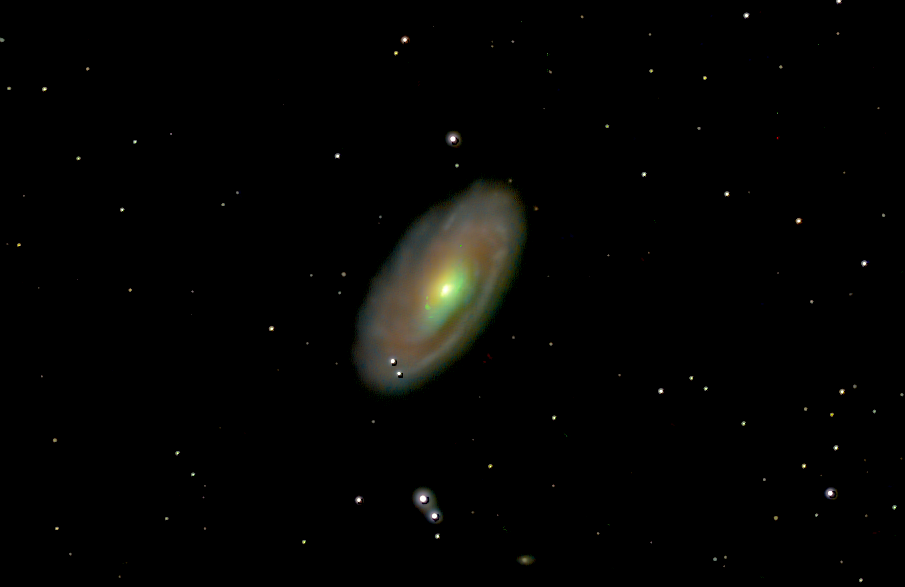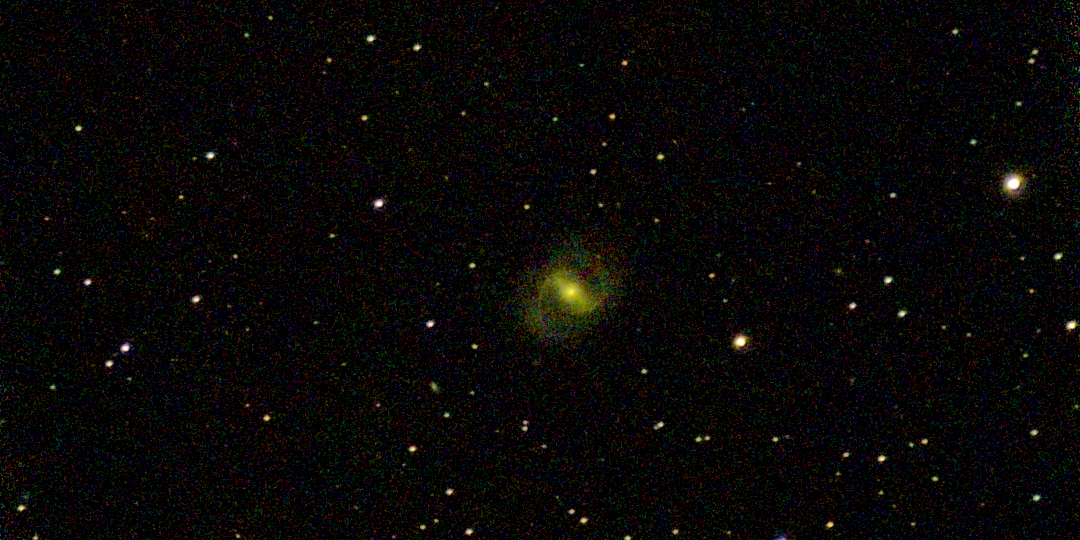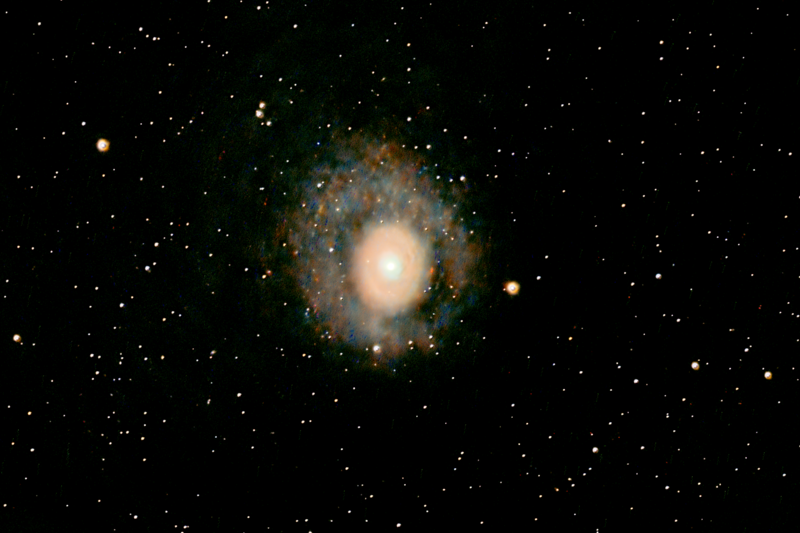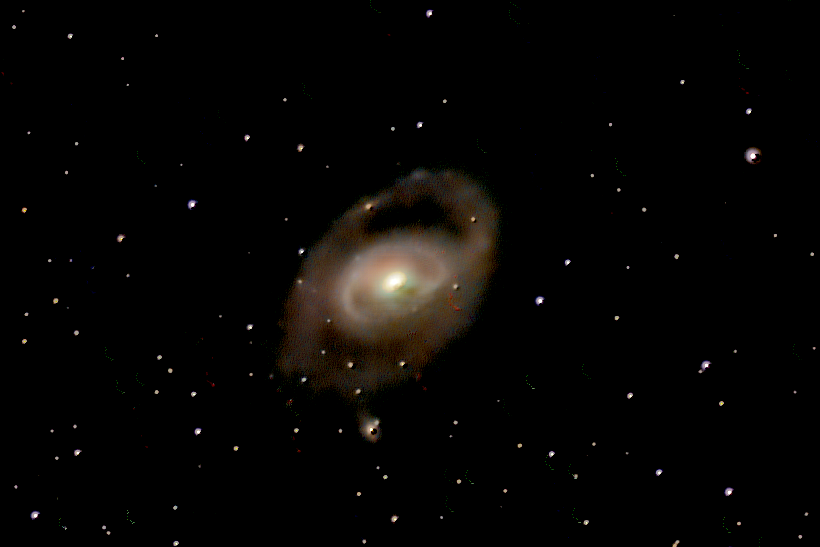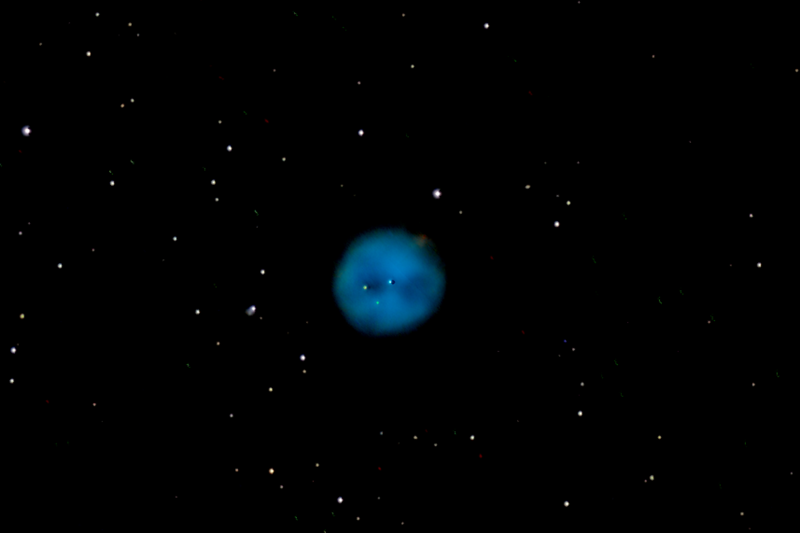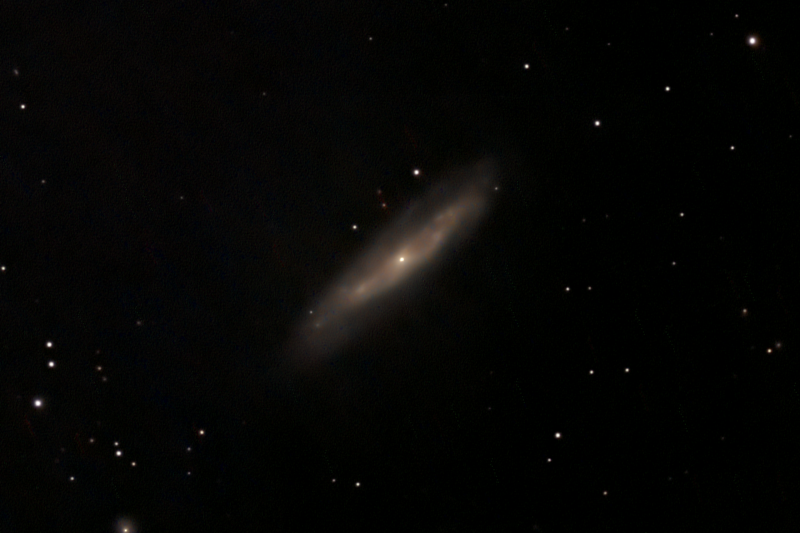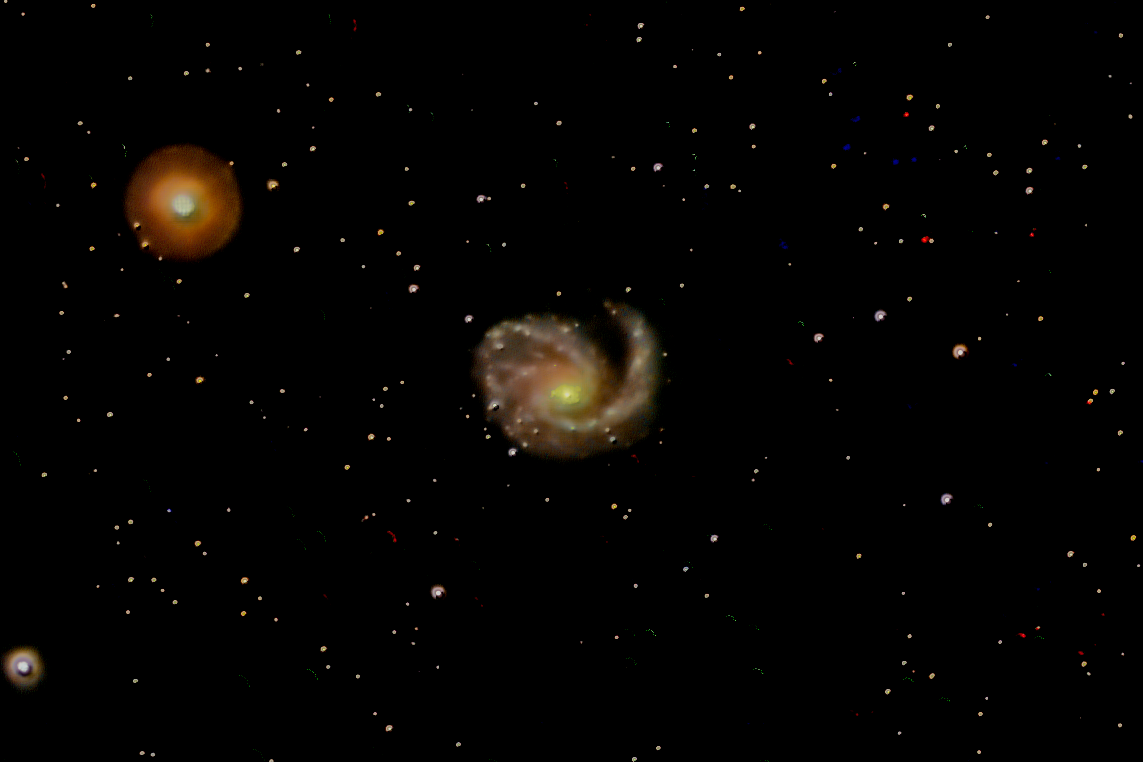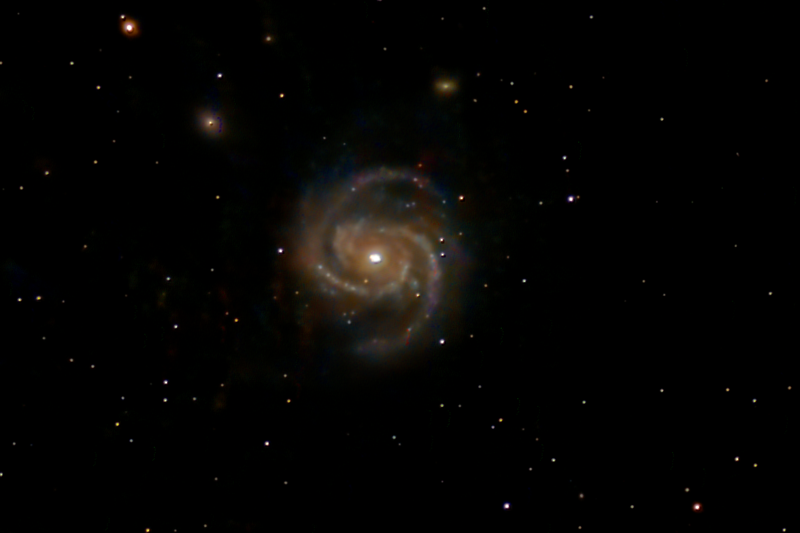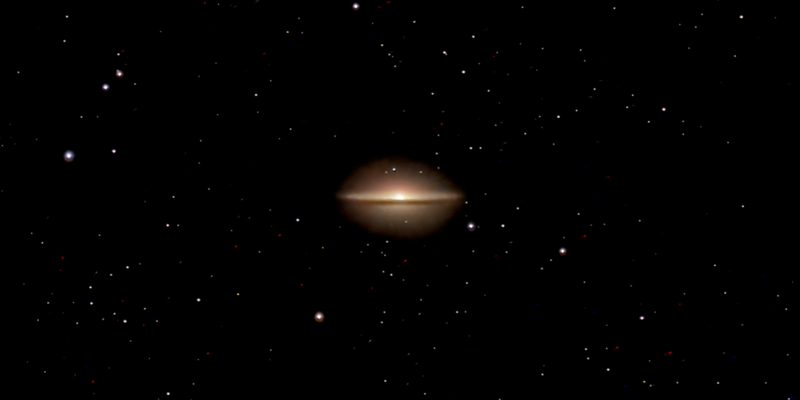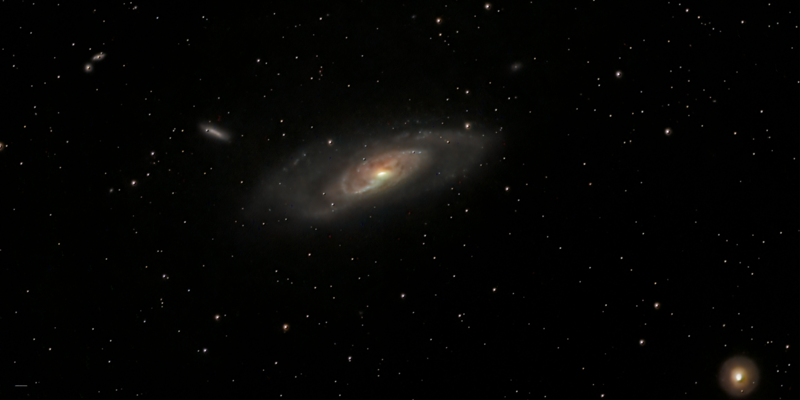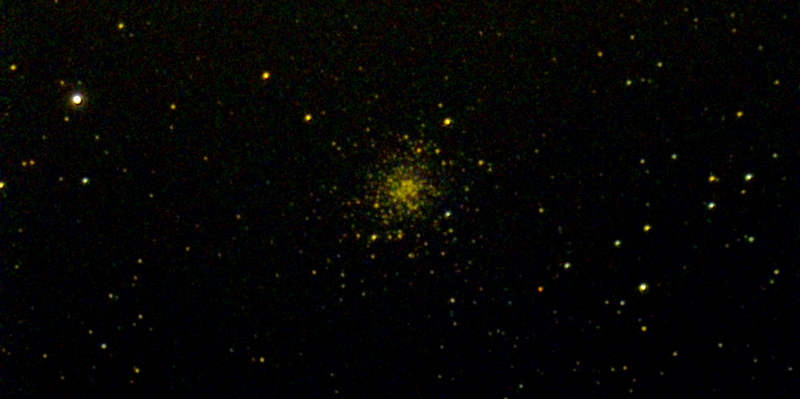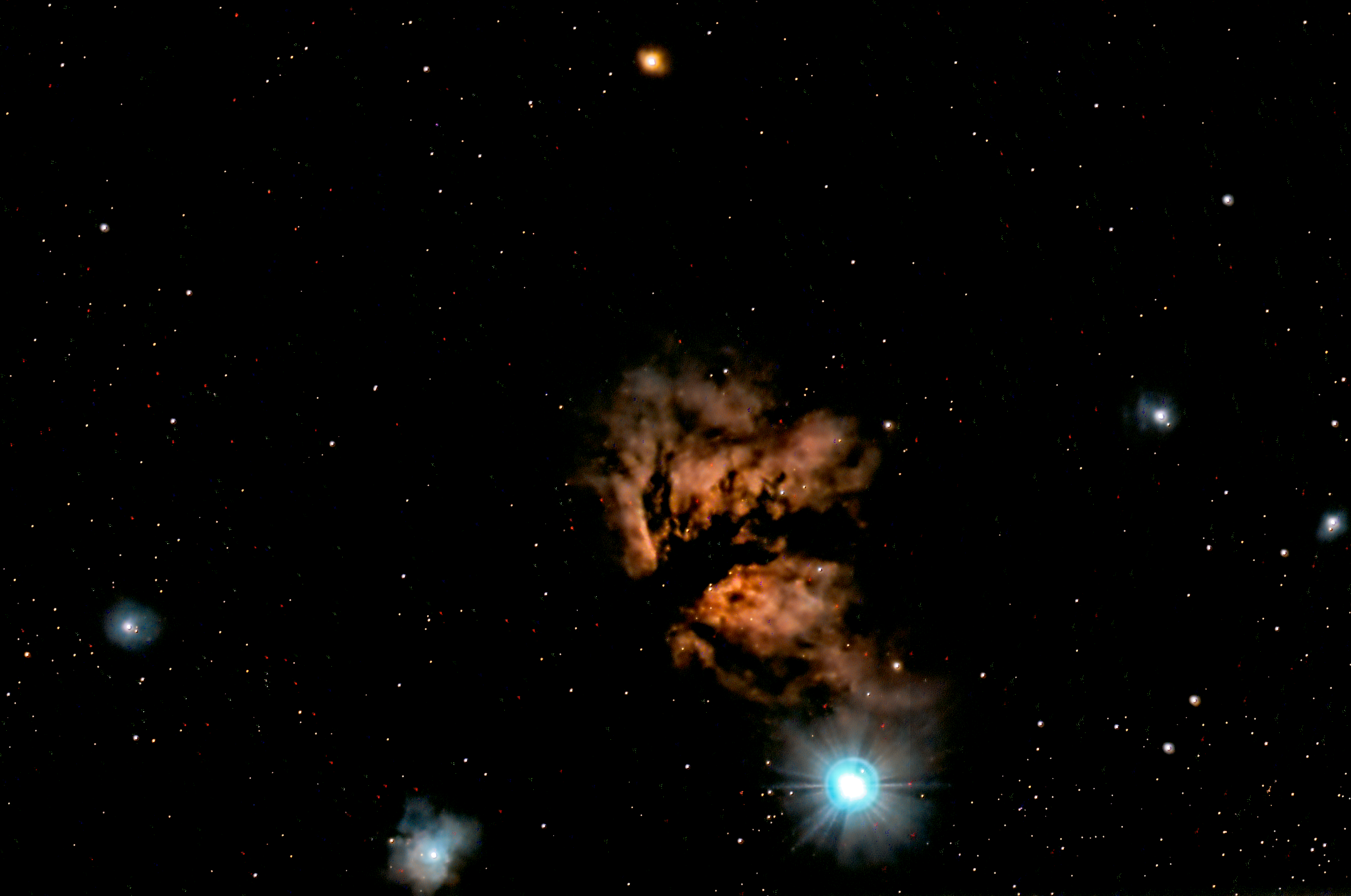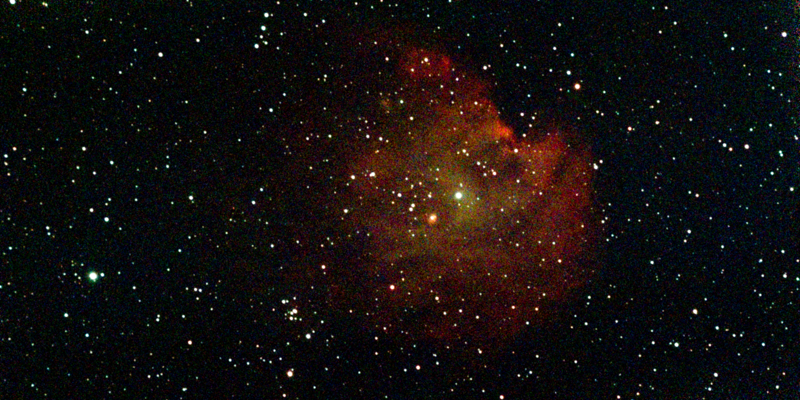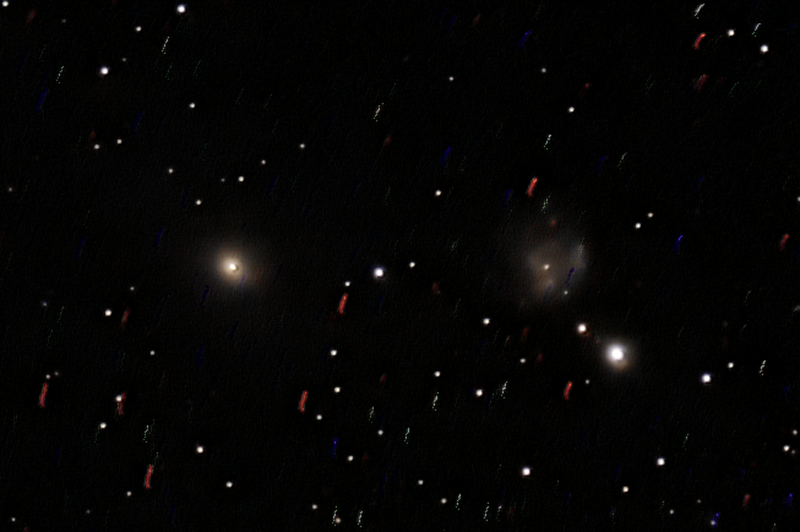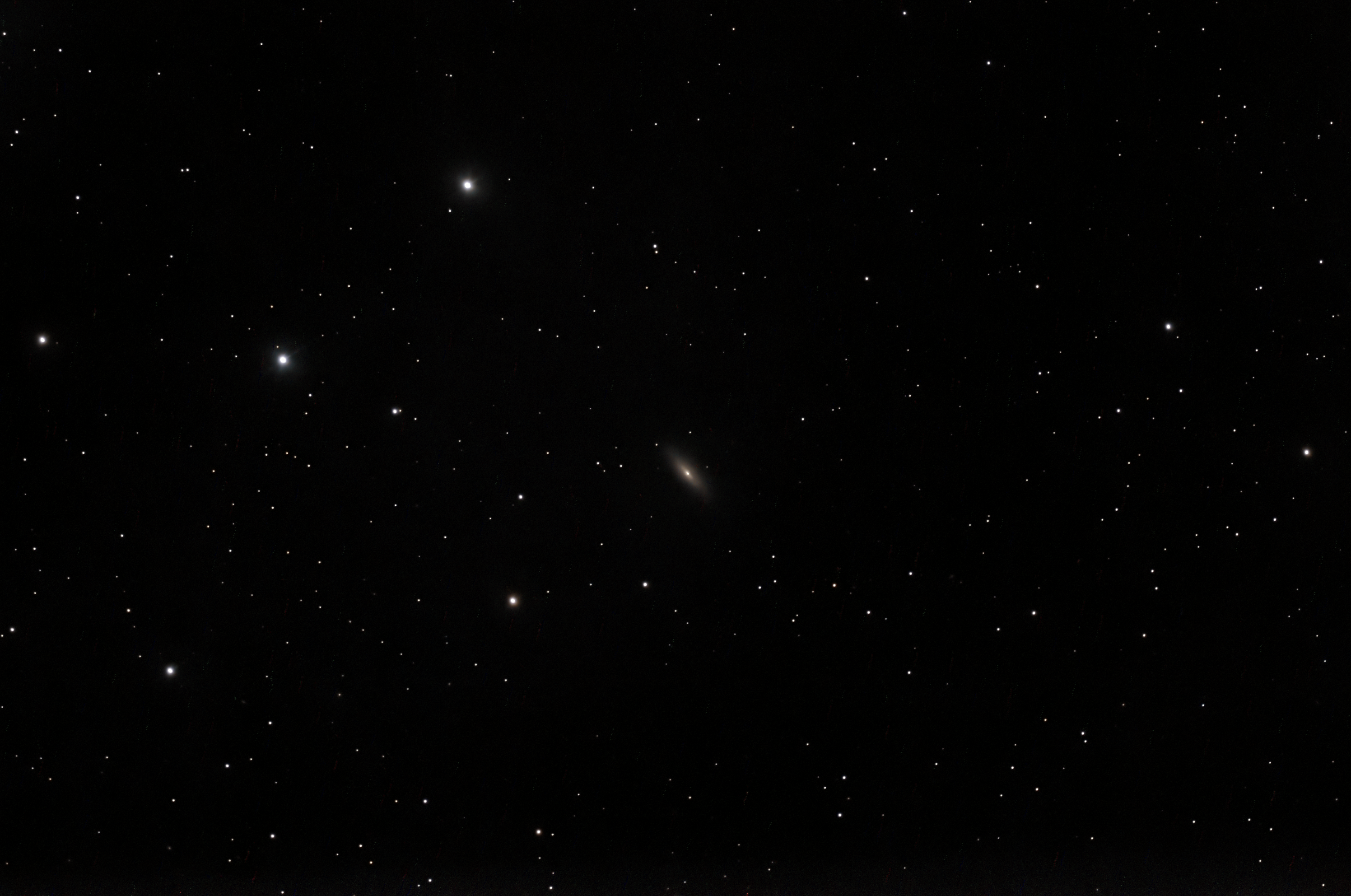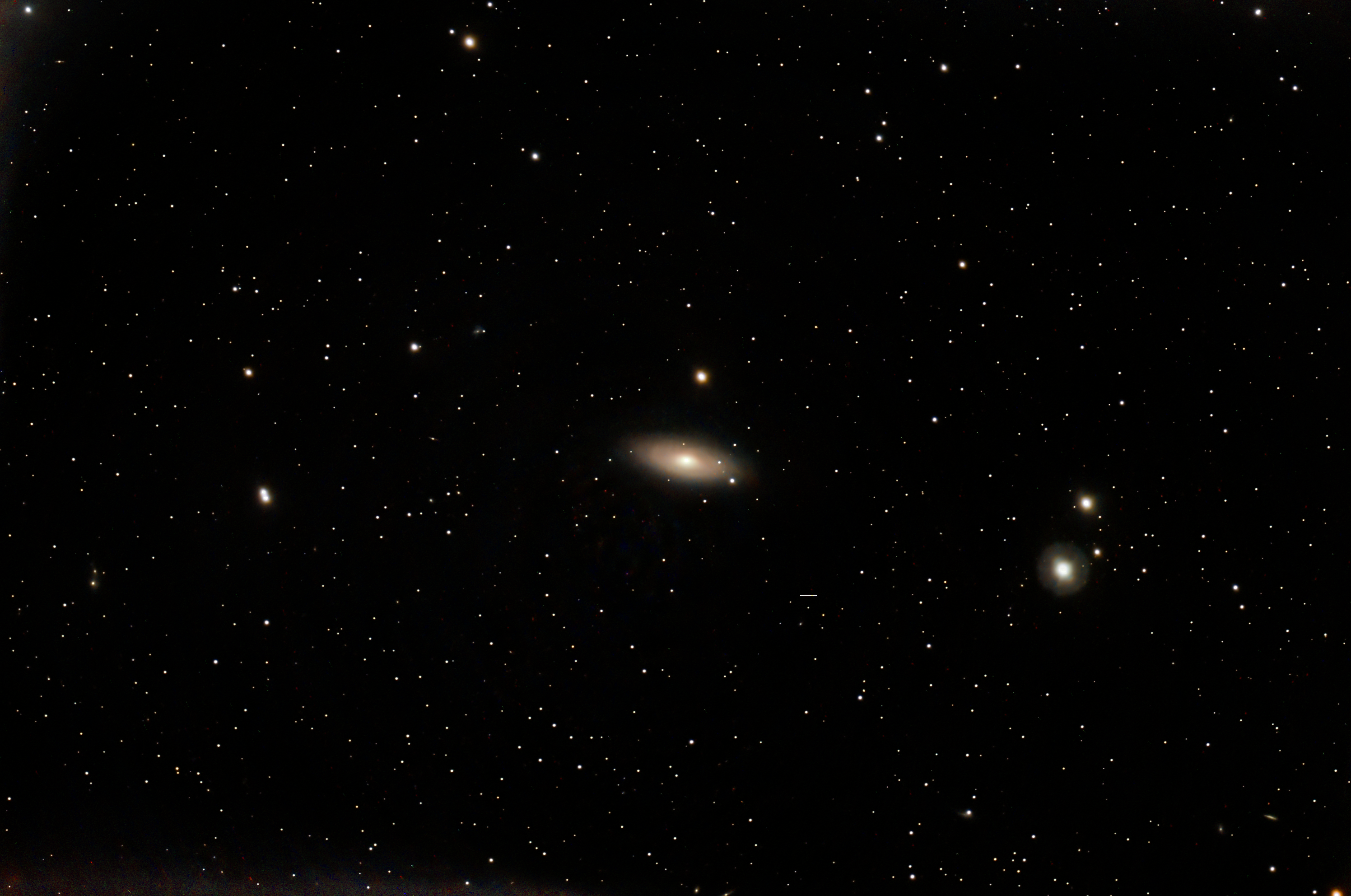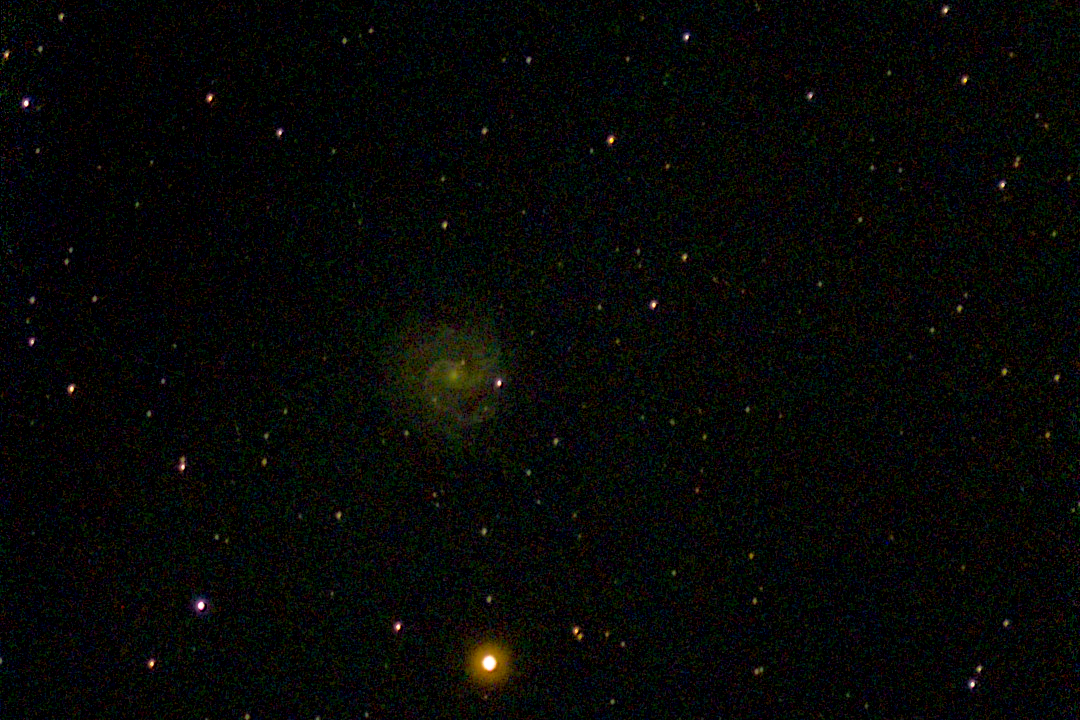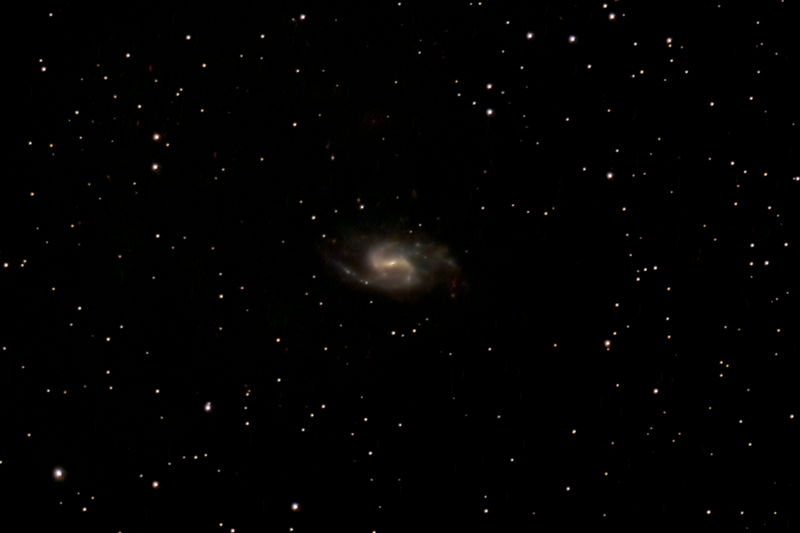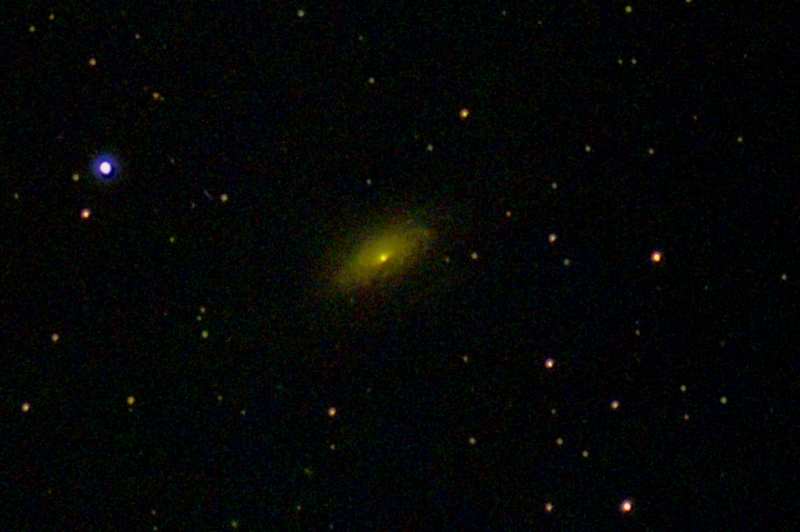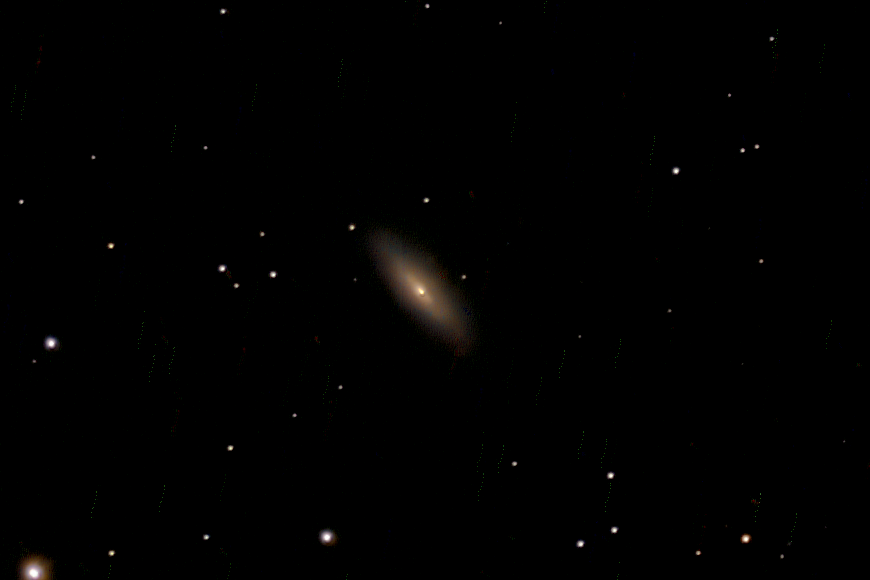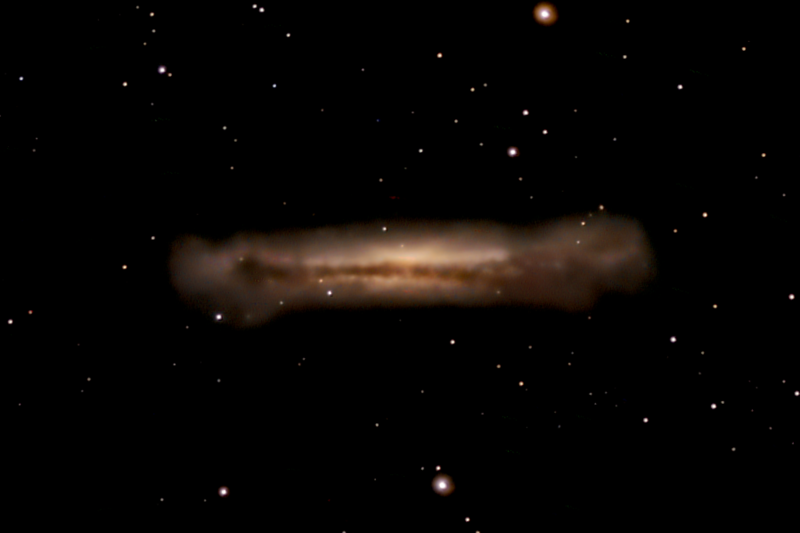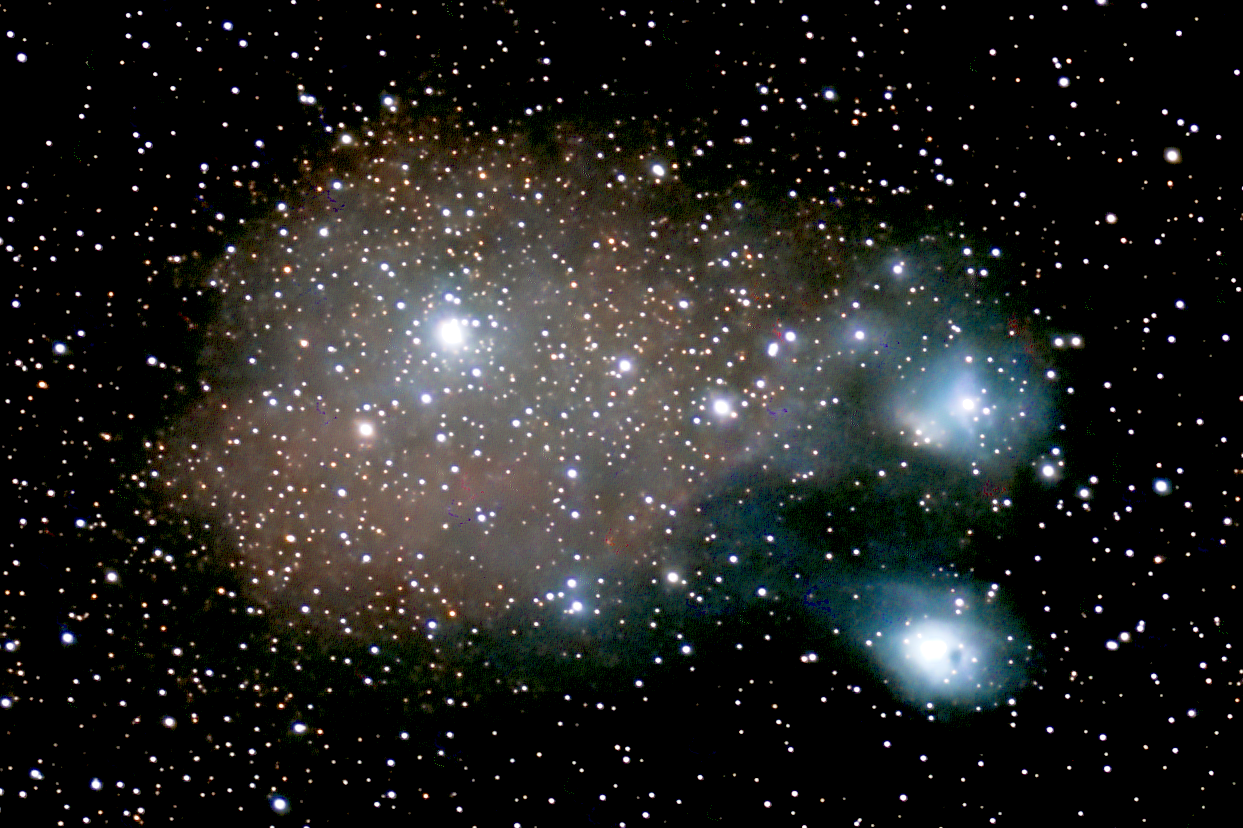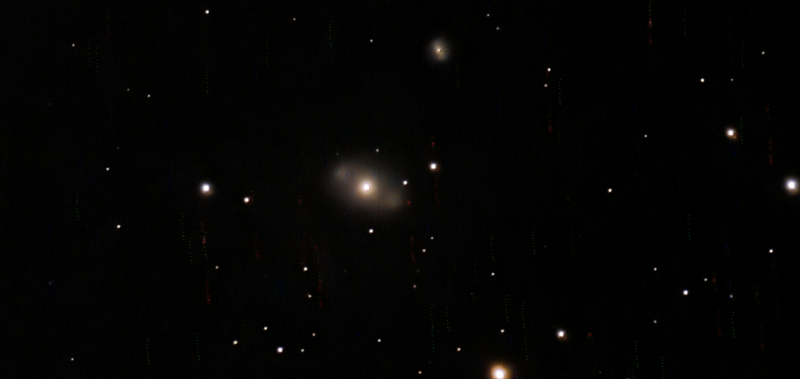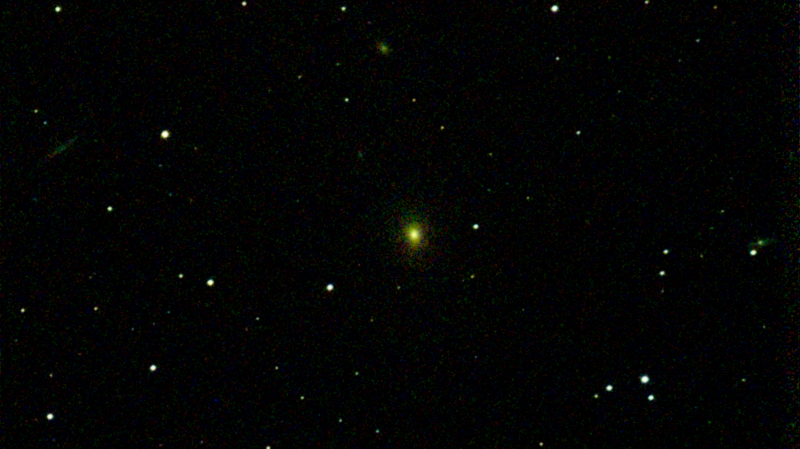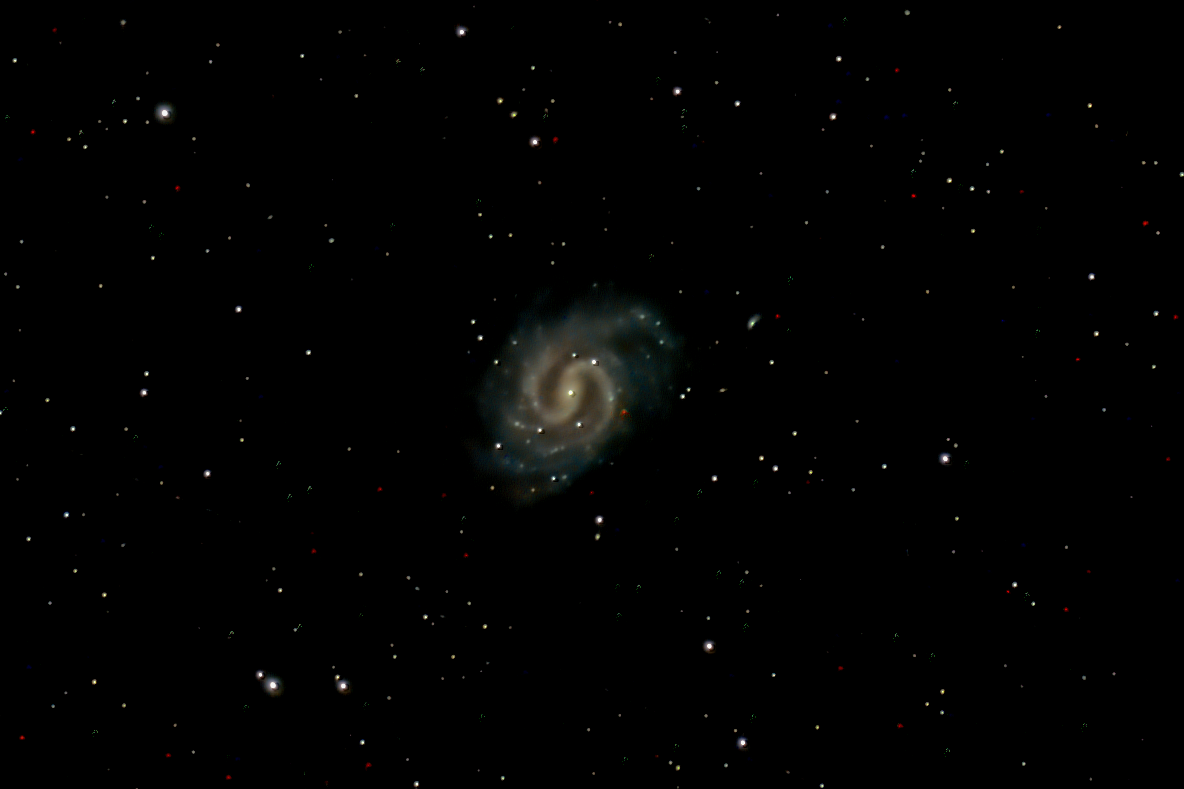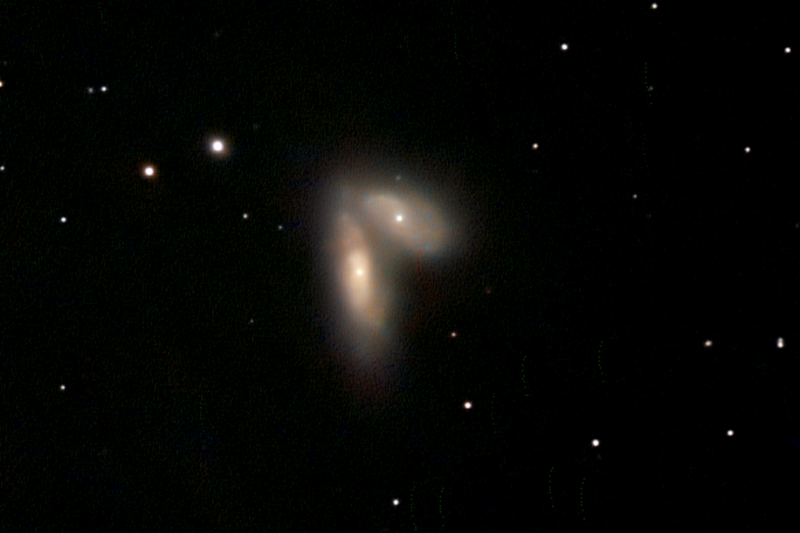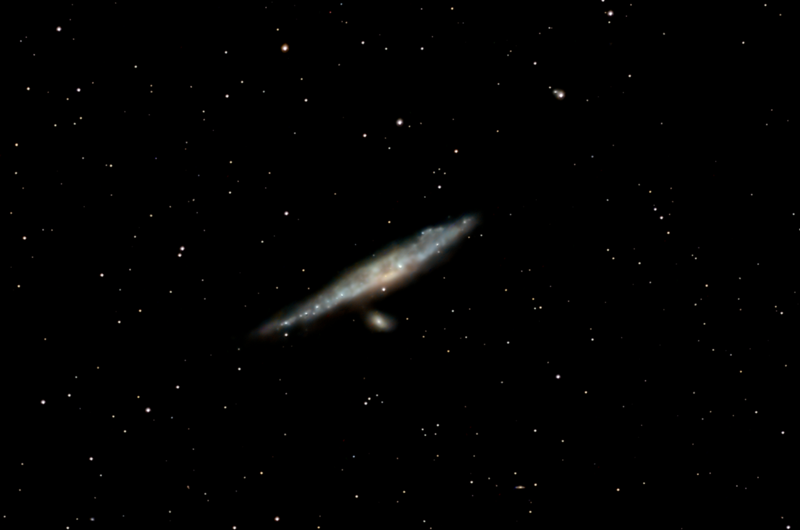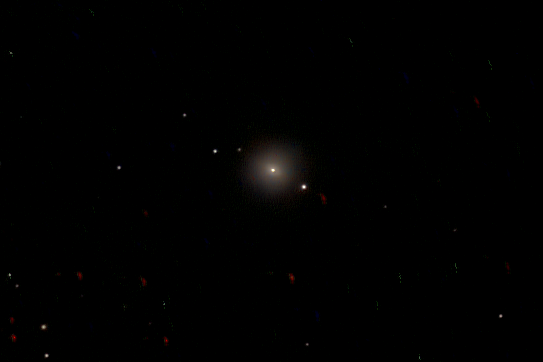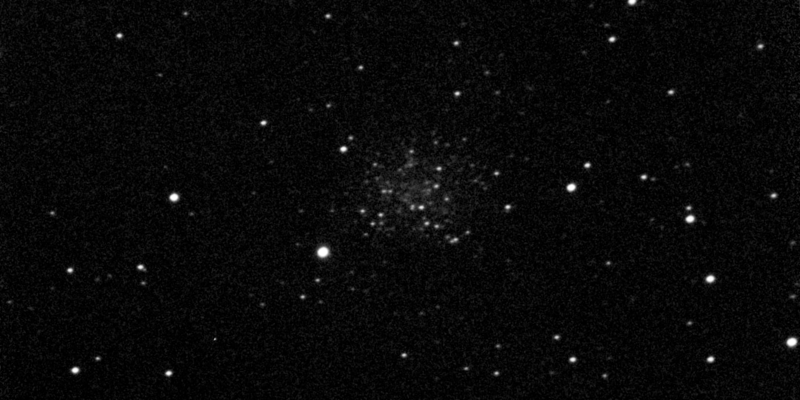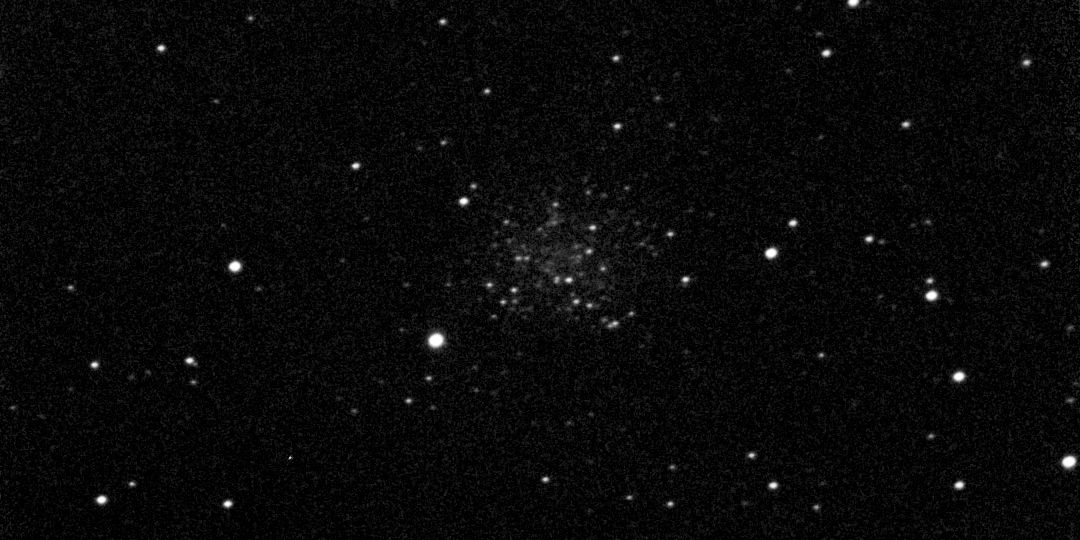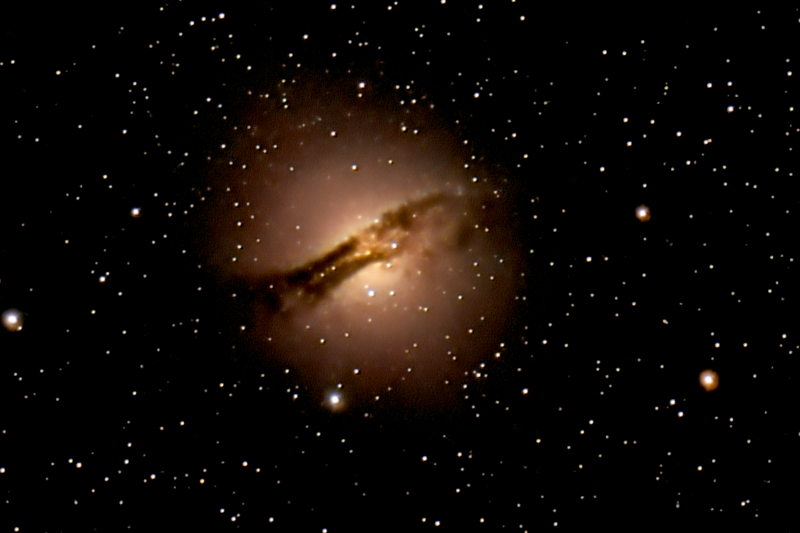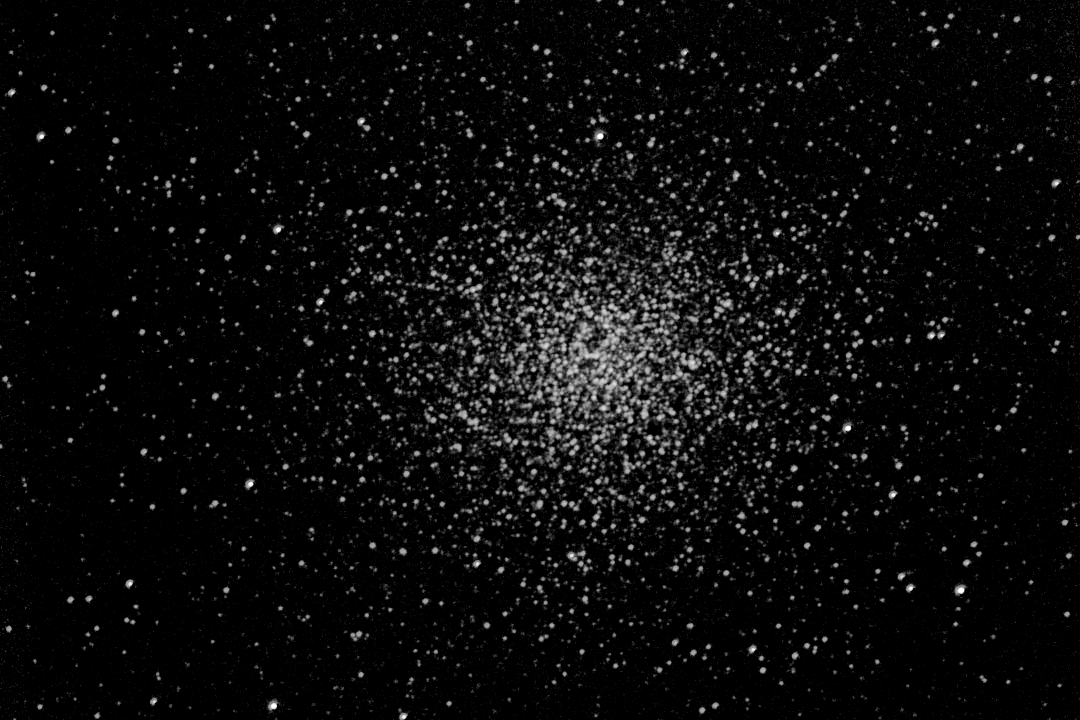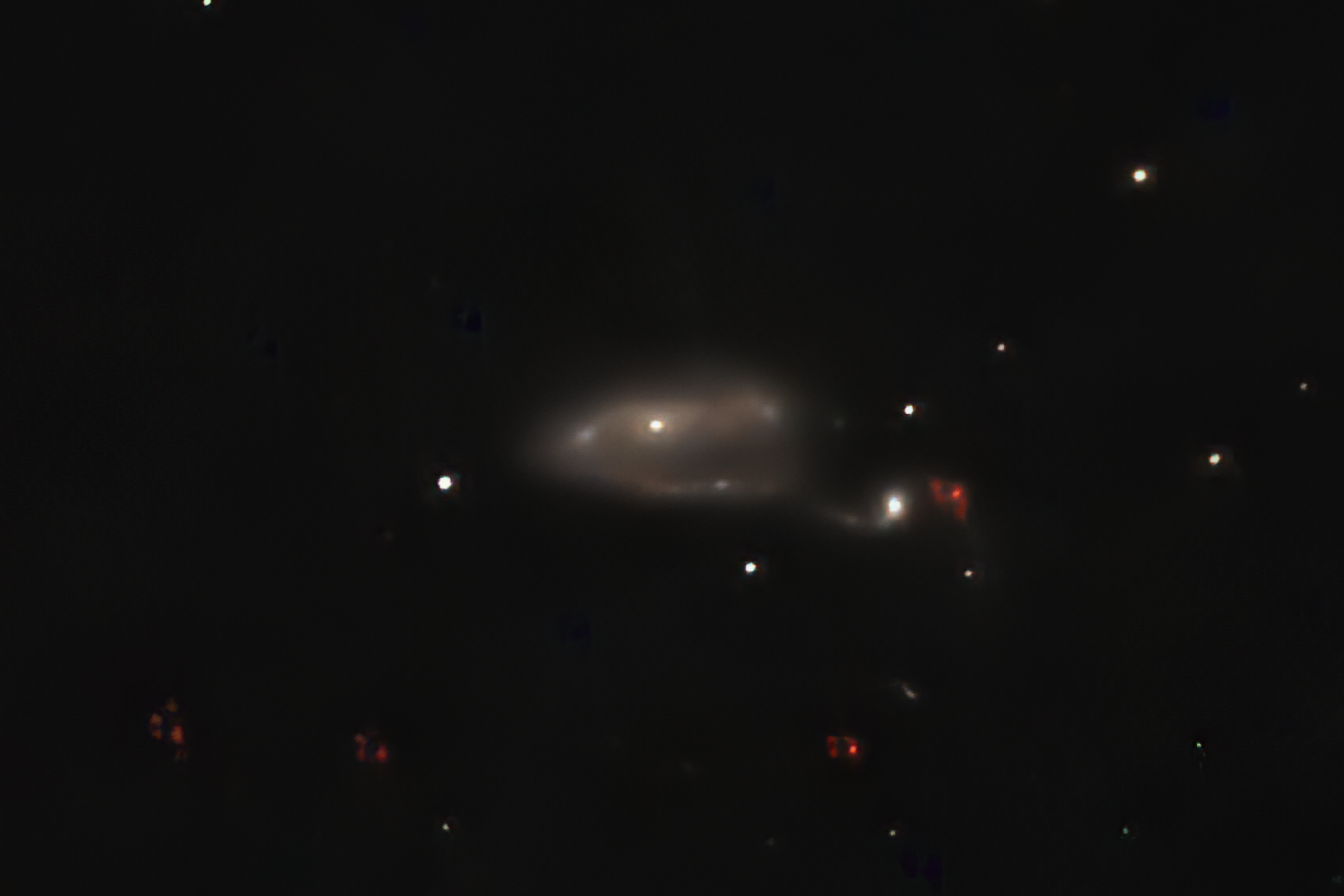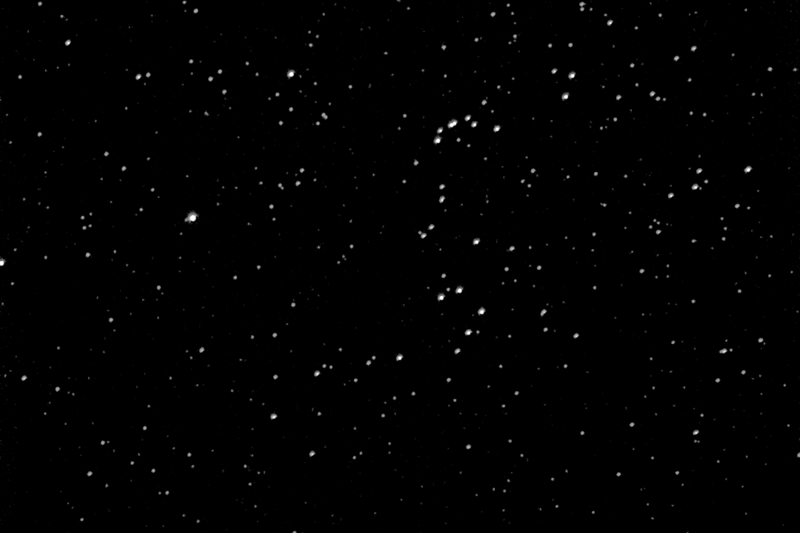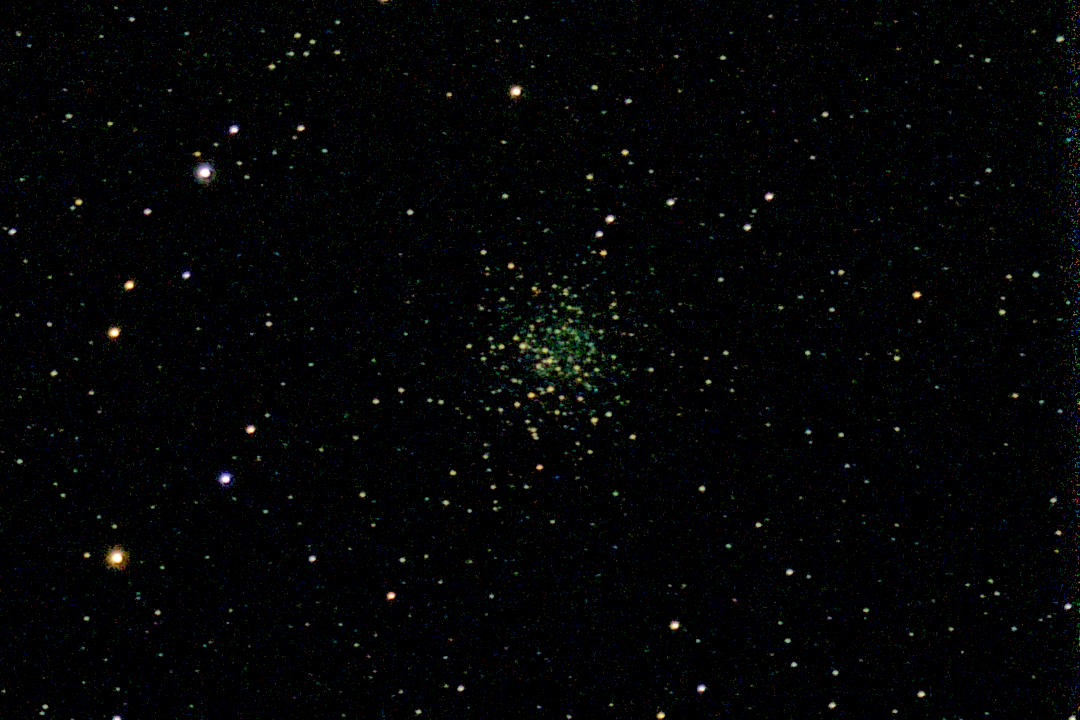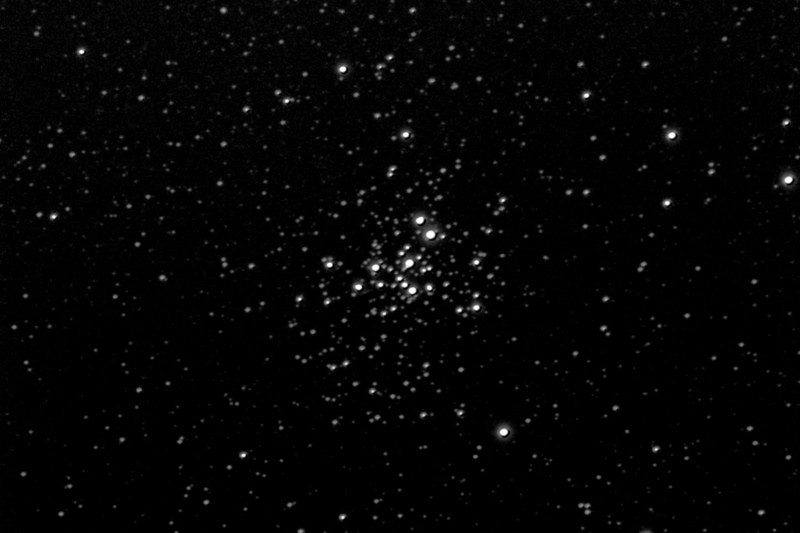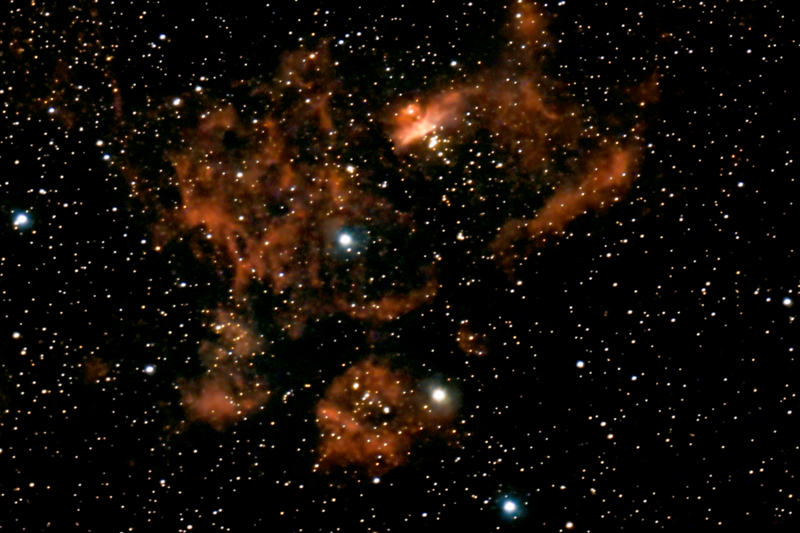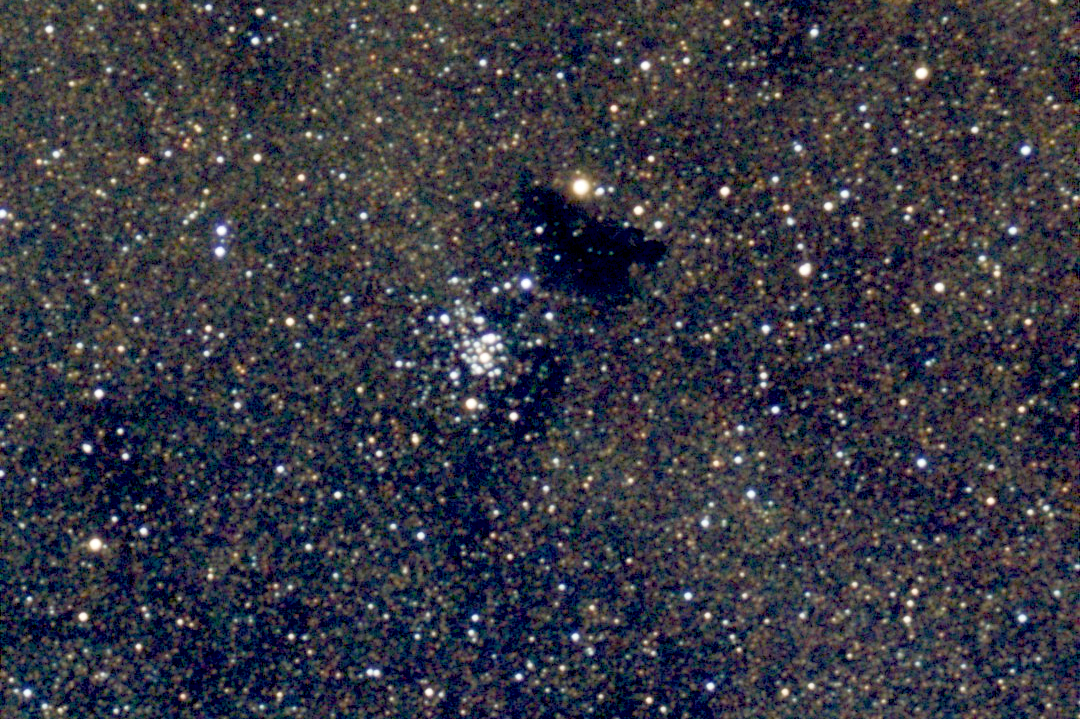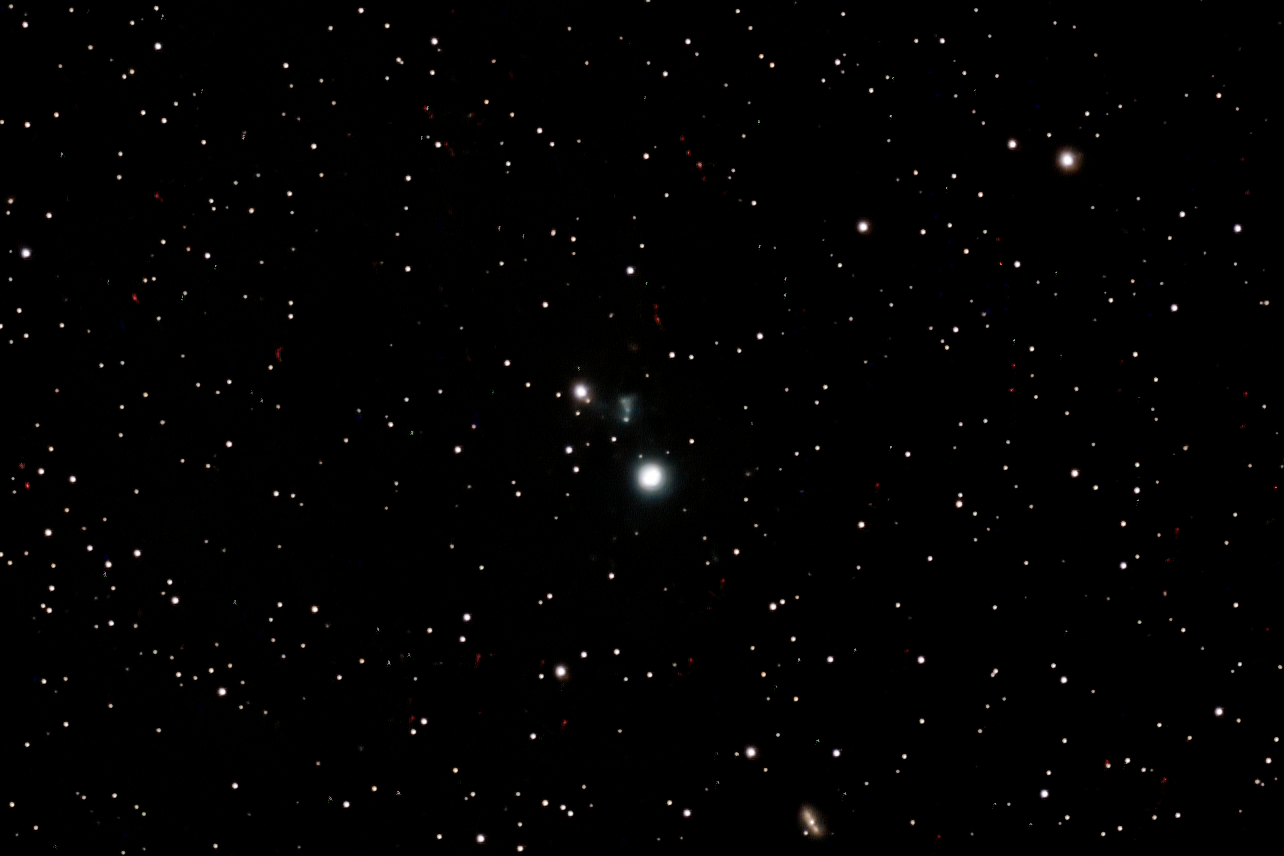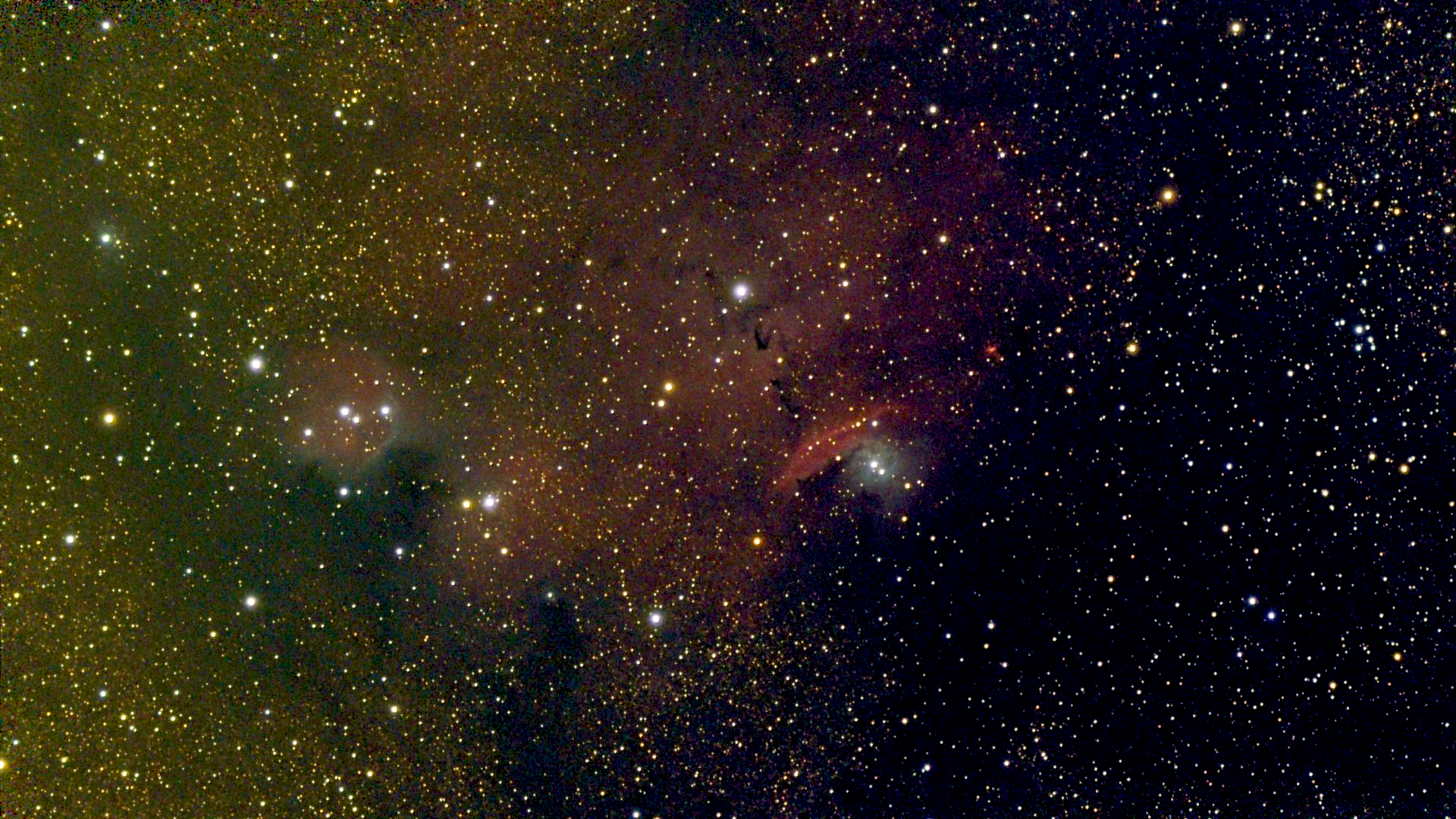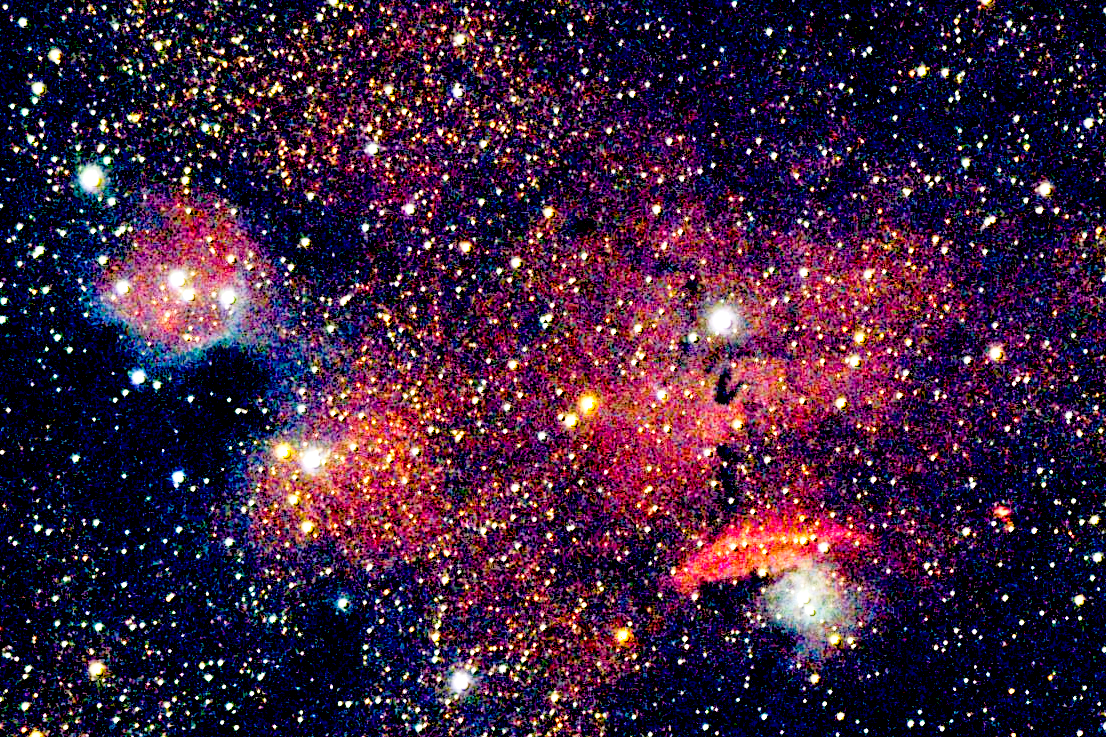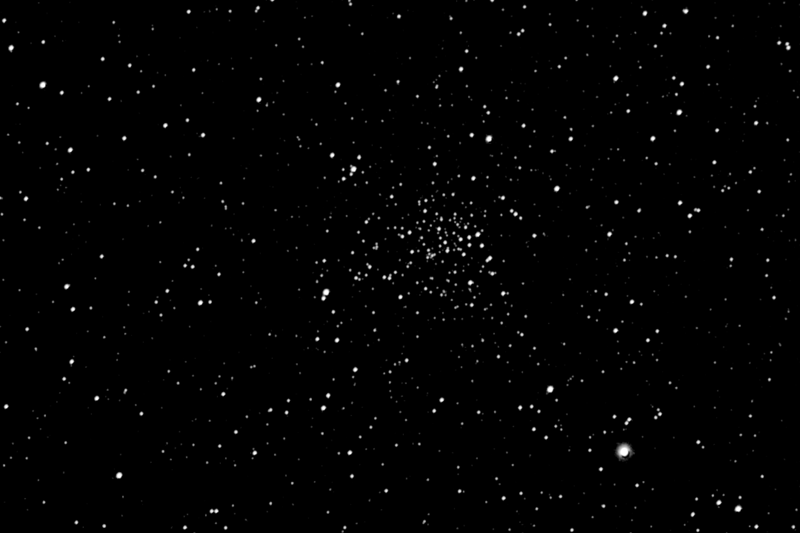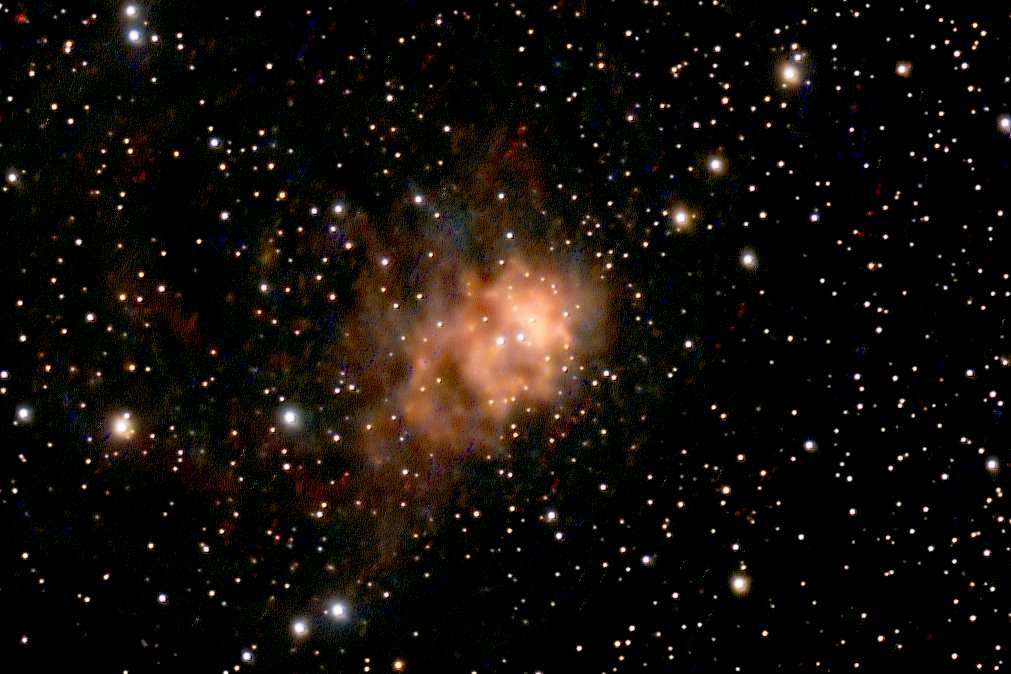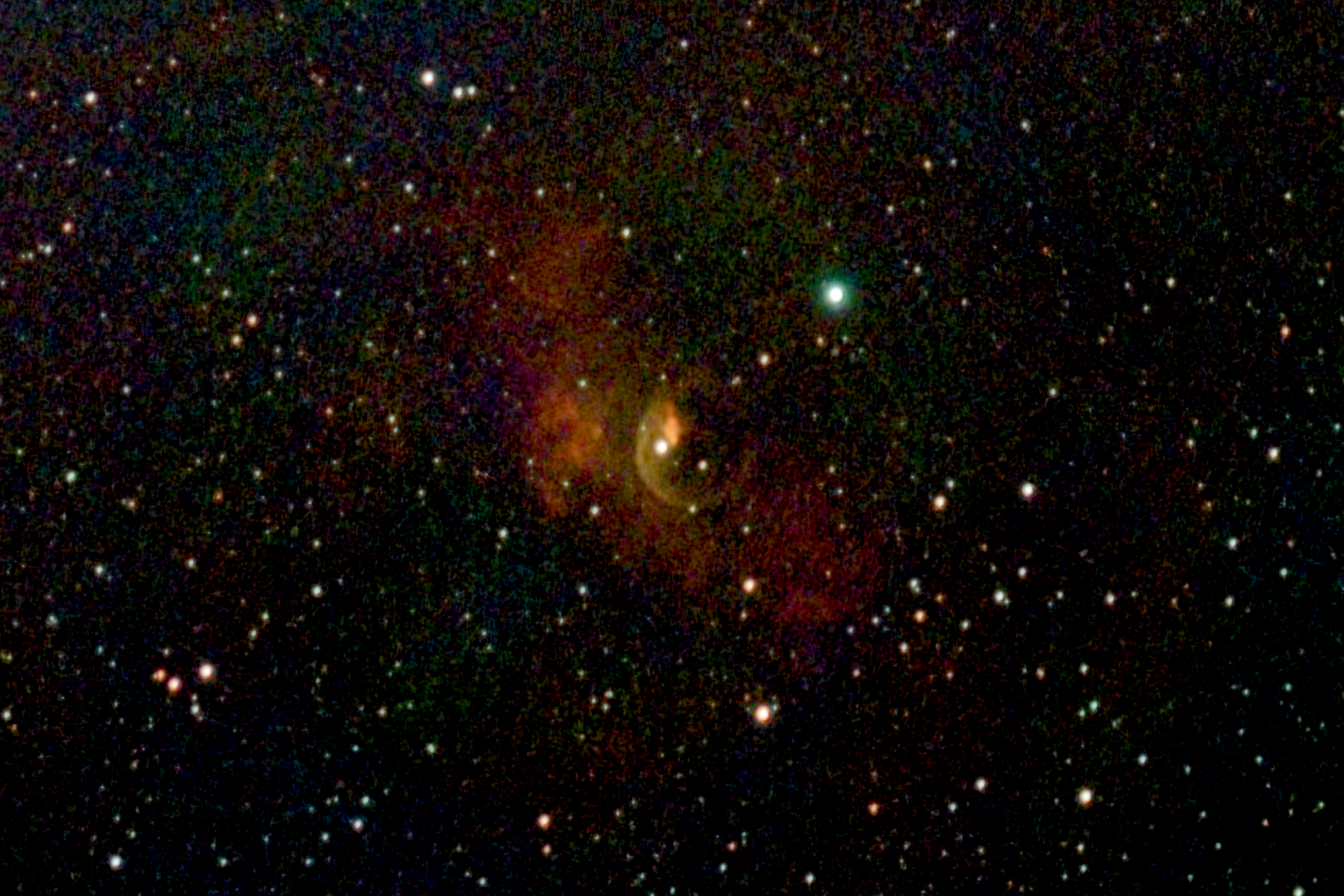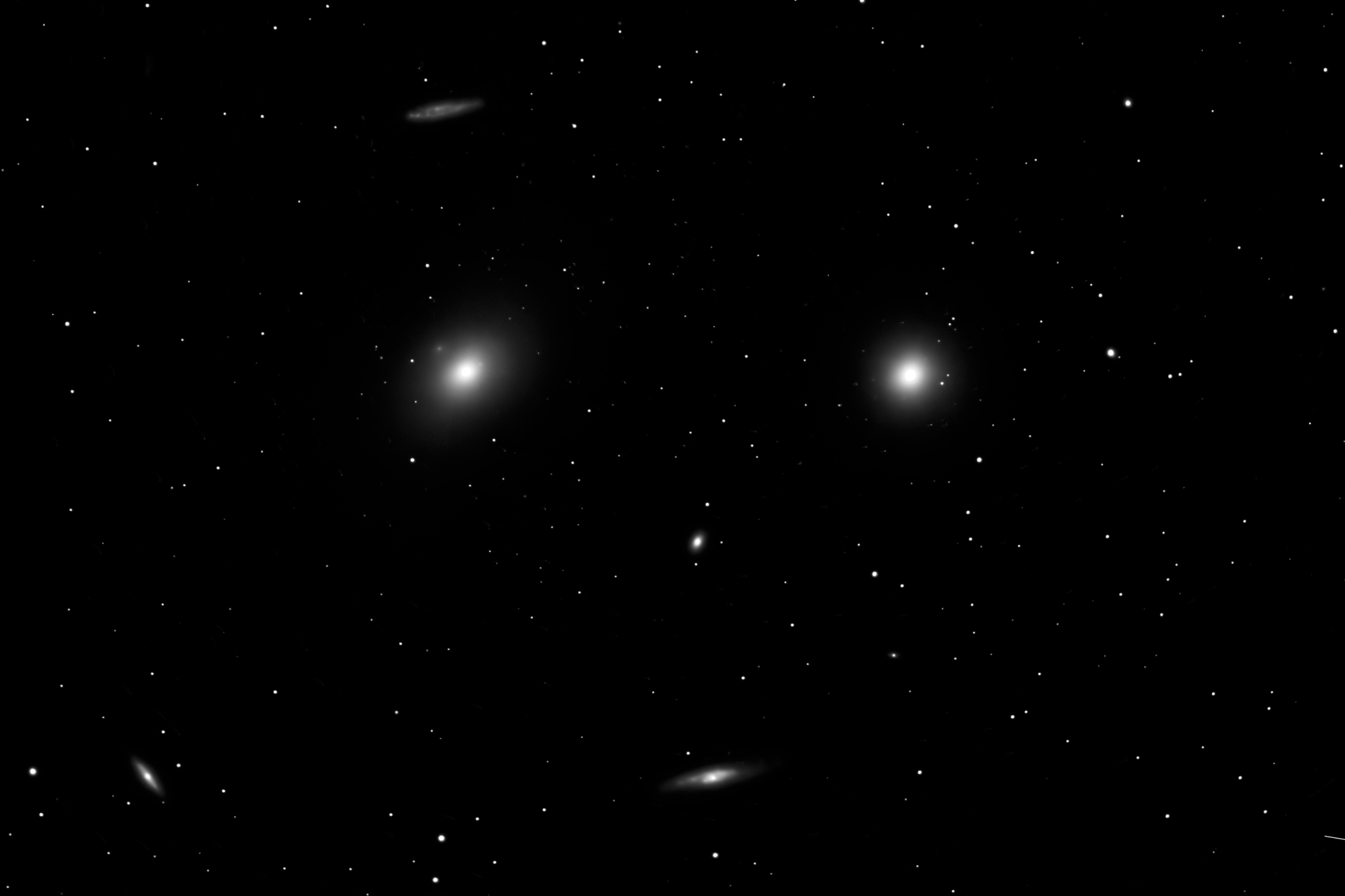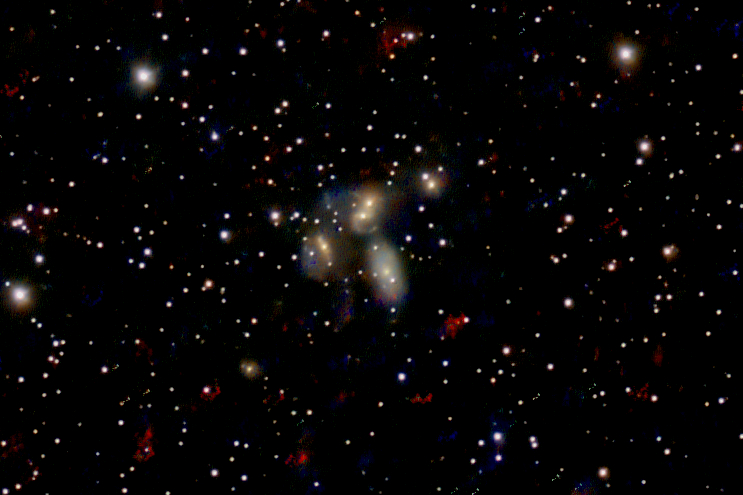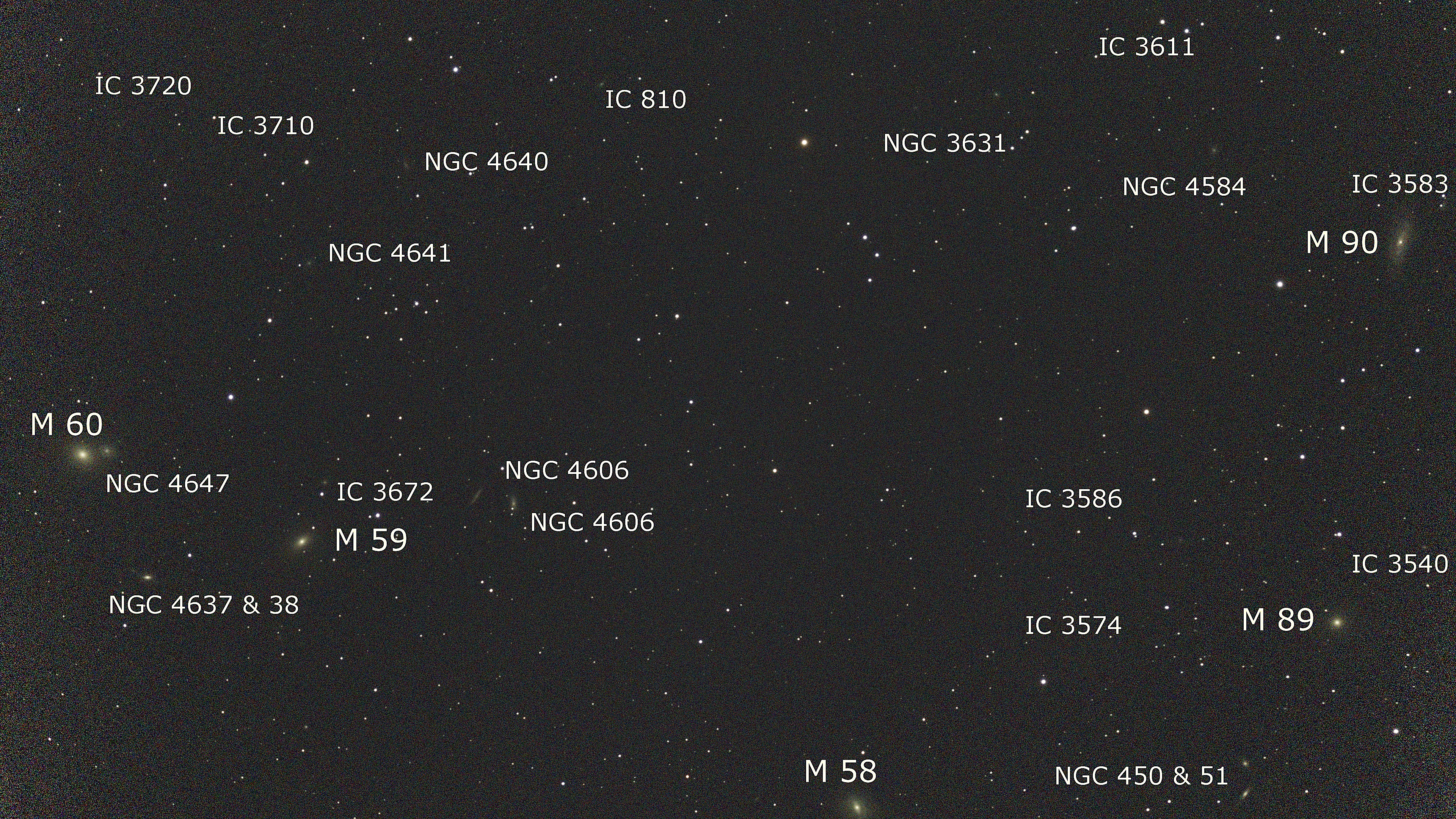Ced 173 - Tulip Nebula
In 1946 the Swedish astronomer Sven Cederblad published a study of bright diffuse galactic nebulae where he listed this nebula as Cederblad 173. He noted: «BD +34°3828 nebulous. Source: (93 Pl 43). WP 154. (715). R. The star responsible for the nebular light is stated to be BD +34°3828 (93). Then, BD +34°3830 = HD 189688 (spectrum K5) would only be aligned with the nebula.» ~ In 1953 the American astronomer Stewart Sharpless published his first survey for H II regions on the 48 inch Schmidt telescope photo plates of the «Palomar Observatory Sky Survey». This nebula was listed as Sh 1-75. In 1959 he published a revised and extended version of his survey and listed this nebula as Sh 2-101. In 1955 the Russian astronomers Grigory Abramovich Shajn and Vera Fedorovna Gaze at the Simeis Observatory on the Crimean Peninsula published their Gaze-Shajn catalogue of emission nebula. Cederblad 173 was there listed as Gaze-Shajn 175. In Beverly Lynds «Catalogue of Bright Nebulae», which was published in 1965, this nebula is listed as LBN 71.58+02.86. Because it was the 168th entry in the list, the nebula is also referred to as LBN 168. As the nebula appears in photographs like the bloom of a tulip, it earned the nickname «Tulip Nebula.»
In 1946 the Swedish astronomer Sven Cederblad published a study of bright diffuse galactic nebulae where he listed this nebula as Cederblad 173. He noted: «BD +34°3828 nebulous. Source: (93 Pl 43). WP 154. (715). R. The star responsible for the nebular light is stated to be BD +34°3828 (93). Then, BD +34°3830 = HD 189688 (spectrum K5) would only be aligned with the nebula.» ~ In 1953 the American astronomer Stewart Sharpless published his first survey for H II regions on the 48 inch Schmidt telescope photo plates of the «Palomar Observatory Sky Survey». This nebula was listed as Sh 1-75. In 1959 he published a revised and extended version of his survey and listed this nebula as Sh 2-101. In 1955 the Russian astronomers Grigory Abramovich Shajn and Vera Fedorovna Gaze at the Simeis Observatory on the Crimean Peninsula published their Gaze-Shajn catalogue of emission nebula. Cederblad 173 was there listed as Gaze-Shajn 175. In Beverly Lynds «Catalogue of Bright Nebulae», which was published in 1965, this nebula is listed as LBN 71.58+02.86. Because it was the 168th entry in the list, the nebula is also referred to as LBN 168. As the nebula appears in photographs like the bloom of a tulip, it earned the nickname «Tulip Nebula.»
IC 405 - Flaming Star Nebula
The Flaming Star Nebula (IC 405) is an emission and reflection nebula located approximately 1,500 light-years away in the northern constellation Auriga. The nebula surrounds the hot blue variable star AE Aurigae. With an apparent magnitude of 6.0 and an apparent size of 37 by 10 arcminutes, it is one of the true gems of the winter night sky and a popular target for amateur astronomers. IC 405 is illuminated by the young O-type main sequence dwarf AE Aurigae. It was named the Flaming Star Nebula because it contains extensive smoke-like filaments that make AE Aurigae look like it is on fire in long-exposure photographs. The nebular material that looks like smoke is mostly composed of hydrogen, but the dark filaments are made up of carbon-rich dust. The name Flaming Star comes from the German astronomer and Astro photographer Max Wolf (1863-1932). Wolf found the nebula while photographing Nova Aurigae 1891. He described the star AE Aurigae as a “burning body from which several enormous curved flames seem to break out like gigantic prominences,” noting that the “flaming star” seemed to be physically associated with the nebulosity. The Flaming Star Nebula is about five light-years across. It is composed of different regions that glow in red, purple, and blue tones in images. The hot blue star AE Aurigae emits so much light that it knocks away electrons from the gas that surrounds it, ionizing the nebula. When a high-energy proton emitted from the hot star recaptures an electron, red light is often emitted and the nebula glows red. The red regions comprise the emission nebula. Other parts of the nebula glow in bluish tones because the blue light of the hot star is reflected by the surrounding dust. The blue parts make up the reflection nebula. The purple parts of the nebula are a mix of emission and reflection regions. The Flaming Star Nebula was discovered by the German-born American astronomer John Martin Schaeberle in 1892. It was independently found by astrophotographers Max Wolf and Eugen von Gothard. The nebula is catalogued as Caldwell 31 in the Caldwell catalogue of deep sky objects visible in amateur telescopes. It has the designation Sharpless 229 (Sh2-229) in the Sharpless catalogue of H II regions.
The Flaming Star Nebula (IC 405) is an emission and reflection nebula located approximately 1,500 light-years away in the northern constellation Auriga. The nebula surrounds the hot blue variable star AE Aurigae. With an apparent magnitude of 6.0 and an apparent size of 37 by 10 arcminutes, it is one of the true gems of the winter night sky and a popular target for amateur astronomers. IC 405 is illuminated by the young O-type main sequence dwarf AE Aurigae. It was named the Flaming Star Nebula because it contains extensive smoke-like filaments that make AE Aurigae look like it is on fire in long-exposure photographs. The nebular material that looks like smoke is mostly composed of hydrogen, but the dark filaments are made up of carbon-rich dust. The name Flaming Star comes from the German astronomer and Astro photographer Max Wolf (1863-1932). Wolf found the nebula while photographing Nova Aurigae 1891. He described the star AE Aurigae as a “burning body from which several enormous curved flames seem to break out like gigantic prominences,” noting that the “flaming star” seemed to be physically associated with the nebulosity. The Flaming Star Nebula is about five light-years across. It is composed of different regions that glow in red, purple, and blue tones in images. The hot blue star AE Aurigae emits so much light that it knocks away electrons from the gas that surrounds it, ionizing the nebula. When a high-energy proton emitted from the hot star recaptures an electron, red light is often emitted and the nebula glows red. The red regions comprise the emission nebula. Other parts of the nebula glow in bluish tones because the blue light of the hot star is reflected by the surrounding dust. The blue parts make up the reflection nebula. The purple parts of the nebula are a mix of emission and reflection regions. The Flaming Star Nebula was discovered by the German-born American astronomer John Martin Schaeberle in 1892. It was independently found by astrophotographers Max Wolf and Eugen von Gothard. The nebula is catalogued as Caldwell 31 in the Caldwell catalogue of deep sky objects visible in amateur telescopes. It has the designation Sharpless 229 (Sh2-229) in the Sharpless catalogue of H II regions.
IC 434 - Horsehead Nebula
The Horsehead Nebula (also known as Barnard 33 or B33) is a small dark nebula in the constellation Orion. The nebula is located just to the south of Alnitak, the easternmost star of Orion's Belt, and is part of the much larger Orion molecular cloud complex. It appears within the southern region of the dense dust cloud known as Lynds 1630, along the edge of the much larger, active star-forming H II region called IC 434. The Horsehead Nebula is approximately 422 parsecs or 1,375 light-years from Earth. It is one of the most identifiable nebulae because of its resemblance to a horse's head.
The Horsehead Nebula (also known as Barnard 33 or B33) is a small dark nebula in the constellation Orion. The nebula is located just to the south of Alnitak, the easternmost star of Orion's Belt, and is part of the much larger Orion molecular cloud complex. It appears within the southern region of the dense dust cloud known as Lynds 1630, along the edge of the much larger, active star-forming H II region called IC 434. The Horsehead Nebula is approximately 422 parsecs or 1,375 light-years from Earth. It is one of the most identifiable nebulae because of its resemblance to a horse's head.
IC 443 - Jelly Fish Nebula
IC 443 (also known as the Jellyfish Nebula and Sharpless 248 (Sh2-248)) is a galactic supernova remnant (SNR) in the constellation Gemini. On the plane of the sky, it is located near the star Eta Geminorum. Its distance is roughly 5,000 light years from Earth. IC 443 may be the remains of a supernova that occurred 30,000 - 35,000 years ago. The same supernova event likely created the neutron star CXOU J061705.3+222127, the collapsed remnant of the stellar core. IC 443 is one of the best-studied cases of supernova remnants interacting with surrounding molecular clouds. Jelly Fish Nebula (IC 443) adjacent to the IC 444 is a reflective nebula and reflective nebula LBN 845.
IC 443 (also known as the Jellyfish Nebula and Sharpless 248 (Sh2-248)) is a galactic supernova remnant (SNR) in the constellation Gemini. On the plane of the sky, it is located near the star Eta Geminorum. Its distance is roughly 5,000 light years from Earth. IC 443 may be the remains of a supernova that occurred 30,000 - 35,000 years ago. The same supernova event likely created the neutron star CXOU J061705.3+222127, the collapsed remnant of the stellar core. IC 443 is one of the best-studied cases of supernova remnants interacting with surrounding molecular clouds. Jelly Fish Nebula (IC 443) adjacent to the IC 444 is a reflective nebula and reflective nebula LBN 845.
IC 1396 - Emission Nebula in Cepheus mosaic
IC 1396 is a large emission nebulae, a region of ionized gas, located in the constellation Cepheus about 2,400 light years away from Earth. IC 1396 is illuminated and ionized by a very bright, massive multiple star HD 206267 at its center, except for dense globules that can protect themselves from the star's harsh ultraviolet rays. This hierarchical triple star system has two members that form a spectroscopic binary that orbit each other with a period of 3.7 days, while a third member lies further away—it is unclear whether this third member is gravitationally bound to the pair. The system is emitting a stellar wind that reaches an exceptional velocity of 3,225 km/s, among the highest measured for stars of this type. Jutting from the rim of the nebula is IC 1396A, commonly called the Elephant's Trunk Nebula, a dark, dense globule with a bright, sinuous rim being illuminated by HD 206267.
IC 1396 is a large emission nebulae, a region of ionized gas, located in the constellation Cepheus about 2,400 light years away from Earth. IC 1396 is illuminated and ionized by a very bright, massive multiple star HD 206267 at its center, except for dense globules that can protect themselves from the star's harsh ultraviolet rays. This hierarchical triple star system has two members that form a spectroscopic binary that orbit each other with a period of 3.7 days, while a third member lies further away—it is unclear whether this third member is gravitationally bound to the pair. The system is emitting a stellar wind that reaches an exceptional velocity of 3,225 km/s, among the highest measured for stars of this type. Jutting from the rim of the nebula is IC 1396A, commonly called the Elephant's Trunk Nebula, a dark, dense globule with a bright, sinuous rim being illuminated by HD 206267.
IC 1795 - Fish Head Nebula
IC 1848 - Soul Nebula
Westerhout 5 (Sharpless 2-199, LBN 667, Soul Nebula) is an emission nebula located in Cassiopeia. Several small open clusters are embedded in the nebula: CR 34, 632, and 634[citation needed] (in the head) and IC 1848 (in the body). The object is more commonly called by the cluster designation IC 1848. Small emission nebula IC 1871 is present just left of the top of the head, and small emission nebulae 670 and 669 are just below the lower back area. The galaxies Maffei 1 and Maffei 2 are both nearby the nebula, although light extinction from the Milky Way makes them very hard to see. Once thought to be part of the Local Group, they are now known to belong to their own group- the IC 342/Maffei Group. This complex is the eastern neighbor of IC1805 (Heart Nebula) and the two are often mentioned together as the "Heart and Soul".
Westerhout 5 (Sharpless 2-199, LBN 667, Soul Nebula) is an emission nebula located in Cassiopeia. Several small open clusters are embedded in the nebula: CR 34, 632, and 634[citation needed] (in the head) and IC 1848 (in the body). The object is more commonly called by the cluster designation IC 1848. Small emission nebula IC 1871 is present just left of the top of the head, and small emission nebulae 670 and 669 are just below the lower back area. The galaxies Maffei 1 and Maffei 2 are both nearby the nebula, although light extinction from the Milky Way makes them very hard to see. Once thought to be part of the Local Group, they are now known to belong to their own group- the IC 342/Maffei Group. This complex is the eastern neighbor of IC1805 (Heart Nebula) and the two are often mentioned together as the "Heart and Soul".
IC 4605 - Nebula in Scorpius
IC 4605 is a Nebula in the Scorpius constellation. IC 4605 is situated south of the celestial equator and, as such, it is more easily visible from the southern hemisphere. Given its B magnitude of 4.7, IC 4605 is barely visible to the naked eye, easily visible with the help of a small binocular. The nebula complex around IC 4605 is located approximately 400-700 light-years away from Earth. It's a reflection nebula situated within the Rho Ophiuchi molecular cloud in the constellation Scorpius. This region is known for active star formation and is considered one of the closest star-forming regions to our solar system.
IC 4605 is a Nebula in the Scorpius constellation. IC 4605 is situated south of the celestial equator and, as such, it is more easily visible from the southern hemisphere. Given its B magnitude of 4.7, IC 4605 is barely visible to the naked eye, easily visible with the help of a small binocular. The nebula complex around IC 4605 is located approximately 400-700 light-years away from Earth. It's a reflection nebula situated within the Rho Ophiuchi molecular cloud in the constellation Scorpius. This region is known for active star formation and is considered one of the closest star-forming regions to our solar system.
IC 4628 - Prawn Nebula
The Prawn Nebula, also known as IC 4628, is a massive stellar nursery located around 6,000 light-years from Earth in the Sagittarius Arm of the Milky Way, in the constellation Scorpius (Latin for "scorpion"). It forms part of the tail of the "False Comet" anchored by the bright open cluster NGC 6231. Though the nebula stretches 250 light-years and covers a space four times the size of the full moon, it emits light primarily in wavelengths the human eye cannot detect, making it extremely faint to earthbound viewers. The nebula showcases intricate structures and vibrant colors due to the ionized gas and young, massive stars within it. The nebula's distinct shape resembles a prawn, hence its name. This celestial beauty offers a captivating glimpse into the birth and evolution of stars. As an emission nebula, which means its gas has been energized, or ionized, by the radiation of nearby stars. The radiation from these massive stars strips electrons from the nebula’s hydrogen atoms. As the energized electrons revert from their higher-energy state to a lower-energy state by recombining with hydrogen nuclei, they emit energy in the form of light, causing the nebula’s gas to glow. In this image, red indicates the presence of ionized iron (Fe II) emission. To give you a perspective of how far 6,000 Light-years is, if you were to get on our fastest jet plane (the X-15) that traveled at Mach 6.7 (which is about 4,520 mile/hours) it would take you about 900 million years to get there. Even our fastest man made satellite, Parker, traveling at 394,736 miles/hour, would take about 10 million years to reach the nebula.
The Prawn Nebula, also known as IC 4628, is a massive stellar nursery located around 6,000 light-years from Earth in the Sagittarius Arm of the Milky Way, in the constellation Scorpius (Latin for "scorpion"). It forms part of the tail of the "False Comet" anchored by the bright open cluster NGC 6231. Though the nebula stretches 250 light-years and covers a space four times the size of the full moon, it emits light primarily in wavelengths the human eye cannot detect, making it extremely faint to earthbound viewers. The nebula showcases intricate structures and vibrant colors due to the ionized gas and young, massive stars within it. The nebula's distinct shape resembles a prawn, hence its name. This celestial beauty offers a captivating glimpse into the birth and evolution of stars. As an emission nebula, which means its gas has been energized, or ionized, by the radiation of nearby stars. The radiation from these massive stars strips electrons from the nebula’s hydrogen atoms. As the energized electrons revert from their higher-energy state to a lower-energy state by recombining with hydrogen nuclei, they emit energy in the form of light, causing the nebula’s gas to glow. In this image, red indicates the presence of ionized iron (Fe II) emission. To give you a perspective of how far 6,000 Light-years is, if you were to get on our fastest jet plane (the X-15) that traveled at Mach 6.7 (which is about 4,520 mile/hours) it would take you about 900 million years to get there. Even our fastest man made satellite, Parker, traveling at 394,736 miles/hour, would take about 10 million years to reach the nebula.
IC 5068 - Forsaken Nebula
IC 5068, also known as "The Forsaken Nebula," is a faint emission nebula in the constellation Cygnus, located about 1,600 light-years from Earth. It is a region of hydrogen gas, characterized by dark, curtain-like dust lanes that separate the glowing gas clouds. This nebula is often overlooked because it is located near the more famous North American Nebula (NGC 7000) and Pelican Nebula (IC 5070)
IC 5068, also known as "The Forsaken Nebula," is a faint emission nebula in the constellation Cygnus, located about 1,600 light-years from Earth. It is a region of hydrogen gas, characterized by dark, curtain-like dust lanes that separate the glowing gas clouds. This nebula is often overlooked because it is located near the more famous North American Nebula (NGC 7000) and Pelican Nebula (IC 5070)
IC 5146 - Cocoon Nebula
also Caldwell 19, Sh 2-125, Barnard 168, and the Cocoon Nebula) is a reflection/emission nebula and Caldwell object in the constellation Cygnus. The NGC description refers to IC 5146 as a cluster of 9.5 mag stars involved in a bright and dark nebula. The cluster is also known as Collinder 470. It shines at magnitude +10.0/+9.3/+7.2. Its celestial coordinates are RA 21h 53.5m , dec +47° 16'. It is located near the naked-eye star Pi Cygni, the open cluster NGC 7209 in Lacerta, and the bright open cluster M39. The cluster is about 4,000 ly away, and the central star that lights it formed about 100,000 years ago; the nebula is about 12 arcmins across, which is equivalent to a span of 15 light years. When viewing IC 5146, dark nebula Barnard 168 (B168) is an inseparable part of the experience, forming a dark lane that surrounds the cluster and projects westward forming the appearance of a trail behind the Cocoon. Young Stellar Objects View of the IC 5146 star-forming region from ESA's Herschel Space Telescope IC 5146 is a stellar nursery where star-formation is ongoing. Observations by both the Spitzer Space Telescope and the Chandra X-ray Observatory have collectively identified hundreds of young stellar objects. Young stars are seen in both the emission nebula, where gas has been ionized by massive young stars, and in the infrared-dark molecular cloud that forms the "tail". One of the most massive stars in the region is BD +46 3474, a star of class B1 that is an estimated 14±4 times the mass of the sun. Another interesting star in the nebula is BD +46 3471, which is an example of a HAeBe star, an intermediate mass star with strong emission lines in its spectrum.
also Caldwell 19, Sh 2-125, Barnard 168, and the Cocoon Nebula) is a reflection/emission nebula and Caldwell object in the constellation Cygnus. The NGC description refers to IC 5146 as a cluster of 9.5 mag stars involved in a bright and dark nebula. The cluster is also known as Collinder 470. It shines at magnitude +10.0/+9.3/+7.2. Its celestial coordinates are RA 21h 53.5m , dec +47° 16'. It is located near the naked-eye star Pi Cygni, the open cluster NGC 7209 in Lacerta, and the bright open cluster M39. The cluster is about 4,000 ly away, and the central star that lights it formed about 100,000 years ago; the nebula is about 12 arcmins across, which is equivalent to a span of 15 light years. When viewing IC 5146, dark nebula Barnard 168 (B168) is an inseparable part of the experience, forming a dark lane that surrounds the cluster and projects westward forming the appearance of a trail behind the Cocoon. Young Stellar Objects View of the IC 5146 star-forming region from ESA's Herschel Space Telescope IC 5146 is a stellar nursery where star-formation is ongoing. Observations by both the Spitzer Space Telescope and the Chandra X-ray Observatory have collectively identified hundreds of young stellar objects. Young stars are seen in both the emission nebula, where gas has been ionized by massive young stars, and in the infrared-dark molecular cloud that forms the "tail". One of the most massive stars in the region is BD +46 3474, a star of class B1 that is an estimated 14±4 times the mass of the sun. Another interesting star in the nebula is BD +46 3471, which is an example of a HAeBe star, an intermediate mass star with strong emission lines in its spectrum.
M 1 - Crab Nebula
The Crab Nebula (catalogue designations M1, NGC 1952, Taurus A) is a supernova remnant and pulsar wind nebula in the constellation of Taurus. The common name comes from a drawing that somewhat resembled a crab with arms produced by William Parsons, 3rd Earl of Rosse, in 1842 or 1843 using a 36-inch (91 cm) telescope. The nebula was discovered by English astronomer John Bevis in 1731. It corresponds with a bright supernova observed in 1054 C.E. by Native American, Japanese, and Arabic stargazers; this supernova was also recorded by Chinese astronomers as a guest star. The nebula was the first astronomical object identified that corresponds with a historically-observed supernova explosion.
The Crab Nebula (catalogue designations M1, NGC 1952, Taurus A) is a supernova remnant and pulsar wind nebula in the constellation of Taurus. The common name comes from a drawing that somewhat resembled a crab with arms produced by William Parsons, 3rd Earl of Rosse, in 1842 or 1843 using a 36-inch (91 cm) telescope. The nebula was discovered by English astronomer John Bevis in 1731. It corresponds with a bright supernova observed in 1054 C.E. by Native American, Japanese, and Arabic stargazers; this supernova was also recorded by Chinese astronomers as a guest star. The nebula was the first astronomical object identified that corresponds with a historically-observed supernova explosion.
M 4 - Spider Globular Cluster
Messier 4 or M4 (also known as NGC 6121 or the Spider Globular Cluster) is a globular cluster in the constellation of Scorpius. It was discovered by Philippe Loys de Chéseaux in 1745 and catalogued by Charles Messier in 1764. It was the first globular cluster in which individual stars were resolved. Visibility M4 is conspicuous in even the smallest of telescopes as a fuzzy ball of light. It appears about the same size as the Moon in the sky. It is one of the easiest globular clusters to find, being located only 1.3 degrees west of the bright star Antares, with both objects being visible in a wide-field telescope. Modestly sized telescopes will begin to resolve individual stars, of which the brightest in M4 are of apparent magnitude 10.8. Characteristics M4 is a rather loosely concentrated cluster of class IX and measures 75 light-years across. It features a characteristic "bar" structure across its core, visible to moderate sized telescopes. The structure consists of 11th-magnitude stars and is approximately 2.5' long and was first noted by William Herschel in 1783. At least 43 variable stars have been observed within M4. M4 is approximately 6,000 light-years away, making it the closest globular cluster to the Solar System. It has an estimated age of 12.2 billion years.
Messier 4 or M4 (also known as NGC 6121 or the Spider Globular Cluster) is a globular cluster in the constellation of Scorpius. It was discovered by Philippe Loys de Chéseaux in 1745 and catalogued by Charles Messier in 1764. It was the first globular cluster in which individual stars were resolved. Visibility M4 is conspicuous in even the smallest of telescopes as a fuzzy ball of light. It appears about the same size as the Moon in the sky. It is one of the easiest globular clusters to find, being located only 1.3 degrees west of the bright star Antares, with both objects being visible in a wide-field telescope. Modestly sized telescopes will begin to resolve individual stars, of which the brightest in M4 are of apparent magnitude 10.8. Characteristics M4 is a rather loosely concentrated cluster of class IX and measures 75 light-years across. It features a characteristic "bar" structure across its core, visible to moderate sized telescopes. The structure consists of 11th-magnitude stars and is approximately 2.5' long and was first noted by William Herschel in 1783. At least 43 variable stars have been observed within M4. M4 is approximately 6,000 light-years away, making it the closest globular cluster to the Solar System. It has an estimated age of 12.2 billion years.
M 5 - Rose Cluster
Messier 5 or M5 (also designated NGC 5904) is a globular cluster in the constellation Serpens. It was discovered by Gottfried Kirch in 1702. Discovery and visibility M5 is, under extremely good conditions, just visible to the naked eye as a faint "star" 0.37 of a degree (22' (arcmin)) north-west of star 5 Serpentis. Binoculars and/or small telescopes resolve the object as non-stellar; larger telescopes will show some individual stars, some of which are as bright as apparent magnitude 10.6. M5 was discovered by German astronomer Gottfried Kirch in 1702 when he was observing a comet. Charles Messier noted it in 1764 and—a studier of comets—cast it as one of his nebulae. William Herschel was the first to resolve individual stars in the cluster in 1791, counting roughly 200. Messier 5 is receding from the Solar System at a speed over 50 km/s. Notable features Within M5, there are 105 known variable stars, 97 of them belonging to the RRlyrsae type. RRlyrsae stars, sometimes referred to as "Cluster Variables", are somewhat similar to Cepheid type variables and as such can be used as a tool to measure distances in outer space since the relation between their luminosities and periods are well known. The brightest and most easily observed variable in M5 varies from magnitude 10.6 to 12.1 in a period of just under 26.5 days. The cluster contains two millisecond pulsars, one of which is in a binary, allowing the proper motion of the cluster to be measured. The binary could help our understanding of neutron degenerate matter; the current median mass, if confirmed, would exclude any "soft" equation of state for such matter. The cluster has been used to test for magnetic dipole moments in neutrinos, which could shed light on some hypothetical particles such as the axion. A dwarf nova has also been observed in this cluster.
Messier 5 or M5 (also designated NGC 5904) is a globular cluster in the constellation Serpens. It was discovered by Gottfried Kirch in 1702. Discovery and visibility M5 is, under extremely good conditions, just visible to the naked eye as a faint "star" 0.37 of a degree (22' (arcmin)) north-west of star 5 Serpentis. Binoculars and/or small telescopes resolve the object as non-stellar; larger telescopes will show some individual stars, some of which are as bright as apparent magnitude 10.6. M5 was discovered by German astronomer Gottfried Kirch in 1702 when he was observing a comet. Charles Messier noted it in 1764 and—a studier of comets—cast it as one of his nebulae. William Herschel was the first to resolve individual stars in the cluster in 1791, counting roughly 200. Messier 5 is receding from the Solar System at a speed over 50 km/s. Notable features Within M5, there are 105 known variable stars, 97 of them belonging to the RRlyrsae type. RRlyrsae stars, sometimes referred to as "Cluster Variables", are somewhat similar to Cepheid type variables and as such can be used as a tool to measure distances in outer space since the relation between their luminosities and periods are well known. The brightest and most easily observed variable in M5 varies from magnitude 10.6 to 12.1 in a period of just under 26.5 days. The cluster contains two millisecond pulsars, one of which is in a binary, allowing the proper motion of the cluster to be measured. The binary could help our understanding of neutron degenerate matter; the current median mass, if confirmed, would exclude any "soft" equation of state for such matter. The cluster has been used to test for magnetic dipole moments in neutrinos, which could shed light on some hypothetical particles such as the axion. A dwarf nova has also been observed in this cluster.
M 7 - Ptolemys Cluster
Messier 7 or M7, also designated NGC 6475 and sometimes known as the Ptolemy Cluster, is an open cluster of stars in the constellation of Scorpius. The cluster is easily detectable with the naked eye, close to the "stinger" of Scorpius. With a declination of -34.8°, it is the southernmost Messier object. M7 has been known since antiquity; it was first recorded by the 2nd-century Greek-Roman astronomer Ptolemy, who described it as a nebula in 130 AD. Italian astronomer Giovanni Batista Hodierna observed it before 1654 and counted 30 stars in it. In 1764, French astronomer Charles Messier catalogued the cluster as the seventh member in his list of comet-like objects. English astronomer John Herschel described it as "coarsely scattered clusters of stars". Telescopic observations of the cluster reveal about 80 stars within a field of view of 1.3° across. At the cluster's estimated distance of 980 light years this corresponds to an actual diameter of 25 light years. The tidal radius of the cluster is 40.1 ly (12.3 pc) and it has a combined mass of about 735 times the mass of the Sun. The age of the cluster is around 200 million years while the brightest member star is of magnitude 5.6. In terms of composition, the cluster contains a similar abundance of elements other than hydrogen and helium as the Sun. On August 29, 2006, Messier 7 was used for first light image of the Long Range Reconnaissance Imager (LORRI) telescope on the Pluto-bound New Horizons spacecraft. As of January 2022, Messier 7 is one of the few remaining Messier objects not photographed by the Hubble Space Telescope. This is mainly due to those objects' angular diameter or lack of scientific significance. Most such objects are open clusters of large angular diameter that would require thousands of photos due to Hubble's small field of view. (For comparison, Hubble's well known panoramic photo of the Andromeda Galaxy, covering less than half of our galactic neighbor, required approximately 400 individual movements and 7400 exposures.)
Messier 7 or M7, also designated NGC 6475 and sometimes known as the Ptolemy Cluster, is an open cluster of stars in the constellation of Scorpius. The cluster is easily detectable with the naked eye, close to the "stinger" of Scorpius. With a declination of -34.8°, it is the southernmost Messier object. M7 has been known since antiquity; it was first recorded by the 2nd-century Greek-Roman astronomer Ptolemy, who described it as a nebula in 130 AD. Italian astronomer Giovanni Batista Hodierna observed it before 1654 and counted 30 stars in it. In 1764, French astronomer Charles Messier catalogued the cluster as the seventh member in his list of comet-like objects. English astronomer John Herschel described it as "coarsely scattered clusters of stars". Telescopic observations of the cluster reveal about 80 stars within a field of view of 1.3° across. At the cluster's estimated distance of 980 light years this corresponds to an actual diameter of 25 light years. The tidal radius of the cluster is 40.1 ly (12.3 pc) and it has a combined mass of about 735 times the mass of the Sun. The age of the cluster is around 200 million years while the brightest member star is of magnitude 5.6. In terms of composition, the cluster contains a similar abundance of elements other than hydrogen and helium as the Sun. On August 29, 2006, Messier 7 was used for first light image of the Long Range Reconnaissance Imager (LORRI) telescope on the Pluto-bound New Horizons spacecraft. As of January 2022, Messier 7 is one of the few remaining Messier objects not photographed by the Hubble Space Telescope. This is mainly due to those objects' angular diameter or lack of scientific significance. Most such objects are open clusters of large angular diameter that would require thousands of photos due to Hubble's small field of view. (For comparison, Hubble's well known panoramic photo of the Andromeda Galaxy, covering less than half of our galactic neighbor, required approximately 400 individual movements and 7400 exposures.)
M 8 - Lagoon Nebula
The Lagoon Nebula (catalogued as Messier 8 or M8, NGC 6523, Sharpless 25, RCW 146, and Gum 72) is a giant interstellar cloud in the constellation Sagittarius. It is classified as an emission nebula and has an H II region. The Lagoon Nebula was discovered by Giovanni Hodierna in 1654 and is one of only two star-forming nebulae faintly visible to the eye from mid-northern latitudes. Seen with binoculars, it appears as a distinct cloud-like patch with a definite core. Within the nebula is the open cluster NGC 6530. Characteristics Lagoon Nebula in HaRGB The Lagoon Nebula is estimated to be between 4,000–6,000 light-years away from the Earth. In the sky of Earth, it spans 90' by 40', which translates to an actual dimension of 110 by 50 light years. Like many nebulae, it appears pink in time-exposure color photos but is gray to the eye peering through binoculars or a telescope, human vision having poor color sensitivity at low light levels. The nebula contains a number of Bok globules (dark, collapsing clouds of protostellar material), the most prominent of which have been catalogued by E. E. Barnard as B88, B89 and B296. It also includes a funnel-like or tornado-like structure caused by a hot O-type star that emanates ultraviolet light, heating and ionizing gases on the surface of the nebula. The Lagoon Nebula also contains at its center a structure known as the Hourglass Nebula (so named by John Herschel), which should not be confused with the better known Engraved Hourglass Nebula in the constellation of Musca. In 2006, four Herbig–Haro objects were detected within the Hourglass, providing direct evidence of active star formation by accretion within it.
The Lagoon Nebula (catalogued as Messier 8 or M8, NGC 6523, Sharpless 25, RCW 146, and Gum 72) is a giant interstellar cloud in the constellation Sagittarius. It is classified as an emission nebula and has an H II region. The Lagoon Nebula was discovered by Giovanni Hodierna in 1654 and is one of only two star-forming nebulae faintly visible to the eye from mid-northern latitudes. Seen with binoculars, it appears as a distinct cloud-like patch with a definite core. Within the nebula is the open cluster NGC 6530. Characteristics Lagoon Nebula in HaRGB The Lagoon Nebula is estimated to be between 4,000–6,000 light-years away from the Earth. In the sky of Earth, it spans 90' by 40', which translates to an actual dimension of 110 by 50 light years. Like many nebulae, it appears pink in time-exposure color photos but is gray to the eye peering through binoculars or a telescope, human vision having poor color sensitivity at low light levels. The nebula contains a number of Bok globules (dark, collapsing clouds of protostellar material), the most prominent of which have been catalogued by E. E. Barnard as B88, B89 and B296. It also includes a funnel-like or tornado-like structure caused by a hot O-type star that emanates ultraviolet light, heating and ionizing gases on the surface of the nebula. The Lagoon Nebula also contains at its center a structure known as the Hourglass Nebula (so named by John Herschel), which should not be confused with the better known Engraved Hourglass Nebula in the constellation of Musca. In 2006, four Herbig–Haro objects were detected within the Hourglass, providing direct evidence of active star formation by accretion within it.
M 8 - Lagoon Nebula Core
The Lagoon Nebula (catalogued as Messier 8 or M8, NGC 6523, Sharpless 25, RCW 146, and Gum 72) is a giant interstellar cloud in the constellation Sagittarius. It is classified as an emission nebula and has an H II region. The Lagoon Nebula was discovered by Giovanni Hodierna in 1654 and is one of only two star-forming nebulae faintly visible to the eye from mid-northern latitudes. Seen with binoculars, it appears as a distinct cloud-like patch with a definite core. Within the nebula is the open cluster NGC 6530. Characteristics Lagoon Nebula in HaRGB The Lagoon Nebula is estimated to be between 4,000–6,000 light-years away from the Earth. In the sky of Earth, it spans 90' by 40', which translates to an actual dimension of 110 by 50 light years. Like many nebulae, it appears pink in time-exposure color photos but is gray to the eye peering through binoculars or a telescope, human vision having poor color sensitivity at low light levels. The nebula contains a number of Bok globules (dark, collapsing clouds of protostellar material), the most prominent of which have been catalogued by E. E. Barnard as B88, B89 and B296. It also includes a funnel-like or tornado-like structure caused by a hot O-type star that emanates ultraviolet light, heating and ionizing gases on the surface of the nebula. The Lagoon Nebula also contains at its center a structure known as the Hourglass Nebula (so named by John Herschel), which should not be confused with the better known Engraved Hourglass Nebula in the constellation of Musca. In 2006, four Herbig–Haro objects were detected within the Hourglass, providing direct evidence of active star formation by accretion within it.
The Lagoon Nebula (catalogued as Messier 8 or M8, NGC 6523, Sharpless 25, RCW 146, and Gum 72) is a giant interstellar cloud in the constellation Sagittarius. It is classified as an emission nebula and has an H II region. The Lagoon Nebula was discovered by Giovanni Hodierna in 1654 and is one of only two star-forming nebulae faintly visible to the eye from mid-northern latitudes. Seen with binoculars, it appears as a distinct cloud-like patch with a definite core. Within the nebula is the open cluster NGC 6530. Characteristics Lagoon Nebula in HaRGB The Lagoon Nebula is estimated to be between 4,000–6,000 light-years away from the Earth. In the sky of Earth, it spans 90' by 40', which translates to an actual dimension of 110 by 50 light years. Like many nebulae, it appears pink in time-exposure color photos but is gray to the eye peering through binoculars or a telescope, human vision having poor color sensitivity at low light levels. The nebula contains a number of Bok globules (dark, collapsing clouds of protostellar material), the most prominent of which have been catalogued by E. E. Barnard as B88, B89 and B296. It also includes a funnel-like or tornado-like structure caused by a hot O-type star that emanates ultraviolet light, heating and ionizing gases on the surface of the nebula. The Lagoon Nebula also contains at its center a structure known as the Hourglass Nebula (so named by John Herschel), which should not be confused with the better known Engraved Hourglass Nebula in the constellation of Musca. In 2006, four Herbig–Haro objects were detected within the Hourglass, providing direct evidence of active star formation by accretion within it.
M 8 - Lagoon Nebula Mosaic
The Lagoon Nebula (catalogued as Messier 8 or M8, NGC 6523, Sharpless 25, RCW 146, and Gum 72) is a giant interstellar cloud in the constellation Sagittarius. It is classified as an emission nebula and has an H II region. The Lagoon Nebula was discovered by Giovanni Hodierna in 1654 and is one of only two star-forming nebulae faintly visible to the eye from mid-northern latitudes. Seen with binoculars, it appears as a distinct cloud-like patch with a definite core. Within the nebula is the open cluster NGC 6530. Characteristics Lagoon Nebula in HaRGB The Lagoon Nebula is estimated to be between 4,000–6,000 light-years away from the Earth. In the sky of Earth, it spans 90' by 40', which translates to an actual dimension of 110 by 50 light years. Like many nebulae, it appears pink in time-exposure color photos but is gray to the eye peering through binoculars or a telescope, human vision having poor color sensitivity at low light levels. The nebula contains a number of Bok globules (dark, collapsing clouds of protostellar material), the most prominent of which have been catalogued by E. E. Barnard as B88, B89 and B296. It also includes a funnel-like or tornado-like structure caused by a hot O-type star that emanates ultraviolet light, heating and ionizing gases on the surface of the nebula. The Lagoon Nebula also contains at its center a structure known as the Hourglass Nebula (so named by John Herschel), which should not be confused with the better known Engraved Hourglass Nebula in the constellation of Musca. In 2006, four Herbig–Haro objects were detected within the Hourglass, providing direct evidence of active star formation by accretion within it.
The Lagoon Nebula (catalogued as Messier 8 or M8, NGC 6523, Sharpless 25, RCW 146, and Gum 72) is a giant interstellar cloud in the constellation Sagittarius. It is classified as an emission nebula and has an H II region. The Lagoon Nebula was discovered by Giovanni Hodierna in 1654 and is one of only two star-forming nebulae faintly visible to the eye from mid-northern latitudes. Seen with binoculars, it appears as a distinct cloud-like patch with a definite core. Within the nebula is the open cluster NGC 6530. Characteristics Lagoon Nebula in HaRGB The Lagoon Nebula is estimated to be between 4,000–6,000 light-years away from the Earth. In the sky of Earth, it spans 90' by 40', which translates to an actual dimension of 110 by 50 light years. Like many nebulae, it appears pink in time-exposure color photos but is gray to the eye peering through binoculars or a telescope, human vision having poor color sensitivity at low light levels. The nebula contains a number of Bok globules (dark, collapsing clouds of protostellar material), the most prominent of which have been catalogued by E. E. Barnard as B88, B89 and B296. It also includes a funnel-like or tornado-like structure caused by a hot O-type star that emanates ultraviolet light, heating and ionizing gases on the surface of the nebula. The Lagoon Nebula also contains at its center a structure known as the Hourglass Nebula (so named by John Herschel), which should not be confused with the better known Engraved Hourglass Nebula in the constellation of Musca. In 2006, four Herbig–Haro objects were detected within the Hourglass, providing direct evidence of active star formation by accretion within it.
M 8 - Lagoon Nebula
The Lagoon Nebula (catalogued as Messier 8 or M8, NGC 6523, Sharpless 25, RCW 146, and Gum 72) is a giant interstellar cloud in the constellation Sagittarius. It is classified as an emission nebula and has an H II region. The Lagoon Nebula was discovered by Giovanni Hodierna in 1654 and is one of only two star-forming nebulae faintly visible to the eye from mid-northern latitudes. Seen with binoculars, it appears as a distinct cloud-like patch with a definite core. Within the nebula is the open cluster NGC 6530. Characteristics Lagoon Nebula in HaRGB The Lagoon Nebula is estimated to be between 4,000–6,000 light-years away from the Earth. In the sky of Earth, it spans 90' by 40', which translates to an actual dimension of 110 by 50 light years. Like many nebulae, it appears pink in time-exposure color photos but is gray to the eye peering through binoculars or a telescope, human vision having poor color sensitivity at low light levels. The nebula contains a number of Bok globules (dark, collapsing clouds of protostellar material), the most prominent of which have been catalogued by E. E. Barnard as B88, B89 and B296. It also includes a funnel-like or tornado-like structure caused by a hot O-type star that emanates ultraviolet light, heating and ionizing gases on the surface of the nebula. The Lagoon Nebula also contains at its center a structure known as the Hourglass Nebula (so named by John Herschel), which should not be confused with the better known Engraved Hourglass Nebula in the constellation of Musca. In 2006, four Herbig–Haro objects were detected within the Hourglass, providing direct evidence of active star formation by accretion within it.
The Lagoon Nebula (catalogued as Messier 8 or M8, NGC 6523, Sharpless 25, RCW 146, and Gum 72) is a giant interstellar cloud in the constellation Sagittarius. It is classified as an emission nebula and has an H II region. The Lagoon Nebula was discovered by Giovanni Hodierna in 1654 and is one of only two star-forming nebulae faintly visible to the eye from mid-northern latitudes. Seen with binoculars, it appears as a distinct cloud-like patch with a definite core. Within the nebula is the open cluster NGC 6530. Characteristics Lagoon Nebula in HaRGB The Lagoon Nebula is estimated to be between 4,000–6,000 light-years away from the Earth. In the sky of Earth, it spans 90' by 40', which translates to an actual dimension of 110 by 50 light years. Like many nebulae, it appears pink in time-exposure color photos but is gray to the eye peering through binoculars or a telescope, human vision having poor color sensitivity at low light levels. The nebula contains a number of Bok globules (dark, collapsing clouds of protostellar material), the most prominent of which have been catalogued by E. E. Barnard as B88, B89 and B296. It also includes a funnel-like or tornado-like structure caused by a hot O-type star that emanates ultraviolet light, heating and ionizing gases on the surface of the nebula. The Lagoon Nebula also contains at its center a structure known as the Hourglass Nebula (so named by John Herschel), which should not be confused with the better known Engraved Hourglass Nebula in the constellation of Musca. In 2006, four Herbig–Haro objects were detected within the Hourglass, providing direct evidence of active star formation by accretion within it.
M 9 - Globular Cluster in Ophiuchus
M 11 - Wild Duck Cluster
M 12 - Globular Cluster in Ophiuchus
Messier 12 or M 12 (also designated NGC 6218) is a globular cluster in the constellation of Ophiuchus. It was discovered by the French astronomer Charles Messier on May 30, 1764, who described it as a "nebula without stars". In dark conditions this cluster can be faintly seen with a pair of binoculars. Resolving the stellar components requires a telescope with an aperture of 8 in (20 cm) or greater. In a 10 in (25 cm) scope, the granular core shows a diameter of 3' (arcminutes) surrounded by a 10' halo of stars. M12 is roughly 3° northwest from the cluster M10 and 5.6° east southeast from star Lambda Ophiuchi. It is also located near the 6th magnitude 12 Ophiuchi. The cluster is about 16,400 light-years from Earth and has a spatial diameter of about 75 light-years. The brightest stars of M12 are of 12th magnitude. M10 and M12 are only a few thousand light-years away from each other and each cluster would appear at about magnitude 4.5 from the other. With a Shapley-Sawyer rating of IX, it is rather loosely packed for a globular and was once thought to be a tightly concentrated open cluster. Thirteen variable stars have been recorded in this cluster. M12 is approaching us at a velocity of 16 km/s. A study published in 2006 concluded that this cluster has an unusually low number of low-mass stars. The authors surmise that they were stripped from the cluster by passage through the relatively matter-rich plane of the Milky Way.
Messier 12 or M 12 (also designated NGC 6218) is a globular cluster in the constellation of Ophiuchus. It was discovered by the French astronomer Charles Messier on May 30, 1764, who described it as a "nebula without stars". In dark conditions this cluster can be faintly seen with a pair of binoculars. Resolving the stellar components requires a telescope with an aperture of 8 in (20 cm) or greater. In a 10 in (25 cm) scope, the granular core shows a diameter of 3' (arcminutes) surrounded by a 10' halo of stars. M12 is roughly 3° northwest from the cluster M10 and 5.6° east southeast from star Lambda Ophiuchi. It is also located near the 6th magnitude 12 Ophiuchi. The cluster is about 16,400 light-years from Earth and has a spatial diameter of about 75 light-years. The brightest stars of M12 are of 12th magnitude. M10 and M12 are only a few thousand light-years away from each other and each cluster would appear at about magnitude 4.5 from the other. With a Shapley-Sawyer rating of IX, it is rather loosely packed for a globular and was once thought to be a tightly concentrated open cluster. Thirteen variable stars have been recorded in this cluster. M12 is approaching us at a velocity of 16 km/s. A study published in 2006 concluded that this cluster has an unusually low number of low-mass stars. The authors surmise that they were stripped from the cluster by passage through the relatively matter-rich plane of the Milky Way.
M 13 - Great Hercules Cluster
Messier 13, or M13 (also designated NGC 6205 and sometimes called the Great Globular Cluster in Hercules, the Hercules Globular Cluster, or the Great Hercules Cluster), is a globular cluster of several hundred thousand stars in the constellation of Hercules. Discovery and visibility Messier 13 was discovered by Edmond Halley in 1714, and cataloged by Charles Messier on June 1, 1764, into his list of objects not to mistake for comets; Messier's list, including Messier 13, eventually became known as the Messier catalog. It is located at right ascension 16h 41.7m, declination +36° 28'. Messier 13 is often described by astronomers as the most magnificent globular cluster visible to northern observers. About one third of the way from Vega to Arcturus, four bright stars in Hercules form the Keystone asterism, the broad torso of the hero. M13 can be seen in this asterism 2/3 of the way north (by west) from Zeta to Eta Herculis. With an apparent magnitude of 5.8, Messier 13 may be visible to the naked eye with averted vision on dark nights. Messier 13 is prominent in traditional binoculars as a bright, round patch of light. Its diameter is about 23 arcminutes and it is readily viewable in small telescopes. At least four inches of telescope aperture resolves stars in Messier 13's outer extent as small pinpoints of light. However, only larger telescopes resolve stars further into the center of the cluster. The cluster is visible throughout the year from latitudes greater than 36 degrees north, with the longest visibility during Northern Hemisphere spring and summer. Nearby to Messier 13 is NGC 6207, a 12th-magnitude edge-on galaxy that lies 28 arcminutes directly northeast. A small galaxy, IC 4617, lies halfway between NGC 6207 and M13, north-northeast of the large globular cluster's center. At low powers the cluster is bracketed by two seventh-magnitude stars.
Messier 13, or M13 (also designated NGC 6205 and sometimes called the Great Globular Cluster in Hercules, the Hercules Globular Cluster, or the Great Hercules Cluster), is a globular cluster of several hundred thousand stars in the constellation of Hercules. Discovery and visibility Messier 13 was discovered by Edmond Halley in 1714, and cataloged by Charles Messier on June 1, 1764, into his list of objects not to mistake for comets; Messier's list, including Messier 13, eventually became known as the Messier catalog. It is located at right ascension 16h 41.7m, declination +36° 28'. Messier 13 is often described by astronomers as the most magnificent globular cluster visible to northern observers. About one third of the way from Vega to Arcturus, four bright stars in Hercules form the Keystone asterism, the broad torso of the hero. M13 can be seen in this asterism 2/3 of the way north (by west) from Zeta to Eta Herculis. With an apparent magnitude of 5.8, Messier 13 may be visible to the naked eye with averted vision on dark nights. Messier 13 is prominent in traditional binoculars as a bright, round patch of light. Its diameter is about 23 arcminutes and it is readily viewable in small telescopes. At least four inches of telescope aperture resolves stars in Messier 13's outer extent as small pinpoints of light. However, only larger telescopes resolve stars further into the center of the cluster. The cluster is visible throughout the year from latitudes greater than 36 degrees north, with the longest visibility during Northern Hemisphere spring and summer. Nearby to Messier 13 is NGC 6207, a 12th-magnitude edge-on galaxy that lies 28 arcminutes directly northeast. A small galaxy, IC 4617, lies halfway between NGC 6207 and M13, north-northeast of the large globular cluster's center. At low powers the cluster is bracketed by two seventh-magnitude stars.
M 16 - Eagle Nebula 1
The Eagle Nebula (catalogued as Messier 16 or M16, and as NGC 6611, and also known as the Star Queen Nebula) is a young open cluster of stars in the constellation Serpens, discovered by Jean-Philippe de Cheseaux in 1745–46. Both the "Eagle" and the "Star Queen" refer to visual impressions of the dark silhouette near the center of the nebula, an area made famous as the "Pillars of Creation" imaged by the Hubble Space Telescope. The nebula contains several active star-forming gas and dust regions, including the aforementioned Pillars of Creation. The Eagle Nebula lies in the Sagittarius Arm of the Milky Way. The Eagle Nebula is a diffuse emission nebula, or H II region, which is catalogued as IC 4703. This region of active current star formation is about 5700 light-years distant. A spire of gas that can be seen coming off the nebula in the northeastern part is approximately 9.5 light-years or about 90 trillion kilometers long.[ The cluster associated with the nebula has approximately 8100 stars, which are mostly concentrated in a gap in the molecular cloud to the north-west of the Pillars.[7] The brightest star (HD 168076) has an apparent magnitude of +8.24, easily visible with good binoculars. It is actually a binary star formed of an O3.5V star plus an O7.5V companion. This star has a mass of roughly 80 solar masses, and a luminosity up to 1 million times that of the Sun. The cluster's age has been estimated to be 1–2 million years. The descriptive names reflect impressions of the shape of the central pillar rising from the southeast into the central luminous area. The name "Star Queen Nebula" was introduced by Robert Burnham Jr., reflecting his characterization of the central pillar as the Star Queen shown in silhouette.[5] "Pillars of Creation" region Images produced by Jeff Hester and Paul Scowen using the Hubble Space Telescope in 1995 greatly improved scientific understanding of processes inside the nebula. One of these became famous as the "Pillars of Creation", depicting a large region of star formation. Its small dark pockets are believed to be protostars (Bok globules). The pillar structure resembles that of a much larger instance in the Soul Nebula of Cassiopeia, imaged with the Spitzer Space Telescope in 2005[10] equally characterized as "Pillars of Star Creation". or "Pillars of Star Formation". These columns – which resemble stalagmites protruding from the floor of a cavern – are composed of interstellar hydrogen gas and dust, which act as incubators for new stars. Inside the columns and on their surface astronomers have found knots or globules of denser gas, called EGGs ("Evaporating Gaseous Globules"). Stars are being formed inside some of these. X-ray images from the Chandra Observatory compared with Hubble's "Pillars" image have shown that X-ray sources (from young stars) do not coincide with the pillars, but rather randomly dot the nebula.[13] Any protostars in the pillars' EGGs are not yet hot enough to emit X-rays.[citation needed Evidence from the Spitzer Space Telescope originally suggested that the pillars in M16 may be threatened by a "past supernova". Hot gas observed by Spitzer in 2007 suggested they were already – likely – being disturbed by a supernova that exploded 8,000 to 9,000 years ago. Due to the distance the main blast of light would have reached Earth for a brief time 1,000 to 2,000 years ago. A more slowly moving, theorized, shock wave would have taken a few thousand years to move through the nebula and would have blown away the delicate pillars. However, in 2014 the pillars were imaged a second time by Hubble, in both visible light and infrared light. The images being 20 years later provided a new, detailed account of the rate of evaporation occurring within the pillars. No supernova is evidenced within them, and it is estimated in some form they still exist – and will appear for at least 100,000 more years.
The Eagle Nebula (catalogued as Messier 16 or M16, and as NGC 6611, and also known as the Star Queen Nebula) is a young open cluster of stars in the constellation Serpens, discovered by Jean-Philippe de Cheseaux in 1745–46. Both the "Eagle" and the "Star Queen" refer to visual impressions of the dark silhouette near the center of the nebula, an area made famous as the "Pillars of Creation" imaged by the Hubble Space Telescope. The nebula contains several active star-forming gas and dust regions, including the aforementioned Pillars of Creation. The Eagle Nebula lies in the Sagittarius Arm of the Milky Way. The Eagle Nebula is a diffuse emission nebula, or H II region, which is catalogued as IC 4703. This region of active current star formation is about 5700 light-years distant. A spire of gas that can be seen coming off the nebula in the northeastern part is approximately 9.5 light-years or about 90 trillion kilometers long.[ The cluster associated with the nebula has approximately 8100 stars, which are mostly concentrated in a gap in the molecular cloud to the north-west of the Pillars.[7] The brightest star (HD 168076) has an apparent magnitude of +8.24, easily visible with good binoculars. It is actually a binary star formed of an O3.5V star plus an O7.5V companion. This star has a mass of roughly 80 solar masses, and a luminosity up to 1 million times that of the Sun. The cluster's age has been estimated to be 1–2 million years. The descriptive names reflect impressions of the shape of the central pillar rising from the southeast into the central luminous area. The name "Star Queen Nebula" was introduced by Robert Burnham Jr., reflecting his characterization of the central pillar as the Star Queen shown in silhouette.[5] "Pillars of Creation" region Images produced by Jeff Hester and Paul Scowen using the Hubble Space Telescope in 1995 greatly improved scientific understanding of processes inside the nebula. One of these became famous as the "Pillars of Creation", depicting a large region of star formation. Its small dark pockets are believed to be protostars (Bok globules). The pillar structure resembles that of a much larger instance in the Soul Nebula of Cassiopeia, imaged with the Spitzer Space Telescope in 2005[10] equally characterized as "Pillars of Star Creation". or "Pillars of Star Formation". These columns – which resemble stalagmites protruding from the floor of a cavern – are composed of interstellar hydrogen gas and dust, which act as incubators for new stars. Inside the columns and on their surface astronomers have found knots or globules of denser gas, called EGGs ("Evaporating Gaseous Globules"). Stars are being formed inside some of these. X-ray images from the Chandra Observatory compared with Hubble's "Pillars" image have shown that X-ray sources (from young stars) do not coincide with the pillars, but rather randomly dot the nebula.[13] Any protostars in the pillars' EGGs are not yet hot enough to emit X-rays.[citation needed Evidence from the Spitzer Space Telescope originally suggested that the pillars in M16 may be threatened by a "past supernova". Hot gas observed by Spitzer in 2007 suggested they were already – likely – being disturbed by a supernova that exploded 8,000 to 9,000 years ago. Due to the distance the main blast of light would have reached Earth for a brief time 1,000 to 2,000 years ago. A more slowly moving, theorized, shock wave would have taken a few thousand years to move through the nebula and would have blown away the delicate pillars. However, in 2014 the pillars were imaged a second time by Hubble, in both visible light and infrared light. The images being 20 years later provided a new, detailed account of the rate of evaporation occurring within the pillars. No supernova is evidenced within them, and it is estimated in some form they still exist – and will appear for at least 100,000 more years.
M 16 - Eagle Nebula 2
The Eagle Nebula (catalogued as Messier 16 or M16, and as NGC 6611, and also known as the Star Queen Nebula) is a young open cluster of stars in the constellation Serpens, discovered by Jean-Philippe de Cheseaux in 1745–46. Both the "Eagle" and the "Star Queen" refer to visual impressions of the dark silhouette near the center of the nebula, an area made famous as the "Pillars of Creation" imaged by the Hubble Space Telescope. The nebula contains several active star-forming gas and dust regions, including the aforementioned Pillars of Creation. The Eagle Nebula lies in the Sagittarius Arm of the Milky Way. The Eagle Nebula is a diffuse emission nebula, or H II region, which is catalogued as IC 4703. This region of active current star formation is about 5700 light-years distant. A spire of gas that can be seen coming off the nebula in the northeastern part is approximately 9.5 light-years or about 90 trillion kilometers long.[ The cluster associated with the nebula has approximately 8100 stars, which are mostly concentrated in a gap in the molecular cloud to the north-west of the Pillars.[7] The brightest star (HD 168076) has an apparent magnitude of +8.24, easily visible with good binoculars. It is actually a binary star formed of an O3.5V star plus an O7.5V companion. This star has a mass of roughly 80 solar masses, and a luminosity up to 1 million times that of the Sun. The cluster's age has been estimated to be 1–2 million years. The descriptive names reflect impressions of the shape of the central pillar rising from the southeast into the central luminous area. The name "Star Queen Nebula" was introduced by Robert Burnham Jr., reflecting his characterization of the central pillar as the Star Queen shown in silhouette.[5] "Pillars of Creation" region Images produced by Jeff Hester and Paul Scowen using the Hubble Space Telescope in 1995 greatly improved scientific understanding of processes inside the nebula. One of these became famous as the "Pillars of Creation", depicting a large region of star formation. Its small dark pockets are believed to be protostars (Bok globules). The pillar structure resembles that of a much larger instance in the Soul Nebula of Cassiopeia, imaged with the Spitzer Space Telescope in 2005[10] equally characterized as "Pillars of Star Creation". or "Pillars of Star Formation". These columns – which resemble stalagmites protruding from the floor of a cavern – are composed of interstellar hydrogen gas and dust, which act as incubators for new stars. Inside the columns and on their surface astronomers have found knots or globules of denser gas, called EGGs ("Evaporating Gaseous Globules"). Stars are being formed inside some of these. X-ray images from the Chandra Observatory compared with Hubble's "Pillars" image have shown that X-ray sources (from young stars) do not coincide with the pillars, but rather randomly dot the nebula.[13] Any protostars in the pillars' EGGs are not yet hot enough to emit X-rays.[citation needed Evidence from the Spitzer Space Telescope originally suggested that the pillars in M16 may be threatened by a "past supernova". Hot gas observed by Spitzer in 2007 suggested they were already – likely – being disturbed by a supernova that exploded 8,000 to 9,000 years ago. Due to the distance the main blast of light would have reached Earth for a brief time 1,000 to 2,000 years ago. A more slowly moving, theorized, shock wave would have taken a few thousand years to move through the nebula and would have blown away the delicate pillars. However, in 2014 the pillars were imaged a second time by Hubble, in both visible light and infrared light. The images being 20 years later provided a new, detailed account of the rate of evaporation occurring within the pillars. No supernova is evidenced within them, and it is estimated in some form they still exist – and will appear for at least 100,000 more years.
The Eagle Nebula (catalogued as Messier 16 or M16, and as NGC 6611, and also known as the Star Queen Nebula) is a young open cluster of stars in the constellation Serpens, discovered by Jean-Philippe de Cheseaux in 1745–46. Both the "Eagle" and the "Star Queen" refer to visual impressions of the dark silhouette near the center of the nebula, an area made famous as the "Pillars of Creation" imaged by the Hubble Space Telescope. The nebula contains several active star-forming gas and dust regions, including the aforementioned Pillars of Creation. The Eagle Nebula lies in the Sagittarius Arm of the Milky Way. The Eagle Nebula is a diffuse emission nebula, or H II region, which is catalogued as IC 4703. This region of active current star formation is about 5700 light-years distant. A spire of gas that can be seen coming off the nebula in the northeastern part is approximately 9.5 light-years or about 90 trillion kilometers long.[ The cluster associated with the nebula has approximately 8100 stars, which are mostly concentrated in a gap in the molecular cloud to the north-west of the Pillars.[7] The brightest star (HD 168076) has an apparent magnitude of +8.24, easily visible with good binoculars. It is actually a binary star formed of an O3.5V star plus an O7.5V companion. This star has a mass of roughly 80 solar masses, and a luminosity up to 1 million times that of the Sun. The cluster's age has been estimated to be 1–2 million years. The descriptive names reflect impressions of the shape of the central pillar rising from the southeast into the central luminous area. The name "Star Queen Nebula" was introduced by Robert Burnham Jr., reflecting his characterization of the central pillar as the Star Queen shown in silhouette.[5] "Pillars of Creation" region Images produced by Jeff Hester and Paul Scowen using the Hubble Space Telescope in 1995 greatly improved scientific understanding of processes inside the nebula. One of these became famous as the "Pillars of Creation", depicting a large region of star formation. Its small dark pockets are believed to be protostars (Bok globules). The pillar structure resembles that of a much larger instance in the Soul Nebula of Cassiopeia, imaged with the Spitzer Space Telescope in 2005[10] equally characterized as "Pillars of Star Creation". or "Pillars of Star Formation". These columns – which resemble stalagmites protruding from the floor of a cavern – are composed of interstellar hydrogen gas and dust, which act as incubators for new stars. Inside the columns and on their surface astronomers have found knots or globules of denser gas, called EGGs ("Evaporating Gaseous Globules"). Stars are being formed inside some of these. X-ray images from the Chandra Observatory compared with Hubble's "Pillars" image have shown that X-ray sources (from young stars) do not coincide with the pillars, but rather randomly dot the nebula.[13] Any protostars in the pillars' EGGs are not yet hot enough to emit X-rays.[citation needed Evidence from the Spitzer Space Telescope originally suggested that the pillars in M16 may be threatened by a "past supernova". Hot gas observed by Spitzer in 2007 suggested they were already – likely – being disturbed by a supernova that exploded 8,000 to 9,000 years ago. Due to the distance the main blast of light would have reached Earth for a brief time 1,000 to 2,000 years ago. A more slowly moving, theorized, shock wave would have taken a few thousand years to move through the nebula and would have blown away the delicate pillars. However, in 2014 the pillars were imaged a second time by Hubble, in both visible light and infrared light. The images being 20 years later provided a new, detailed account of the rate of evaporation occurring within the pillars. No supernova is evidenced within them, and it is estimated in some form they still exist – and will appear for at least 100,000 more years.
M 016 - Eagle Nebula with Pillars of Creation
M 016 - Pillars of Creation
M 17 - Omega Nebula
The Omega Nebula is an H II region in the constellation Sagittarius. It was discovered by Philippe Loys de Chéseaux in 1745. Charles Messier catalogued it in 1764. It is by some of the richest starfields of the Milky Way, figuring in the northern two-thirds of Sagittarius. This feature is also known as the Swan Nebula, Checkmark Nebula, Lobster Nebula, and the Horseshoe Nebula, and catalogued as Messier 17 or M17 or NGC 6618. Characteristics The Omega Nebula is between 5,000 and 6,000 light-years from Earth and it spans some 15 light-years in diameter. The cloud of interstellar matter of which this nebula is a part is roughly 40 light-years in diameter and has a mass of 30,000 solar masses. The total mass of the Omega Nebula is an estimated 800 solar masses. It is considered one of the brightest and most massive star-forming regions of our galaxy. Its local geometry is similar to the Orion Nebula except that it is viewed edge-on rather than face-on. The open cluster NGC 6618 lies embedded in the nebulosity and causes the gases of the nebula to shine due to radiation from these hot, young stars; however, the actual number of stars in the nebula is much higher – up to 800, 100 of spectral type earlier than B9, and 9 of spectral type O,[citation needed] plus over a thousand stars in formation on its outer regions. It is also one of the youngest clusters known, with an age of just 1 million years. The luminous blue variable HD 168607, in the south-east part of the nebula, is generally assumed to be associated with it; its close neighbor, the blue hypergiant HD 168625, may be too. The Swan portion of M17, the Omega Nebula in the Sagittarius nebulosity is said to resemble a barber's pole. Early research The first attempt to accurately draw the nebula (as part of a series of sketches of nebulae) was made by John Herschel in 1833, and published in 1836. He described the nebula as such: The figure of this nebula is nearly that of a Greek capital omega, O, somewhat distorted, and very unequally bright. ... Messier perceived only the bright eastern branch of the nebula now in question, without any of the attached convolutions which were first noticed by my father. The chief peculiarities which I have observed in it are?–?1. The resolvable knot in the eastern portion of the bright branch, which is, in a considerable degree, insulated from the surrounding nebula; strongly suggesting the idea of an absorption of the nebulous matter; and, 2. The much feebler and smaller knot at the northwestern end of the same branch, where the nebula makes a sudden bend at an acute angle. A second, more detailed sketch was made during his visit to South Africa in 1837. The nebula was also studied by Johann von Lamont and separately by an undergraduate at Yale College, Mr Mason, starting from around 1836. When Herschel published his 1837 sketch in 1847, he wrote: In particular the large horseshoe-shaped arc … is there represented as too much elongated in a vertical direction and as bearing altogether too large a proportion to [the eastern] streak and to the total magnitude of the object. The nebulous diffusion, too, at the [western] end of that arc, forming the [western] angle and base-line of the capital Greek omega (O), to which the general figure of the nebula has been likened, is now so little conspicuous as to induce a suspicion that some real change may have taken place in the relative brightness of this portion compared with the rest of the nebula; seeing that a figure of it made on June 25, 1837, expresses no such diffusion, but represents the arc as breaking off before it even attains fully to the group of small stars at the [western] angle of the Omega. … Under these circumstances the arguments for a real change in the nebula might seem to have considerable weight. Nevertheless, they are weakened or destroyed by a contrary testimony entitled to much reliance. Mr. Mason ... expressly states that both the nebulous knots were well seen by himself and his coadjutor Mr. Smith on August 1, 1839, i.e., two years subsequent to the date of my last drawing. Neither Mr. Mason, however, nor any other observer, appears to have had the least suspicion of the existence of the fainter horseshoe arc attached to the [eastern] extremity of Messier's streak. Dr. Lamont has given a figure of this nebula, accompanied by a description. In this figure [our Fig. 4], the nebulous diffusion at the [western] angle and along the [western] base-line of the Omega is represented as very conspicuous; indeed, much more so than I can persuade myself it was his intention it should appear. Sketches were also made by William Lassell in 1862 using his four-foot telescope at Malta, and by M. Trouvelot from Cambridge, Massachusetts, and Edward Singleton Holden in 1875 using the twenty-six inch Clark refractor at the United States Naval Observatory. Observations by SOFIA Composite image of the Omega Nebula In January 2020, the Stratospheric Observatory for Infrared Astronomy (SOFIA) provided new insights into the Omega Nebula. SOFIA's composite image revealed that blue areas (20 microns) near the center indicate gas heated by massive stars, while green areas (37 microns) trace dust warmed by massive stars and newborn stars. Nine previously unseen protostars were discovered primarily in the southern regions. Red areas near the edges represent cold dust detected by the Herschel Space Telescope (70 microns), and the white star field was observed by the Spitzer Space Telescope (3.6 microns). These observations suggest that parts of the nebula formed separately, contributing to its distinctive swan-like shape.
The Omega Nebula is an H II region in the constellation Sagittarius. It was discovered by Philippe Loys de Chéseaux in 1745. Charles Messier catalogued it in 1764. It is by some of the richest starfields of the Milky Way, figuring in the northern two-thirds of Sagittarius. This feature is also known as the Swan Nebula, Checkmark Nebula, Lobster Nebula, and the Horseshoe Nebula, and catalogued as Messier 17 or M17 or NGC 6618. Characteristics The Omega Nebula is between 5,000 and 6,000 light-years from Earth and it spans some 15 light-years in diameter. The cloud of interstellar matter of which this nebula is a part is roughly 40 light-years in diameter and has a mass of 30,000 solar masses. The total mass of the Omega Nebula is an estimated 800 solar masses. It is considered one of the brightest and most massive star-forming regions of our galaxy. Its local geometry is similar to the Orion Nebula except that it is viewed edge-on rather than face-on. The open cluster NGC 6618 lies embedded in the nebulosity and causes the gases of the nebula to shine due to radiation from these hot, young stars; however, the actual number of stars in the nebula is much higher – up to 800, 100 of spectral type earlier than B9, and 9 of spectral type O,[citation needed] plus over a thousand stars in formation on its outer regions. It is also one of the youngest clusters known, with an age of just 1 million years. The luminous blue variable HD 168607, in the south-east part of the nebula, is generally assumed to be associated with it; its close neighbor, the blue hypergiant HD 168625, may be too. The Swan portion of M17, the Omega Nebula in the Sagittarius nebulosity is said to resemble a barber's pole. Early research The first attempt to accurately draw the nebula (as part of a series of sketches of nebulae) was made by John Herschel in 1833, and published in 1836. He described the nebula as such: The figure of this nebula is nearly that of a Greek capital omega, O, somewhat distorted, and very unequally bright. ... Messier perceived only the bright eastern branch of the nebula now in question, without any of the attached convolutions which were first noticed by my father. The chief peculiarities which I have observed in it are?–?1. The resolvable knot in the eastern portion of the bright branch, which is, in a considerable degree, insulated from the surrounding nebula; strongly suggesting the idea of an absorption of the nebulous matter; and, 2. The much feebler and smaller knot at the northwestern end of the same branch, where the nebula makes a sudden bend at an acute angle. A second, more detailed sketch was made during his visit to South Africa in 1837. The nebula was also studied by Johann von Lamont and separately by an undergraduate at Yale College, Mr Mason, starting from around 1836. When Herschel published his 1837 sketch in 1847, he wrote: In particular the large horseshoe-shaped arc … is there represented as too much elongated in a vertical direction and as bearing altogether too large a proportion to [the eastern] streak and to the total magnitude of the object. The nebulous diffusion, too, at the [western] end of that arc, forming the [western] angle and base-line of the capital Greek omega (O), to which the general figure of the nebula has been likened, is now so little conspicuous as to induce a suspicion that some real change may have taken place in the relative brightness of this portion compared with the rest of the nebula; seeing that a figure of it made on June 25, 1837, expresses no such diffusion, but represents the arc as breaking off before it even attains fully to the group of small stars at the [western] angle of the Omega. … Under these circumstances the arguments for a real change in the nebula might seem to have considerable weight. Nevertheless, they are weakened or destroyed by a contrary testimony entitled to much reliance. Mr. Mason ... expressly states that both the nebulous knots were well seen by himself and his coadjutor Mr. Smith on August 1, 1839, i.e., two years subsequent to the date of my last drawing. Neither Mr. Mason, however, nor any other observer, appears to have had the least suspicion of the existence of the fainter horseshoe arc attached to the [eastern] extremity of Messier's streak. Dr. Lamont has given a figure of this nebula, accompanied by a description. In this figure [our Fig. 4], the nebulous diffusion at the [western] angle and along the [western] base-line of the Omega is represented as very conspicuous; indeed, much more so than I can persuade myself it was his intention it should appear. Sketches were also made by William Lassell in 1862 using his four-foot telescope at Malta, and by M. Trouvelot from Cambridge, Massachusetts, and Edward Singleton Holden in 1875 using the twenty-six inch Clark refractor at the United States Naval Observatory. Observations by SOFIA Composite image of the Omega Nebula In January 2020, the Stratospheric Observatory for Infrared Astronomy (SOFIA) provided new insights into the Omega Nebula. SOFIA's composite image revealed that blue areas (20 microns) near the center indicate gas heated by massive stars, while green areas (37 microns) trace dust warmed by massive stars and newborn stars. Nine previously unseen protostars were discovered primarily in the southern regions. Red areas near the edges represent cold dust detected by the Herschel Space Telescope (70 microns), and the white star field was observed by the Spitzer Space Telescope (3.6 microns). These observations suggest that parts of the nebula formed separately, contributing to its distinctive swan-like shape.
M 18 - Black Swan Gas Cloud
with Sagittarius Star Cloud in lower right hand corner and Omega Nebula in upper left
with Sagittarius Star Cloud in lower right hand corner and Omega Nebula in upper left
M 20 - Trifid Nebula
The Trifid Nebula (catalogued as Messier 20 or M20 and as NGC 6514) is an H II region in the north-west of Sagittarius in a star-forming region in the Milky Way's Scutum–Centaurus Arm. It was discovered by Charles Messier on June 5, 1764. Its name means 'three-lobe'. The object is an unusual combination of an open cluster of stars, an emission nebula (the relatively dense, reddish-pink portion), a reflection nebula (the mainly NNE blue portion), and a dark nebula (the apparent 'gaps' in the former that cause the trifurcated appearance, also designated Barnard 85). Viewed through a small telescope, the Trifid Nebula is a bright and peculiar object, and is thus a perennial favorite of amateur astronomers. The most massive star that has formed in this region is HD 164492A, an O7.5III star with a mass more than 20 times the mass of the Sun. This star is surrounded by a cluster of approximately 3100 young stars.
The Trifid Nebula (catalogued as Messier 20 or M20 and as NGC 6514) is an H II region in the north-west of Sagittarius in a star-forming region in the Milky Way's Scutum–Centaurus Arm. It was discovered by Charles Messier on June 5, 1764. Its name means 'three-lobe'. The object is an unusual combination of an open cluster of stars, an emission nebula (the relatively dense, reddish-pink portion), a reflection nebula (the mainly NNE blue portion), and a dark nebula (the apparent 'gaps' in the former that cause the trifurcated appearance, also designated Barnard 85). Viewed through a small telescope, the Trifid Nebula is a bright and peculiar object, and is thus a perennial favorite of amateur astronomers. The most massive star that has formed in this region is HD 164492A, an O7.5III star with a mass more than 20 times the mass of the Sun. This star is surrounded by a cluster of approximately 3100 young stars.
M 24 - Center of Sagittarius Cloud
M 25 - Open Cluster in Sagittarius
Messier 25, also known as IC 4725, is an open cluster of stars in the southern constellation of Sagittarius. The first recorded observation of this cluster was made by Philippe Loys de Chéseaux in 1745 and it was included in Charles Messier's list of nebulous objects in 1764. The cluster is located near some obscuring features, with a dark lane passing near the center. M25 is at a distance of about 2,000 light-years away from Earth and is 67.6 million years old. The spatial dimension of this cluster is about 13 light-years across. It has an estimated mass of 1,937 M?, of which about 24% is interstellar matter. A Delta Cephei type variable star designated U Sagittarii is a member of this cluster, as are two red giants, one of which is a binary system. New research indicates M25 may constitute a ternary star cluster together with NGC 6716 and Collinder 394.
Messier 25, also known as IC 4725, is an open cluster of stars in the southern constellation of Sagittarius. The first recorded observation of this cluster was made by Philippe Loys de Chéseaux in 1745 and it was included in Charles Messier's list of nebulous objects in 1764. The cluster is located near some obscuring features, with a dark lane passing near the center. M25 is at a distance of about 2,000 light-years away from Earth and is 67.6 million years old. The spatial dimension of this cluster is about 13 light-years across. It has an estimated mass of 1,937 M?, of which about 24% is interstellar matter. A Delta Cephei type variable star designated U Sagittarii is a member of this cluster, as are two red giants, one of which is a binary system. New research indicates M25 may constitute a ternary star cluster together with NGC 6716 and Collinder 394.
M 33 - Triangulum Galaxy
The Triangulum Galaxy is a spiral galaxy 2.73 million light-years (ly) from Earth in the constellation Triangulum. It is catalogued as Messier 33 or NGC 598. With the D25 isophotal diameter of 18.74 kiloparsecs (61,100 light-years), the Triangulum Galaxy is the third-largest member of the Local Group of galaxies, behind the Andromeda Galaxy and the Milky Way. The galaxy is the second-smallest spiral galaxy in the Local Group after the Large Magellanic Cloud, which is a Magellanic-type spiral galaxy.[8] It is believed to be a satellite of the Andromeda Galaxy or on its rebound into the latter due to their interactions, velocities,[9] and proximity to one another in the night sky. It also has an H II nucleus.[10] Etymology The galaxy gets its name from the constellation Triangulum, where it can be spotted. It is sometimes informally referred to as the "Pinwheel Galaxy" by some astronomy references,[11] in some computerized telescope software, and in some public outreach websites. However, the SIMBAD Astronomical Database, a professional database, collates formal designations for astronomical objects and indicates that Pinwheel Galaxy refers to Messier 101, which several amateur astronomy resources including public outreach websites identify by that name, and that is within the bounds of Ursa Major. Visibility Under exceptionally good viewing conditions with no light pollution, the Triangulum Galaxy can be seen by some people with the fully dark-adapted naked eye;[15] to those viewers, it is the farthest permanent entity visible without magnification, being about half again as distant as Messier 31, the Andromeda Galaxy. It is a diffuse, or extended, object rather than a starlike point, even without magnification, because of its physical extent. Its observability without optical aid ranges from being relatively easily seen by people using direct vision in deep rural locations under a dark, clear, transparent sky, to requiring use of averted vision by observers in locations beyond the suburbs in shallow rural areas under good viewing conditions.[15] It is one of the reference objects of the Bortle Dark-Sky Scale. Crumey has shown that although the total apparent V-magnitude of M33 is 5.72, it has an effective visual magnitude of approximately 6.6, meaning that a precondition for visibility is that the observer can see stars at least as faint as that latter figure.[18] This is fainter than many people are able to see, even at a very dark site. Observation history The Triangulum Galaxy was probably discovered by the Italian astronomer Giovanni Battista Hodierna before 1654. In his work De systemate orbis cometici; deque admirandis coeli caracteribus ("About the systematics of the cometary orbit, and about the admirable objects of the sky"), he listed it as a cloud-like nebulosity or obscuration and gave the cryptic description, "near the Triangle hinc inde". This is in reference to the constellation Triangulum as a pair of triangles. The magnitude of the object matches M 33, so it is most likely a reference to the Triangulum Galaxy.[20] The galaxy was independently discovered by Charles Messier on the night of August 25–26, 1764. It was published in his Catalog of Nebulae and Star Clusters (1771) as object number 33; hence the name M 33. When William Herschel compiled his extensive catalog of nebulae, he was careful not to include most of the objects identified by Messier. However, M33 was an exception, and he cataloged this object on September 11, 1784, as H V-17. Herschel also cataloged the Triangulum Galaxy's brightest and largest H II region (diffuse emission nebula containing ionized hydrogen) as H III.150 separately from the galaxy itself; the nebula eventually obtained NGC number 604. As seen from Earth, NGC 604 is located northeast of the galaxy's central core. It is one of the largest H II regions known, with a diameter of nearly 1500 light-years and a spectrum similar to that of the Orion Nebula. Herschel also noted three other smaller H II regions (NGC 588, 592, and 595). It was among the first "spiral nebulae" identified as such by Lord Rosse in 1850. In 1922–23, John Charles Duncan and Max Wolf discovered variable stars in the nebulae. Edwin Hubble showed in 1926 that 35 of these stars were classical Cepheids, thereby allowing him to estimate their distances. The results were consistent with the concept of spiral nebulae being independent galactic systems of gas and dust, rather than just nebulae in the Milky Way.
The Triangulum Galaxy is a spiral galaxy 2.73 million light-years (ly) from Earth in the constellation Triangulum. It is catalogued as Messier 33 or NGC 598. With the D25 isophotal diameter of 18.74 kiloparsecs (61,100 light-years), the Triangulum Galaxy is the third-largest member of the Local Group of galaxies, behind the Andromeda Galaxy and the Milky Way. The galaxy is the second-smallest spiral galaxy in the Local Group after the Large Magellanic Cloud, which is a Magellanic-type spiral galaxy.[8] It is believed to be a satellite of the Andromeda Galaxy or on its rebound into the latter due to their interactions, velocities,[9] and proximity to one another in the night sky. It also has an H II nucleus.[10] Etymology The galaxy gets its name from the constellation Triangulum, where it can be spotted. It is sometimes informally referred to as the "Pinwheel Galaxy" by some astronomy references,[11] in some computerized telescope software, and in some public outreach websites. However, the SIMBAD Astronomical Database, a professional database, collates formal designations for astronomical objects and indicates that Pinwheel Galaxy refers to Messier 101, which several amateur astronomy resources including public outreach websites identify by that name, and that is within the bounds of Ursa Major. Visibility Under exceptionally good viewing conditions with no light pollution, the Triangulum Galaxy can be seen by some people with the fully dark-adapted naked eye;[15] to those viewers, it is the farthest permanent entity visible without magnification, being about half again as distant as Messier 31, the Andromeda Galaxy. It is a diffuse, or extended, object rather than a starlike point, even without magnification, because of its physical extent. Its observability without optical aid ranges from being relatively easily seen by people using direct vision in deep rural locations under a dark, clear, transparent sky, to requiring use of averted vision by observers in locations beyond the suburbs in shallow rural areas under good viewing conditions.[15] It is one of the reference objects of the Bortle Dark-Sky Scale. Crumey has shown that although the total apparent V-magnitude of M33 is 5.72, it has an effective visual magnitude of approximately 6.6, meaning that a precondition for visibility is that the observer can see stars at least as faint as that latter figure.[18] This is fainter than many people are able to see, even at a very dark site. Observation history The Triangulum Galaxy was probably discovered by the Italian astronomer Giovanni Battista Hodierna before 1654. In his work De systemate orbis cometici; deque admirandis coeli caracteribus ("About the systematics of the cometary orbit, and about the admirable objects of the sky"), he listed it as a cloud-like nebulosity or obscuration and gave the cryptic description, "near the Triangle hinc inde". This is in reference to the constellation Triangulum as a pair of triangles. The magnitude of the object matches M 33, so it is most likely a reference to the Triangulum Galaxy.[20] The galaxy was independently discovered by Charles Messier on the night of August 25–26, 1764. It was published in his Catalog of Nebulae and Star Clusters (1771) as object number 33; hence the name M 33. When William Herschel compiled his extensive catalog of nebulae, he was careful not to include most of the objects identified by Messier. However, M33 was an exception, and he cataloged this object on September 11, 1784, as H V-17. Herschel also cataloged the Triangulum Galaxy's brightest and largest H II region (diffuse emission nebula containing ionized hydrogen) as H III.150 separately from the galaxy itself; the nebula eventually obtained NGC number 604. As seen from Earth, NGC 604 is located northeast of the galaxy's central core. It is one of the largest H II regions known, with a diameter of nearly 1500 light-years and a spectrum similar to that of the Orion Nebula. Herschel also noted three other smaller H II regions (NGC 588, 592, and 595). It was among the first "spiral nebulae" identified as such by Lord Rosse in 1850. In 1922–23, John Charles Duncan and Max Wolf discovered variable stars in the nebulae. Edwin Hubble showed in 1926 that 35 of these stars were classical Cepheids, thereby allowing him to estimate their distances. The results were consistent with the concept of spiral nebulae being independent galactic systems of gas and dust, rather than just nebulae in the Milky Way.
M 49 - Elliptical Galaxy in Virgo
Messier 49 (also known as M49 or NGC 4472) is a giant elliptical galaxy about 56 million light-years away in the equatorial constellation of Virgo. This galaxy was discovered by astronomer Charles Messier in 1777.[a] As an elliptical galaxy, Messier 49 has the physical form of a radio galaxy, but it only has the radio emission of a normal galaxy. From the detected radio emission, the core region has roughly 1053 erg (1046 J or 1022 YJ) of synchrotron energy. The nucleus of this galaxy is emitting X-rays, suggesting the likely presence of a supermassive black hole with an estimated mass of 5.65 × 108 solar masses, or 565 million times the mass of the Sun (M?). X-ray emissions shows a structure to the north of Messier 49 that resembles a bow shock. To the southwest of the core, the luminous outline of the galaxy can be traced out to a distance of 260 kpc. This galaxy has many globular clusters: estimated to be about 5,900. This is far more than the roughly 200 orbiting the Milky Way, but dwarfed by the 13,450 orbiting the supergiant elliptical galaxy Messier 87. On average, the globular clusters of M49 are about 10 billion years old. Between 2000 and 2009, strong evidence for a stellar mass black hole was discovered in one. A second candidate was announced in 2011. Messier 49 was the first member of the Virgo Cluster of galaxies to be discovered. It is the most luminous member of that cluster and more luminous than any galaxy closer to the Earth. This galaxy forms part of the smaller Virgo B subcluster 4.5° away from the dynamic center of the Virgo Cluster, centered on Messier 87. Messier 49 is gravitationally interacting with the dwarf irregular galaxy UGC 7636. The dwarf shows a trail of debris spanning roughly 1 × 5 arcminutes, which corresponds to a physical dimension of 6 × 30 kpc. One supernova has been observed in M49: SN 1969Q (type unknown, mag. 13) was discovered by Evans on 12 June 1969.
Messier 49 (also known as M49 or NGC 4472) is a giant elliptical galaxy about 56 million light-years away in the equatorial constellation of Virgo. This galaxy was discovered by astronomer Charles Messier in 1777.[a] As an elliptical galaxy, Messier 49 has the physical form of a radio galaxy, but it only has the radio emission of a normal galaxy. From the detected radio emission, the core region has roughly 1053 erg (1046 J or 1022 YJ) of synchrotron energy. The nucleus of this galaxy is emitting X-rays, suggesting the likely presence of a supermassive black hole with an estimated mass of 5.65 × 108 solar masses, or 565 million times the mass of the Sun (M?). X-ray emissions shows a structure to the north of Messier 49 that resembles a bow shock. To the southwest of the core, the luminous outline of the galaxy can be traced out to a distance of 260 kpc. This galaxy has many globular clusters: estimated to be about 5,900. This is far more than the roughly 200 orbiting the Milky Way, but dwarfed by the 13,450 orbiting the supergiant elliptical galaxy Messier 87. On average, the globular clusters of M49 are about 10 billion years old. Between 2000 and 2009, strong evidence for a stellar mass black hole was discovered in one. A second candidate was announced in 2011. Messier 49 was the first member of the Virgo Cluster of galaxies to be discovered. It is the most luminous member of that cluster and more luminous than any galaxy closer to the Earth. This galaxy forms part of the smaller Virgo B subcluster 4.5° away from the dynamic center of the Virgo Cluster, centered on Messier 87. Messier 49 is gravitationally interacting with the dwarf irregular galaxy UGC 7636. The dwarf shows a trail of debris spanning roughly 1 × 5 arcminutes, which corresponds to a physical dimension of 6 × 30 kpc. One supernova has been observed in M49: SN 1969Q (type unknown, mag. 13) was discovered by Evans on 12 June 1969.
M 51 - Whirlpool Galaxy
The Whirlpool Galaxy, also known as Messier 51a (M51a) or NGC 5194, is an interacting grand-design spiral galaxy with a Seyfert 2 active galactic nucleus. It lies in the constellation Canes Venatici, and was the first galaxy to be classified as a spiral galaxy. It is 31 million lightyears (9.5 megaparsecs/Mpc) away and 23.58 kiloparsecs (76,900 ly) in diameter. The galaxy and its companion, NGC 5195, are easily observed by amateur astronomers, and the two galaxies may be seen with binoculars. The Whirlpool Galaxy has been extensively observed by professional astronomers, who study it and its pair with dwarf galaxy NGC 5195 to understand galaxy structure (particularly structure associated with the spiral arms) and galaxy interactions. Its pair with NGC 5195 is among the most famous and relatively close interacting systems, and thus is a favorite subject of galaxy interaction models.
The Whirlpool Galaxy, also known as Messier 51a (M51a) or NGC 5194, is an interacting grand-design spiral galaxy with a Seyfert 2 active galactic nucleus. It lies in the constellation Canes Venatici, and was the first galaxy to be classified as a spiral galaxy. It is 31 million lightyears (9.5 megaparsecs/Mpc) away and 23.58 kiloparsecs (76,900 ly) in diameter. The galaxy and its companion, NGC 5195, are easily observed by amateur astronomers, and the two galaxies may be seen with binoculars. The Whirlpool Galaxy has been extensively observed by professional astronomers, who study it and its pair with dwarf galaxy NGC 5195 to understand galaxy structure (particularly structure associated with the spiral arms) and galaxy interactions. Its pair with NGC 5195 is among the most famous and relatively close interacting systems, and thus is a favorite subject of galaxy interaction models.
M 53 - Globular Cluster in Coma Berenices
Messier 53 (also known as M53 or NGC 5024) is a globular cluster in the Coma Berenices constellation.[a] It was discovered by Johann Elert Bode in 1775. M53 is one of the more outlying globular clusters, being about 60,000 light-years (18.4 kpc) light-years away from the Galactic Center, and almost the same distance (about 58,000 light-years (17.9 kpc)) from the Solar System. The cluster has a core radius (rc) of 2.18 pc, a half-light radius (rh) of 5.84 pc, and a tidal radius (rtr) of 239.9 pc. This is considered a metal-poor cluster and at one time was thought to be the most metal-poor cluster in the Milky Way. Abundance measurements of cluster members on the red giant branch show that most are first-generation stars. That is, they did not form from gas recycled from previous generations of stars in the cluster. This differs from the majority of globular clusters that are more dominated by second generation stars. The second generation stars in NGC 5024 tend to be more concentrated in the core region. Overall, the stellar composition of cluster members is similar to members of the Milky Way halo. The cluster displays various tidal-like features including clumps and ripples around the cluster, and tails along the cluster's orbit in an east–west direction. A tidal bridge-like structure appears to connect M53 with the close, very diffuse neighbor NGC 5053, as well as an envelope surrounding both clusters. These may indicate a dynamic tidal interaction has occurred between the two clusters; a possibly unique occurrence within the Milky Way since there are no known binary clusters within the galaxy. In addition, M53 is a candidate member of the Sagittarius dwarf galaxy tidal stream. Among the variable star population in the cluster, there are 55 known to be RRlyrsae variables. Of these, a majority of 34 display behavior typical of the Blazhko effect, including 23 of type RRc – the largest known population of the latter in any globular cluster. There are also at least three variables of type SX Phe and a semi-regular red giant.
Messier 53 (also known as M53 or NGC 5024) is a globular cluster in the Coma Berenices constellation.[a] It was discovered by Johann Elert Bode in 1775. M53 is one of the more outlying globular clusters, being about 60,000 light-years (18.4 kpc) light-years away from the Galactic Center, and almost the same distance (about 58,000 light-years (17.9 kpc)) from the Solar System. The cluster has a core radius (rc) of 2.18 pc, a half-light radius (rh) of 5.84 pc, and a tidal radius (rtr) of 239.9 pc. This is considered a metal-poor cluster and at one time was thought to be the most metal-poor cluster in the Milky Way. Abundance measurements of cluster members on the red giant branch show that most are first-generation stars. That is, they did not form from gas recycled from previous generations of stars in the cluster. This differs from the majority of globular clusters that are more dominated by second generation stars. The second generation stars in NGC 5024 tend to be more concentrated in the core region. Overall, the stellar composition of cluster members is similar to members of the Milky Way halo. The cluster displays various tidal-like features including clumps and ripples around the cluster, and tails along the cluster's orbit in an east–west direction. A tidal bridge-like structure appears to connect M53 with the close, very diffuse neighbor NGC 5053, as well as an envelope surrounding both clusters. These may indicate a dynamic tidal interaction has occurred between the two clusters; a possibly unique occurrence within the Milky Way since there are no known binary clusters within the galaxy. In addition, M53 is a candidate member of the Sagittarius dwarf galaxy tidal stream. Among the variable star population in the cluster, there are 55 known to be RRlyrsae variables. Of these, a majority of 34 display behavior typical of the Blazhko effect, including 23 of type RRc – the largest known population of the latter in any globular cluster. There are also at least three variables of type SX Phe and a semi-regular red giant.
M 56 - Globular Cluster in Lyra
Messier 56 (also known as M56 or NGC 6779) is a globular cluster in the constellationlyrsa.[a] It was discovered by Charles Messier in 1779.[b] It is angularly found about midway between Albireo (Beta (ß) Cygni) and Sulafat (Gamma (?)lyrsae). In a good night sky it is tricky to find with large (50–80 mm) binoculars, appearing as a slightly fuzzy star. The cluster can be resolved using a telescope with an aperture of 8 in (20 cm) or larger. M56 is about 32,900 light-years away from Earth and measures roughly 84 light-years across, containing 230,000 solar masses (M?). It is about 31–32 kly (9.5–9.8 kpc) from the Galactic Center and 4.8 kly (1.5 kpc) above the galactic plane. This cluster has an estimated age of 13.70 billion years and is following a retrograde orbit through the Milky Way. The properties of this cluster suggest that it may have been acquired during the merger of a dwarf galaxy, of which Omega Centauri forms the surviving nucleus. For Messier 56, the abundance of elements other than hydrogen and helium, what astronomers term the metallicity, has a very low value of [Fe/H] = –2.00 dex which is 1/100 of the abundance in the Sun. The brightest stars in M56 are of 13th magnitude, while it contains only about a dozen known variable stars, such as V6 (RV Tauri star; period: 90 days) or V1 (Cepheid: 1.510 days); other variable stars are V2 (irregular) and V3 (semiregular). In 2000, a diffuse X-ray emission was tentatively identified coming from the vicinity of the cluster. This is most likely interstellar medium that has been heated by the passage of the cluster through the galactic halo. The relative velocity of the cluster is about 177 km s-1, which is sufficient to heat the medium in its wake to a temperature of 940,000 K. M56 is part of the Gaia Sausage, the hypothesised remains of a merged dwarf galaxy.
Messier 56 (also known as M56 or NGC 6779) is a globular cluster in the constellationlyrsa.[a] It was discovered by Charles Messier in 1779.[b] It is angularly found about midway between Albireo (Beta (ß) Cygni) and Sulafat (Gamma (?)lyrsae). In a good night sky it is tricky to find with large (50–80 mm) binoculars, appearing as a slightly fuzzy star. The cluster can be resolved using a telescope with an aperture of 8 in (20 cm) or larger. M56 is about 32,900 light-years away from Earth and measures roughly 84 light-years across, containing 230,000 solar masses (M?). It is about 31–32 kly (9.5–9.8 kpc) from the Galactic Center and 4.8 kly (1.5 kpc) above the galactic plane. This cluster has an estimated age of 13.70 billion years and is following a retrograde orbit through the Milky Way. The properties of this cluster suggest that it may have been acquired during the merger of a dwarf galaxy, of which Omega Centauri forms the surviving nucleus. For Messier 56, the abundance of elements other than hydrogen and helium, what astronomers term the metallicity, has a very low value of [Fe/H] = –2.00 dex which is 1/100 of the abundance in the Sun. The brightest stars in M56 are of 13th magnitude, while it contains only about a dozen known variable stars, such as V6 (RV Tauri star; period: 90 days) or V1 (Cepheid: 1.510 days); other variable stars are V2 (irregular) and V3 (semiregular). In 2000, a diffuse X-ray emission was tentatively identified coming from the vicinity of the cluster. This is most likely interstellar medium that has been heated by the passage of the cluster through the galactic halo. The relative velocity of the cluster is about 177 km s-1, which is sufficient to heat the medium in its wake to a temperature of 940,000 K. M56 is part of the Gaia Sausage, the hypothesised remains of a merged dwarf galaxy.
M 57 - Ring Nebula
The Ring Nebula (also catalogued as Messier 57, M57 and NGC 6720) is a planetary nebula in the northern constellation oflyrsa. Such a nebula is formed when a star, during the last stages of its evolution before becoming a white dwarf, expels a vast luminous envelope of ionized gas into the surrounding interstellar space. History This nebula was discovered by the French astronomer Charles Messier while searching for comets in late January 1779. Messier's report of his independent discovery of Comet Bode reached fellow French astronomer Antoine Darquier de Pellepoix two weeks later, who then independently rediscovered the nebula while following the comet. Darquier later reported that it was "...as large as Jupiter and resembles a planet which is fading" (which may have contributed to the use of the persistent "planetary nebula" terminology). It would be entered into Messier's catalogue as the 57th object. Messier and German-born astronomer William Herschel speculated that the nebula was formed by multiple faint stars that were unresolvable with his telescope. In 1800, German Count Friedrich von Hahn announced that he had discovered the faint central star at the heart of the nebula a few years earlier. He also noted that the interior of the ring had undergone changes, and said he could no longer find the central star. In 1864, English amateur astronomer William Huggins examined the spectra of multiple nebulae, discovering that some of these objects, including M57, displayed the spectra of bright emission lines characteristic of fluorescing glowing gases. Huggins concluded that most planetary nebulae were not composed of unresolved stars, as had been previously suspected, but were nebulosities. The nebula was first photographed by the Hungarian astronomer Eugene von Gothard in 1886. Observation Location of the Ring Nebula in the constellationlyrsa M57 is found south of the bright star Vega, which forms the northwestern vertex of the Summer Triangle asterism. The nebula lies about 40% of the distance from Beta (ß) to Gamma (?)lyrsae, making it an easy target for amateur astronomers to find. The nebula disk has an angular size of 1.5 × 1 arcminutes, making it too small to be resolved with 10×50 binoculars. It is best observed using a telescope with an aperture of at least 20 cm (8 in), but even a 7.5 cm (3 in) telescope will reveal its elliptical ring shape. Using a UHC or OIII filter greatly enhances visual observation, particularly in light polluted areas. The interior hole can be resolved by a 10 cm (4 in) instrument at a magnification of 100×. Larger instruments will show a few darker zones on the eastern and western edges of the ring and some faint nebulosity inside the disk. The central star, at magnitude 14.8, is difficult to spot. Properties M57 is 0.787 kpc (2,570 light-years) from Earth. It has a visual magnitude of 8.8 and a dimmer photographic magnitude, of 9.7. Photographs taken over a period of 50 years show the rate of nebula expansion is roughly 1 arcsecond per century, which corresponds to spectroscopic observations as 20–30 km/s. M57 is illuminated by a central white dwarf of 15.75v visual magnitude. All the interior parts of this nebula have a blue-green tinge that is caused by the doubly ionized oxygen emission lines at 495.7 and 500.7 nm. These observed so-called "forbidden lines" occur only in conditions of very low density containing a few atoms per cubic centimeter. In the outer region of the ring, part of the reddish hue is caused by hydrogen emission at 656.3 nm, forming part of the Balmer series of lines. Forbidden lines of ionized nitrogen or N II contribute to the reddishness at 654.8 and 658.3 nm. Nebula structure M57 is of the class of such starburst nebulae known as bipolar, whose thick equatorial rings visibly extend the structure through its main axis of symmetry. It appears to be a prolate spheroid with strong concentrations of material along its equator. From Earth, the symmetrical axis is viewed at about 30°. Overall, the observed nebulosity has been currently estimated to be expanding for approximately 1,610 ± 240 years. Structural studies find this planetary nebula exhibits knots characterized by well-developed symmetry. However, these are only silhouettes visible against the background emission of the nebula's equatorial ring. M57 may include internal N II emission lines located at the knots' tips that face the central star; however, most of these knots are neutral and appear only in extinction lines. Their existence shows they are probably only located closer to the ionization front than those found in the Lupus planetary IC 4406. Some of the knots do exhibit well-developed tails which are often detectable in optical thickness from the visual spectrum. Central star The central star was discovered by Hungarian astronomer Jeno Gothard on September 1, 1886, from images taken at his observatory in Herény, near Szombathely. Within the last two thousand years, the central star of the Ring Nebula has left the asymptotic giant branch after exhausting its supply of hydrogen fuel. Thus it no longer produces its energy through nuclear fusion and, in evolutionary terms, it is now becoming a compact white dwarf star. The central star now consists primarily of carbon and oxygen with a thin outer envelope composed of lighter elements. Its mass is about 0.61–0.62 M?, with a surface temperature of 125,000±5,000 K. Currently it is 200 times more luminous than the Sun, but its apparent magnitude is only +15.75. In 2025 JWST observed a dust disk around the central star.
The Ring Nebula (also catalogued as Messier 57, M57 and NGC 6720) is a planetary nebula in the northern constellation oflyrsa. Such a nebula is formed when a star, during the last stages of its evolution before becoming a white dwarf, expels a vast luminous envelope of ionized gas into the surrounding interstellar space. History This nebula was discovered by the French astronomer Charles Messier while searching for comets in late January 1779. Messier's report of his independent discovery of Comet Bode reached fellow French astronomer Antoine Darquier de Pellepoix two weeks later, who then independently rediscovered the nebula while following the comet. Darquier later reported that it was "...as large as Jupiter and resembles a planet which is fading" (which may have contributed to the use of the persistent "planetary nebula" terminology). It would be entered into Messier's catalogue as the 57th object. Messier and German-born astronomer William Herschel speculated that the nebula was formed by multiple faint stars that were unresolvable with his telescope. In 1800, German Count Friedrich von Hahn announced that he had discovered the faint central star at the heart of the nebula a few years earlier. He also noted that the interior of the ring had undergone changes, and said he could no longer find the central star. In 1864, English amateur astronomer William Huggins examined the spectra of multiple nebulae, discovering that some of these objects, including M57, displayed the spectra of bright emission lines characteristic of fluorescing glowing gases. Huggins concluded that most planetary nebulae were not composed of unresolved stars, as had been previously suspected, but were nebulosities. The nebula was first photographed by the Hungarian astronomer Eugene von Gothard in 1886. Observation Location of the Ring Nebula in the constellationlyrsa M57 is found south of the bright star Vega, which forms the northwestern vertex of the Summer Triangle asterism. The nebula lies about 40% of the distance from Beta (ß) to Gamma (?)lyrsae, making it an easy target for amateur astronomers to find. The nebula disk has an angular size of 1.5 × 1 arcminutes, making it too small to be resolved with 10×50 binoculars. It is best observed using a telescope with an aperture of at least 20 cm (8 in), but even a 7.5 cm (3 in) telescope will reveal its elliptical ring shape. Using a UHC or OIII filter greatly enhances visual observation, particularly in light polluted areas. The interior hole can be resolved by a 10 cm (4 in) instrument at a magnification of 100×. Larger instruments will show a few darker zones on the eastern and western edges of the ring and some faint nebulosity inside the disk. The central star, at magnitude 14.8, is difficult to spot. Properties M57 is 0.787 kpc (2,570 light-years) from Earth. It has a visual magnitude of 8.8 and a dimmer photographic magnitude, of 9.7. Photographs taken over a period of 50 years show the rate of nebula expansion is roughly 1 arcsecond per century, which corresponds to spectroscopic observations as 20–30 km/s. M57 is illuminated by a central white dwarf of 15.75v visual magnitude. All the interior parts of this nebula have a blue-green tinge that is caused by the doubly ionized oxygen emission lines at 495.7 and 500.7 nm. These observed so-called "forbidden lines" occur only in conditions of very low density containing a few atoms per cubic centimeter. In the outer region of the ring, part of the reddish hue is caused by hydrogen emission at 656.3 nm, forming part of the Balmer series of lines. Forbidden lines of ionized nitrogen or N II contribute to the reddishness at 654.8 and 658.3 nm. Nebula structure M57 is of the class of such starburst nebulae known as bipolar, whose thick equatorial rings visibly extend the structure through its main axis of symmetry. It appears to be a prolate spheroid with strong concentrations of material along its equator. From Earth, the symmetrical axis is viewed at about 30°. Overall, the observed nebulosity has been currently estimated to be expanding for approximately 1,610 ± 240 years. Structural studies find this planetary nebula exhibits knots characterized by well-developed symmetry. However, these are only silhouettes visible against the background emission of the nebula's equatorial ring. M57 may include internal N II emission lines located at the knots' tips that face the central star; however, most of these knots are neutral and appear only in extinction lines. Their existence shows they are probably only located closer to the ionization front than those found in the Lupus planetary IC 4406. Some of the knots do exhibit well-developed tails which are often detectable in optical thickness from the visual spectrum. Central star The central star was discovered by Hungarian astronomer Jeno Gothard on September 1, 1886, from images taken at his observatory in Herény, near Szombathely. Within the last two thousand years, the central star of the Ring Nebula has left the asymptotic giant branch after exhausting its supply of hydrogen fuel. Thus it no longer produces its energy through nuclear fusion and, in evolutionary terms, it is now becoming a compact white dwarf star. The central star now consists primarily of carbon and oxygen with a thin outer envelope composed of lighter elements. Its mass is about 0.61–0.62 M?, with a surface temperature of 125,000±5,000 K. Currently it is 200 times more luminous than the Sun, but its apparent magnitude is only +15.75. In 2025 JWST observed a dust disk around the central star.
M 58 - Barred Spiral Galaxy in Virgo
Messier 58 (also known as M58 and NGC 4579) is an intermediate barred spiral galaxy with a weak inner ring structure located within the constellation Virgo, approximately 68 million light-years away from Earth. It was discovered by Charles Messier on April 15, 1779 and is one of four barred spiral galaxies that appear in Messier's catalogue. M58 is one of the brightest galaxies in the Virgo Cluster. From 1779 it was arguably (though unknown at that time) the farthest known astronomical object until the release of the New General Catalogue in the 1880s and even more so the publishing of redshift values in the 1920s. Like many other spiral galaxies of the Virgo Cluster (e.g. Messier 90), Messier 58 is an anemic galaxy with low star formation activity concentrated within the galaxy's optical disk, and relatively little neutral hydrogen, also located inside its disk, concentrated in clumps, compared with other galaxies of similar morphological type. This deficiency of gas is believed to be caused by interactions with Virgo's intra-cluster medium.
Messier 58 (also known as M58 and NGC 4579) is an intermediate barred spiral galaxy with a weak inner ring structure located within the constellation Virgo, approximately 68 million light-years away from Earth. It was discovered by Charles Messier on April 15, 1779 and is one of four barred spiral galaxies that appear in Messier's catalogue. M58 is one of the brightest galaxies in the Virgo Cluster. From 1779 it was arguably (though unknown at that time) the farthest known astronomical object until the release of the New General Catalogue in the 1880s and even more so the publishing of redshift values in the 1920s. Like many other spiral galaxies of the Virgo Cluster (e.g. Messier 90), Messier 58 is an anemic galaxy with low star formation activity concentrated within the galaxy's optical disk, and relatively little neutral hydrogen, also located inside its disk, concentrated in clumps, compared with other galaxies of similar morphological type. This deficiency of gas is believed to be caused by interactions with Virgo's intra-cluster medium.
M 58 - Barred Spiral Galaxy in Virgo
Messier 58 (also known as M58 and NGC 4579) is an intermediate barred spiral galaxy with a weak inner ring structure located within the constellation Virgo, approximately 68 million light-years away from Earth. It was discovered by Charles Messier on April 15, 1779 and is one of four barred spiral galaxies that appear in Messier's catalogue. M58 is one of the brightest galaxies in the Virgo Cluster. From 1779 it was arguably (though unknown at that time) the farthest known astronomical object until the release of the New General Catalogue in the 1880s and even more so the publishing of redshift values in the 1920s. Like many other spiral galaxies of the Virgo Cluster (e.g. Messier 90), Messier 58 is an anemic galaxy with low star formation activity concentrated within the galaxy's optical disk, and relatively little neutral hydrogen, also located inside its disk, concentrated in clumps, compared with other galaxies of similar morphological type. This deficiency of gas is believed to be caused by interactions with Virgo's intra-cluster medium. Messier 58 has a low-luminosity active galactic nucleus, where a starburst may be present as well as a supermassive black hole with a mass of around 70 million solar masses. It is also one of the very few galaxies known to possess a UCNR (ultra-compact nuclear ring), a series of star-forming regions located in a very small ring around the center of the galaxy. This led to its being dubbed the "ring bearer galaxy" by the popular astronomy YouTube program "Deep Sky videos".
Messier 58 (also known as M58 and NGC 4579) is an intermediate barred spiral galaxy with a weak inner ring structure located within the constellation Virgo, approximately 68 million light-years away from Earth. It was discovered by Charles Messier on April 15, 1779 and is one of four barred spiral galaxies that appear in Messier's catalogue. M58 is one of the brightest galaxies in the Virgo Cluster. From 1779 it was arguably (though unknown at that time) the farthest known astronomical object until the release of the New General Catalogue in the 1880s and even more so the publishing of redshift values in the 1920s. Like many other spiral galaxies of the Virgo Cluster (e.g. Messier 90), Messier 58 is an anemic galaxy with low star formation activity concentrated within the galaxy's optical disk, and relatively little neutral hydrogen, also located inside its disk, concentrated in clumps, compared with other galaxies of similar morphological type. This deficiency of gas is believed to be caused by interactions with Virgo's intra-cluster medium. Messier 58 has a low-luminosity active galactic nucleus, where a starburst may be present as well as a supermassive black hole with a mass of around 70 million solar masses. It is also one of the very few galaxies known to possess a UCNR (ultra-compact nuclear ring), a series of star-forming regions located in a very small ring around the center of the galaxy. This led to its being dubbed the "ring bearer galaxy" by the popular astronomy YouTube program "Deep Sky videos".
M 60 - Elliptical Galaxy in Virgo
Messier 60 or M60, also known as NGC 4649, is an elliptical galaxy approximately 57 million light-years away in the equatorial constellation of Virgo. Together with NGC 4647, it forms a pair known as Arp 116. Messier 60 and nearby elliptical galaxy Messier 59 were discovered by Johann Gottfried Koehler in April 1779, observing a comet in the same part of the sky. Charles Messier added both to his catalogue about three days after this. Characteristics This is an elliptical galaxy of type E1+1/2 (E1.5), although some sources class it as S0 – a lenticular galaxy. An E2 class indicates a flattening of 20%, which has a nearly round appearance. The isophotes of the galaxy are boxy in shape, rather than simple ellipses. The mass-to-light ratio is a near constant 9.5 in the V (visual) band of the UBV system. The galaxy has an effective radius of 128? (translating, at its distance, to about 10 kpc), with an estimated mass of ~1012 M? within a threefold volume, of which nearly half is dark matter. The mass estimated from X-ray emission is (1.0±0.1)×1012 M? within 5 effective radii. Supermassive black hole At the center of M60 is a supermassive black hole (SMBH) of 4.5±1.0 billion solar masses, one of the largest ever found. It is currently inactive. X-ray emission from the galaxy shows a cavity created by jets emitted by the hole during past active periods, which correspond to weak radio lobes. The power needed to generate these features is in the range (6–7)×1041 erg·s-1 (ergs per second).
Messier 60 or M60, also known as NGC 4649, is an elliptical galaxy approximately 57 million light-years away in the equatorial constellation of Virgo. Together with NGC 4647, it forms a pair known as Arp 116. Messier 60 and nearby elliptical galaxy Messier 59 were discovered by Johann Gottfried Koehler in April 1779, observing a comet in the same part of the sky. Charles Messier added both to his catalogue about three days after this. Characteristics This is an elliptical galaxy of type E1+1/2 (E1.5), although some sources class it as S0 – a lenticular galaxy. An E2 class indicates a flattening of 20%, which has a nearly round appearance. The isophotes of the galaxy are boxy in shape, rather than simple ellipses. The mass-to-light ratio is a near constant 9.5 in the V (visual) band of the UBV system. The galaxy has an effective radius of 128? (translating, at its distance, to about 10 kpc), with an estimated mass of ~1012 M? within a threefold volume, of which nearly half is dark matter. The mass estimated from X-ray emission is (1.0±0.1)×1012 M? within 5 effective radii. Supermassive black hole At the center of M60 is a supermassive black hole (SMBH) of 4.5±1.0 billion solar masses, one of the largest ever found. It is currently inactive. X-ray emission from the galaxy shows a cavity created by jets emitted by the hole during past active periods, which correspond to weak radio lobes. The power needed to generate these features is in the range (6–7)×1041 erg·s-1 (ergs per second).
M 61 - Spiral Galaxy in Virgo
Messier 61 (also known as M61, NGC 4303, or the Swelling Spiral Galaxy) is an intermediate barred spiral galaxy in the Virgo Cluster of galaxies. It was first discovered by Barnaba Oriani on May 5, 1779, six days before Charles Messier discovered the same galaxy. Messier had observed it on the same night as Oriani but had mistaken it for a comet. Its distance has been estimated to be 45.61 million light years from the Milky Way Galaxy. It is a member of the M61 Group of galaxies, which is a member of the Virgo II Groups, a series of galaxies and galaxy clusters strung out from the southern edge of the Virgo Supercluster. M61 is one of the largest members of Virgo Cluster, and belongs to a smaller subgroup known as the S Cloud. The morphological classification of SAB(rs)bc indicates a weakly-barred spiral (SAB) with the suggestion of a ring structure and moderate to loosely wound spiral arms. It has an active galactic nucleus and is classified as a starburst galaxy containing a massive nuclear star cluster with an estimated mass of 105 solar masses and an age of 4 million years, as well as a central candidate supermassive black hole weighing around 5×106 M? solar masses. It cohabits with an older massive star cluster as well as a likely older starburst. Evidence of significant star formation and active bright nebulae appears across M61's disk. Unlike most late-type spiral galaxies within the Virgo Cluster, M61 shows an unusual abundance of neutral hydrogen (H I).
Messier 61 (also known as M61, NGC 4303, or the Swelling Spiral Galaxy) is an intermediate barred spiral galaxy in the Virgo Cluster of galaxies. It was first discovered by Barnaba Oriani on May 5, 1779, six days before Charles Messier discovered the same galaxy. Messier had observed it on the same night as Oriani but had mistaken it for a comet. Its distance has been estimated to be 45.61 million light years from the Milky Way Galaxy. It is a member of the M61 Group of galaxies, which is a member of the Virgo II Groups, a series of galaxies and galaxy clusters strung out from the southern edge of the Virgo Supercluster. M61 is one of the largest members of Virgo Cluster, and belongs to a smaller subgroup known as the S Cloud. The morphological classification of SAB(rs)bc indicates a weakly-barred spiral (SAB) with the suggestion of a ring structure and moderate to loosely wound spiral arms. It has an active galactic nucleus and is classified as a starburst galaxy containing a massive nuclear star cluster with an estimated mass of 105 solar masses and an age of 4 million years, as well as a central candidate supermassive black hole weighing around 5×106 M? solar masses. It cohabits with an older massive star cluster as well as a likely older starburst. Evidence of significant star formation and active bright nebulae appears across M61's disk. Unlike most late-type spiral galaxies within the Virgo Cluster, M61 shows an unusual abundance of neutral hydrogen (H I).
M 62 - Globular Cluster in Ophiuchus
Messier 62 or M62, also known as NGC 6266 or the Flickering Globular Cluster, is a globular cluster of stars in the south[a] of the equatorial constellation of Ophiuchus. It was discovered in 1771 by Charles Messier, then added to his catalogue eight years later. M62 is about 21.5K ly from Earth and 5.5 kly from the Galactic Center. It is among the ten most massive and luminous globular clusters in the Milky Way, showing an integrated absolute magnitude of -9.18. It has an estimated mass of 1.22×106 M? and a mass-to-light ratio of 2.05±0.04 in the core visible light band, the V band. It has a projected ellipticity of 0.01, meaning it is essentially spherical. The density profile of its member stars suggests it has not yet undergone core collapse. It has a core radius of 1.3 ly (0.39 pc), a half-mass radius of 9.6 ly (2.95 pc), and a half-light radius of 6.0 ly (1.83 pc). The stellar density at the core is 5.13 M? per cubic parsec. It has a tidal radius of 59 ly (18.0 pc). The cluster shows at least two distinct populations of stars, which most likely represent two separate episodes of star formation. Of the main sequence stars in the cluster, 79%±1% are from the first generation and 21%±1% from the second. The second is enriched by elements released by the first. In particular, abundances of helium, carbon, magnesium, aluminium, and sodium differ between these two. Indications are this is an Oosterhoff type I, or "metal-rich" system. A 2010 study identified 245 variable stars in the cluster's field, of which 209 are RRlyrsae variables, four are Type II Cepheids, 25 are long period variables, and one is an eclipsing binary. The cluster may prove to be the galaxy's richest in terms of RRlyrsae variables. It has ten binary millisecond pulsars, including one (M62B) that is displaying eclipsing behavior from gas streaming off its companion, and one (M62H) with an orbiting exoplanet about three times the mass of Jupiter. There are multiple X-ray sources, including 50 within the half-mass radius. 47 blue straggler candidates have been identified, formed from the merger of two stars in a binary system, and these are preferentially concentrated near the core region. It is hypothesized that this cluster may be host to an intermediate mass black hole (IMBH) – it is considered well-suited for searching for such an object. A brief study, before 2013, of the proper motion of stars within 17? of the core did not require an IMBH to explain. However, simulations can not rule out one with a mass of a few thousand M? in M62's core. For example, based upon radial velocity measurements within an arcsecond of the core, Kiselev et al. (2008) made the claim of an IMBH in M15, likewise with mass of (1–9)×103 M?.
Messier 62 or M62, also known as NGC 6266 or the Flickering Globular Cluster, is a globular cluster of stars in the south[a] of the equatorial constellation of Ophiuchus. It was discovered in 1771 by Charles Messier, then added to his catalogue eight years later. M62 is about 21.5K ly from Earth and 5.5 kly from the Galactic Center. It is among the ten most massive and luminous globular clusters in the Milky Way, showing an integrated absolute magnitude of -9.18. It has an estimated mass of 1.22×106 M? and a mass-to-light ratio of 2.05±0.04 in the core visible light band, the V band. It has a projected ellipticity of 0.01, meaning it is essentially spherical. The density profile of its member stars suggests it has not yet undergone core collapse. It has a core radius of 1.3 ly (0.39 pc), a half-mass radius of 9.6 ly (2.95 pc), and a half-light radius of 6.0 ly (1.83 pc). The stellar density at the core is 5.13 M? per cubic parsec. It has a tidal radius of 59 ly (18.0 pc). The cluster shows at least two distinct populations of stars, which most likely represent two separate episodes of star formation. Of the main sequence stars in the cluster, 79%±1% are from the first generation and 21%±1% from the second. The second is enriched by elements released by the first. In particular, abundances of helium, carbon, magnesium, aluminium, and sodium differ between these two. Indications are this is an Oosterhoff type I, or "metal-rich" system. A 2010 study identified 245 variable stars in the cluster's field, of which 209 are RRlyrsae variables, four are Type II Cepheids, 25 are long period variables, and one is an eclipsing binary. The cluster may prove to be the galaxy's richest in terms of RRlyrsae variables. It has ten binary millisecond pulsars, including one (M62B) that is displaying eclipsing behavior from gas streaming off its companion, and one (M62H) with an orbiting exoplanet about three times the mass of Jupiter. There are multiple X-ray sources, including 50 within the half-mass radius. 47 blue straggler candidates have been identified, formed from the merger of two stars in a binary system, and these are preferentially concentrated near the core region. It is hypothesized that this cluster may be host to an intermediate mass black hole (IMBH) – it is considered well-suited for searching for such an object. A brief study, before 2013, of the proper motion of stars within 17? of the core did not require an IMBH to explain. However, simulations can not rule out one with a mass of a few thousand M? in M62's core. For example, based upon radial velocity measurements within an arcsecond of the core, Kiselev et al. (2008) made the claim of an IMBH in M15, likewise with mass of (1–9)×103 M?.
M 63 - Sunflower Galaxy
Messier 63 or M63, also known as NGC 5055 or the seldom-used Sunflower Galaxy, is a spiral galaxy in the northern constellation of Canes Venatici with approximately 400 billion stars. M63 was first discovered by the French astronomer Pierre Méchain, then later verified by his colleague Charles Messier on 14 June 1779. The galaxy became listed as object 63 in the Messier Catalogue. In the mid-19th century, Anglo-Irish astronomer Lord Rosse identified spiral structures within the galaxy, making this one of the first galaxies in which such structure was identified. The shape or morphology of this galaxy has a classification of SAbc, indicating a spiral form with no central bar feature (SA) and moderate to loosely wound arms (bc). There is a general lack of large-scale continuous spiral structure in visible light, so it is considered a flocculent galaxy. However, when observed in the near infrared, a symmetric, two-arm structure is seen. Each arm wraps 150° around the galaxy and extends out to 13,000 light-years (4,000 parsecs) from the nucleus. M63 is a weakly active galaxy with a LINER nucleus – short for 'low-ionization nuclear emission-line region'. This displays as an unresolved source at the galactic nucleus that is cloaked in a diffuse emission. The latter is extended along a position angle of 110° relative to the north celestial pole, and both soft X-rays and hydrogen (H-alpha) emission can be observed coming from along nearly the same direction. The existence of a supermassive black hole (SMBH) at the nucleus is uncertain; if it does exist, then the mass is estimated as (8.5±1.9)×108 M?, or around 850 million times the mass of the Sun. Radio observations at the 21-cm hydrogen line show the gaseous disk of M63 extends outward to a radius of 130,000 light-years (40 kiloparsecs), well past the bright optical disk. This gas shows a symmetrical form that is warped in a pronounced manner, starting at a radius of 33,000 light-years (10 kiloparsecs). The form suggests a dark matter halo that is offset with respect to the inner region. The reason for the warp is unclear, but the position angle points toward the smaller companion galaxy, UGC 8313. The distance to M63, based upon the luminosity-distance measurement is 29,300,000 light-years (8.99 megaparsecs). The radial velocity relative to the Local Group yields an estimate of 15,200,000 light-years (4.65 megaparsecs). Estimates based on the Tully–Fisher relation range over 16,000,000–34,000,000 light-years (5.0–10.3 megaparsecs). The tip of the red-giant branch technique gives a distance of 28,930,000 ± 950,000 light-years (8.87 ± 0.29 megaparsecs). M63 is part of the M51 Group, a group of galaxies that also includes M51 (the 'Whirlpool Galaxy'). One supernova has been observed in M63: SN 1971I (type Ia, mag. 11.8) was discovered by Glenn Jolly on 24 May 1971, and was discovered independently by Roger Clark on 29 May 1971. It reached peak light around 26 May. While the spectrum was consistent with a supernova of type I, the spectroscopic behavior appeared anomalous.
Messier 63 or M63, also known as NGC 5055 or the seldom-used Sunflower Galaxy, is a spiral galaxy in the northern constellation of Canes Venatici with approximately 400 billion stars. M63 was first discovered by the French astronomer Pierre Méchain, then later verified by his colleague Charles Messier on 14 June 1779. The galaxy became listed as object 63 in the Messier Catalogue. In the mid-19th century, Anglo-Irish astronomer Lord Rosse identified spiral structures within the galaxy, making this one of the first galaxies in which such structure was identified. The shape or morphology of this galaxy has a classification of SAbc, indicating a spiral form with no central bar feature (SA) and moderate to loosely wound arms (bc). There is a general lack of large-scale continuous spiral structure in visible light, so it is considered a flocculent galaxy. However, when observed in the near infrared, a symmetric, two-arm structure is seen. Each arm wraps 150° around the galaxy and extends out to 13,000 light-years (4,000 parsecs) from the nucleus. M63 is a weakly active galaxy with a LINER nucleus – short for 'low-ionization nuclear emission-line region'. This displays as an unresolved source at the galactic nucleus that is cloaked in a diffuse emission. The latter is extended along a position angle of 110° relative to the north celestial pole, and both soft X-rays and hydrogen (H-alpha) emission can be observed coming from along nearly the same direction. The existence of a supermassive black hole (SMBH) at the nucleus is uncertain; if it does exist, then the mass is estimated as (8.5±1.9)×108 M?, or around 850 million times the mass of the Sun. Radio observations at the 21-cm hydrogen line show the gaseous disk of M63 extends outward to a radius of 130,000 light-years (40 kiloparsecs), well past the bright optical disk. This gas shows a symmetrical form that is warped in a pronounced manner, starting at a radius of 33,000 light-years (10 kiloparsecs). The form suggests a dark matter halo that is offset with respect to the inner region. The reason for the warp is unclear, but the position angle points toward the smaller companion galaxy, UGC 8313. The distance to M63, based upon the luminosity-distance measurement is 29,300,000 light-years (8.99 megaparsecs). The radial velocity relative to the Local Group yields an estimate of 15,200,000 light-years (4.65 megaparsecs). Estimates based on the Tully–Fisher relation range over 16,000,000–34,000,000 light-years (5.0–10.3 megaparsecs). The tip of the red-giant branch technique gives a distance of 28,930,000 ± 950,000 light-years (8.87 ± 0.29 megaparsecs). M63 is part of the M51 Group, a group of galaxies that also includes M51 (the 'Whirlpool Galaxy'). One supernova has been observed in M63: SN 1971I (type Ia, mag. 11.8) was discovered by Glenn Jolly on 24 May 1971, and was discovered independently by Roger Clark on 29 May 1971. It reached peak light around 26 May. While the spectrum was consistent with a supernova of type I, the spectroscopic behavior appeared anomalous.
M 64 - Black Eye Galaxy
The Black Eye Galaxy (also called Sleeping Beauty Galaxy or Evil Eye Galaxy and designated Messier 64, M64, or NGC 4826) is a relatively isolated spiral galaxy 17 million light-years away in the mildly northern constellation of Coma Berenices. It was discovered by Edward Pigott in March 1779, and independently by Johann Elert Bode in April of the same year, as well as by Charles Messier the next year. A dark band of absorbing dust partially in front of its bright nucleus gave rise to its nicknames of the "Black Eye", "Evil Eye", or "Sleeping Beauty" galaxy. M64 is well known among amateur astronomers due to its form in small telescopes and visibility across inhabited latitudes. This galaxy is inclined 60° to the line-of-sight and has a position angle of 112°. At the distance of this galaxy, it has a linear scale of 65 ly (20 pc) per arcsecond. The morphological classification in the De Vaucouleurs system is (R)SA(rs)ab, where the '(R)' indicates an outer ring-like structure, 'SA' denotes a non-barred spiral, '(rs)' means a transitional inner ring/spiral structure, and 'ab' says the spiral arms are fairly tightly wound. Ann et al. (2015) gave it a class of SABa, suggesting a weakly barred spiral galaxy with tightly wound arms. M64 is a type 2 Seyfert galaxy with an HII/LINER nucleus. The central region is a weak source of radio emission. A soft X-ray source has been detected at the nucleus, which is most likely coming from the circumnuclear region rather than directly from an active galactic nucleus. There is an inner disk of molecular gas that is truncated at a radius of 2,300 ly (700 pc). At present, the non-rotational motions of this disk do not significantly feed the core, but the disk does produce a vigorous rate of star formation, with also approximately 100 billion stars inside the galaxy. There is also evidence of a recent large inflow of mass. The central supermassive black hole is calculated to have a mass of about 8.4×106 M?. The interstellar medium of Messier 64 consists of two counter-rotating disks that are approximately equal in mass. The inner disk contains the prominent dust lanes of the galaxy. The stellar population of the galaxy exhibits no measurable counter-rotation. Possible formation scenarios include a merger with a gas-rich satellite galaxy in a retrograde orbit, or the continued accretion of gas clouds from the intergalactic medium. It has a diameter of 16.51 kiloparsecs (53,800 light-years). Messier 64 is part of the Virgo Supercluster.
The Black Eye Galaxy (also called Sleeping Beauty Galaxy or Evil Eye Galaxy and designated Messier 64, M64, or NGC 4826) is a relatively isolated spiral galaxy 17 million light-years away in the mildly northern constellation of Coma Berenices. It was discovered by Edward Pigott in March 1779, and independently by Johann Elert Bode in April of the same year, as well as by Charles Messier the next year. A dark band of absorbing dust partially in front of its bright nucleus gave rise to its nicknames of the "Black Eye", "Evil Eye", or "Sleeping Beauty" galaxy. M64 is well known among amateur astronomers due to its form in small telescopes and visibility across inhabited latitudes. This galaxy is inclined 60° to the line-of-sight and has a position angle of 112°. At the distance of this galaxy, it has a linear scale of 65 ly (20 pc) per arcsecond. The morphological classification in the De Vaucouleurs system is (R)SA(rs)ab, where the '(R)' indicates an outer ring-like structure, 'SA' denotes a non-barred spiral, '(rs)' means a transitional inner ring/spiral structure, and 'ab' says the spiral arms are fairly tightly wound. Ann et al. (2015) gave it a class of SABa, suggesting a weakly barred spiral galaxy with tightly wound arms. M64 is a type 2 Seyfert galaxy with an HII/LINER nucleus. The central region is a weak source of radio emission. A soft X-ray source has been detected at the nucleus, which is most likely coming from the circumnuclear region rather than directly from an active galactic nucleus. There is an inner disk of molecular gas that is truncated at a radius of 2,300 ly (700 pc). At present, the non-rotational motions of this disk do not significantly feed the core, but the disk does produce a vigorous rate of star formation, with also approximately 100 billion stars inside the galaxy. There is also evidence of a recent large inflow of mass. The central supermassive black hole is calculated to have a mass of about 8.4×106 M?. The interstellar medium of Messier 64 consists of two counter-rotating disks that are approximately equal in mass. The inner disk contains the prominent dust lanes of the galaxy. The stellar population of the galaxy exhibits no measurable counter-rotation. Possible formation scenarios include a merger with a gas-rich satellite galaxy in a retrograde orbit, or the continued accretion of gas clouds from the intergalactic medium. It has a diameter of 16.51 kiloparsecs (53,800 light-years). Messier 64 is part of the Virgo Supercluster.
M 65 - Barred Spiral Galaxy in Leo
Messier 65 (also known as NGC 3623) is an intermediate spiral galaxy about 35 million light-years away in the constellation Leo, within its highly equatorial southern half. It was discovered by Charles Messier in 1780. With M66 and NGC 3628, it forms the Leo Triplet, a small close group of galaxies. Discovery M65 was discovered by Charles Messier and included in his Messier Objects list. However, William Henry Smyth accidentally attributed the discovery to Pierre Méchain in his popular 19th-century astronomical work A Cycle of Celestial Objects (stating "They [M65 and M66] were pointed out by Méchain to Messier in 1780"). This error was in turn picked up by Kenneth Glyn Jones in Messier's Nebulae and Star Clusters. This has since ramified into a number of other books by a variety of authors. Star formation The galaxy is low in dust and gas, and there is little star formation in it, although there has been some relatively recently in the arms. The ratio of old stars to new stars is correspondingly quite high. In most wavelengths it is quite uninteresting, though there is a radio source visible in the NVSS, offset from the core by about two arc-minutes. The identity of the source is uncertain, as it has not been identified visually, or formally studied in any published papers. Interaction with other galaxies To the eye, M65's disk appears slightly warped, and its relatively recent burst of star formation is also suggestive of some external disturbance. Rots (1978) suggests that the two other galaxies in the Leo Triplet interacted with each other about 800 million years ago. Recent research by Zhiyu Duan suggests that M65 may also have interacted, though much less strongly. He also notes that M65 may have a central bar—it is difficult to tell because the galaxy is seen from an oblique angle—a feature which is suggestive of tidal disruption.
Messier 65 (also known as NGC 3623) is an intermediate spiral galaxy about 35 million light-years away in the constellation Leo, within its highly equatorial southern half. It was discovered by Charles Messier in 1780. With M66 and NGC 3628, it forms the Leo Triplet, a small close group of galaxies. Discovery M65 was discovered by Charles Messier and included in his Messier Objects list. However, William Henry Smyth accidentally attributed the discovery to Pierre Méchain in his popular 19th-century astronomical work A Cycle of Celestial Objects (stating "They [M65 and M66] were pointed out by Méchain to Messier in 1780"). This error was in turn picked up by Kenneth Glyn Jones in Messier's Nebulae and Star Clusters. This has since ramified into a number of other books by a variety of authors. Star formation The galaxy is low in dust and gas, and there is little star formation in it, although there has been some relatively recently in the arms. The ratio of old stars to new stars is correspondingly quite high. In most wavelengths it is quite uninteresting, though there is a radio source visible in the NVSS, offset from the core by about two arc-minutes. The identity of the source is uncertain, as it has not been identified visually, or formally studied in any published papers. Interaction with other galaxies To the eye, M65's disk appears slightly warped, and its relatively recent burst of star formation is also suggestive of some external disturbance. Rots (1978) suggests that the two other galaxies in the Leo Triplet interacted with each other about 800 million years ago. Recent research by Zhiyu Duan suggests that M65 may also have interacted, though much less strongly. He also notes that M65 may have a central bar—it is difficult to tell because the galaxy is seen from an oblique angle—a feature which is suggestive of tidal disruption.
M 66 - Spiral Galaxy in Leo
Messier 66 or M66, also known as NGC 3627, is an intermediate spiral galaxy in the southern, equatorial half of Leo. It was discovered by French astronomer Charles Messier on 1 March 1780, who described it as "very long and very faint". This galaxy is a member of a small group of galaxies that includes M65 and NGC 3628, known as the Leo Triplet or the M66 Group. M65 and M66 are a common object for amateur astronomic observation, being separated by only 20'. M66 has a morphological classification of SABb, indicating a spiral shape with a weak bar feature and loosely wound arms. The isophotal axis ratio is 0.32, indicating that it is being viewed at an angle. M66 is receding from us with a heliocentric radial velocity of 696.3±12.7 km/s. It lies 31 million light-years away and is about 95 thousand light-years across with striking dust lanes and bright star clusters along sweeping spiral arms. Gravitational interaction from its past encounter with neighboring NGC 3628 has resulted in an extremely high central mass concentration; a high molecular to atomic mass ratio; and a resolved non-rotating clump of H I material apparently removed from one of the spiral arms. The latter feature shows up visually as an extremely prominent and unusual spiral arm and dust lane structures as originally noted in the Atlas of Peculiar Galaxies.
Messier 66 or M66, also known as NGC 3627, is an intermediate spiral galaxy in the southern, equatorial half of Leo. It was discovered by French astronomer Charles Messier on 1 March 1780, who described it as "very long and very faint". This galaxy is a member of a small group of galaxies that includes M65 and NGC 3628, known as the Leo Triplet or the M66 Group. M65 and M66 are a common object for amateur astronomic observation, being separated by only 20'. M66 has a morphological classification of SABb, indicating a spiral shape with a weak bar feature and loosely wound arms. The isophotal axis ratio is 0.32, indicating that it is being viewed at an angle. M66 is receding from us with a heliocentric radial velocity of 696.3±12.7 km/s. It lies 31 million light-years away and is about 95 thousand light-years across with striking dust lanes and bright star clusters along sweeping spiral arms. Gravitational interaction from its past encounter with neighboring NGC 3628 has resulted in an extremely high central mass concentration; a high molecular to atomic mass ratio; and a resolved non-rotating clump of H I material apparently removed from one of the spiral arms. The latter feature shows up visually as an extremely prominent and unusual spiral arm and dust lane structures as originally noted in the Atlas of Peculiar Galaxies.
M 68 - Globular Cluster in Hydra
Messier 68 (also known as NGC 4590) is a globular cluster found in the east south-east of Hydra, away from its precisely equatorial part. It was discovered by Charles Messier in 1780. William Herschel described it as "a beautiful cluster of stars, extremely rich, and so compressed that most of the stars are blended together". His son John noted that it was "all clearly resolved into stars of 12th magnitude, very loose and ragged at the borders". M68 is centered about 33,600 light-years away from Earth. It is orbiting our galaxy's galactic bulge with a great eccentricity of 0.5. This takes it to 100,000 light years from the center. It is one of the most metal-poor globular clusters, which means it has a paucity of elements other than hydrogen and helium. The cluster may be undergoing core-collapse, and it displays signs of being in rotation. The cluster may have been acquired in its gravitational tie to the Milky Way through accretion from a satellite galaxy. As of 2015, 50 variable stars have been identified in this cluster; the first 28 being identified as early as 1919–20 by American astronomer Harlow Shapley. Most of the variables are of type RRlyrsae, or periodic variables. Six of the variables are of the SX Phoenicis variety, which display short pulsating behavior.
Messier 68 (also known as NGC 4590) is a globular cluster found in the east south-east of Hydra, away from its precisely equatorial part. It was discovered by Charles Messier in 1780. William Herschel described it as "a beautiful cluster of stars, extremely rich, and so compressed that most of the stars are blended together". His son John noted that it was "all clearly resolved into stars of 12th magnitude, very loose and ragged at the borders". M68 is centered about 33,600 light-years away from Earth. It is orbiting our galaxy's galactic bulge with a great eccentricity of 0.5. This takes it to 100,000 light years from the center. It is one of the most metal-poor globular clusters, which means it has a paucity of elements other than hydrogen and helium. The cluster may be undergoing core-collapse, and it displays signs of being in rotation. The cluster may have been acquired in its gravitational tie to the Milky Way through accretion from a satellite galaxy. As of 2015, 50 variable stars have been identified in this cluster; the first 28 being identified as early as 1919–20 by American astronomer Harlow Shapley. Most of the variables are of type RRlyrsae, or periodic variables. Six of the variables are of the SX Phoenicis variety, which display short pulsating behavior.
M 80 - Globular Cluster in Scorpius
Messier 80 (also known as M80 or NGC 6093) is a globular cluster in the constellation Scorpius. It was discovered by Charles Messier in 1781, being one of his first discoveries. This star cluster is, as to its angle from the Solar System, midway between a Scorpii (Antares) and ß Scorpii in a field in the Milky Way Galaxy that is rich in nebulæ. With low levels of light pollution it can be viewed below the 67th parallel north with modest amateur telescopes, appearing as a mottled ball of light. It has an apparent angular diameter of about 10 arcminutes. Since it is 32,600 light-years (10,000 pc) away, this translates into a true (spatial) diameter of about 95 light-years. It contains several hundred thousand stars, and ranks among the densest globular clusters in the Milky Way. It is at more than twice the distance of the Galactic Center in regions considered the Galactic halo. It hosts relatively many blue stragglers, stars that appear to be much younger than the cluster. It is thought these have lost part of their outer layers due to close encounters with other cluster members or perhaps from collisions between stars in the dense cluster. Images from the Hubble Space Telescope have shown pronounced districts of these stragglers in M80, suggesting the center of the cluster to have a very high capture and collision rate. On May 21, 1860, a nova was found in M80 that delivered a magnitude of +7.0 to telescopes, binoculars and astute eyes. This variable star, given designation T Scorpii, reached an absolute magnitude of -8.5, briefly outshining the cluster.
Messier 80 (also known as M80 or NGC 6093) is a globular cluster in the constellation Scorpius. It was discovered by Charles Messier in 1781, being one of his first discoveries. This star cluster is, as to its angle from the Solar System, midway between a Scorpii (Antares) and ß Scorpii in a field in the Milky Way Galaxy that is rich in nebulæ. With low levels of light pollution it can be viewed below the 67th parallel north with modest amateur telescopes, appearing as a mottled ball of light. It has an apparent angular diameter of about 10 arcminutes. Since it is 32,600 light-years (10,000 pc) away, this translates into a true (spatial) diameter of about 95 light-years. It contains several hundred thousand stars, and ranks among the densest globular clusters in the Milky Way. It is at more than twice the distance of the Galactic Center in regions considered the Galactic halo. It hosts relatively many blue stragglers, stars that appear to be much younger than the cluster. It is thought these have lost part of their outer layers due to close encounters with other cluster members or perhaps from collisions between stars in the dense cluster. Images from the Hubble Space Telescope have shown pronounced districts of these stragglers in M80, suggesting the center of the cluster to have a very high capture and collision rate. On May 21, 1860, a nova was found in M80 that delivered a magnitude of +7.0 to telescopes, binoculars and astute eyes. This variable star, given designation T Scorpii, reached an absolute magnitude of -8.5, briefly outshining the cluster.
M 81 - Bode's Galaxy
Messier 81 (also known as NGC 3031 or Bode's Galaxy) is a grand design spiral galaxy about 12 million light-years away in the constellation Ursa Major. It has a D25 isophotal diameter of 29.44 kiloparsecs (96,000 light-years). Because of its relative proximity to the Milky Way galaxy, large size, and active galactic nucleus (which harbors a 70 million M? supermassive black hole), Messier 81 has been studied extensively by professional astronomers. The galaxy's large size and relatively high brightness also makes it a popular target for amateur astronomers. In late February 2022, astronomers reported that M81 may be the source of FRB 20200120E, a repeating fast radio burst. The galaxy is to be found approximately 10° northwest of Alpha Ursae Majoris (Dubhe) along with several other galaxies in the Messier 81 Group. Its apparent magnitude due to its distance means it requires a good night sky and only rises very briefly and extremely low at its southernmost limit from Earth's surface, about the 20th parallel south. Messier 81 and Messier 82 are considered ideal for viewing using binoculars and small telescopes. The two objects are generally not observable to the unaided eye, although highly experienced amateur astronomers may be able to see Messier 81 under exceptional observing conditions with a very dark sky. Telescopes with apertures of 8 inches (20 cm) or larger are needed to distinguish structures in the galaxy. An infrared image of Messier 81 taken by the Spitzer Space Telescope. The blue colors represent stellar emission observed at 3.6 µm. The green colors represent 8 µm emission originating primarily from polycyclic aromatic hydrocarbons in the interstellar medium. The red colors represent 24 µm emission originating from heated dust in the interstellar medium. The galaxy is best observed during April.
Messier 81 (also known as NGC 3031 or Bode's Galaxy) is a grand design spiral galaxy about 12 million light-years away in the constellation Ursa Major. It has a D25 isophotal diameter of 29.44 kiloparsecs (96,000 light-years). Because of its relative proximity to the Milky Way galaxy, large size, and active galactic nucleus (which harbors a 70 million M? supermassive black hole), Messier 81 has been studied extensively by professional astronomers. The galaxy's large size and relatively high brightness also makes it a popular target for amateur astronomers. In late February 2022, astronomers reported that M81 may be the source of FRB 20200120E, a repeating fast radio burst. The galaxy is to be found approximately 10° northwest of Alpha Ursae Majoris (Dubhe) along with several other galaxies in the Messier 81 Group. Its apparent magnitude due to its distance means it requires a good night sky and only rises very briefly and extremely low at its southernmost limit from Earth's surface, about the 20th parallel south. Messier 81 and Messier 82 are considered ideal for viewing using binoculars and small telescopes. The two objects are generally not observable to the unaided eye, although highly experienced amateur astronomers may be able to see Messier 81 under exceptional observing conditions with a very dark sky. Telescopes with apertures of 8 inches (20 cm) or larger are needed to distinguish structures in the galaxy. An infrared image of Messier 81 taken by the Spitzer Space Telescope. The blue colors represent stellar emission observed at 3.6 µm. The green colors represent 8 µm emission originating primarily from polycyclic aromatic hydrocarbons in the interstellar medium. The red colors represent 24 µm emission originating from heated dust in the interstellar medium. The galaxy is best observed during April.
M 83 - Southern Pinwheel Galaxy
Messier 83 or M83, also known as the Southern Pinwheel Galaxy and NGC 5236, is a barred spiral galaxy approximately 15 million light-years away in the constellation borders of Hydra and Centaurus. Nicolas-Louis de Lacaille discovered M83 on 17 February 1752 at the Cape of Good Hope. Charles Messier added it to his catalogue of nebulous objects (now known as the Messier Catalogue) in March 1781. It is one of the closest and brightest barred spiral galaxies in the sky, and is visible with binoculars. It has an isophotal diameter at about 36.24 kiloparsecs (118,000 light-years). Its nickname of the Southern[a] Pinwheel derives from its resemblance to the Pinwheel Galaxy (M101).
Messier 83 or M83, also known as the Southern Pinwheel Galaxy and NGC 5236, is a barred spiral galaxy approximately 15 million light-years away in the constellation borders of Hydra and Centaurus. Nicolas-Louis de Lacaille discovered M83 on 17 February 1752 at the Cape of Good Hope. Charles Messier added it to his catalogue of nebulous objects (now known as the Messier Catalogue) in March 1781. It is one of the closest and brightest barred spiral galaxies in the sky, and is visible with binoculars. It has an isophotal diameter at about 36.24 kiloparsecs (118,000 light-years). Its nickname of the Southern[a] Pinwheel derives from its resemblance to the Pinwheel Galaxy (M101).
M 87 - Lenticular Galaxy in Virgo
Messier 87 (also known as Virgo A or NGC 4486, generally abbreviated to M87) is a supergiant elliptical galaxy in the constellation Virgo that contains several trillion stars. One of the largest and most massive galaxies in the local universe,[b] it has a large population of globular clusters—about 15,000 compared with the 150–200 orbiting the Milky Way—and a jet of energetic plasma that originates at the core and extends at least 1,500 parsecs (4,900 light-years), traveling at a relativistic speed. It is one of the brightest radio sources in the sky and a popular target for both amateur and professional astronomers. The French astronomer Charles Messier discovered M87 in 1781, and cataloged it as a nebula. M87 is about 16.4 million parsecs (53 million light-years) from Earth and is the second-brightest galaxy within the northern Virgo Cluster, having many satellite galaxies. Unlike a disk-shaped spiral galaxy, M87 has no distinctive dust lanes. Instead, it has an almost featureless, ellipsoidal shape typical of most giant elliptical galaxies, diminishing in luminosity with distance from the center. Forming around one-sixth of its mass, M87's stars have a nearly spherically symmetric distribution. Their population density decreases with increasing distance from the core. It has an active supermassive black hole at its core, which forms the primary component of an active galactic nucleus. The black hole was imaged using data collected in 2017 by the Event Horizon Telescope (EHT), with a final, processed image released on 10 April 2019.[13] In March 2021, the EHT Collaboration presented, for the first time, a polarized-based image of the black hole which may help better reveal the forces giving rise to quasars.[14]
Messier 87 (also known as Virgo A or NGC 4486, generally abbreviated to M87) is a supergiant elliptical galaxy in the constellation Virgo that contains several trillion stars. One of the largest and most massive galaxies in the local universe,[b] it has a large population of globular clusters—about 15,000 compared with the 150–200 orbiting the Milky Way—and a jet of energetic plasma that originates at the core and extends at least 1,500 parsecs (4,900 light-years), traveling at a relativistic speed. It is one of the brightest radio sources in the sky and a popular target for both amateur and professional astronomers. The French astronomer Charles Messier discovered M87 in 1781, and cataloged it as a nebula. M87 is about 16.4 million parsecs (53 million light-years) from Earth and is the second-brightest galaxy within the northern Virgo Cluster, having many satellite galaxies. Unlike a disk-shaped spiral galaxy, M87 has no distinctive dust lanes. Instead, it has an almost featureless, ellipsoidal shape typical of most giant elliptical galaxies, diminishing in luminosity with distance from the center. Forming around one-sixth of its mass, M87's stars have a nearly spherically symmetric distribution. Their population density decreases with increasing distance from the core. It has an active supermassive black hole at its core, which forms the primary component of an active galactic nucleus. The black hole was imaged using data collected in 2017 by the Event Horizon Telescope (EHT), with a final, processed image released on 10 April 2019.[13] In March 2021, the EHT Collaboration presented, for the first time, a polarized-based image of the black hole which may help better reveal the forces giving rise to quasars.[14]
M 88 - Spiral Galaxy in Coma Berenices
Messier 88 (also known as M88 or NGC 4501) is a spiral galaxy about 50 to 60 million light-years away from Earth in the constellation Coma Berenices. It was discovered by Charles Messier in 1781. M88 is one of the fifteen Messier objects that belong to the nearby Virgo Cluster of galaxies. It is galaxy number 1401 in the Virgo Cluster Catalogue (VCC) of 2096 galaxies that are candidate members of the cluster. M88 appears to be on or ending a highly elliptical orbit, currently on an approximate or direct course toward the cluster center, which is occupied by the giant elliptical galaxy M87. It is currently 0.3 to 0.48 million parsecs from the center and will come closest to the core in about 200 to 300 million years. Its motion through the intergalactic medium of its cluster is creating, as expected, ram pressure that is stripping away the outer region of neutral hydrogen. To date, this has been detected along the western, leading edge of the galaxy. This galaxy is inclined to the line of sight by 64°. It is classified as an Sbc spiral, a status between Sb (medium-wound) and Sc (loosely wound) spiral arms. The spiraling arms are very regular and can be followed down to the galactic core. The maximum rotation velocity of the gas is 241.6 ± 4.5 km/s. M88 is classified as a type 2 Seyfert galaxy, which means it produces narrow spectral line emission from highly ionized gas in the nucleus. In the core region there is a central condensation with a 230 parsec diameter, which has two concentration peaks. This condensation is being fed by inflow from the spiral arms. The supermassive black hole at the core of this galaxy has 107.9 solar masses, or about 80 million solar masses (M?). One supernova has been observed in M88: SN 1999cl (type Ia, mag. 16.4).
Messier 88 (also known as M88 or NGC 4501) is a spiral galaxy about 50 to 60 million light-years away from Earth in the constellation Coma Berenices. It was discovered by Charles Messier in 1781. M88 is one of the fifteen Messier objects that belong to the nearby Virgo Cluster of galaxies. It is galaxy number 1401 in the Virgo Cluster Catalogue (VCC) of 2096 galaxies that are candidate members of the cluster. M88 appears to be on or ending a highly elliptical orbit, currently on an approximate or direct course toward the cluster center, which is occupied by the giant elliptical galaxy M87. It is currently 0.3 to 0.48 million parsecs from the center and will come closest to the core in about 200 to 300 million years. Its motion through the intergalactic medium of its cluster is creating, as expected, ram pressure that is stripping away the outer region of neutral hydrogen. To date, this has been detected along the western, leading edge of the galaxy. This galaxy is inclined to the line of sight by 64°. It is classified as an Sbc spiral, a status between Sb (medium-wound) and Sc (loosely wound) spiral arms. The spiraling arms are very regular and can be followed down to the galactic core. The maximum rotation velocity of the gas is 241.6 ± 4.5 km/s. M88 is classified as a type 2 Seyfert galaxy, which means it produces narrow spectral line emission from highly ionized gas in the nucleus. In the core region there is a central condensation with a 230 parsec diameter, which has two concentration peaks. This condensation is being fed by inflow from the spiral arms. The supermassive black hole at the core of this galaxy has 107.9 solar masses, or about 80 million solar masses (M?). One supernova has been observed in M88: SN 1999cl (type Ia, mag. 16.4).
M 89 - Elliptical galaxy
Messier 89 (M89 for short, also known as NGC 4552) is an elliptical galaxy in the constellation Virgo. It was discovered by Charles Messier on March 18, 1781. M89 is a member of the Virgo Cluster of galaxies. Features Current observations allow the possibility that M89 may be nearly perfectly spherical. Distinct flattening as ellipsoids is found in all easily measurable comparators up to a few times of its distance. The alternative explanation is that it is an ellipsoid oriented so that it appears spherical to an observer on Earth. The galaxy features a surrounding structure of gas and dust, extending up to 150,000 light-years and jets of heated particles up to two-thirds of that. This indicates that it may have once been an active quasar or radio galaxy. M89 has an extensive and complex system of surrounding shells and plumes, indicating that it has seen one or several notable mergers. Chandra studies in the wavelength of the X-Rays show two ring-like structures of hot gas in M89's nucleus, suggesting an outburst there 1 to 2 million years ago as well as ram-pressure stripping acting on the galaxy as it moves through Virgo's intracluster medium. The supermassive black hole at the core has a mass of (4.8±0.8)×108 M?. M89 also has a large array of globular clusters. A 2006 survey estimates that there are 2,000 ± 700 of these within 25'. This compares to 150 to 200 of these thought (among which many proven) to surround the Milky Way.
Messier 89 (M89 for short, also known as NGC 4552) is an elliptical galaxy in the constellation Virgo. It was discovered by Charles Messier on March 18, 1781. M89 is a member of the Virgo Cluster of galaxies. Features Current observations allow the possibility that M89 may be nearly perfectly spherical. Distinct flattening as ellipsoids is found in all easily measurable comparators up to a few times of its distance. The alternative explanation is that it is an ellipsoid oriented so that it appears spherical to an observer on Earth. The galaxy features a surrounding structure of gas and dust, extending up to 150,000 light-years and jets of heated particles up to two-thirds of that. This indicates that it may have once been an active quasar or radio galaxy. M89 has an extensive and complex system of surrounding shells and plumes, indicating that it has seen one or several notable mergers. Chandra studies in the wavelength of the X-Rays show two ring-like structures of hot gas in M89's nucleus, suggesting an outburst there 1 to 2 million years ago as well as ram-pressure stripping acting on the galaxy as it moves through Virgo's intracluster medium. The supermassive black hole at the core has a mass of (4.8±0.8)×108 M?. M89 also has a large array of globular clusters. A 2006 survey estimates that there are 2,000 ± 700 of these within 25'. This compares to 150 to 200 of these thought (among which many proven) to surround the Milky Way.
M 91 - Barred Spiral Galaxy in Coma Berenices
Messier 91 (also known as NGC 4548) is a barred spiral galaxy that is found in the south of Coma Berenices. It is in the local supercluster and is part of the Virgo Cluster of galaxies. It is about 63 million light-years away from our galaxy. It was the last of a group of eight "nebulae" – the term 'galaxy' only coming into use for these objects once it was realized in the 20th century that they were extragalactic – discovered by Charles Messier in 1781. It is the faintest object in the Messier catalog, with an apparent magnitude of 10.2. As a result of a bookkeeping error by Messier, M91 was for a long time one of the few missing entries in the Messier catalog, not matching any known object in the sky. It was not until 1969 that amateur astronomer William C. Williams realized that M91 was NGC 4548, which was catalogued by William Herschel in 1784. Some sources contend the nearby spiral galaxy NGC 4571 was considered as a candidate for this object by Herschel.
Messier 91 (also known as NGC 4548) is a barred spiral galaxy that is found in the south of Coma Berenices. It is in the local supercluster and is part of the Virgo Cluster of galaxies. It is about 63 million light-years away from our galaxy. It was the last of a group of eight "nebulae" – the term 'galaxy' only coming into use for these objects once it was realized in the 20th century that they were extragalactic – discovered by Charles Messier in 1781. It is the faintest object in the Messier catalog, with an apparent magnitude of 10.2. As a result of a bookkeeping error by Messier, M91 was for a long time one of the few missing entries in the Messier catalog, not matching any known object in the sky. It was not until 1969 that amateur astronomer William C. Williams realized that M91 was NGC 4548, which was catalogued by William Herschel in 1784. Some sources contend the nearby spiral galaxy NGC 4571 was considered as a candidate for this object by Herschel.
M 92 - Globular Cluster in Hercules
Messier 92 (also known as M92, M 92, or NGC 6341) is a globular cluster of stars in the northern constellation of Hercules. Discovery It was discovered by Johann Elert Bode on December 27, 1777, then published in the Berliner Astronomisches Jahrbuch during 1779. It was inadvertently rediscovered by Charles Messier on March 18, 1781,[a] and added as the 92nd entry in his catalogue. William Herschel first resolved individual stars in 1783. Visibility It is one of the brighter of its sort in apparent magnitude in the northern hemisphere and in its absolute magnitude in the galaxy, but it is often overlooked by amateur astronomers due to angular proximity to bright cluster Messier 13, about 20% closer. Though when compared to M13, M92 is only slightly less bright, but about 1/3 less extended. It is visible to the naked eye under very good viewing conditions. With a small telescope, M92 can be seen as a nebulous smudge even in a severely light-polluted sky, and can be further resolved in darker conditions. Characteristics It is also one of the galaxy's oldest clusters. It is around 16×103 ly (4.9 kpc) above/below the galactic plane and 33×103 ly (10 kpc) from the Galactic Center. It is about 26,700 light-years away from the Solar System. The half-light radius, or radius containing the upper half of its light emission, is 1.09 arcminutes, while the tidal radius, the broadest standard measure, is 15.17'. It appears only slightly flattened: its minor axis is about 89% ± 3% of the major. Characteristic of other globulars, it has little of the elements other than hydrogen and helium; astronomers term this low metallicity. Specifically, relative to the Sun, its iron abundance is [Fe/H] = –2.32 dex, which is 0.5% of 1.0, on this logarithmic scale, the solar abundance. This puts the estimated age range for the cluster at 11 ± 1.5 billion years. Its true diameter is 108 ly, and may have a mass corresponding to 330,000 suns. The cluster is not yet in, nor guaranteed to undergo, core collapse and the core radius figures as about 2 arcseconds. It is an Oosterhoff type II (OoII) globular cluster, which means it belongs to the group of metal-poor clusters with longer period RRlyrsae variable stars. The 1997 Catalogue of Variable Stars in Globular Clusters listed 28 candidate variable stars in the cluster, although only 20 have been confirmed. As of 2001, there are 17 known RRlyrsae variables in Messier 92. 10 X-ray sources have been detected within the 1.02 arcminute half-mass radius of the cluster, of which half are candidate cataclysmic variable stars. M92 is approaching us at 112 km/sec. Its coordinates indicate that the Earth's North Celestial Pole periodically passes less than one degree of this cluster during the precession of Earth's axis. Thus, M92 was a "Polarissima Borealis", or "North Cluster", about 12,000 years ago (10,000 BC), and it will again in about 14,000 years (16,000 AD). The multiple stellar populations in this cluster, revealing that it hosts at least two stellar generations of stars named 1G and 2G, as well as two distinct groups of 2G stars (2GA and 2GB). The helium abundances of 2GA and 2GB stars have higher mass fractions than that of the 1G stars by 0.01 and 0.04, respectively.
Messier 92 (also known as M92, M 92, or NGC 6341) is a globular cluster of stars in the northern constellation of Hercules. Discovery It was discovered by Johann Elert Bode on December 27, 1777, then published in the Berliner Astronomisches Jahrbuch during 1779. It was inadvertently rediscovered by Charles Messier on March 18, 1781,[a] and added as the 92nd entry in his catalogue. William Herschel first resolved individual stars in 1783. Visibility It is one of the brighter of its sort in apparent magnitude in the northern hemisphere and in its absolute magnitude in the galaxy, but it is often overlooked by amateur astronomers due to angular proximity to bright cluster Messier 13, about 20% closer. Though when compared to M13, M92 is only slightly less bright, but about 1/3 less extended. It is visible to the naked eye under very good viewing conditions. With a small telescope, M92 can be seen as a nebulous smudge even in a severely light-polluted sky, and can be further resolved in darker conditions. Characteristics It is also one of the galaxy's oldest clusters. It is around 16×103 ly (4.9 kpc) above/below the galactic plane and 33×103 ly (10 kpc) from the Galactic Center. It is about 26,700 light-years away from the Solar System. The half-light radius, or radius containing the upper half of its light emission, is 1.09 arcminutes, while the tidal radius, the broadest standard measure, is 15.17'. It appears only slightly flattened: its minor axis is about 89% ± 3% of the major. Characteristic of other globulars, it has little of the elements other than hydrogen and helium; astronomers term this low metallicity. Specifically, relative to the Sun, its iron abundance is [Fe/H] = –2.32 dex, which is 0.5% of 1.0, on this logarithmic scale, the solar abundance. This puts the estimated age range for the cluster at 11 ± 1.5 billion years. Its true diameter is 108 ly, and may have a mass corresponding to 330,000 suns. The cluster is not yet in, nor guaranteed to undergo, core collapse and the core radius figures as about 2 arcseconds. It is an Oosterhoff type II (OoII) globular cluster, which means it belongs to the group of metal-poor clusters with longer period RRlyrsae variable stars. The 1997 Catalogue of Variable Stars in Globular Clusters listed 28 candidate variable stars in the cluster, although only 20 have been confirmed. As of 2001, there are 17 known RRlyrsae variables in Messier 92. 10 X-ray sources have been detected within the 1.02 arcminute half-mass radius of the cluster, of which half are candidate cataclysmic variable stars. M92 is approaching us at 112 km/sec. Its coordinates indicate that the Earth's North Celestial Pole periodically passes less than one degree of this cluster during the precession of Earth's axis. Thus, M92 was a "Polarissima Borealis", or "North Cluster", about 12,000 years ago (10,000 BC), and it will again in about 14,000 years (16,000 AD). The multiple stellar populations in this cluster, revealing that it hosts at least two stellar generations of stars named 1G and 2G, as well as two distinct groups of 2G stars (2GA and 2GB). The helium abundances of 2GA and 2GB stars have higher mass fractions than that of the 1G stars by 0.01 and 0.04, respectively.
M 94 - Crocodile Eye Nebula
Messier 94 (also known as NGC 4736, Cat's Eye Galaxy, Crocodile Eye Galaxy, or Croc's Eye Galaxy) is a spiral galaxy in the mid-northern constellation Canes Venatici. It was discovered by Pierre Méchain in 1781, and catalogued by Charles Messier two days later. Although some references describe M94 as a barred spiral galaxy, the "bar" structure appears to be more oval-shaped. The galaxy has two ring structures. M94 is classified as having a low ionization nuclear emission region (LINER) nucleus. LINERs in general are characterized by optical spectra that reveal that ionized gas is present but the gas is only weakly ionized (i.e. the atoms are missing relatively few electrons). M94 hosts a supermassive black hole (SMBH) with mass of 1.60 ? 107 M? as measured using stellar kinematics derived from James Webb Space Telescope (JWST) data. This result is consistent with the current MBH-s and - MBH-M?, gal relations M94 has an inner ring with a diameter of 70 arcseconds (given its distance, about 5,400 light-years (1,700 pc)) and an outer ring with a diameter of 600? (about 45,000 light-years (14,000 pc)). These rings appear to form at resonance points in the disk of the galaxy. The inner ring is the site of strong star formation activity and is sometimes referred to as a starburst ring. This star formation is fueled by gas driven dynamically into the ring by the inner oval-shaped bar-like structure.
Messier 94 (also known as NGC 4736, Cat's Eye Galaxy, Crocodile Eye Galaxy, or Croc's Eye Galaxy) is a spiral galaxy in the mid-northern constellation Canes Venatici. It was discovered by Pierre Méchain in 1781, and catalogued by Charles Messier two days later. Although some references describe M94 as a barred spiral galaxy, the "bar" structure appears to be more oval-shaped. The galaxy has two ring structures. M94 is classified as having a low ionization nuclear emission region (LINER) nucleus. LINERs in general are characterized by optical spectra that reveal that ionized gas is present but the gas is only weakly ionized (i.e. the atoms are missing relatively few electrons). M94 hosts a supermassive black hole (SMBH) with mass of 1.60 ? 107 M? as measured using stellar kinematics derived from James Webb Space Telescope (JWST) data. This result is consistent with the current MBH-s and - MBH-M?, gal relations M94 has an inner ring with a diameter of 70 arcseconds (given its distance, about 5,400 light-years (1,700 pc)) and an outer ring with a diameter of 600? (about 45,000 light-years (14,000 pc)). These rings appear to form at resonance points in the disk of the galaxy. The inner ring is the site of strong star formation activity and is sometimes referred to as a starburst ring. This star formation is fueled by gas driven dynamically into the ring by the inner oval-shaped bar-like structure.
M 95 - Spiral Galaxy in Leo
Messier 95, also known as M95 or NGC 3351, is a barred spiral galaxy about 33 million light-years away in the zodiac constellation Leo. It was discovered by Pierre Méchain in 1781, and catalogued by compatriot Charles Messier four days later. In 2012 its most recent supernova was discovered. The galaxy has a morphological classification of SB(r)b, with the SBb notation indicating it is a barred spiral with arms that are intermediate on the scale from tightly to loosely wound, and an "(r)" meaning an inner ring surrounds the bar. The latter is a ring-shaped, circumnuclear star-forming region with a diameter of approximately 70,000 light-years (21,000 pc). The spiral structure extends outward from the ring. Its ring structure is about 3.5×108 M? (solar masses) in molecular gas and yields a star formation rate of 0.38 M? yr-1. The star formation is occurring in at least five regions with diameters between 100 and 150 pc that are composed of several star clusters ranging in size from 1.7 to 4.9 pc. These individual clusters contain (1.8–8.7)×106 M? of stars, and may be on the path to forming globular clusters. A Type II supernova, designated as SN 2012aw, was discovered in M95 in 2012. The light curve of this displayed great flattening after 27 days, thus classifying it as a Type II-P, or "plateau", core-collapse supernova. The disappearance of the progenitor star was later confirmed from near-infrared imaging of the region. The brightness from the presumed red supergiant progenitor allowed its mass to be estimated as 12.5±1.5 M?. M95 is one of several galaxies within the M96 Group, a group of galaxies in the constellation Leo, the other Messier objects of which are M96 and M105.
Messier 95, also known as M95 or NGC 3351, is a barred spiral galaxy about 33 million light-years away in the zodiac constellation Leo. It was discovered by Pierre Méchain in 1781, and catalogued by compatriot Charles Messier four days later. In 2012 its most recent supernova was discovered. The galaxy has a morphological classification of SB(r)b, with the SBb notation indicating it is a barred spiral with arms that are intermediate on the scale from tightly to loosely wound, and an "(r)" meaning an inner ring surrounds the bar. The latter is a ring-shaped, circumnuclear star-forming region with a diameter of approximately 70,000 light-years (21,000 pc). The spiral structure extends outward from the ring. Its ring structure is about 3.5×108 M? (solar masses) in molecular gas and yields a star formation rate of 0.38 M? yr-1. The star formation is occurring in at least five regions with diameters between 100 and 150 pc that are composed of several star clusters ranging in size from 1.7 to 4.9 pc. These individual clusters contain (1.8–8.7)×106 M? of stars, and may be on the path to forming globular clusters. A Type II supernova, designated as SN 2012aw, was discovered in M95 in 2012. The light curve of this displayed great flattening after 27 days, thus classifying it as a Type II-P, or "plateau", core-collapse supernova. The disappearance of the progenitor star was later confirmed from near-infrared imaging of the region. The brightness from the presumed red supergiant progenitor allowed its mass to be estimated as 12.5±1.5 M?. M95 is one of several galaxies within the M96 Group, a group of galaxies in the constellation Leo, the other Messier objects of which are M96 and M105.
M 96 - Spiral Galaxy in Leo
Messier 96 (also known as M96 or NGC 3368) is an intermediate spiral galaxy about 31 million light-years away in the constellation Leo.
Messier 96 (also known as M96 or NGC 3368) is an intermediate spiral galaxy about 31 million light-years away in the constellation Leo.
M 97 - Owl Nebula
The Owl Nebula (also known as Messier 97, M97 or NGC 3587) is a planetary nebula approximately 2,030 light years away in the constellation Ursa Major. Estimated to be about 8,000 years old, it is approximately circular in cross-section with a faint internal structure. It was formed from the outflow of material from the stellar wind of the central star as it evolved along the asymptotic giant branch. The nebula is arranged in three concentric shells, with the outermost shell being about 20–30% larger than the inner shell. The owl-like appearance of the nebula is the result of an inner shell that is not circularly symmetric, but instead forms a barrel-like structure aligned at an angle of 45° to the line of sight. The nebula holds about 0.13 solar masses (M?) of matter, including hydrogen, helium, nitrogen, oxygen, and sulfur; all with a density of less than 100 particles per cubic centimeter. Its outer radius is around 0.91 ly (0.28 pc) and it is expanding with velocities in the range of 27–39 km/s into the surrounding interstellar medium. The 14th magnitude central star has passed the turning point in its evolution and is condensing to form a white dwarf. It has 55–60% of solar mass, is 41 to 148 times solar luminosity (L?), and has an effective temperature of 123,000 K. The star has been successfully resolved by the Spitzer Space Telescope as a point source that does not show the infrared excess characteristic of a circumstellar disk.
The Owl Nebula (also known as Messier 97, M97 or NGC 3587) is a planetary nebula approximately 2,030 light years away in the constellation Ursa Major. Estimated to be about 8,000 years old, it is approximately circular in cross-section with a faint internal structure. It was formed from the outflow of material from the stellar wind of the central star as it evolved along the asymptotic giant branch. The nebula is arranged in three concentric shells, with the outermost shell being about 20–30% larger than the inner shell. The owl-like appearance of the nebula is the result of an inner shell that is not circularly symmetric, but instead forms a barrel-like structure aligned at an angle of 45° to the line of sight. The nebula holds about 0.13 solar masses (M?) of matter, including hydrogen, helium, nitrogen, oxygen, and sulfur; all with a density of less than 100 particles per cubic centimeter. Its outer radius is around 0.91 ly (0.28 pc) and it is expanding with velocities in the range of 27–39 km/s into the surrounding interstellar medium. The 14th magnitude central star has passed the turning point in its evolution and is condensing to form a white dwarf. It has 55–60% of solar mass, is 41 to 148 times solar luminosity (L?), and has an effective temperature of 123,000 K. The star has been successfully resolved by the Spitzer Space Telescope as a point source that does not show the infrared excess characteristic of a circumstellar disk.
M 98 - Spiral Galaxy in Coma Berenices
Messier 98, M98 or NGC 4192, is an intermediate spiral galaxy about 44.4 million light-years away in slightly northerly Coma Berenices, about 6° to the east of the bright star Denebola (Beta Leonis). It was discovered by French astronomer Pierre Méchain on 1781,[a] along with nearby M99 and M100, and was catalogued by compatriot Charles Messier 29 days later in his Catalogue des Nébuleuses & des amas d'Étoiles. It has a blueshift, denoting ignoring of its fast other movement (vectors of proper motion), it is approaching at about 140 km/s. The morphological classification of this galaxy is SAB(s)ab, which indicates it is a spiral galaxy that displays mixed barred and non-barred features with intermediate to tightly wound arms and no ring. It is highly inclined to the line of sight at an angle of 74° and has a maximum rotation velocity of 236 km/s. The combined mass of the stars in this galaxy is an estimated 76 billion (7.6 × 1010) times the mass of the Sun. It contains about 4.3 billion solar masses of neutral hydrogen and 85 million solar masses in dust. The nucleus is active, displaying characteristics of a "transition" type object. That is, it shows properties of a LINER-type galaxy intermixed with an H II region around the nucleus. Messier 98 is a member of the Virgo Cluster, which is a large cluster of galaxies, part of the local supercluster. About 750 million years ago, it may have interacted with the large spiral galaxy Messier 99. These are now separated by 1,300,000 ly .
Messier 98, M98 or NGC 4192, is an intermediate spiral galaxy about 44.4 million light-years away in slightly northerly Coma Berenices, about 6° to the east of the bright star Denebola (Beta Leonis). It was discovered by French astronomer Pierre Méchain on 1781,[a] along with nearby M99 and M100, and was catalogued by compatriot Charles Messier 29 days later in his Catalogue des Nébuleuses & des amas d'Étoiles. It has a blueshift, denoting ignoring of its fast other movement (vectors of proper motion), it is approaching at about 140 km/s. The morphological classification of this galaxy is SAB(s)ab, which indicates it is a spiral galaxy that displays mixed barred and non-barred features with intermediate to tightly wound arms and no ring. It is highly inclined to the line of sight at an angle of 74° and has a maximum rotation velocity of 236 km/s. The combined mass of the stars in this galaxy is an estimated 76 billion (7.6 × 1010) times the mass of the Sun. It contains about 4.3 billion solar masses of neutral hydrogen and 85 million solar masses in dust. The nucleus is active, displaying characteristics of a "transition" type object. That is, it shows properties of a LINER-type galaxy intermixed with an H II region around the nucleus. Messier 98 is a member of the Virgo Cluster, which is a large cluster of galaxies, part of the local supercluster. About 750 million years ago, it may have interacted with the large spiral galaxy Messier 99. These are now separated by 1,300,000 ly .
M 99 - St. Catherine's Wheel
Messier 99 or M99, also known as NGC 4254 or St. Catherine's Wheel, is a grand design spiral galaxy in the northern constellation Coma Berenices approximately 49,000,000 light-years from the Milky Way. It was discovered by Pierre Méchain on 17 March 1781. The discovery was then reported to Charles Messier, who included the object in the Messier Catalogue of comet-like objects. It was one of the first galaxies in which a spiral pattern was seen. This pattern was first identified by Lord Rosse in the spring of 1846. This galaxy has a morphological classification of SA(s)c, indicating a pure spiral shape with loosely wound arms. It has a peculiar shape with one normal looking arm and an extended arm that is less tightly wound. The galaxy is inclined by 42° to the line-of-sight with a major axis position angle of 68°. A bridge of neutral hydrogen gas links NGC 4254 with VIRGOHI21, an HI region and a possible dark galaxy. The gravity from the latter may have distorted M99 and drawn out the gas bridge, as the two galaxy-sized objects may have had a close encounter before parting greatly. However, VIRGOHI21 may instead be tidal debris from an interaction with the lenticular galaxy NGC 4262 some 280 million years ago. It is expected that the drawn out arm will relax to match the normal arm once the encounter is over. While not classified as a starburst galaxy, M99 has a star formation activity three times larger than other galaxies of similar Hubble type that may have been triggered by the encounter. M99 is likely entering the Virgo Cluster for the first time bound to the periphery of the cluster at a projected separation of 3.7°, or around one megaparsec, from the cluster center at Messier 87. The galaxy is undergoing ram-pressure stripping of much of its interstellar medium as it moves through the intracluster medium.
Messier 99 or M99, also known as NGC 4254 or St. Catherine's Wheel, is a grand design spiral galaxy in the northern constellation Coma Berenices approximately 49,000,000 light-years from the Milky Way. It was discovered by Pierre Méchain on 17 March 1781. The discovery was then reported to Charles Messier, who included the object in the Messier Catalogue of comet-like objects. It was one of the first galaxies in which a spiral pattern was seen. This pattern was first identified by Lord Rosse in the spring of 1846. This galaxy has a morphological classification of SA(s)c, indicating a pure spiral shape with loosely wound arms. It has a peculiar shape with one normal looking arm and an extended arm that is less tightly wound. The galaxy is inclined by 42° to the line-of-sight with a major axis position angle of 68°. A bridge of neutral hydrogen gas links NGC 4254 with VIRGOHI21, an HI region and a possible dark galaxy. The gravity from the latter may have distorted M99 and drawn out the gas bridge, as the two galaxy-sized objects may have had a close encounter before parting greatly. However, VIRGOHI21 may instead be tidal debris from an interaction with the lenticular galaxy NGC 4262 some 280 million years ago. It is expected that the drawn out arm will relax to match the normal arm once the encounter is over. While not classified as a starburst galaxy, M99 has a star formation activity three times larger than other galaxies of similar Hubble type that may have been triggered by the encounter. M99 is likely entering the Virgo Cluster for the first time bound to the periphery of the cluster at a projected separation of 3.7°, or around one megaparsec, from the cluster center at Messier 87. The galaxy is undergoing ram-pressure stripping of much of its interstellar medium as it moves through the intracluster medium.
M 100 - Mirror Galaxy
Messier 100 (also known as NGC 4321 or the Mirror Galaxy) is a grand design intermediate spiral galaxy in the southern part of the mildly northern Coma Berenices. It is one of the brightest and largest galaxies in the Virgo Cluster and is approximately 55 million light-years from our galaxy, about 166,000 light-years in diameter. It was discovered by Pierre Méchain in 1781 and 29 days later seen again and entered by Charles Messier in his catalogue "of nebulae and star clusters". It was one of the first spiral galaxies to be discovered, and was listed as one of fourteen spiral nebulae by Lord William Parsons of Rosse in 1850. NGC 4323 and NGC 4328 are satellite galaxies of M100; the former is connected with it by a bridge of luminous matter.
Messier 100 (also known as NGC 4321 or the Mirror Galaxy) is a grand design intermediate spiral galaxy in the southern part of the mildly northern Coma Berenices. It is one of the brightest and largest galaxies in the Virgo Cluster and is approximately 55 million light-years from our galaxy, about 166,000 light-years in diameter. It was discovered by Pierre Méchain in 1781 and 29 days later seen again and entered by Charles Messier in his catalogue "of nebulae and star clusters". It was one of the first spiral galaxies to be discovered, and was listed as one of fourteen spiral nebulae by Lord William Parsons of Rosse in 1850. NGC 4323 and NGC 4328 are satellite galaxies of M100; the former is connected with it by a bridge of luminous matter.
M 102 - Spindle Galaxy
Messier 102 (also known as M102) is a galaxy listed in the Messier Catalogue that cannot be unambiguously identified. Its original discoverer Pierre Méchain retracted his discovery two years after publication and said that it was a duplicate observation of Messier 101. Later historical evidence favors that M102 is actually the galaxy NGC 5866, although other galaxies have been suggested as possible identities. The National Aeronautics and Space Administration (NASA) considers it to be the same as NGC 5866.
Messier 102 (also known as M102) is a galaxy listed in the Messier Catalogue that cannot be unambiguously identified. Its original discoverer Pierre Méchain retracted his discovery two years after publication and said that it was a duplicate observation of Messier 101. Later historical evidence favors that M102 is actually the galaxy NGC 5866, although other galaxies have been suggested as possible identities. The National Aeronautics and Space Administration (NASA) considers it to be the same as NGC 5866.
M 104 - Sombrero Galaxy
The Sombrero Galaxy (also known as Messier Object 104, M104 or NGC 4594) is a peculiar galaxy of unclear classification in the constellation borders of Virgo and Corvus, being about 9.55 megaparsecs (31.1 million light-years) from the Milky Way galaxy. It is a member of the Virgo II Groups, a series of galaxies and galaxy clusters strung out from the southern edge of the Virgo Supercluster. It has an isophotal diameter of approximately 29.09 to 32.32 kiloparsecs (94,900 to 105,000 light-years), making it slightly bigger in size than the Milky Way.
The Sombrero Galaxy (also known as Messier Object 104, M104 or NGC 4594) is a peculiar galaxy of unclear classification in the constellation borders of Virgo and Corvus, being about 9.55 megaparsecs (31.1 million light-years) from the Milky Way galaxy. It is a member of the Virgo II Groups, a series of galaxies and galaxy clusters strung out from the southern edge of the Virgo Supercluster. It has an isophotal diameter of approximately 29.09 to 32.32 kiloparsecs (94,900 to 105,000 light-years), making it slightly bigger in size than the Milky Way.
M 106 - Spiral Galaxy in Canes Venatici
Messier 106 (also known as NGC 4258) is an intermediate spiral galaxy in the constellation Canes Venatici. It was discovered by Pierre Méchain in 1781. M106 is at a distance of about 22 to 25 million light-years away from Earth. M106 contains an active nucleus classified as a Type 2 Seyfert, and the presence of a central supermassive black hole has been demonstrated from radio-wavelength observations of the rotation of a disk of molecular gas orbiting within the inner light-year around the black hole. NGC 4217 is a possible companion galaxy of Messier 106. Besides the two visible arms, it has two "anomalous arms" detectable using an X-ray telescope. M106 has a water vapor mega-maser (the equivalent of a laser operating in microwave instead of visible light and on a galactic scale) that is seen by the 22-GHz line of ortho-H2O that evidences dense and warm molecular gas. Water masers are useful for observing nuclear accretion disks in active galaxies. The water masers in M106 enabled the first case of a direct measurement of the distance to a galaxy, thereby providing an independent anchor for the cosmic distance ladder. M106 has a slightly warped, thin, almost edge-on Keplerian disc which is on a subparsec scale. It surrounds a central area with mass 4×107 M?. It is one of the largest and brightest nearby galaxies, similar in size and luminosity to the Andromeda Galaxy. The supermassive black hole at the core has a mass of (3.9±0.1)×107 M?. M106 has also played an important role in calibrating the cosmic distance ladder. Before, Cepheid variables from other galaxies could not be used to measure distances since they cover ranges of metallicities different from the Milky Way's. M106 contains Cepheid variables similar to both the metallicities of the Milky Way and other galaxies' Cepheids. By measuring the distance of the Cepheids with metallicities similar to our galaxy, astronomers are able to recalibrate the other Cepheids with different metallicities, a key fundamental step in improving quantification of distances to other galaxies in the universe.
Messier 106 (also known as NGC 4258) is an intermediate spiral galaxy in the constellation Canes Venatici. It was discovered by Pierre Méchain in 1781. M106 is at a distance of about 22 to 25 million light-years away from Earth. M106 contains an active nucleus classified as a Type 2 Seyfert, and the presence of a central supermassive black hole has been demonstrated from radio-wavelength observations of the rotation of a disk of molecular gas orbiting within the inner light-year around the black hole. NGC 4217 is a possible companion galaxy of Messier 106. Besides the two visible arms, it has two "anomalous arms" detectable using an X-ray telescope. M106 has a water vapor mega-maser (the equivalent of a laser operating in microwave instead of visible light and on a galactic scale) that is seen by the 22-GHz line of ortho-H2O that evidences dense and warm molecular gas. Water masers are useful for observing nuclear accretion disks in active galaxies. The water masers in M106 enabled the first case of a direct measurement of the distance to a galaxy, thereby providing an independent anchor for the cosmic distance ladder. M106 has a slightly warped, thin, almost edge-on Keplerian disc which is on a subparsec scale. It surrounds a central area with mass 4×107 M?. It is one of the largest and brightest nearby galaxies, similar in size and luminosity to the Andromeda Galaxy. The supermassive black hole at the core has a mass of (3.9±0.1)×107 M?. M106 has also played an important role in calibrating the cosmic distance ladder. Before, Cepheid variables from other galaxies could not be used to measure distances since they cover ranges of metallicities different from the Milky Way's. M106 contains Cepheid variables similar to both the metallicities of the Milky Way and other galaxies' Cepheids. By measuring the distance of the Cepheids with metallicities similar to our galaxy, astronomers are able to recalibrate the other Cepheids with different metallicities, a key fundamental step in improving quantification of distances to other galaxies in the universe.
M 107 - Crucifix Cluster
Messier 107, also known as NGC 6171 or the Crucifix Cluster, is a very loose globular cluster in a very mildly southern part of the sky close to the equator in Ophiuchus, and is the last such object in the Messier Catalogue.
Messier 107, also known as NGC 6171 or the Crucifix Cluster, is a very loose globular cluster in a very mildly southern part of the sky close to the equator in Ophiuchus, and is the last such object in the Messier Catalogue.
M 109 - Vaccum Cleaner Galaxy
Messier 109 (also known as NGC 3992 or the Vacuum Cleaner Galaxy) is a barred spiral galaxy exhibiting a weak inner ring structure around the central bar approximately 67.2 ± 23 million light-years away in the northern constellation Ursa Major. M109 can be seen south-east of the star Phecda (? UMa, Gamma Ursa Majoris). Messier 109 was discovered by Pierre Méchain in 1781. Two years later Charles Messier catalogued the object, as an appended object to his publication. Between the 1920s through the 1950s, it was considered that Messier objects over 103 were not official, but later the additions, further referred target objects from Méchain, became more widely accepted. David H. Levy mentions the modern 110 object catalog while Sir Patrick Moore places the limit at 104 objects but has M105 to 109 listed as addenda. By the late 1970s all 110 objects are commonly used among astronomers and remain so. This galaxy is the most distant object in the Messier Catalog, followed by M91. M109 has three satellite galaxies (UGC 6923, UGC 6940 and UGC 6969) and possibly more. Detailed hydrogen line observations have been obtained from M109 and its satellites. M109's H1 distribution is regular with a low-level radial extension outside the stellar disc, while in the bar is a central H1 hole in the gas distribution. Possibly the gas has been transported inwards by the bar, and because of the emptiness of the hole no large accretion events can have happened in the recent past. M109 is the brightest galaxy in the M109 Group, a large group of galaxies in the constellation Ursa Major that may number over 50.
Messier 109 (also known as NGC 3992 or the Vacuum Cleaner Galaxy) is a barred spiral galaxy exhibiting a weak inner ring structure around the central bar approximately 67.2 ± 23 million light-years away in the northern constellation Ursa Major. M109 can be seen south-east of the star Phecda (? UMa, Gamma Ursa Majoris). Messier 109 was discovered by Pierre Méchain in 1781. Two years later Charles Messier catalogued the object, as an appended object to his publication. Between the 1920s through the 1950s, it was considered that Messier objects over 103 were not official, but later the additions, further referred target objects from Méchain, became more widely accepted. David H. Levy mentions the modern 110 object catalog while Sir Patrick Moore places the limit at 104 objects but has M105 to 109 listed as addenda. By the late 1970s all 110 objects are commonly used among astronomers and remain so. This galaxy is the most distant object in the Messier Catalog, followed by M91. M109 has three satellite galaxies (UGC 6923, UGC 6940 and UGC 6969) and possibly more. Detailed hydrogen line observations have been obtained from M109 and its satellites. M109's H1 distribution is regular with a low-level radial extension outside the stellar disc, while in the bar is a central H1 hole in the gas distribution. Possibly the gas has been transported inwards by the bar, and because of the emptiness of the hole no large accretion events can have happened in the recent past. M109 is the brightest galaxy in the M109 Group, a large group of galaxies in the constellation Ursa Major that may number over 50.
NGC 0281 - Pacman Nebula
NGC 281, IC 11 or Sh2-184 is a bright emission nebula and part of an H II region in the northern constellation of Cassiopeia and is part of the Milky Way's Perseus Spiral Arm. This 20×30 arcmin sized nebulosity is also associated with open cluster IC 1590, several Bok globules and the multiple star, B 1. It collectively forms Sh2-184, spanning over a larger area of 40 arcmin. A recent distance from radio parallaxes of water masers at 22 GHz made during 2014 is estimated it lies 2.82±0.20 kpc (9200 ly) from us.[5] Colloquially, NGC 281 is also known as the Pacman Nebula for its resemblance to the video game character. Edward Emerson Barnard discovered the nebula in August 1883, describing it as "a large faint nebula, very diffuse". Multiple star 'B 1' or ß 1 was later discovered by S. W. Burnham, whose bright component is identified as the highly luminous O6 spectral class star, HD 5005 or HIP 4121. It consists of an 8th-magnitude primary with four companions at distances between 1.4 and 15.7 arcsec. There has been no appreciable change in this quintuple system since the first measures were made in 1875. The nebula region is visible in amateur telescopes from dark sky locations. In his book Deep Sky Wonders, Walter Scott Houston describes the appearance of the nebula in small telescopes: "There was a faint glow in the immediate vicinity of the multiple star, with an occasional impression of a much larger nebulosity...Its surface brightness was much less than that of M33 in Triangulum or NGC 205, the distant companion of the Andromeda galaxy."
NGC 281, IC 11 or Sh2-184 is a bright emission nebula and part of an H II region in the northern constellation of Cassiopeia and is part of the Milky Way's Perseus Spiral Arm. This 20×30 arcmin sized nebulosity is also associated with open cluster IC 1590, several Bok globules and the multiple star, B 1. It collectively forms Sh2-184, spanning over a larger area of 40 arcmin. A recent distance from radio parallaxes of water masers at 22 GHz made during 2014 is estimated it lies 2.82±0.20 kpc (9200 ly) from us.[5] Colloquially, NGC 281 is also known as the Pacman Nebula for its resemblance to the video game character. Edward Emerson Barnard discovered the nebula in August 1883, describing it as "a large faint nebula, very diffuse". Multiple star 'B 1' or ß 1 was later discovered by S. W. Burnham, whose bright component is identified as the highly luminous O6 spectral class star, HD 5005 or HIP 4121. It consists of an 8th-magnitude primary with four companions at distances between 1.4 and 15.7 arcsec. There has been no appreciable change in this quintuple system since the first measures were made in 1875. The nebula region is visible in amateur telescopes from dark sky locations. In his book Deep Sky Wonders, Walter Scott Houston describes the appearance of the nebula in small telescopes: "There was a faint glow in the immediate vicinity of the multiple star, with an occasional impression of a much larger nebulosity...Its surface brightness was much less than that of M33 in Triangulum or NGC 205, the distant companion of the Andromeda galaxy."
NGC 957 - Open Cluster in Perseus
NGC 957 (also known as Collinder 28) is a loosely bound open cluster located in the constellation Perseus. It has an apparent magnitude of 7.6[1] and an approximate size of 11 arc-minutes. It is young at less than 11 million years old.[2] NGC 957 lies in north of the celestial equator, and is therefore easier to be seen from the northern hemisphere.[3] NGC 957 lies 1.5º WNW of NGC 884, which itself is part of the larger Double Cluster. The stars Gamma Persei and Eta Persei point in the general direction of the open cluster.
NGC 957 (also known as Collinder 28) is a loosely bound open cluster located in the constellation Perseus. It has an apparent magnitude of 7.6[1] and an approximate size of 11 arc-minutes. It is young at less than 11 million years old.[2] NGC 957 lies in north of the celestial equator, and is therefore easier to be seen from the northern hemisphere.[3] NGC 957 lies 1.5º WNW of NGC 884, which itself is part of the larger Double Cluster. The stars Gamma Persei and Eta Persei point in the general direction of the open cluster.
NGC 2024 - Flame nebula
The Flame Nebula, designated as NGC 2024 and Sh2-277, is an emission nebula in the constellation Orion. It is about 1350 light-years away. At that distance, the Flame Nebula lies within the Orion B cloud of the larger Orion Molecular Cloud Complex. The bright star Alnitak (? Ori), the easternmost star in the Belt of Orion, appears very close to the Flame Nebula in the sky. But the star and nebula are not physically associated with one another. The Flame Nebula contains a young cluster of stars which includes at least one hot, luminous O-type star labeled IRS 2b. The dense gas and dust in the foreground of the nebula heavily obscures the star cluster inside the nebula, making studies at infrared wavelengths most useful. The energetic ultraviolet light emitted by the central O-type star IRS 2b into the Flame Nebula causes the gas to be excited and heated. The glow of the nebula results from the energy input from this central star. Within the nebula and surrounding the central hot star is a cluster of young, lower-mass stars, 86% of which have circumstellar disks. X-ray observations by the Chandra X-ray Observatory show several hundred young stars, out of an estimated population of 800 stars. X-ray and infrared images indicate that the young stars are concentrated near the center of the cluster.
The Flame Nebula, designated as NGC 2024 and Sh2-277, is an emission nebula in the constellation Orion. It is about 1350 light-years away. At that distance, the Flame Nebula lies within the Orion B cloud of the larger Orion Molecular Cloud Complex. The bright star Alnitak (? Ori), the easternmost star in the Belt of Orion, appears very close to the Flame Nebula in the sky. But the star and nebula are not physically associated with one another. The Flame Nebula contains a young cluster of stars which includes at least one hot, luminous O-type star labeled IRS 2b. The dense gas and dust in the foreground of the nebula heavily obscures the star cluster inside the nebula, making studies at infrared wavelengths most useful. The energetic ultraviolet light emitted by the central O-type star IRS 2b into the Flame Nebula causes the gas to be excited and heated. The glow of the nebula results from the energy input from this central star. Within the nebula and surrounding the central hot star is a cluster of young, lower-mass stars, 86% of which have circumstellar disks. X-ray observations by the Chandra X-ray Observatory show several hundred young stars, out of an estimated population of 800 stars. X-ray and infrared images indicate that the young stars are concentrated near the center of the cluster.
NGC 2175 - Monkey Head Nebula
Open Cluster NGC 2175 (also known as OCL 476 or Cr 84) is an open cluster in the Orion constellation, embedded in a diffusion nebula. It was discovered by Giovanni Batista Hodierna before 1654 and independently discovered by Karl Christian Bruhns in 1857. NGC 2175 is at a distance of about 6,350 light years away from Earth.
Open Cluster NGC 2175 (also known as OCL 476 or Cr 84) is an open cluster in the Orion constellation, embedded in a diffusion nebula. It was discovered by Giovanni Batista Hodierna before 1654 and independently discovered by Karl Christian Bruhns in 1857. NGC 2175 is at a distance of about 6,350 light years away from Earth.
NGC 2300 - Lenticular Galaxy in Cepheus
NGC 2300 is a lenticular galaxy in the constellation Cepheus. Its velocity with respect to the cosmic microwave background is 1876 ± 7 km/s, which corresponds to a Hubble distance of 90.2 ± 6.3 Mly (27.67 ± 1.94 Mpc). However, 11 non redshift measurements give a distance of 131.98 ± 21.75 Mly (40.464 ± 6.668 Mpc). The galaxy was discovered in 1871 by French astronomer Alphonse Borrelly using an 18 cm telescope. Together with NGC 2276, they form the 114th object in Halton Arp's Atlas of Peculiar Galaxies. According to the SIMBAD database, NGC 2300 is an Active Galaxy Nucleus Candidate, i.e. it has a compact region at the center of a galaxy that emits a significant amount of energy across the electromagnetic spectrum, with characteristics indicating that this luminosity is not produced by the stars. NGC 2300 may be the closest discovered giant radio galaxy (GRG), it has large radio lobes that stretch roughly 3.5 million light years across. The radio lobes have an apparent size of 132 arcmin, the largest of any giant radio galaxy. However, the radio lobes host was not identified with certainty and they may be hosted by NGC 2276, but this is unlikely because it is a spiral galaxy. One supernova has been observed in NGC 2300: SN 2024uai (type Ia-91bg-like, mag. 16.58).
NGC 2300 is a lenticular galaxy in the constellation Cepheus. Its velocity with respect to the cosmic microwave background is 1876 ± 7 km/s, which corresponds to a Hubble distance of 90.2 ± 6.3 Mly (27.67 ± 1.94 Mpc). However, 11 non redshift measurements give a distance of 131.98 ± 21.75 Mly (40.464 ± 6.668 Mpc). The galaxy was discovered in 1871 by French astronomer Alphonse Borrelly using an 18 cm telescope. Together with NGC 2276, they form the 114th object in Halton Arp's Atlas of Peculiar Galaxies. According to the SIMBAD database, NGC 2300 is an Active Galaxy Nucleus Candidate, i.e. it has a compact region at the center of a galaxy that emits a significant amount of energy across the electromagnetic spectrum, with characteristics indicating that this luminosity is not produced by the stars. NGC 2300 may be the closest discovered giant radio galaxy (GRG), it has large radio lobes that stretch roughly 3.5 million light years across. The radio lobes have an apparent size of 132 arcmin, the largest of any giant radio galaxy. However, the radio lobes host was not identified with certainty and they may be hosted by NGC 2276, but this is unlikely because it is a spiral galaxy. One supernova has been observed in NGC 2300: SN 2024uai (type Ia-91bg-like, mag. 16.58).
NGC 2403 - Spiral Galaxy in Camelopardalis
NGC 2403 (also known as Caldwell 7) is an intermediate spiral galaxy in the constellation Camelopardalis. It is an outlying member of the M81 Group, and is approximately 8 million light-years distant. It bears a similarity to M33, containing numerous star-forming H II regions, but being a little bit larger at approximately 90,000 light-years in diameter compared to the 61,100 light-year diameter of M33. The northern spiral arm connects it to the star forming region NGC 2404. NGC 2403 can be observed using 10×50 binoculars. NGC 2404 is 940 light-years in diameter, making it one of the largest known H II regions. This H II region represents striking similarity with NGC 604 in M33, both in size and location in galaxy.
NGC 2403 (also known as Caldwell 7) is an intermediate spiral galaxy in the constellation Camelopardalis. It is an outlying member of the M81 Group, and is approximately 8 million light-years distant. It bears a similarity to M33, containing numerous star-forming H II regions, but being a little bit larger at approximately 90,000 light-years in diameter compared to the 61,100 light-year diameter of M33. The northern spiral arm connects it to the star forming region NGC 2404. NGC 2403 can be observed using 10×50 binoculars. NGC 2404 is 940 light-years in diameter, making it one of the largest known H II regions. This H II region represents striking similarity with NGC 604 in M33, both in size and location in galaxy.
NGC 2722 - Spiral Galaxy in Hydra
NGC 2722 is a Spiral Galaxy in the Hydra constellation. NGC 2722 is situated close to the celestial equator and, as such, it is at least partly visible from both hemispheres in certain times of the year. Given its B magnitude of 13.5, NGC 2722 is visible with the help of a telescope having an aperture of 14 inches (350mm) or more.
NGC 2722 is a Spiral Galaxy in the Hydra constellation. NGC 2722 is situated close to the celestial equator and, as such, it is at least partly visible from both hemispheres in certain times of the year. Given its B magnitude of 13.5, NGC 2722 is visible with the help of a telescope having an aperture of 14 inches (350mm) or more.
NGC 2841 - Tigars Eye Galaxy
NGC 2841 is an unbarred spiral galaxy in the northern circumpolar constellation of Ursa Major. It was discovered on 9 March, 1788 by German-born astronomer William Herschel. J. L. E. Dreyer, the author of the New General Catalogue, described it as, "very bright, large, very much extended 151°, very suddenly much brighter middle equal to 10th magnitude star". Initially thought to be about 30 million light-years distant, a 2001 Hubble Space Telescope survey of the galaxy's Cepheid variables determined its distance to be approximately 14.1 megaparsecs or 46 million light-years. The optical size of the galaxy is 8.1' × 3.5'.
NGC 2841 is an unbarred spiral galaxy in the northern circumpolar constellation of Ursa Major. It was discovered on 9 March, 1788 by German-born astronomer William Herschel. J. L. E. Dreyer, the author of the New General Catalogue, described it as, "very bright, large, very much extended 151°, very suddenly much brighter middle equal to 10th magnitude star". Initially thought to be about 30 million light-years distant, a 2001 Hubble Space Telescope survey of the galaxy's Cepheid variables determined its distance to be approximately 14.1 megaparsecs or 46 million light-years. The optical size of the galaxy is 8.1' × 3.5'.
NGC 2903 - Barred Spiral Galaxy in Leo
NGC 2903 is an isolated barred spiral galaxy in the equatorial constellation of Leo, positioned about 1.5° due south of Lambda Leonis. It was discovered by German-born astronomer William Herschel, who cataloged it on November 16, 1784. He mistook it as a double nebula, as did subsequent observers, and it wasn't until the nineteenth century that the Third Earl of Rosse resolved into a spiral form. J. L. E. Dreyer assigned it the identifiers 2903 and 2905 in his New General Catalogue; NGC 2905 now designates a luminous knot in the northeastern spiral arm. This field galaxy is located about 30 million light-years away from the Milky Way, and is a member of the Virgo Supercluster. The morphological classification of this galaxy is SBbc, indicating a barred spiral (SB) with moderate to tightly-wound spiral arms (bc). De Vaucouleurs and associates assigned it the class SAB(rs)bc, suggesting a weaker bar structure (SAB) with a partial ring (rs). The bar structure appears stronger in the near infrared band. The galaxy as a whole is inclined by an angle of 60° to the line of sight from the Earth.
NGC 2903 is an isolated barred spiral galaxy in the equatorial constellation of Leo, positioned about 1.5° due south of Lambda Leonis. It was discovered by German-born astronomer William Herschel, who cataloged it on November 16, 1784. He mistook it as a double nebula, as did subsequent observers, and it wasn't until the nineteenth century that the Third Earl of Rosse resolved into a spiral form. J. L. E. Dreyer assigned it the identifiers 2903 and 2905 in his New General Catalogue; NGC 2905 now designates a luminous knot in the northeastern spiral arm. This field galaxy is located about 30 million light-years away from the Milky Way, and is a member of the Virgo Supercluster. The morphological classification of this galaxy is SBbc, indicating a barred spiral (SB) with moderate to tightly-wound spiral arms (bc). De Vaucouleurs and associates assigned it the class SAB(rs)bc, suggesting a weaker bar structure (SAB) with a partial ring (rs). The bar structure appears stronger in the near infrared band. The galaxy as a whole is inclined by an angle of 60° to the line of sight from the Earth.
NGC 3077 - Elliptical Galaxy in Ursa Major
NGC 3077 is a small disrupted elliptical galaxy, a member of the M81 Group, which is located in the northern constellation Ursa Major. Despite being similar to an elliptical galaxy in appearance, it is peculiar for two reasons. First, it shows wispy edges and scattered dust clouds that are probably a result of gravitational interaction with its larger neighbors, similar to the galaxy M82. Second, this galaxy has an active nucleus. This caused Carl Seyfert in 1943 to include it in his list of galaxies, which are now called Seyfert Galaxies. However, NGC 3077, though an emission line galaxy, is today no longer classified as a Seyfert galaxy. NGC 3077 was discovered by William Herschel on November 8, 1801. He remarked that "On the nF (NE) side, there is a faint ray interrupting the roundness." Admiral Smyth described it as "A bright-class round nebula; it is a lucid white, and lights up in the centre ... between these [stars,] the sky is intensely black, and shows the nebula as if floating in awful and illimitable space, at an inconceivable distance." An irregular dwarf object known as the "Garland" is located near NGC 3077. Distance measurements At least two techniques have been used to measure distances to NGC 3077. The surface brightness fluctuations (SBF) distance measurement technique estimates distances to spiral galaxies based on the graininess of the appearance of their bulges. The distance measured to NGC 3077 using this technique is 13.2 ± 0.8 Mly (4.0 ± 0.2 Mpc). However, NGC 3077 is close enough that the tip of the red giant branch (TRGB) method may be used to estimate its distance. The estimated distance to NGC 3077 using this technique is 12.5 ± 1.2 Mly (3.82 ± 0.38 Mpc). Averaged together, these distance measurements give a distance estimate of 12.8 ± 0.7 Mly (3.9 ± 0.3 Mpc).[a]
NGC 3077 is a small disrupted elliptical galaxy, a member of the M81 Group, which is located in the northern constellation Ursa Major. Despite being similar to an elliptical galaxy in appearance, it is peculiar for two reasons. First, it shows wispy edges and scattered dust clouds that are probably a result of gravitational interaction with its larger neighbors, similar to the galaxy M82. Second, this galaxy has an active nucleus. This caused Carl Seyfert in 1943 to include it in his list of galaxies, which are now called Seyfert Galaxies. However, NGC 3077, though an emission line galaxy, is today no longer classified as a Seyfert galaxy. NGC 3077 was discovered by William Herschel on November 8, 1801. He remarked that "On the nF (NE) side, there is a faint ray interrupting the roundness." Admiral Smyth described it as "A bright-class round nebula; it is a lucid white, and lights up in the centre ... between these [stars,] the sky is intensely black, and shows the nebula as if floating in awful and illimitable space, at an inconceivable distance." An irregular dwarf object known as the "Garland" is located near NGC 3077. Distance measurements At least two techniques have been used to measure distances to NGC 3077. The surface brightness fluctuations (SBF) distance measurement technique estimates distances to spiral galaxies based on the graininess of the appearance of their bulges. The distance measured to NGC 3077 using this technique is 13.2 ± 0.8 Mly (4.0 ± 0.2 Mpc). However, NGC 3077 is close enough that the tip of the red giant branch (TRGB) method may be used to estimate its distance. The estimated distance to NGC 3077 using this technique is 12.5 ± 1.2 Mly (3.82 ± 0.38 Mpc). Averaged together, these distance measurements give a distance estimate of 12.8 ± 0.7 Mly (3.9 ± 0.3 Mpc).[a]
NGC 3184 - Little Pinwheel Galaxy
NGC 3184, the Little Pinwheel Galaxy, is an unbarred spiral galaxy approximately 40 million light-years away in the constellation Ursa Major. Its name comes from its resemblance to the Pinwheel Galaxy. It was discovered on 18 March 1787 by German-British astronomer William Herschel. It has two HII regions named NGC 3180 and NGC 3181.
NGC 3184, the Little Pinwheel Galaxy, is an unbarred spiral galaxy approximately 40 million light-years away in the constellation Ursa Major. Its name comes from its resemblance to the Pinwheel Galaxy. It was discovered on 18 March 1787 by German-British astronomer William Herschel. It has two HII regions named NGC 3180 and NGC 3181.
NGC 3359 - Spiral Galaxy in Ursa Major
NGC 3359 is a barred spiral galaxy located 59 million light-years from Earth, in the constellation of Ursa Major. It was discovered on November 28, 1793, by the astronomer William Herschel. The central bar is approximately 500 million years old. NGC 3359 is "devouring" the much smaller galaxy, nicknamed the Little Cub. One supernova has been observed in NGC 3359: SN 1985H (type II, mag. 16) was discovered by J. C. Nemec and S. Staples on 3 April 1985.
NGC 3359 is a barred spiral galaxy located 59 million light-years from Earth, in the constellation of Ursa Major. It was discovered on November 28, 1793, by the astronomer William Herschel. The central bar is approximately 500 million years old. NGC 3359 is "devouring" the much smaller galaxy, nicknamed the Little Cub. One supernova has been observed in NGC 3359: SN 1985H (type II, mag. 16) was discovered by J. C. Nemec and S. Staples on 3 April 1985.
NGC 3521 - Flocculent Spiral Galaxy in Leo
NGC 3521 has a morphological classification of SAB(rs)bc, which indicates that it is a spiral galaxy with a trace of a bar structure (SAB), a weak inner ring (rs), and moderate to loosely wound arm structure (bc). The bar structure is difficult to discern, both because it has a low ellipticity and the galaxy is at a high inclination of 72.7° to the line of sight. The relatively bright bulge is nearly 3/4 the size of the bar, which may indicate the former is quite massive. The nucleus of this galaxy is classified as an HII LINER, as there is an H II region at the core and the nucleus forms a low-ionization nuclear emission-line region. NGC 3521 is structurally similar to the Milky Way; additionally, its supermassive black hole has a similar mass to that of the Milky Way, at about 7 million solar masses. Supernova One supernova has been observed in NGC 3521: SN 2024aecx (type Ic, mag. 14.543) was discovered by ATLAS on 16 December 2024. Astronomers originally classified it as type IIb, but spectroscopy suggests this supernova is very similar to SN 1994I.
NGC 3521 has a morphological classification of SAB(rs)bc, which indicates that it is a spiral galaxy with a trace of a bar structure (SAB), a weak inner ring (rs), and moderate to loosely wound arm structure (bc). The bar structure is difficult to discern, both because it has a low ellipticity and the galaxy is at a high inclination of 72.7° to the line of sight. The relatively bright bulge is nearly 3/4 the size of the bar, which may indicate the former is quite massive. The nucleus of this galaxy is classified as an HII LINER, as there is an H II region at the core and the nucleus forms a low-ionization nuclear emission-line region. NGC 3521 is structurally similar to the Milky Way; additionally, its supermassive black hole has a similar mass to that of the Milky Way, at about 7 million solar masses. Supernova One supernova has been observed in NGC 3521: SN 2024aecx (type Ic, mag. 14.543) was discovered by ATLAS on 16 December 2024. Astronomers originally classified it as type IIb, but spectroscopy suggests this supernova is very similar to SN 1994I.
NGC 3592 - Spiral Galaxy in Leo
NGC 3592 is a Spiral Galaxy in the Leo constellation. NGC 3592 is situated close to the celestial equator and, as such, it is at least partly visible from both hemispheres in certain times of the year. Given its B magnitude of 14.8, NGC 3592 is visible with the help of a telescope having an aperture of 20 inches (500mm) or more.
NGC 3592 is a Spiral Galaxy in the Leo constellation. NGC 3592 is situated close to the celestial equator and, as such, it is at least partly visible from both hemispheres in certain times of the year. Given its B magnitude of 14.8, NGC 3592 is visible with the help of a telescope having an aperture of 20 inches (500mm) or more.
NGC 3628 - Hamburger or Sarah Galaxy
NGC 3628, also known as the Hamburger Galaxy or Sarah's Galaxy, is an unbarred spiral galaxy about 35 million light-years away in the constellation Leo. It was discovered by William Herschel in 1784. It has an approximately 300,000 light-years long tidal tail. Along with M65 and M66, NGC 3628 forms the Leo Triplet, a small group of galaxies. Its most conspicuous feature is the broad and obscuring band of dust located along the outer edge of its spiral arms, effectively transecting the galaxy to the view from Earth. Due to the presence of an x-shaped bulge, visible in multiple wavelengths, it has been argued that NGC 3628 is instead a barred spiral galaxy with the bar seen end-on. Simulations have shown that bars often form in disk galaxies during interactions and mergers, and NGC 3628 is known to be interacting with its two large neighbors. When viewed through a telescope, its often seen as a dim orb, as it has a relatively low surface brightness for a supposedly famous galaxy. Though, when viewed with a larger one, it begins to show off more of its intricate detail such as its prominent dust lane, obscuring its core. The name "Hamburger Galaxy" is a reference to its shape resembling a hamburger, while the name "Sarah's Galaxy" is thought to refer to poet Sarah Williams (1837–1868), most famous for the poem "The Old Astronomer:"
NGC 3628, also known as the Hamburger Galaxy or Sarah's Galaxy, is an unbarred spiral galaxy about 35 million light-years away in the constellation Leo. It was discovered by William Herschel in 1784. It has an approximately 300,000 light-years long tidal tail. Along with M65 and M66, NGC 3628 forms the Leo Triplet, a small group of galaxies. Its most conspicuous feature is the broad and obscuring band of dust located along the outer edge of its spiral arms, effectively transecting the galaxy to the view from Earth. Due to the presence of an x-shaped bulge, visible in multiple wavelengths, it has been argued that NGC 3628 is instead a barred spiral galaxy with the bar seen end-on. Simulations have shown that bars often form in disk galaxies during interactions and mergers, and NGC 3628 is known to be interacting with its two large neighbors. When viewed through a telescope, its often seen as a dim orb, as it has a relatively low surface brightness for a supposedly famous galaxy. Though, when viewed with a larger one, it begins to show off more of its intricate detail such as its prominent dust lane, obscuring its core. The name "Hamburger Galaxy" is a reference to its shape resembling a hamburger, while the name "Sarah's Galaxy" is thought to refer to poet Sarah Williams (1837–1868), most famous for the poem "The Old Astronomer:"
NGC 4038 & 4039 - Antennae Galaxies
The Antennae Galaxies (also known as NGC 4038/NGC 4039 or Caldwell 60/Caldwell 61) are a pair of interacting galaxies in the constellation Corvus. They are currently going through a starburst phase, in which the collision of clouds of gas and dust, with entangled magnetic fields, causes rapid star formation. They were discovered by William Herschel in 1785. General information Visible light Hubble image (blue) showing newly formed young stars overlaid with a radio image from the Atacama Large Millimeter Array showing the clouds of dense cold gas from which new stars form (red, pink and yellow) Streams of stars and dust, resembling insect antennae, being ejected from both galaxies. The name Antennae Galaxies comes from this resemblance. The Antennae Galaxies are undergoing a galactic collision. These interacting galaxies are located 0.25° north of 31 Crateris and 3.25° southwest of Gamma Corvi. A 2008 study found that they are less remote from the Milky Way than previously thought—at 45 million light-years instead of 65 million light-years. Located in the NGC 4038 group with five other galaxies, these two galaxies are known as the Antennae Galaxies because the two long tails of stars, gas and dust ejected from the galaxies as a result of the collision resemble an insect's antennae. The nuclei of the two galaxies are joining to become one giant galaxy. Most galaxies probably undergo at least one significant collision in their lifetimes. This is likely the future of our Milky Way when it collides with the Andromeda Galaxy. This collision and merger sequence (the Toomre sequence) for galaxy evolution was developed in part by successfully modeling the Antennae Galaxies' "antennae" in particular. The Antennae galaxies also contain a relatively young collection of massive globular clusters that were possibly formed as a result of the collision between the two galaxies. The young age of these clusters is in contrast to the average age of most known globular clusters (which are around 12 billion years old), with the formation of the globulars likely originating from shockwaves, generated by the collision of the galaxies, compressing large, massive molecular clouds. The densest regions of the collapsing and compressing clouds are believed to be the birthplace of the clusters. NGC 4038 has a lot of Cepheid Variables, around 53 of them.
The Antennae Galaxies (also known as NGC 4038/NGC 4039 or Caldwell 60/Caldwell 61) are a pair of interacting galaxies in the constellation Corvus. They are currently going through a starburst phase, in which the collision of clouds of gas and dust, with entangled magnetic fields, causes rapid star formation. They were discovered by William Herschel in 1785. General information Visible light Hubble image (blue) showing newly formed young stars overlaid with a radio image from the Atacama Large Millimeter Array showing the clouds of dense cold gas from which new stars form (red, pink and yellow) Streams of stars and dust, resembling insect antennae, being ejected from both galaxies. The name Antennae Galaxies comes from this resemblance. The Antennae Galaxies are undergoing a galactic collision. These interacting galaxies are located 0.25° north of 31 Crateris and 3.25° southwest of Gamma Corvi. A 2008 study found that they are less remote from the Milky Way than previously thought—at 45 million light-years instead of 65 million light-years. Located in the NGC 4038 group with five other galaxies, these two galaxies are known as the Antennae Galaxies because the two long tails of stars, gas and dust ejected from the galaxies as a result of the collision resemble an insect's antennae. The nuclei of the two galaxies are joining to become one giant galaxy. Most galaxies probably undergo at least one significant collision in their lifetimes. This is likely the future of our Milky Way when it collides with the Andromeda Galaxy. This collision and merger sequence (the Toomre sequence) for galaxy evolution was developed in part by successfully modeling the Antennae Galaxies' "antennae" in particular. The Antennae galaxies also contain a relatively young collection of massive globular clusters that were possibly formed as a result of the collision between the two galaxies. The young age of these clusters is in contrast to the average age of most known globular clusters (which are around 12 billion years old), with the formation of the globulars likely originating from shockwaves, generated by the collision of the galaxies, compressing large, massive molecular clouds. The densest regions of the collapsing and compressing clouds are believed to be the birthplace of the clusters. NGC 4038 has a lot of Cepheid Variables, around 53 of them.
NGC 4151 - Eye of Sauron
NGC 4151 is an intermediate spiral Seyfert galaxy with weak inner ring structure located 15.8 megaparsecs (52 million light-years) from Earth in the constellation Canes Venatici. The galaxy was first mentioned by William Herschel on March 17, 1787; it was one of the six Seyfert galaxies described in the paper which defined the term. It is one of the nearest galaxies to Earth to contain an actively growing supermassive black hole. The black hole would have a mass on the order of 2.5 million to 30 million solar masses. It was speculated that the nucleus may host a binary black hole, with about 40 million and about 10 million solar masses respectively, orbiting with a 15.8-year period. This is, however, still a matter of active debate. Some astronomers nickname it the "Eye of Sauron" from its appearance. One supernova has been observed in NGC 4151: SN 2018aoq (Type II-P, mag 15.3). NGC 4151 is a member of a group of 9 galaxies known as the NGC 4151 Group. The NGC 4151 Group is part of the Ursa Major Cloud, which is part of the Virgo Supercluster. X-ray source NGC 4151. X-rays (blue), optical data (yellow), radio observation (red) NGC 4151, by HST (WFC3). Optical and ultraviolet images of the black hole in the center of NGC 4151 Duration: 1 minute and 11 seconds.1:11 Astronomers using data from the European Space Agency's XMM-Newton satellite have found a long-sought X-ray signal from NGC 4151. When the black hole's X-ray source flares, its accretion disk reflects the emission about half an hour later. X-ray emission from NGC 4151 was apparently first detected on December 24, 1970, with the X-ray observatory satellite Uhuru, although the observation spanned an error-box of 0.56 square degrees and there is some controversy as to whether UHURU might not have detected the BL Lac object 1E 1207.9 +3945, which is inside their error box – the later HEAO 1 detected an X-ray source of NGC 4151 at 1H 1210+393, coincident with the optical position of the nucleus and outside the error box of Uhuru. To explain the X-ray emission two different possibilities have been proposed: radiation of material falling onto the central black hole (which was growing much more quickly about 25,000 years ago) was so bright that it stripped electrons away from the atoms in the gas in its path, and then electrons recombined with these ionized atoms the energy released by material flowing into the black hole in an accretion disk created a vigorous outflow of gas from the surface of the disk, which directly heated gas in its path to X-ray emitting temperatures
NGC 4151 is an intermediate spiral Seyfert galaxy with weak inner ring structure located 15.8 megaparsecs (52 million light-years) from Earth in the constellation Canes Venatici. The galaxy was first mentioned by William Herschel on March 17, 1787; it was one of the six Seyfert galaxies described in the paper which defined the term. It is one of the nearest galaxies to Earth to contain an actively growing supermassive black hole. The black hole would have a mass on the order of 2.5 million to 30 million solar masses. It was speculated that the nucleus may host a binary black hole, with about 40 million and about 10 million solar masses respectively, orbiting with a 15.8-year period. This is, however, still a matter of active debate. Some astronomers nickname it the "Eye of Sauron" from its appearance. One supernova has been observed in NGC 4151: SN 2018aoq (Type II-P, mag 15.3). NGC 4151 is a member of a group of 9 galaxies known as the NGC 4151 Group. The NGC 4151 Group is part of the Ursa Major Cloud, which is part of the Virgo Supercluster. X-ray source NGC 4151. X-rays (blue), optical data (yellow), radio observation (red) NGC 4151, by HST (WFC3). Optical and ultraviolet images of the black hole in the center of NGC 4151 Duration: 1 minute and 11 seconds.1:11 Astronomers using data from the European Space Agency's XMM-Newton satellite have found a long-sought X-ray signal from NGC 4151. When the black hole's X-ray source flares, its accretion disk reflects the emission about half an hour later. X-ray emission from NGC 4151 was apparently first detected on December 24, 1970, with the X-ray observatory satellite Uhuru, although the observation spanned an error-box of 0.56 square degrees and there is some controversy as to whether UHURU might not have detected the BL Lac object 1E 1207.9 +3945, which is inside their error box – the later HEAO 1 detected an X-ray source of NGC 4151 at 1H 1210+393, coincident with the optical position of the nucleus and outside the error box of Uhuru. To explain the X-ray emission two different possibilities have been proposed: radiation of material falling onto the central black hole (which was growing much more quickly about 25,000 years ago) was so bright that it stripped electrons away from the atoms in the gas in its path, and then electrons recombined with these ionized atoms the energy released by material flowing into the black hole in an accretion disk created a vigorous outflow of gas from the surface of the disk, which directly heated gas in its path to X-ray emitting temperatures
NGC 4365 - Elliptical Galaxy in Virgo
NGC 4365 is a giant elliptical galaxy located in the constellation Virgo. It was discovered by German-English astronomer William Herschel on April 13, 1784. The galaxy is located at an estimated distance of 74.4 million light-years from the Milky Way galaxy.
NGC 4365 is a giant elliptical galaxy located in the constellation Virgo. It was discovered by German-English astronomer William Herschel on April 13, 1784. The galaxy is located at an estimated distance of 74.4 million light-years from the Milky Way galaxy.
NGC 4395 - Spiral Galaxy in Canes Venatici
NGC 4395 is a nearby low surface brightness spiral galaxy located about 14 million light-years (or 4.3 Mpc) from Earth in the constellation Canes Venatici. It was discovered by German-British astronomer William Herschel on 2 January 1786. The nucleus of NGC 4395 is active and the galaxy is classified as a Seyfert Type I known for its very low-mass supermassive black hole. Physical characteristics NGC 4395 has a halo that is about 8' in diameter. It has several patches of greater brightness running northwest to southeast. The one furthest southeast is the brightest. Three of the patches have their own NGC numbers: 4401, 4400, and 4399 running east to west. The galaxy is highly unusual for Seyfert galaxies, because it does not have a bulge and is considered to be a dwarf galaxy.
NGC 4395 is a nearby low surface brightness spiral galaxy located about 14 million light-years (or 4.3 Mpc) from Earth in the constellation Canes Venatici. It was discovered by German-British astronomer William Herschel on 2 January 1786. The nucleus of NGC 4395 is active and the galaxy is classified as a Seyfert Type I known for its very low-mass supermassive black hole. Physical characteristics NGC 4395 has a halo that is about 8' in diameter. It has several patches of greater brightness running northwest to southeast. The one furthest southeast is the brightest. Three of the patches have their own NGC numbers: 4401, 4400, and 4399 running east to west. The galaxy is highly unusual for Seyfert galaxies, because it does not have a bulge and is considered to be a dwarf galaxy.
NGC 4429 - Lenticular Galaxy in Virgo
NGC 4429 is a lenticular galaxy[3] located about 55 million light-years away in the constellation of Virgo.[4] NGC 4429 is tilted at an inclination of about 75° which means that the galaxy is tilted almost edge-on as seen from Earth.[2] NGC 4429 was discovered by astronomer William Herschel on March 15, 1784. The galaxy is a member of the Virgo Cluster. Physical characteristics NGC 4429 has a small dust disk. There is also possibly a cold circumnuclear stellar disk. The cold circumnuclear stellar disk may have formed due to the infall of gas to center caused by a merger. However, since NGC 4429 does not show any signs of a recent gravitational disturbance, the merger must have happened a long time ago in the past. The dust disk and the cold circumnuclear stellar disk[8] are embedded in a bright, hexagonal shaped bulge that resembles that of NGC 7020. The zone has bright arcs near its major axis but no "spots" or extensions as in NGC 7020. The zone is also somewhat ring-like. Interstellar medium NGC 4429 may lose a significant fraction of its gas due to ram pressure stripping. Metallicity The central regions of NGC 4429 are overabundant in the element magnesium.
NGC 4429 is a lenticular galaxy[3] located about 55 million light-years away in the constellation of Virgo.[4] NGC 4429 is tilted at an inclination of about 75° which means that the galaxy is tilted almost edge-on as seen from Earth.[2] NGC 4429 was discovered by astronomer William Herschel on March 15, 1784. The galaxy is a member of the Virgo Cluster. Physical characteristics NGC 4429 has a small dust disk. There is also possibly a cold circumnuclear stellar disk. The cold circumnuclear stellar disk may have formed due to the infall of gas to center caused by a merger. However, since NGC 4429 does not show any signs of a recent gravitational disturbance, the merger must have happened a long time ago in the past. The dust disk and the cold circumnuclear stellar disk[8] are embedded in a bright, hexagonal shaped bulge that resembles that of NGC 7020. The zone has bright arcs near its major axis but no "spots" or extensions as in NGC 7020. The zone is also somewhat ring-like. Interstellar medium NGC 4429 may lose a significant fraction of its gas due to ram pressure stripping. Metallicity The central regions of NGC 4429 are overabundant in the element magnesium.
NGC 4535 - Lost Galaxy of Copeland
NGC 4535 is a barred spiral galaxy located some 54 million light years from Earth in the constellation Virgo. It is a member of the Virgo Cluster of galaxies and is located 4.3° from Messier 87. The galactic plane of NGC 4535 is inclined by an angle of 43° to the line of sight from the Earth. The morphological classification of NGC 4535 in the De Vaucouleurs system is SAB(s)c, which indicates a bar structure across the core (SAB), no ring (s), and loosely wound spiral arms (c). The inner part of the galaxy has two spiral arms, which branch into multiple arms further away. The small nucleus is of type HII, meaning the spectrum resembles that of an H II region. During 1999, the Hubble Space Telescope was used to observe Cepheid variable stars in NGC 4535. The period-luminosity relationship for these objects yielded a distance modulus of 31.02 ± 0.26 magnitude. This corresponded to a physical distance estimate of 52.2 ± 6.2 Mly (16.0 ± 1.9) Mpc, which was consistent with distance estimates for other members of the Virgo Cluster.
NGC 4535 is a barred spiral galaxy located some 54 million light years from Earth in the constellation Virgo. It is a member of the Virgo Cluster of galaxies and is located 4.3° from Messier 87. The galactic plane of NGC 4535 is inclined by an angle of 43° to the line of sight from the Earth. The morphological classification of NGC 4535 in the De Vaucouleurs system is SAB(s)c, which indicates a bar structure across the core (SAB), no ring (s), and loosely wound spiral arms (c). The inner part of the galaxy has two spiral arms, which branch into multiple arms further away. The small nucleus is of type HII, meaning the spectrum resembles that of an H II region. During 1999, the Hubble Space Telescope was used to observe Cepheid variable stars in NGC 4535. The period-luminosity relationship for these objects yielded a distance modulus of 31.02 ± 0.26 magnitude. This corresponded to a physical distance estimate of 52.2 ± 6.2 Mly (16.0 ± 1.9) Mpc, which was consistent with distance estimates for other members of the Virgo Cluster.
NGC 4559 - Koi Fish Galaxy
NGC 4565 - Needle Galaxy
NGC 4565 (also known as the Needle Galaxy or Caldwell 38) is an edge-on spiral galaxy about 30 to 50 million light-years away in the constellation Coma Berenices. It lies close to the North Galactic Pole and has a visual magnitude of approximately 10. It is known as the Needle Galaxy for its narrow profile. First recorded in 1785 by William Herschel, it is a prominent example of an edge-on spiral galaxy. Characteristics NGC 4565 is a giant spiral galaxy more luminous than the Andromeda Galaxy. Much speculation exists in literature as to the nature of the central bulge. In the absence of clear-cut dynamical data on the motions of stars in the bulge, the photometric data alone cannot adjudge among various options put forth. However, its exponential shape suggested that it is a barred spiral galaxy. Studies with the help of the Spitzer Space Telescope not only confirmed the presence of a central bar but also showed a pseudobulge within it as well as an inner ring. NGC 4565 has at least two satellite galaxies, one of which is interacting with it. It has a population of roughly 240 globular clusters, more than the Milky Way. NGC 4565 is one of the brightest member galaxies of the Coma I Group.
NGC 4565 (also known as the Needle Galaxy or Caldwell 38) is an edge-on spiral galaxy about 30 to 50 million light-years away in the constellation Coma Berenices. It lies close to the North Galactic Pole and has a visual magnitude of approximately 10. It is known as the Needle Galaxy for its narrow profile. First recorded in 1785 by William Herschel, it is a prominent example of an edge-on spiral galaxy. Characteristics NGC 4565 is a giant spiral galaxy more luminous than the Andromeda Galaxy. Much speculation exists in literature as to the nature of the central bulge. In the absence of clear-cut dynamical data on the motions of stars in the bulge, the photometric data alone cannot adjudge among various options put forth. However, its exponential shape suggested that it is a barred spiral galaxy. Studies with the help of the Spitzer Space Telescope not only confirmed the presence of a central bar but also showed a pseudobulge within it as well as an inner ring. NGC 4565 has at least two satellite galaxies, one of which is interacting with it. It has a population of roughly 240 globular clusters, more than the Milky Way. NGC 4565 is one of the brightest member galaxies of the Coma I Group.
NGC 4568 - Siamese Twins
NGC 4567 and NGC 4568 (nicknamed the Butterfly Galaxies or Siamese Twins[NB 1]) are a set of unbarred spiral galaxies about 60 million light-years away in the constellation Virgo. They were both discovered by William Herschel in 1784. They are part of the Virgo Cluster of galaxies. These galaxies are in the process of colliding and merging with each other, as studies of their distributions of neutral and molecular hydrogen show, with the highest star-formation activity in the part where they overlap. However, the system is still in an early phase of interaction. In about 500 million years the galaxies will coalesce into a single elliptical galaxy.
NGC 4567 and NGC 4568 (nicknamed the Butterfly Galaxies or Siamese Twins[NB 1]) are a set of unbarred spiral galaxies about 60 million light-years away in the constellation Virgo. They were both discovered by William Herschel in 1784. They are part of the Virgo Cluster of galaxies. These galaxies are in the process of colliding and merging with each other, as studies of their distributions of neutral and molecular hydrogen show, with the highest star-formation activity in the part where they overlap. However, the system is still in an early phase of interaction. In about 500 million years the galaxies will coalesce into a single elliptical galaxy.
NGC 4631 - Whale Galaxy
NGC 4631 (also known as the Whale Galaxy or Caldwell 32) is a barred spiral galaxy in the constellation Canes Venatici about 30 million light years away from Earth. It was discovered on 20 March 1787 by German-British astronomer William Herschel. This galaxy's slightly distorted wedge shape gives it the appearance of a herring or a whale, hence its nickname. Because this nearby galaxy is seen edge-on from Earth, professional astronomers observe this galaxy to better understand the gas and stars located outside the plane of the galaxy. NGC 4631 and NGC 4656 make up the NGC 4631 Group. A luminous blue variable in "super-outburst" was discovered in NGC 4656/57 on March 21, 2005.
NGC 4631 (also known as the Whale Galaxy or Caldwell 32) is a barred spiral galaxy in the constellation Canes Venatici about 30 million light years away from Earth. It was discovered on 20 March 1787 by German-British astronomer William Herschel. This galaxy's slightly distorted wedge shape gives it the appearance of a herring or a whale, hence its nickname. Because this nearby galaxy is seen edge-on from Earth, professional astronomers observe this galaxy to better understand the gas and stars located outside the plane of the galaxy. NGC 4631 and NGC 4656 make up the NGC 4631 Group. A luminous blue variable in "super-outburst" was discovered in NGC 4656/57 on March 21, 2005.
NGC 4656 & 4657 - Crowbar - Fishhook Galaxies
NGC 4656/57 is a highly warped edge-on barred spiral galaxy located in the local universe 30 million light years away from Earth in the constellation Canes Venatici.[4] This galaxy is sometimes called the Hockey Stick Galaxy or the Crowbar Galaxy. Its unusual shape is thought to be due to an interaction between NGC 4656, NGC 4631, and NGC 4627.[5] The galaxy is a member of the NGC 4631 Group. A luminous blue variable in "super-outburst" was discovered in NGC 4656/57 on March 21, 2005.[6]
NGC 4656/57 is a highly warped edge-on barred spiral galaxy located in the local universe 30 million light years away from Earth in the constellation Canes Venatici.[4] This galaxy is sometimes called the Hockey Stick Galaxy or the Crowbar Galaxy. Its unusual shape is thought to be due to an interaction between NGC 4656, NGC 4631, and NGC 4627.[5] The galaxy is a member of the NGC 4631 Group. A luminous blue variable in "super-outburst" was discovered in NGC 4656/57 on March 21, 2005.[6]
NGC 4733 - Barred Lenticular Galaxy in Virgo
NGC 4733 is a barred lenticular galaxy located about 55 million light-years away in the constellation of Virgo. NGC 4733 was discovered by astronomer William Herschel on March 15, 1784. NGC 4733 is a member of the Virgo Cluster.
NGC 4733 is a barred lenticular galaxy located about 55 million light-years away in the constellation of Virgo. NGC 4733 was discovered by astronomer William Herschel on March 15, 1784. NGC 4733 is a member of the Virgo Cluster.
NGC 4884 - Elliptical Galaxy in Coma Berenices
NGC 4889 (also known as Caldwell 35) is an E4 supergiant elliptical galaxy. It was discovered in 1785 by the British astronomer Frederick William Herschel I, who catalogued it as a bright, nebulous patch. The brightest galaxy within the northern Coma Cluster, it is located at a median distance of 94 million parsecs (308 million light years) from Earth. At the core of the galaxy is a supermassive black hole that heats the intracluster medium through the action of friction from infalling gases and dust. The gamma ray bursts from the galaxy extend out to several million light years of the cluster. As with other similar elliptical galaxies, only a fraction of the mass of NGC 4889 is in the form of stars. They have a flattened, unequal distribution that bulges within its edge. Between the stars is a dense interstellar medium full of heavy elements emitted by evolved stars. The diffuse stellar halo extends out to one million light years in diameter. Orbiting the galaxy is a very large population of globular clusters. NGC 4889 is also a strong source of soft X-ray, ultraviolet, and radio frequency radiation. As the largest and the most massive galaxy easily visible to Earth, NGC 4889 has played an important role in both amateur and professional astronomy, and has become a prototype in studying the dynamical evolution of other supergiant elliptical galaxies in the more distant universe.
NGC 4889 (also known as Caldwell 35) is an E4 supergiant elliptical galaxy. It was discovered in 1785 by the British astronomer Frederick William Herschel I, who catalogued it as a bright, nebulous patch. The brightest galaxy within the northern Coma Cluster, it is located at a median distance of 94 million parsecs (308 million light years) from Earth. At the core of the galaxy is a supermassive black hole that heats the intracluster medium through the action of friction from infalling gases and dust. The gamma ray bursts from the galaxy extend out to several million light years of the cluster. As with other similar elliptical galaxies, only a fraction of the mass of NGC 4889 is in the form of stars. They have a flattened, unequal distribution that bulges within its edge. Between the stars is a dense interstellar medium full of heavy elements emitted by evolved stars. The diffuse stellar halo extends out to one million light years in diameter. Orbiting the galaxy is a very large population of globular clusters. NGC 4889 is also a strong source of soft X-ray, ultraviolet, and radio frequency radiation. As the largest and the most massive galaxy easily visible to Earth, NGC 4889 has played an important role in both amateur and professional astronomy, and has become a prototype in studying the dynamical evolution of other supergiant elliptical galaxies in the more distant universe.
NGC 5033 - Spiral Galaxy in Canes Venatici
NGC 5005, also known as Caldwell 29, is an inclined spiral galaxy in the constellation Canes Venatici. The galaxy has a relatively bright nucleus and a bright disk that contains multiple dust lanes.The galaxy's high surface brightness makes it an object that is visible to amateur astronomers using large amateur telescopes. Distance measurements for NGC 5005 vary from 13.7 megaparsecs (45 million light-years) to 34.6 megaparsecs (113 million light-years), averaging about 20 megaparsecs (65 million light-years).
NGC 5005, also known as Caldwell 29, is an inclined spiral galaxy in the constellation Canes Venatici. The galaxy has a relatively bright nucleus and a bright disk that contains multiple dust lanes.The galaxy's high surface brightness makes it an object that is visible to amateur astronomers using large amateur telescopes. Distance measurements for NGC 5005 vary from 13.7 megaparsecs (45 million light-years) to 34.6 megaparsecs (113 million light-years), averaging about 20 megaparsecs (65 million light-years).
NGC 5053 - Globular cluster in Coma Berenices
NGC 5033 is an inclined spiral galaxy located in the constellation Canes Venatici. Distance estimates vary from between 38 and 60 million light years from the Milky Way. The galaxy has a very bright nucleus and a relatively faint disk. Significant warping is visible in the southern half of the disk. The galaxy's relatively large angular size and relatively high surface brightness make it an object that can be viewed and imaged by amateur astronomers. The galaxy's location relatively near Earth and its active galactic nucleus make it a commonly studied object for professional astronomers. Supernovae: Three supernovae have been observed in NGC 5033: SN 1950C (type unknown, mag. 18.2) was discovered by Fritz Zwicky on 14 May 1950. SN 1985L (type II, mag. 12.5) was discovered by Natalya Metlova on 13 June 1985. SN 2001gd (type IIb, mag. 16.5) was discovered by Koichi Itagaki and Alessandro Dimai on 24 November 2001. Nucleus NGC 5033 contains a Seyfert nucleus, a type of active galactic nucleus. Like many other active galactic nuclei, this galaxy's nucleus is thought to contain a supermassive black hole. The bright emission seen in visible light (as well as other wavebands) is partially produced by the hot gas in the environment around this black hole. Integral field spectroscopic observations of the center of NGC 5033 indicate that the Seyfert nucleus is not located at the kinematic center of the galaxy (the point around which the stars in the galaxies rotate). This has been interpreted as evidence that this galaxy has undergone a merger. The displacement of the Seyfert nucleus from the kinematic center may destabilize the rotation of gas in the center of the galaxy, which could cause gas to fall into the Seyfert nucleus. The gas would be compressed by the enormous gravitational forces in the center of the Seyfert nucleus and become hot, thus making the nucleus appear bright or "active". NGC 5033 and the nearby spiral galaxy NGC 5005 comprise a physical galaxy pair. The two galaxies weakly influence each other gravitationally, but they are not yet close enough to each other to be distorted by the tidal forces of the gravitational interaction. The fainter irregular galaxy IC 4182 is also a member of this group.
NGC 5033 is an inclined spiral galaxy located in the constellation Canes Venatici. Distance estimates vary from between 38 and 60 million light years from the Milky Way. The galaxy has a very bright nucleus and a relatively faint disk. Significant warping is visible in the southern half of the disk. The galaxy's relatively large angular size and relatively high surface brightness make it an object that can be viewed and imaged by amateur astronomers. The galaxy's location relatively near Earth and its active galactic nucleus make it a commonly studied object for professional astronomers. Supernovae: Three supernovae have been observed in NGC 5033: SN 1950C (type unknown, mag. 18.2) was discovered by Fritz Zwicky on 14 May 1950. SN 1985L (type II, mag. 12.5) was discovered by Natalya Metlova on 13 June 1985. SN 2001gd (type IIb, mag. 16.5) was discovered by Koichi Itagaki and Alessandro Dimai on 24 November 2001. Nucleus NGC 5033 contains a Seyfert nucleus, a type of active galactic nucleus. Like many other active galactic nuclei, this galaxy's nucleus is thought to contain a supermassive black hole. The bright emission seen in visible light (as well as other wavebands) is partially produced by the hot gas in the environment around this black hole. Integral field spectroscopic observations of the center of NGC 5033 indicate that the Seyfert nucleus is not located at the kinematic center of the galaxy (the point around which the stars in the galaxies rotate). This has been interpreted as evidence that this galaxy has undergone a merger. The displacement of the Seyfert nucleus from the kinematic center may destabilize the rotation of gas in the center of the galaxy, which could cause gas to fall into the Seyfert nucleus. The gas would be compressed by the enormous gravitational forces in the center of the Seyfert nucleus and become hot, thus making the nucleus appear bright or "active". NGC 5033 and the nearby spiral galaxy NGC 5005 comprise a physical galaxy pair. The two galaxies weakly influence each other gravitationally, but they are not yet close enough to each other to be distorted by the tidal forces of the gravitational interaction. The fainter irregular galaxy IC 4182 is also a member of this group.
NGC 5053 - Globular Cluster in Coma Berenices
NGC 5053 is the New General Catalogue designation for a globular cluster in the northern constellation of Coma Berenices. It was discovered by German-British astronomer William Herschel on March 14, 1784 and cataloged as VI-7. In his abbreviated notation, he described it as, "an extremely faint cluster of extremely small stars with resolvable nebula 8 or 10' diameter, verified by a power of 240, beyond doubt". Danish-Irish astronomer John Louis Emil Dreyer reported in 1888 that the cluster appeared, "very faint, pretty large, irregular round shape, growing very gradually brighter at the middle". This is a metal-poor cluster, meaning the stars have a low abundance of elements other than hydrogen and helium—what astronomers term metallicity. As recently as 1995, it was considered the most metal-poor globular cluster in the Milky Way. The chemical abundances of the stars in NGC 5053 are more similar to those in the dwarf galaxy Sagittarius Dwarf Spheroidal Galaxy than to the Milky Way halo. Along with the kinematics of the globular cluster, this suggests that NGC 5053 may have been stripped from the dwarf galaxy. There are ten known RRlyrsae variable stars in this cluster with masses ranging from 68% to 78% of the solar mass. Nine of these variables were reported by German astronomer Walter Baade in 1928, and the tenth by American astronomer Helen Sawyer in 1946. The cluster hosts 27 known blue stragglers, of which five are short period SX Phoenicis variable stars. NGC 5053 is a relatively low mass cluster with a low core concentration factor of 1.32. It sports a stream of tidal debris to the west with a projected length of 1.7 kpc. This stream may have been created through shock-induced processes. The cluster is located less than 1° from Messier 53 and the two have nearly the same distance modulus, which corresponds to a spatial separation of around 2 kpc. There is a tidal bridge joining M53 to NGC 5053, suggesting the pair may have interacted in the past. The cluster is following an orbit through the Milky Way that has a perigalacticon distance of 9 kpc and an orbital eccentricity of 0.84. At present, it is 18.4 kpc from the Galactic Center, with a radial velocity of 42.0±1.4 km/s.
NGC 5053 is the New General Catalogue designation for a globular cluster in the northern constellation of Coma Berenices. It was discovered by German-British astronomer William Herschel on March 14, 1784 and cataloged as VI-7. In his abbreviated notation, he described it as, "an extremely faint cluster of extremely small stars with resolvable nebula 8 or 10' diameter, verified by a power of 240, beyond doubt". Danish-Irish astronomer John Louis Emil Dreyer reported in 1888 that the cluster appeared, "very faint, pretty large, irregular round shape, growing very gradually brighter at the middle". This is a metal-poor cluster, meaning the stars have a low abundance of elements other than hydrogen and helium—what astronomers term metallicity. As recently as 1995, it was considered the most metal-poor globular cluster in the Milky Way. The chemical abundances of the stars in NGC 5053 are more similar to those in the dwarf galaxy Sagittarius Dwarf Spheroidal Galaxy than to the Milky Way halo. Along with the kinematics of the globular cluster, this suggests that NGC 5053 may have been stripped from the dwarf galaxy. There are ten known RRlyrsae variable stars in this cluster with masses ranging from 68% to 78% of the solar mass. Nine of these variables were reported by German astronomer Walter Baade in 1928, and the tenth by American astronomer Helen Sawyer in 1946. The cluster hosts 27 known blue stragglers, of which five are short period SX Phoenicis variable stars. NGC 5053 is a relatively low mass cluster with a low core concentration factor of 1.32. It sports a stream of tidal debris to the west with a projected length of 1.7 kpc. This stream may have been created through shock-induced processes. The cluster is located less than 1° from Messier 53 and the two have nearly the same distance modulus, which corresponds to a spatial separation of around 2 kpc. There is a tidal bridge joining M53 to NGC 5053, suggesting the pair may have interacted in the past. The cluster is following an orbit through the Milky Way that has a perigalacticon distance of 9 kpc and an orbital eccentricity of 0.84. At present, it is 18.4 kpc from the Galactic Center, with a radial velocity of 42.0±1.4 km/s.
NGC 5102 - Iotas Ghost
NGC 5102, also known as Iota's Ghost since it appears near Iota Centauri in the sky, is a lenticular galaxy in the Centaurus A/M83 Group of galaxies. It was discovered by John Herschel in 1835. Distance measurements At least two techniques have been used to measure the distance to NGC 5102. The surface brightness fluctuations distance measurement technique estimates distances to spiral galaxies based on the graininess of the appearance of their bulges. The distance measured to NGC 5102 using this technique is 13.0 ± 0.8 Mly (4.0 ± 0.2 Mpc). However, NGC 5102 is close enough that the tip of the red giant branch (TRGB) method may be used to estimate its distance. The estimated distance to NGC 5102 using this technique is 11.1 ± 1.3 Mly (3.40 ± 0.39 Mpc). Averaged together, these distance measurements give a distance estimate of 12.1 ± 0.7 Mly (3.70 ± 0.23 Mpc).
NGC 5102, also known as Iota's Ghost since it appears near Iota Centauri in the sky, is a lenticular galaxy in the Centaurus A/M83 Group of galaxies. It was discovered by John Herschel in 1835. Distance measurements At least two techniques have been used to measure the distance to NGC 5102. The surface brightness fluctuations distance measurement technique estimates distances to spiral galaxies based on the graininess of the appearance of their bulges. The distance measured to NGC 5102 using this technique is 13.0 ± 0.8 Mly (4.0 ± 0.2 Mpc). However, NGC 5102 is close enough that the tip of the red giant branch (TRGB) method may be used to estimate its distance. The estimated distance to NGC 5102 using this technique is 11.1 ± 1.3 Mly (3.40 ± 0.39 Mpc). Averaged together, these distance measurements give a distance estimate of 12.1 ± 0.7 Mly (3.70 ± 0.23 Mpc).
NGC 5128 - Centaurus A Galaxy
Best time to view would be June 4 or 5th as it sits at it highest (about 15 - 20 degrees) due south, just above Omega Centauri. Centaurus A (also known as NGC 5128 or Caldwell 77) is a galaxy in the constellation of Centaurus. It was discovered in 1826 by Scottish astronomer James Dunlop from his home in Parramatta, in New South Wales, Australia. There is considerable debate in the literature regarding the galaxy's fundamental properties such as its Hubble type (lenticular galaxy or a giant elliptical galaxy) and distance 11–13 million light-years. It is the closest radio galaxy to Earth, as well as the closest BL Lac object, so its active galactic nucleus has been extensively studied by professional astronomers. The galaxy is also the fifth-brightest in the sky, making it an ideal amateur astronomy target. It is only visible from the southern hemisphere and low northern latitudes. The center of the galaxy contains a supermassive black hole with a mass of 55 million solar masses, which ejects a relativistic jet that is responsible for emissions in the X-ray and radio wavelengths. By taking radio observations of the jet separated by a decade, astronomers have determined that the inner parts of the jet are moving at about half of the speed of light. X-rays are produced farther out as the jet collides with surrounding gases, resulting in the creation of highly energetic particles. The X-ray jets of Centaurus A are thousands of light-years long, while the radio jets are over a million light-years long. It is also one of the nearest large starburst galaxies, of which a galactic collision is suspected to be responsible for an intense burst of star formation. Models have suggested that Centaurus A was a large elliptical galaxy that collided with a smaller spiral galaxy, with which it will eventually merge. For that reason, the galaxy has been of particular interest to astronomers for years. While collisions of spiral galaxies are relatively common, the effects of a collision between an elliptical and a spiral galaxy are not fully understood.
Best time to view would be June 4 or 5th as it sits at it highest (about 15 - 20 degrees) due south, just above Omega Centauri. Centaurus A (also known as NGC 5128 or Caldwell 77) is a galaxy in the constellation of Centaurus. It was discovered in 1826 by Scottish astronomer James Dunlop from his home in Parramatta, in New South Wales, Australia. There is considerable debate in the literature regarding the galaxy's fundamental properties such as its Hubble type (lenticular galaxy or a giant elliptical galaxy) and distance 11–13 million light-years. It is the closest radio galaxy to Earth, as well as the closest BL Lac object, so its active galactic nucleus has been extensively studied by professional astronomers. The galaxy is also the fifth-brightest in the sky, making it an ideal amateur astronomy target. It is only visible from the southern hemisphere and low northern latitudes. The center of the galaxy contains a supermassive black hole with a mass of 55 million solar masses, which ejects a relativistic jet that is responsible for emissions in the X-ray and radio wavelengths. By taking radio observations of the jet separated by a decade, astronomers have determined that the inner parts of the jet are moving at about half of the speed of light. X-rays are produced farther out as the jet collides with surrounding gases, resulting in the creation of highly energetic particles. The X-ray jets of Centaurus A are thousands of light-years long, while the radio jets are over a million light-years long. It is also one of the nearest large starburst galaxies, of which a galactic collision is suspected to be responsible for an intense burst of star formation. Models have suggested that Centaurus A was a large elliptical galaxy that collided with a smaller spiral galaxy, with which it will eventually merge. For that reason, the galaxy has been of particular interest to astronomers for years. While collisions of spiral galaxies are relatively common, the effects of a collision between an elliptical and a spiral galaxy are not fully understood.
NGC 5139 - Omega Centauri Cluster
Omega Centauri (? Cen, NGC 5139, or Caldwell 80) is a globular cluster in the constellation of Centaurus that was first identified as a non-stellar object by Edmond Halley in 1677. Located at a distance of 17,090 light-years (5,240 parsecs), it is the largest known globular cluster in the Milky Way at a diameter of roughly 150 light-years. It is estimated to contain approximately 10 million stars, with a total mass of 4 million solar masses, making it the most massive known globular cluster in the Milky Way. Omega Centauri is very different from most other galactic globular clusters to the extent that it is thought to have originated as the core remnant of a disrupted dwarf galaxy. June 6 is when this cluster will be at it's highest in the southern sky from Wickenburg, Az
Omega Centauri (? Cen, NGC 5139, or Caldwell 80) is a globular cluster in the constellation of Centaurus that was first identified as a non-stellar object by Edmond Halley in 1677. Located at a distance of 17,090 light-years (5,240 parsecs), it is the largest known globular cluster in the Milky Way at a diameter of roughly 150 light-years. It is estimated to contain approximately 10 million stars, with a total mass of 4 million solar masses, making it the most massive known globular cluster in the Milky Way. Omega Centauri is very different from most other galactic globular clusters to the extent that it is thought to have originated as the core remnant of a disrupted dwarf galaxy. June 6 is when this cluster will be at it's highest in the southern sky from Wickenburg, Az
NGC 5395 - Spiral galaxy in Canes Venatici
NGC 5395 is an interacting spiral galaxy located at a distance of 160 million light years, but receding away from the Earth at 3511 kilometers (2181.6 miles) per second, in the constellation Canes Venatici. It was discovered by William Herschel on May 16, 1787. NGC 5395 and NGC 5394 are included in the Atlas of Peculiar Galaxies as Arp 84 in the category "Spiral galaxies with large high surface brightness companions".[4][5] NGC 5395 is the larger spiral galaxy interacting with smaller barred spiral galaxy, NGC 5394. NGC 5395 is nearly face-on, with a diameter of around 140,000 light-years across. NGC 5395 has a bright central region and is distorted due to the interaction with NGC 5394. The larger of the two rings around the galaxy forms a ring off the center of the galaxy. Dust lanes can be seen throughout the galaxy.[4] NGC 5394 is the smaller barred spiral galaxy interacting with larger spiral galaxy, NGC 5395. NGC 5394 has an oval disk, with a diameter of around 90 thousand light years across. It is also located at a distance of 160 million light-years across but receding away from the Earth at a distance of 3448 kilometers (2142.4 miles) per second. Most of the gas is concentrated at the center of the galaxy, however, two out of the three spiral arms show no sign of ongoing star formation.[4] NGC 5395 is a Seyfert 2 galaxy.[3] Supernova This montage illustrates how the Aladin Lite exploration tool can be used on the NOIRLab website to view and compare images of the same astronomical object, in different wavelengths of light and from different observatories. One supernova has been detected in NGC 5395, Type Ic supernova SN 2000cr. It was discovered on June 25.90 and 25.94 (UTC) at magnitude 17.0 lying northeast of the nucleus.[4][6][7]
NGC 5395 is an interacting spiral galaxy located at a distance of 160 million light years, but receding away from the Earth at 3511 kilometers (2181.6 miles) per second, in the constellation Canes Venatici. It was discovered by William Herschel on May 16, 1787. NGC 5395 and NGC 5394 are included in the Atlas of Peculiar Galaxies as Arp 84 in the category "Spiral galaxies with large high surface brightness companions".[4][5] NGC 5395 is the larger spiral galaxy interacting with smaller barred spiral galaxy, NGC 5394. NGC 5395 is nearly face-on, with a diameter of around 140,000 light-years across. NGC 5395 has a bright central region and is distorted due to the interaction with NGC 5394. The larger of the two rings around the galaxy forms a ring off the center of the galaxy. Dust lanes can be seen throughout the galaxy.[4] NGC 5394 is the smaller barred spiral galaxy interacting with larger spiral galaxy, NGC 5395. NGC 5394 has an oval disk, with a diameter of around 90 thousand light years across. It is also located at a distance of 160 million light-years across but receding away from the Earth at a distance of 3448 kilometers (2142.4 miles) per second. Most of the gas is concentrated at the center of the galaxy, however, two out of the three spiral arms show no sign of ongoing star formation.[4] NGC 5395 is a Seyfert 2 galaxy.[3] Supernova This montage illustrates how the Aladin Lite exploration tool can be used on the NOIRLab website to view and compare images of the same astronomical object, in different wavelengths of light and from different observatories. One supernova has been detected in NGC 5395, Type Ic supernova SN 2000cr. It was discovered on June 25.90 and 25.94 (UTC) at magnitude 17.0 lying northeast of the nucleus.[4][6][7]
NGC 5460 - Open Cluster in Centaurus
NGC 5460 is an open cluster in the constellation Centaurus. It is a bright but loose cluster of intermediate age located approximately 2,300 light years away from Earth. It is located nearly 2 degrees east-southeast of Zeta Centauri. NGC 5460 was discovered by James Dunlop in 1826. He described it on May 7, 1826 as "a curiously curved line of small stars, of nearly equal magnitudes; two stars of 7th magnitude to the east" and added it to his catalog as number 431. John Herschel described as "a region of large bright stars of 8, 9... etc. magnitude; a very coarse cluster" and added it to General Catalogue as No. 3555. In the New General Catalogue it is described as "very large, very little concentrated, stars 8th magnitude and fainter". NGC 5460 is a loose open cluster, of Trumpler type II3m. There are 272 probable member stars within the angular radius of the cluster and 96 within the central part of the cluster. The tidal radius of the cluster is 13 - 26 light years and represents the average outer limit of NGC 5460, beyond which a star is unlikely to remain gravitationally bound to the cluster core. A photometric study by Barrado and Byrne in 1995 studied 353 stars near the core of the cluster and identified 25 members and 27 possible members. They estimated the age of the cluster to be 110 million years and its distance to be 740 pc and identified three stars, members and possible members, as variable. A spectrographic study of the cluster by Fossati et al. (2011) estimated the distance of the cluster to be 720 ± 50 pc, its age log t=8.2 ± 0.1 and the mean radial velocity -17.9 ± 5.2 km/s. The metallicity of the cluster is slightly higher than the solar one (Z = 0.013). The brightest of the members is HD 123226 (mag. 8.98, B8), which is also the hottest star of the cluster. One more star, HD 122983, (mag. 9.77, B9.5IV/V) has been found to be variable, with period 3.4 days. It is a He-weak star. Other chemically peculiar stars within the cluster are HD 123182 (He-weak star of an unclear type, mag. 9.88, spectral type B9), and UCAC 11105038 (mag. 11.59, A8). Also, the hotter component of the HD 123225 system may be an HgMn star.
NGC 5460 is an open cluster in the constellation Centaurus. It is a bright but loose cluster of intermediate age located approximately 2,300 light years away from Earth. It is located nearly 2 degrees east-southeast of Zeta Centauri. NGC 5460 was discovered by James Dunlop in 1826. He described it on May 7, 1826 as "a curiously curved line of small stars, of nearly equal magnitudes; two stars of 7th magnitude to the east" and added it to his catalog as number 431. John Herschel described as "a region of large bright stars of 8, 9... etc. magnitude; a very coarse cluster" and added it to General Catalogue as No. 3555. In the New General Catalogue it is described as "very large, very little concentrated, stars 8th magnitude and fainter". NGC 5460 is a loose open cluster, of Trumpler type II3m. There are 272 probable member stars within the angular radius of the cluster and 96 within the central part of the cluster. The tidal radius of the cluster is 13 - 26 light years and represents the average outer limit of NGC 5460, beyond which a star is unlikely to remain gravitationally bound to the cluster core. A photometric study by Barrado and Byrne in 1995 studied 353 stars near the core of the cluster and identified 25 members and 27 possible members. They estimated the age of the cluster to be 110 million years and its distance to be 740 pc and identified three stars, members and possible members, as variable. A spectrographic study of the cluster by Fossati et al. (2011) estimated the distance of the cluster to be 720 ± 50 pc, its age log t=8.2 ± 0.1 and the mean radial velocity -17.9 ± 5.2 km/s. The metallicity of the cluster is slightly higher than the solar one (Z = 0.013). The brightest of the members is HD 123226 (mag. 8.98, B8), which is also the hottest star of the cluster. One more star, HD 122983, (mag. 9.77, B9.5IV/V) has been found to be variable, with period 3.4 days. It is a He-weak star. Other chemically peculiar stars within the cluster are HD 123182 (He-weak star of an unclear type, mag. 9.88, spectral type B9), and UCAC 11105038 (mag. 11.59, A8). Also, the hotter component of the HD 123225 system may be an HgMn star.
NGC 5466 - Snow Globe Cluster
NGC 5466 is a globular cluster of stars in the constellation Boötes. It was discovered by German-British astronomer William Herschel on May 17, 1784, and catalogued as H VI.9. This large, dim cluster has an apparent visual magnitude of 9.2 and spans an angular size of 9.0'. It is relatively distant from the Sun, about 52 thousand light-years away, and 53 thousand light-years (16.3 kpc) from the Galactic Center. Observations The Shapley–Sawyer Concentration Class of NGC 5466 is XII. This is a loose cluster with an unusually low central density compared to other globulars with similar luminosity. It is located at a high galactic latitude and thus displays negligible reddening from interstellar dust. The cluster has a core radius of 1.43'±0.10' and a half-light radius of 2.3'±0.07'. The King tidal radius is 238.0 ly (72.98 pc). Observation of the distribution of stars in the cluster shows the impact of mass segregation, with heavier objects sinking toward the center. This is a dynamically young cluster that is just starting to evolve. An isochrone fit to the cluster yields an age estimate of 12.15±0.11 billion years. Other age estimates range from 12.2±0.9 to 13.57 Gyr, depending on the method. It has an extremely low metallicity. In 2006, a long tidal stream was detected stretching from this cluster, perhaps reaching as far as 45° to 60° across the sky. It has a combined mass estimated as 4.0×103 M?. The width dispersion of the stream is 1.31°±0.24°, corresponding to a physical width of 1,200 ± 220 ly (367 ± 67 pc) at the distance of the cluster. The presence of a tidal tail suggests the cluster has been strongly disrupted due to gravitational interactions with the Milky Way galaxy. At some point, this stream may have been tidally disrupted by the Large Magellanic Cloud. A total of 97 blue straggler stars have been identified in this cluster, which show a mild central peak in distribution. In 2019, it was reported that a candidate hot white dwarf had been discovered orbiting a blue straggler star in the outskirts of NGC 5466. This was the second such pair discovered in a globular cluster. Three short period eclipsing binaries have been found along with six SX Phoenicis variables. This was the first globular where a blue straggler eclipsing variable was found. The cluster is host to the brightest-known anomalous Cepheid variable, designated V19.
NGC 5466 is a globular cluster of stars in the constellation Boötes. It was discovered by German-British astronomer William Herschel on May 17, 1784, and catalogued as H VI.9. This large, dim cluster has an apparent visual magnitude of 9.2 and spans an angular size of 9.0'. It is relatively distant from the Sun, about 52 thousand light-years away, and 53 thousand light-years (16.3 kpc) from the Galactic Center. Observations The Shapley–Sawyer Concentration Class of NGC 5466 is XII. This is a loose cluster with an unusually low central density compared to other globulars with similar luminosity. It is located at a high galactic latitude and thus displays negligible reddening from interstellar dust. The cluster has a core radius of 1.43'±0.10' and a half-light radius of 2.3'±0.07'. The King tidal radius is 238.0 ly (72.98 pc). Observation of the distribution of stars in the cluster shows the impact of mass segregation, with heavier objects sinking toward the center. This is a dynamically young cluster that is just starting to evolve. An isochrone fit to the cluster yields an age estimate of 12.15±0.11 billion years. Other age estimates range from 12.2±0.9 to 13.57 Gyr, depending on the method. It has an extremely low metallicity. In 2006, a long tidal stream was detected stretching from this cluster, perhaps reaching as far as 45° to 60° across the sky. It has a combined mass estimated as 4.0×103 M?. The width dispersion of the stream is 1.31°±0.24°, corresponding to a physical width of 1,200 ± 220 ly (367 ± 67 pc) at the distance of the cluster. The presence of a tidal tail suggests the cluster has been strongly disrupted due to gravitational interactions with the Milky Way galaxy. At some point, this stream may have been tidally disrupted by the Large Magellanic Cloud. A total of 97 blue straggler stars have been identified in this cluster, which show a mild central peak in distribution. In 2019, it was reported that a candidate hot white dwarf had been discovered orbiting a blue straggler star in the outskirts of NGC 5466. This was the second such pair discovered in a globular cluster. Three short period eclipsing binaries have been found along with six SX Phoenicis variables. This was the first globular where a blue straggler eclipsing variable was found. The cluster is host to the brightest-known anomalous Cepheid variable, designated V19.
NGC 5897 - Ghost Globular Cluster
NGC 5897 is a globular cluster in the constellation Libra. This satellite of the Milky Way, which is quite remote (located about 41,000 light years away), has a diameter of over 170 light years. With its Shapley–Sawyer Concentration Class of XI, it has very low star density even in its center. The stars of the cluster have only 0.91% of the Sun's metallicity, while the abundance of elements produced by the alpha process is roughly 5 times larger. This means that the cluster formed in a time before the galaxy formed a disk and spiral arms. However, some of the stars are apparently younger, indicating multiple star-forming epochs. NGC 5897 has a diameter of 12.6 arcminutes and an apparent magnitude of 8.5.
NGC 5897 is a globular cluster in the constellation Libra. This satellite of the Milky Way, which is quite remote (located about 41,000 light years away), has a diameter of over 170 light years. With its Shapley–Sawyer Concentration Class of XI, it has very low star density even in its center. The stars of the cluster have only 0.91% of the Sun's metallicity, while the abundance of elements produced by the alpha process is roughly 5 times larger. This means that the cluster formed in a time before the galaxy formed a disk and spiral arms. However, some of the stars are apparently younger, indicating multiple star-forming epochs. NGC 5897 has a diameter of 12.6 arcminutes and an apparent magnitude of 8.5.
NGC 6072 - Planetary Nebula in Scorpius
NGC 6072 is a planetary nebulae in the southern constellation of Scorpius. It has a dynamical age of 104 years. Its circumstellar envelope is likely to be rich in carbon as it has very strong CN (cyanide) spectral lines. CN spectral lines are generally not detected in oxygen rich AGB (asymptotic giant branch) circumstellar envelopes. NGC 6072 also shows H2 (hydrogen) emission and intense CO (carbon monoxide) emission which has been mapped displaying bipolarity and some gas at high velocity. The evolution of this planetary nebulae is likely to be dominated by photodissociation and ion/radical molecular reactions. Shock chemistry is also likely to be important. An analysis of Gaia data suggests that the central star is a binary system.
NGC 6072 is a planetary nebulae in the southern constellation of Scorpius. It has a dynamical age of 104 years. Its circumstellar envelope is likely to be rich in carbon as it has very strong CN (cyanide) spectral lines. CN spectral lines are generally not detected in oxygen rich AGB (asymptotic giant branch) circumstellar envelopes. NGC 6072 also shows H2 (hydrogen) emission and intense CO (carbon monoxide) emission which has been mapped displaying bipolarity and some gas at high velocity. The evolution of this planetary nebulae is likely to be dominated by photodissociation and ion/radical molecular reactions. Shock chemistry is also likely to be important. An analysis of Gaia data suggests that the central star is a binary system.
NGC 6144 - Globular Cluster in Scorpius
NGC 6144 is a globular cluster in the constellation Scorpius, located almost exactly 1° away from its brighter counterpart globular cluster Messier 4. It is relatively close to and is partially obscured by the Rho Ophiuchi cloud complex.[4] The cluster has a very low core stellar density for a globular cluster and harbors a handful of X-ray radiation sources.
NGC 6144 is a globular cluster in the constellation Scorpius, located almost exactly 1° away from its brighter counterpart globular cluster Messier 4. It is relatively close to and is partially obscured by the Rho Ophiuchi cloud complex.[4] The cluster has a very low core stellar density for a globular cluster and harbors a handful of X-ray radiation sources.
NGC 6231 - Baby Scorpion Cluster
NGC 6231 (also known as Caldwell 76 or the Baby Scorpion Cluster) is an open cluster in the southern sky located half a degrees north of Zeta Scorpii. NGC 6231 is part of a swath of young, bluish stars in the constellation Scorpius known as the Scorpius OB1 association. The star Zeta1 (HR 6262) is a member of this association, while its brighter apparent partner, Zeta2 (HR 6271), is only 150 ly from Earth and so is not a member. The cluster is also sometimes known as The Northern Jewel Box, due to its similar appearance to the NGC 4755, the Jewel Box cluster, which is further south in the sky. This cluster is estimated to be about 2–7 million years old, and is approaching the Solar System at 22 km/s. The cluster and association lie in the neighboring Sagittarius Arm of the Milky Way. Zeta1 Scorpii (spectral type O8 and magnitude 4.71.) is the brightest star in the association, and one of the most radiant stars known in the galaxy. NGC 6231 was used to measure the binary fraction of B-type stars: 52 ± 8%, indicating that B-type stars are commonly found in binary systems, but not as commonly as in O-type stars. NGC 6231 also includes three Wolf-Rayet stars: HD 151932, HD 152270, and HD 152408. Discovery The cluster was discovered by Giovanni Batista Hodierna before 1654. Hodierna listed it as Luminosae in his catalogue of deep sky observations. This catalogue was included in his book De Admirandis Coeli Characteribuse published in 1654 at Palermo. It was independently observed by other astronomers after Hodierna, including Edmond Halley (1678), Jean-Philippe de Cheseaux (1745–46), and Abbe Lacaille (1751–52). Common names The cluster forms the head of the False Comet, a wider collection of stars from Scorpius OB1 running northward from Zeta Scorpii and NGC 6231 roughly halfway toward Mu Scorpii. The tail is formed by two clusters, Collinder 316 and Trumpler 24. Trumpler 24 is surrounded by the emission nebula IC 4628, also known as the Prawn Nebula, where the tail appears to fan out.
NGC 6231 (also known as Caldwell 76 or the Baby Scorpion Cluster) is an open cluster in the southern sky located half a degrees north of Zeta Scorpii. NGC 6231 is part of a swath of young, bluish stars in the constellation Scorpius known as the Scorpius OB1 association. The star Zeta1 (HR 6262) is a member of this association, while its brighter apparent partner, Zeta2 (HR 6271), is only 150 ly from Earth and so is not a member. The cluster is also sometimes known as The Northern Jewel Box, due to its similar appearance to the NGC 4755, the Jewel Box cluster, which is further south in the sky. This cluster is estimated to be about 2–7 million years old, and is approaching the Solar System at 22 km/s. The cluster and association lie in the neighboring Sagittarius Arm of the Milky Way. Zeta1 Scorpii (spectral type O8 and magnitude 4.71.) is the brightest star in the association, and one of the most radiant stars known in the galaxy. NGC 6231 was used to measure the binary fraction of B-type stars: 52 ± 8%, indicating that B-type stars are commonly found in binary systems, but not as commonly as in O-type stars. NGC 6231 also includes three Wolf-Rayet stars: HD 151932, HD 152270, and HD 152408. Discovery The cluster was discovered by Giovanni Batista Hodierna before 1654. Hodierna listed it as Luminosae in his catalogue of deep sky observations. This catalogue was included in his book De Admirandis Coeli Characteribuse published in 1654 at Palermo. It was independently observed by other astronomers after Hodierna, including Edmond Halley (1678), Jean-Philippe de Cheseaux (1745–46), and Abbe Lacaille (1751–52). Common names The cluster forms the head of the False Comet, a wider collection of stars from Scorpius OB1 running northward from Zeta Scorpii and NGC 6231 roughly halfway toward Mu Scorpii. The tail is formed by two clusters, Collinder 316 and Trumpler 24. Trumpler 24 is surrounded by the emission nebula IC 4628, also known as the Prawn Nebula, where the tail appears to fan out.
NGC 6242 - Open Cluster in Scorpius
NGC 6281 - Open Cluster in Scorpius
NGC 6281 (also informally known as the Moth Wing Cluster) is an open cluster of stars in the constellation Scorpius. It was not included in the Messier or Caldwell catalogues of nebulous objects, but it is the brightest such cluster in the constellation to be left out of both. It is readily observed with the naked eye; it is located about 2° to the east of Mu Scorpii. James Dunlop described the cluster as a "curiously curved line of pretty bright stars, with many stars mixt". John Herschel then described the cluster as both "pretty bright" and "pretty rich". This cluster has a tidal radius of 26lyrs (8.0 pc) and a mass of about 214 solar masses. It is classified as a type II2p cluster and has 55 members with a visual magnitude of 13.5 or greater within 20 arcminutes of the center. The brightest member is 9th magnitude. Overall, the cluster has an integrated visual magnitude of 5.4.
NGC 6281 (also informally known as the Moth Wing Cluster) is an open cluster of stars in the constellation Scorpius. It was not included in the Messier or Caldwell catalogues of nebulous objects, but it is the brightest such cluster in the constellation to be left out of both. It is readily observed with the naked eye; it is located about 2° to the east of Mu Scorpii. James Dunlop described the cluster as a "curiously curved line of pretty bright stars, with many stars mixt". John Herschel then described the cluster as both "pretty bright" and "pretty rich". This cluster has a tidal radius of 26lyrs (8.0 pc) and a mass of about 214 solar masses. It is classified as a type II2p cluster and has 55 members with a visual magnitude of 13.5 or greater within 20 arcminutes of the center. The brightest member is 9th magnitude. Overall, the cluster has an integrated visual magnitude of 5.4.
NGC 6334 - Cats Paw Nebula
NGC 6334 is a massive emission nebula and star-forming region located in the constellation Scorpius. It is colloquially known as the Cat's Paw Nebula, and can be found 3° to the west-northwest of the bright star Lambda Scorpii. NGC 6334 was discovered by English astronomer John Herschel on June 7, 1837, who observed it from the Cape of Good Hope in South Africa. It spans an angular area larger than the full Moon. This structure is located in the Carina–Sagittarius Arm of the Milky Way, at a distance of approximately 5.5 thousand light-years from the Sun. This nebula is a high mass filamentary cloud structure spanning ~320 ly. In the visible part of the spectrum, NGC 6334 emits mainly in red (from hydrogen atoms) and blue (from oxygen atoms). The interior is heavily obscured by interstellar dust, with clumps ranging up to 3,000 M? in mass. Although there is pervasive star formation throughout, several embedded star-forming regions have been identified from infrared and radio emissions. Four of these sites have formed H II regions. X-ray sources within the nebula show the presence of ten distinct stellar clusters, most of which are associated with already identified infrared sources and H II regions. NGC 6334 is connected by a filamentary structure to NGC 6357, and the two may form a single complex.
NGC 6334 is a massive emission nebula and star-forming region located in the constellation Scorpius. It is colloquially known as the Cat's Paw Nebula, and can be found 3° to the west-northwest of the bright star Lambda Scorpii. NGC 6334 was discovered by English astronomer John Herschel on June 7, 1837, who observed it from the Cape of Good Hope in South Africa. It spans an angular area larger than the full Moon. This structure is located in the Carina–Sagittarius Arm of the Milky Way, at a distance of approximately 5.5 thousand light-years from the Sun. This nebula is a high mass filamentary cloud structure spanning ~320 ly. In the visible part of the spectrum, NGC 6334 emits mainly in red (from hydrogen atoms) and blue (from oxygen atoms). The interior is heavily obscured by interstellar dust, with clumps ranging up to 3,000 M? in mass. Although there is pervasive star formation throughout, several embedded star-forming regions have been identified from infrared and radio emissions. Four of these sites have formed H II regions. X-ray sources within the nebula show the presence of ten distinct stellar clusters, most of which are associated with already identified infrared sources and H II regions. NGC 6334 is connected by a filamentary structure to NGC 6357, and the two may form a single complex.
NGC 6357 - Lobster Nebula
NGC 6357 is a diffuse nebula near NGC 6334 in the constellation Scorpius. The nebula contains many proto-stars shielded by dark discs of gas, and young stars wrapped in expanding "cocoons" or expanding gases surrounding these small stars. It is also known as the Lobster Nebula. This nebula was given the name War and Peace Nebula by the Midcourse Space Experiment scientists because of its appearance, which, in infrared images the bright, western part resembles a dove, while the eastern part looks like a skull. A petition by anime fans to rename it as the Madokami nebula, due to resemblance with a character, was unsuccessful. It is located about 5,500 light years away from Earth. NGC 6357 is connected by a filamentary structure to NGC 6334, and the two may form a single complex. Associated open clusters Pismis 24 A Hubble Space Telescope (HST) image of Pismis 24-1, the "core" of NGC 6357. Dark Energy Camera captures the star-forming nebula NGC 6357 This nebula includes the open cluster Pismis 24, which is home to several massive stars. One of the brightest stars in the cluster, Pismis 24-1, was thought possibly to be the most massive on record, approaching 300 solar masses, until it was discovered to be a multiple system of at least three stars; component stars would still remain near 100 solar masses each, making them among the more massive stars on record. G353.2+0.7 The young stellar cluster G353.2+0.7 lies east of Pismis 24 and was revealed by a Chandra X-ray image showing approximately 800 stars. G353.1+0.6 The young stellar cluster G353.1+0.6 lies southeast of Pismis 24 and also contains approximately 800 stars detected by X-ray. The region includes several O-type stars, including BDSB2003 10.
NGC 6357 is a diffuse nebula near NGC 6334 in the constellation Scorpius. The nebula contains many proto-stars shielded by dark discs of gas, and young stars wrapped in expanding "cocoons" or expanding gases surrounding these small stars. It is also known as the Lobster Nebula. This nebula was given the name War and Peace Nebula by the Midcourse Space Experiment scientists because of its appearance, which, in infrared images the bright, western part resembles a dove, while the eastern part looks like a skull. A petition by anime fans to rename it as the Madokami nebula, due to resemblance with a character, was unsuccessful. It is located about 5,500 light years away from Earth. NGC 6357 is connected by a filamentary structure to NGC 6334, and the two may form a single complex. Associated open clusters Pismis 24 A Hubble Space Telescope (HST) image of Pismis 24-1, the "core" of NGC 6357. Dark Energy Camera captures the star-forming nebula NGC 6357 This nebula includes the open cluster Pismis 24, which is home to several massive stars. One of the brightest stars in the cluster, Pismis 24-1, was thought possibly to be the most massive on record, approaching 300 solar masses, until it was discovered to be a multiple system of at least three stars; component stars would still remain near 100 solar masses each, making them among the more massive stars on record. G353.2+0.7 The young stellar cluster G353.2+0.7 lies east of Pismis 24 and was revealed by a Chandra X-ray image showing approximately 800 stars. G353.1+0.6 The young stellar cluster G353.1+0.6 lies southeast of Pismis 24 and also contains approximately 800 stars detected by X-ray. The region includes several O-type stars, including BDSB2003 10.
NGC 6520 - Open Cluster in Sagittarius
NGC 6520 is an open cluster of stars in the southern constellation of Sagittarius, about 4° to the east of the Galactic Center. With an apparent visual magnitude of 7.6 and an angular size of 6.0', it can be viewed with binoculars or a small telescope. Just to the west of this cluster is the dark nebula Barnard 86, dubbed the Ink Spot. Both features are viewed against the dense stary background of the Large Sagittarius Star Cloud. This cluster is located at a distance of approximately 5,235 ly from the Sun. This is a young open cluster of stars with age estimates yielding a values of 150 to 190 million years. However, the presence of stars with a spectral class of B4 and B5 suggest a much younger age of 60 million years. The estimated mass of this cluster is 364±54 M?. The cluster and the nearby dark nebula Barnard 86 have radial velocities that differ by 30 km/s, and hence may be unrelated. Two type 2 chemically peculiar stars and two Lambda Bootis candidates have been found among the members. Polarization measurements of the cluster members suggests that there are three closer dust layers partially obscuring the view from the perspective of the Earth.
NGC 6520 is an open cluster of stars in the southern constellation of Sagittarius, about 4° to the east of the Galactic Center. With an apparent visual magnitude of 7.6 and an angular size of 6.0', it can be viewed with binoculars or a small telescope. Just to the west of this cluster is the dark nebula Barnard 86, dubbed the Ink Spot. Both features are viewed against the dense stary background of the Large Sagittarius Star Cloud. This cluster is located at a distance of approximately 5,235 ly from the Sun. This is a young open cluster of stars with age estimates yielding a values of 150 to 190 million years. However, the presence of stars with a spectral class of B4 and B5 suggest a much younger age of 60 million years. The estimated mass of this cluster is 364±54 M?. The cluster and the nearby dark nebula Barnard 86 have radial velocities that differ by 30 km/s, and hence may be unrelated. Two type 2 chemically peculiar stars and two Lambda Bootis candidates have been found among the members. Polarization measurements of the cluster members suggests that there are three closer dust layers partially obscuring the view from the perspective of the Earth.
NGC 6543 - Cats Eye Nebula
The Cat's Eye Nebula (also known as NGC 6543 and Caldwell 6) is a planetary nebula in the northern constellation of Draco, discovered by William Herschel on February 15, 1786. It was the first planetary nebula whose spectrum was investigated by the English amateur astronomer William Huggins, demonstrating that planetary nebulae were gaseous and not stellar in nature. Structurally, the object has had high-resolution images by the Hubble Space Telescope revealing knots, jets, bubbles and complex arcs, being illuminated by the central hot planetary nebula nucleus (PNN).[3] It is a well-studied object that has been observed from radio to X-ray wavelengths. At the centre of the Cat's Eye Nebula is a dying Wolf–Rayet star, the sort of which can be seen in the Webb Telescope's image of WR 124. The Cat's Eye Nebula's central star shines at magnitude +11.4. Hubble Space Telescope images show a sort of dart board pattern of concentric rings emanating outwards from the centre. General information NGC 6543 is a high northern declination deep-sky object. It has the combined magnitude of 8.1, with high surface brightness. Its small bright inner nebula subtends an average of 16.1 arcsec, with the outer prominent condensations about 25 arcsec.[4] Deep images reveal an extended halo about 300 arcsec or 5 arcminutes across,[5] that was once ejected by the central progenitor star during its red giant phase. NGC 6543 is 4.4 minutes of arc from the current position of the north ecliptic pole, less than 1/10 of the 45 arcminutes between Polaris and the current location of the Earth's northern axis of rotation. It is a convenient and accurate marker for the axis of rotation of the Earth's ecliptic, around which the celestial North Pole rotates. It is also a good marker for the nearby "invariable" axis of the Solar System, which is the center of the circles which every planet's north pole, and the north pole of every planet's orbit, make in the sky. Since motion in the sky of the ecliptic pole is very slow compared to the motion of the Earth's north pole, its position as an ecliptic pole station marker is essentially permanent on the timescale of human history, as opposed to the pole star, which changes every few thousand years. Observations show the bright nebulosity has temperatures between 7000 and 9000 K, whose densities average of about 5000 particles per cubic centimetre.[6] Its outer halo has the higher temperature around 15,000 K, but is of much lower density.[7] Velocity of the fast stellar wind is about 1900 km/s, where spectroscopic analysis shows the current rate of mass loss averages 3.2×10-7 solar masses per year, equivalent to twenty trillion tons per second (20 Eg/s).[6] An optical image of the nebula's surrounding halo Surface temperature for the central PNN is about 80,000 K, being 10,000 times as luminous as the sun. Stellar classification is O7 + [WR]-type star.[6] Calculations suggest the PNN is over one solar mass, from a theoretical initial 5 solar masses.[8] The central Wolf–Rayet star has a radius of 0.65 R? (452,000 km).[9] The Cat's Eye Nebula, given in some sources, lies about three thousand light-years from Earth.[10] Observations The Cat's Eye was the first planetary nebula to be observed with a spectroscope by William Huggins on August 29, 1864.[11][12] Huggins' observations revealed that the nebula's spectrum was non-continuous and made of a few bright emission lines, first indication that planetary nebulae consist of tenuous ionised gas. Spectroscopic observations at these wavelengths are used in abundance determinations,[13] while images at these wavelengths have been used to reveal the intricate structure of the nebula.[14] Infrared observations Observations of NGC 6543 at far-infrared wavelengths (about 60 µm) reveal the presence of stellar dust at low temperatures. The dust is believed to have formed during the last phases of the progenitor star's life. It absorbs light from the central star and re-radiates it at infrared wavelengths. The spectrum of the infrared dust emission implies that the dust temperature is about 85 K, while the mass of the dust is estimated at 6.4×10-4 solar masses.[15] Infrared emission also reveals the presence of un-ionised material such as molecular hydrogen (H2) and argon. In many planetary nebulae, molecular emission is greatest at larger distances from the star, where more material is un-ionised, but molecular hydrogen emission in NGC 6543 seems to be bright at the inner edge of its outer halo. This may be due to shock waves exciting the H2 as ejecta moving at different speeds collide. The overall appearance of the Cat's Eye Nebula in infrared (wavelengths 2–8 µm) is similar in visible light.[16] Optical and ultraviolet observations The Hubble Space Telescope image produced here is in false colour, designed to highlight regions of high and low ionisation. Three images were taken, in filters isolating the light emitted by singly ionised hydrogen at 656.3 nm, singly ionised nitrogen at 658.4 nm and doubly ionised oxygen at 500.7 nm. The images were combined as red, green and blue channels respectively, although their true colours are red, red and green. The image reveals two "caps" of less ionised material at the edge of the nebula.[17] X-ray observations X-ray image of Nebula. In 2001, observations at X-ray wavelengths by the Chandra X-ray Observatory revealed the presence of extremely hot gas within NGC 6543 with the temperature of 1.7×106 K.[18] It is thought that the very hot gas results from the violent interaction of a fast stellar wind with material previously ejected. This interaction has hollowed out the inner bubble of the nebula.[14] Chandra observations have also revealed a point source at the position of the central star. The spectrum of this source extends to the hard part of the X-ray spectrum, to 0.5–1.0 keV. A star with the photospheric temperature of about 100,000 K would not be expected to emit strongly in hard X-rays, and so their presence is something of a mystery. It may suggest the presence of a high temperature accretion disk within a binary star system.[19] The hard X-ray data remain intriguing more than ten years later: the Cat's Eye was included in a 2012 Chandra survey of 21 central stars of planetary nebulae (CSPNe) in the solar neighborhood, which found: "All but one of the X-ray point sources detected at CSPNe display X-ray spectra that are harder than expected from hot (~100,000 K) central star photospheres, possibly indicating a high frequency of binary companions to CSPNe. Other potential explanations include self-shocking winds or PN mass fallback."[20] Distance Planetary nebulae distances like NGC 6543 are generally very inaccurate and not well known.[21] Some recent Hubble Space Telescope observations of NGC 6543 taken several years apart determine its distance from the angular expansion rate of 3.457 milliarcseconds per year. Assuming a line of sight expansion velocity of 16.4 km·s-1, this implies that NGC 6543's distance is 1001±269 parsecs (3×1019 k or 3300 light-years) away from Earth.[22] Several other distance references, like what is quoted in SIMBAD in 2014 based on Stanghellini, L., et al. (2008) suggest the distance is 1623 parsecs (5300 light-years).[23] Age The angular expansion of the nebula can also be used to estimate its age. If it has been expanding at a constant rate of 10 milliarcseconds a year, then it would take 1000±260 years to reach a diameter of 20 arcseconds. This may be an upper limit to the age, because ejected material will be slowed when it encounters material ejected from the star at earlier stages of its evolution, and the interstellar medium.[22] Composition Blue-green diffuse disk with complex circular structure in its center. The disk is crossed by s-shaped brown curve. Image of NGC 6543 processed to reveal the concentric rings surrounding the inner core. Also visible are the linear structures, possibly caused by precessing jets from a binary central star system. Like most astronomical objects, NGC 6543 consists mostly of hydrogen and helium, with heavier elements present in small quantities. The exact composition may be determined by spectroscopic studies. Abundances are generally expressed relative to hydrogen, the most abundant element.[7] Different studies generally find varying values for elemental abundances. This is often because spectrographs attached to telescopes do not collect all the light from objects being observed, instead gathering light from a slit or small aperture. Therefore, different observations may sample different parts of the nebula. However, results for NGC 6543 broadly agree that, relative to hydrogen, the helium abundance is about 0.12, carbon and nitrogen abundances are both about 3×10-4, and the oxygen abundance is about 7×10-4.[13] These are fairly typical abundances for planetary nebulae, with the carbon, nitrogen and oxygen abundances all larger than the values found for the sun, due to the effects of nucleosynthesis enriching the star's atmosphere in heavy elements before it is ejected as a planetary nebula.[24] Deep spectroscopic analysis of NGC 6543 may indicate that the nebula contains a small amount of material which is highly enriched in heavy elements; this is discussed below.[13] Kinematics and morphology The Cat's Eye Nebula is structurally a very complex nebula, and the mechanism or mechanisms that have given rise to its complicated morphology are not well understood.[14] The central bright part of the nebula consists of the inner elongated bubble (inner ellipse) filled with hot gas. It, in turn, is nested into a pair of larger spherical bubbles conjoined together along their waist. The waist is observed as the second larger ellipse lying perpendicular to the bubble with hot gas.[25] The structure of the bright portion of the nebula is primarily caused by the interaction of a fast stellar wind being emitted by the central PNN with the visible material ejected during the formation of the nebula. This interaction causes the emission of X-rays discussed above. The stellar wind, blowing with the velocity as high as 1900 km/s, has 'hollowed out' the inner bubble of the nebula, and appears to have burst the bubble at both ends.[14] It is also suspected that the central WR:+O7 spectral class PNN star, HD 164963 / BD +66 1066 / PPM 20679[1] of the nebula may be generated by a binary star.[1] The existence of an accretion disk caused by mass transfer between the two components of the system may give rise to astronomical jets, which would interact with previously ejected material. Over time, the direction of the jets would vary due to precession.[26][27] Outside the bright inner portion of the nebula, there are a series of concentric rings, thought to have been ejected before the formation of the planetary nebula, while the star was on the asymptotic giant branch of the Hertzsprung–Russell diagram. These rings are very evenly spaced, suggesting that the mechanism responsible for their formation ejected them at very regular intervals and at very similar speeds.[5] The total mass of the rings is about 0.1 solar masses.[28] The pulsations that formed the rings probably started 15,000 years ago and ceased about 1000 years ago, when the formation of the bright central part began (see above).[29] Further, a large faint halo extends to large distances from the star. The halo again predates the formation of the main nebula. The mass of the halo is estimated as 0.26–0.92 solar masses.[28]
The Cat's Eye Nebula (also known as NGC 6543 and Caldwell 6) is a planetary nebula in the northern constellation of Draco, discovered by William Herschel on February 15, 1786. It was the first planetary nebula whose spectrum was investigated by the English amateur astronomer William Huggins, demonstrating that planetary nebulae were gaseous and not stellar in nature. Structurally, the object has had high-resolution images by the Hubble Space Telescope revealing knots, jets, bubbles and complex arcs, being illuminated by the central hot planetary nebula nucleus (PNN).[3] It is a well-studied object that has been observed from radio to X-ray wavelengths. At the centre of the Cat's Eye Nebula is a dying Wolf–Rayet star, the sort of which can be seen in the Webb Telescope's image of WR 124. The Cat's Eye Nebula's central star shines at magnitude +11.4. Hubble Space Telescope images show a sort of dart board pattern of concentric rings emanating outwards from the centre. General information NGC 6543 is a high northern declination deep-sky object. It has the combined magnitude of 8.1, with high surface brightness. Its small bright inner nebula subtends an average of 16.1 arcsec, with the outer prominent condensations about 25 arcsec.[4] Deep images reveal an extended halo about 300 arcsec or 5 arcminutes across,[5] that was once ejected by the central progenitor star during its red giant phase. NGC 6543 is 4.4 minutes of arc from the current position of the north ecliptic pole, less than 1/10 of the 45 arcminutes between Polaris and the current location of the Earth's northern axis of rotation. It is a convenient and accurate marker for the axis of rotation of the Earth's ecliptic, around which the celestial North Pole rotates. It is also a good marker for the nearby "invariable" axis of the Solar System, which is the center of the circles which every planet's north pole, and the north pole of every planet's orbit, make in the sky. Since motion in the sky of the ecliptic pole is very slow compared to the motion of the Earth's north pole, its position as an ecliptic pole station marker is essentially permanent on the timescale of human history, as opposed to the pole star, which changes every few thousand years. Observations show the bright nebulosity has temperatures between 7000 and 9000 K, whose densities average of about 5000 particles per cubic centimetre.[6] Its outer halo has the higher temperature around 15,000 K, but is of much lower density.[7] Velocity of the fast stellar wind is about 1900 km/s, where spectroscopic analysis shows the current rate of mass loss averages 3.2×10-7 solar masses per year, equivalent to twenty trillion tons per second (20 Eg/s).[6] An optical image of the nebula's surrounding halo Surface temperature for the central PNN is about 80,000 K, being 10,000 times as luminous as the sun. Stellar classification is O7 + [WR]-type star.[6] Calculations suggest the PNN is over one solar mass, from a theoretical initial 5 solar masses.[8] The central Wolf–Rayet star has a radius of 0.65 R? (452,000 km).[9] The Cat's Eye Nebula, given in some sources, lies about three thousand light-years from Earth.[10] Observations The Cat's Eye was the first planetary nebula to be observed with a spectroscope by William Huggins on August 29, 1864.[11][12] Huggins' observations revealed that the nebula's spectrum was non-continuous and made of a few bright emission lines, first indication that planetary nebulae consist of tenuous ionised gas. Spectroscopic observations at these wavelengths are used in abundance determinations,[13] while images at these wavelengths have been used to reveal the intricate structure of the nebula.[14] Infrared observations Observations of NGC 6543 at far-infrared wavelengths (about 60 µm) reveal the presence of stellar dust at low temperatures. The dust is believed to have formed during the last phases of the progenitor star's life. It absorbs light from the central star and re-radiates it at infrared wavelengths. The spectrum of the infrared dust emission implies that the dust temperature is about 85 K, while the mass of the dust is estimated at 6.4×10-4 solar masses.[15] Infrared emission also reveals the presence of un-ionised material such as molecular hydrogen (H2) and argon. In many planetary nebulae, molecular emission is greatest at larger distances from the star, where more material is un-ionised, but molecular hydrogen emission in NGC 6543 seems to be bright at the inner edge of its outer halo. This may be due to shock waves exciting the H2 as ejecta moving at different speeds collide. The overall appearance of the Cat's Eye Nebula in infrared (wavelengths 2–8 µm) is similar in visible light.[16] Optical and ultraviolet observations The Hubble Space Telescope image produced here is in false colour, designed to highlight regions of high and low ionisation. Three images were taken, in filters isolating the light emitted by singly ionised hydrogen at 656.3 nm, singly ionised nitrogen at 658.4 nm and doubly ionised oxygen at 500.7 nm. The images were combined as red, green and blue channels respectively, although their true colours are red, red and green. The image reveals two "caps" of less ionised material at the edge of the nebula.[17] X-ray observations X-ray image of Nebula. In 2001, observations at X-ray wavelengths by the Chandra X-ray Observatory revealed the presence of extremely hot gas within NGC 6543 with the temperature of 1.7×106 K.[18] It is thought that the very hot gas results from the violent interaction of a fast stellar wind with material previously ejected. This interaction has hollowed out the inner bubble of the nebula.[14] Chandra observations have also revealed a point source at the position of the central star. The spectrum of this source extends to the hard part of the X-ray spectrum, to 0.5–1.0 keV. A star with the photospheric temperature of about 100,000 K would not be expected to emit strongly in hard X-rays, and so their presence is something of a mystery. It may suggest the presence of a high temperature accretion disk within a binary star system.[19] The hard X-ray data remain intriguing more than ten years later: the Cat's Eye was included in a 2012 Chandra survey of 21 central stars of planetary nebulae (CSPNe) in the solar neighborhood, which found: "All but one of the X-ray point sources detected at CSPNe display X-ray spectra that are harder than expected from hot (~100,000 K) central star photospheres, possibly indicating a high frequency of binary companions to CSPNe. Other potential explanations include self-shocking winds or PN mass fallback."[20] Distance Planetary nebulae distances like NGC 6543 are generally very inaccurate and not well known.[21] Some recent Hubble Space Telescope observations of NGC 6543 taken several years apart determine its distance from the angular expansion rate of 3.457 milliarcseconds per year. Assuming a line of sight expansion velocity of 16.4 km·s-1, this implies that NGC 6543's distance is 1001±269 parsecs (3×1019 k or 3300 light-years) away from Earth.[22] Several other distance references, like what is quoted in SIMBAD in 2014 based on Stanghellini, L., et al. (2008) suggest the distance is 1623 parsecs (5300 light-years).[23] Age The angular expansion of the nebula can also be used to estimate its age. If it has been expanding at a constant rate of 10 milliarcseconds a year, then it would take 1000±260 years to reach a diameter of 20 arcseconds. This may be an upper limit to the age, because ejected material will be slowed when it encounters material ejected from the star at earlier stages of its evolution, and the interstellar medium.[22] Composition Blue-green diffuse disk with complex circular structure in its center. The disk is crossed by s-shaped brown curve. Image of NGC 6543 processed to reveal the concentric rings surrounding the inner core. Also visible are the linear structures, possibly caused by precessing jets from a binary central star system. Like most astronomical objects, NGC 6543 consists mostly of hydrogen and helium, with heavier elements present in small quantities. The exact composition may be determined by spectroscopic studies. Abundances are generally expressed relative to hydrogen, the most abundant element.[7] Different studies generally find varying values for elemental abundances. This is often because spectrographs attached to telescopes do not collect all the light from objects being observed, instead gathering light from a slit or small aperture. Therefore, different observations may sample different parts of the nebula. However, results for NGC 6543 broadly agree that, relative to hydrogen, the helium abundance is about 0.12, carbon and nitrogen abundances are both about 3×10-4, and the oxygen abundance is about 7×10-4.[13] These are fairly typical abundances for planetary nebulae, with the carbon, nitrogen and oxygen abundances all larger than the values found for the sun, due to the effects of nucleosynthesis enriching the star's atmosphere in heavy elements before it is ejected as a planetary nebula.[24] Deep spectroscopic analysis of NGC 6543 may indicate that the nebula contains a small amount of material which is highly enriched in heavy elements; this is discussed below.[13] Kinematics and morphology The Cat's Eye Nebula is structurally a very complex nebula, and the mechanism or mechanisms that have given rise to its complicated morphology are not well understood.[14] The central bright part of the nebula consists of the inner elongated bubble (inner ellipse) filled with hot gas. It, in turn, is nested into a pair of larger spherical bubbles conjoined together along their waist. The waist is observed as the second larger ellipse lying perpendicular to the bubble with hot gas.[25] The structure of the bright portion of the nebula is primarily caused by the interaction of a fast stellar wind being emitted by the central PNN with the visible material ejected during the formation of the nebula. This interaction causes the emission of X-rays discussed above. The stellar wind, blowing with the velocity as high as 1900 km/s, has 'hollowed out' the inner bubble of the nebula, and appears to have burst the bubble at both ends.[14] It is also suspected that the central WR:+O7 spectral class PNN star, HD 164963 / BD +66 1066 / PPM 20679[1] of the nebula may be generated by a binary star.[1] The existence of an accretion disk caused by mass transfer between the two components of the system may give rise to astronomical jets, which would interact with previously ejected material. Over time, the direction of the jets would vary due to precession.[26][27] Outside the bright inner portion of the nebula, there are a series of concentric rings, thought to have been ejected before the formation of the planetary nebula, while the star was on the asymptotic giant branch of the Hertzsprung–Russell diagram. These rings are very evenly spaced, suggesting that the mechanism responsible for their formation ejected them at very regular intervals and at very similar speeds.[5] The total mass of the rings is about 0.1 solar masses.[28] The pulsations that formed the rings probably started 15,000 years ago and ceased about 1000 years ago, when the formation of the bright central part began (see above).[29] Further, a large faint halo extends to large distances from the star. The halo again predates the formation of the main nebula. The mass of the halo is estimated as 0.26–0.92 solar masses.[28]
NGC 6559 - Chinese Dragon Nebula
NGC 6559 is a star-forming region located at a distance of about 5000 light-years from Earth, in the constellation of Sagittarius, showing both emission (red) and reflection (bluish) regions. NGC 6559 is relatively small at only a few lightyears across.[4] The nebula is found within Sharpless 29, an irregular H II region.
NGC 6559 is a star-forming region located at a distance of about 5000 light-years from Earth, in the constellation of Sagittarius, showing both emission (red) and reflection (bluish) regions. NGC 6559 is relatively small at only a few lightyears across.[4] The nebula is found within Sharpless 29, an irregular H II region.
NGC 6559 - Chinese Dragon Nebula
NGC 6559 is a star-forming region located at a distance of about 5000 light-years from Earth, in the constellation of Sagittarius, showing both emission (red) and reflection (bluish) regions. NGC 6559 is relatively small at only a few lightyears across.[4] The nebula is found within Sharpless 29, an irregular H II region.
NGC 6559 is a star-forming region located at a distance of about 5000 light-years from Earth, in the constellation of Sagittarius, showing both emission (red) and reflection (bluish) regions. NGC 6559 is relatively small at only a few lightyears across.[4] The nebula is found within Sharpless 29, an irregular H II region.
NGC 6559 - Chinese Dragon Nebula
NGC 6559 is a star-forming region located at a distance of about 5000 light-years from Earth, in the constellation of Sagittarius, showing both emission (red) and reflection (bluish) regions. NGC 6559 is relatively small at only a few lightyears across.[4] The nebula is found within Sharpless 29, an irregular H II region.
NGC 6559 is a star-forming region located at a distance of about 5000 light-years from Earth, in the constellation of Sagittarius, showing both emission (red) and reflection (bluish) regions. NGC 6559 is relatively small at only a few lightyears across.[4] The nebula is found within Sharpless 29, an irregular H II region.
NGC 6888 - Crescent Nebula
The Crescent Nebula (also known as NGC 6888, Caldwell 27, Sharpless 105) is an emission nebula in the constellation Cygnus, about 5000 light-years away from Earth. It was discovered by William Herschel in 1792.[2] It is formed by the fast stellar wind from the Wolf-Rayet star WR 136 (HD 192163) colliding with and energizing the slower moving wind ejected by the star when it became a red giant around 250,000[3] to 400,000[citation needed] years ago. The result of the collision is a shell and two shock waves, one moving outward and one moving inward. The inward moving shock wave heats the stellar wind to X-ray-emitting temperatures. Visibility The Crescent Nebula is a rather small object located about 2 degrees Southwest of Sadr. While considered bright by astronomical imaging standards, visually it is relatively faint. For most telescopes it requires a UHC or OIII filter to see. Under favorable circumstances a telescope as small as 8 cm (with filter) can see its nebulosity. Larger telescopes (20 cm or more) reveal the crescent or a Euro sign shape which makes some call it the "Euro sign nebula".
The Crescent Nebula (also known as NGC 6888, Caldwell 27, Sharpless 105) is an emission nebula in the constellation Cygnus, about 5000 light-years away from Earth. It was discovered by William Herschel in 1792.[2] It is formed by the fast stellar wind from the Wolf-Rayet star WR 136 (HD 192163) colliding with and energizing the slower moving wind ejected by the star when it became a red giant around 250,000[3] to 400,000[citation needed] years ago. The result of the collision is a shell and two shock waves, one moving outward and one moving inward. The inward moving shock wave heats the stellar wind to X-ray-emitting temperatures. Visibility The Crescent Nebula is a rather small object located about 2 degrees Southwest of Sadr. While considered bright by astronomical imaging standards, visually it is relatively faint. For most telescopes it requires a UHC or OIII filter to see. Under favorable circumstances a telescope as small as 8 cm (with filter) can see its nebulosity. Larger telescopes (20 cm or more) reveal the crescent or a Euro sign shape which makes some call it the "Euro sign nebula".
NGC 6910 - Inchworm Nebula
NGC 6910 is an open cluster in the constellation Cygnus. It was discovered by William Herschel on October 17, 1786. The cluster was also observed by John Herschel on September 18, 1828. It is a poor cluster with prominent central concentration and Trumpler class I2p. NGC 6910 is the core cluster of the stellar association Cygnus OB9. NGC 6910 is located half a degree east-north east of Gamma Cygni, also known as Sadr. It may be physically related with the nebula IC 1318 (also known as the Gamma Cygni Nebula) as it lies at a similar distance, behind the galactic Great Rift. Cygnus OB9 is located within the Orion Arm of the Milky Way. Cygnus OB9's dimensions in the sky are 2.5 degrees by 1.5 degrees, which corresponds at its distance to 175×105 light years across. It includes many OB stars, along with supergiant stars, like the red supergiant RW Cygni. Gamma Cygni is a foreground star, lying at a distance of approximately 1,500 light years. Because it lies behind a number of molecular clouds, the light from NGC 6910 is dimmed by more than one magnitude. The core radius of the cluster is 0.8 parsec (2.6 light years), while the tidal radius is 4.2 parsecs (13.7 light years) and represents the average outer limit of NGC 6910, beyond which a star is unlikely to remain gravitationally bound to the cluster core. 125 stars, probable members of the cluster, are located within the central part of the cluster, and 280 probable members are located within the angular radius of the cluster. The brightest apparent member of NGC 6910 is a blue supergiant HD 194279 (V2118 Cygni) with spectral type B2 and apparent magnitude 7.0. It is located at the southeast edge of the cluster. It is a variable star with P Cygni profile. A mag 8.1 star lies at the northwest edge of the cluster and a mag 8.5 O6 giant star (HD 229196, also known as V2245 Cygni) lies a bit southwest from the line connecting the two brightest stars. Other members of the cluster include two 10.3 mag stars, one being an O9.5 and the other a B0.5 main sequence stars. The star NGC 6910 37 is categorised based on its emission as a Be star and NGC 6910 14 and NGC 6910 25 are beta Cephei variables. In total there are four beta Cephei variables in the cluster, a rather high number. Their presence has been attributed to the higher metallicity of the cluster. Observing NGC 6910 Although visible via binoculars, the cluster is too compact to resolve in low power instruments. Individual stars can be seen with 15×100 binoculars. When seen in low magnification through a 5-inch telescope, the cluster looks like a crescent between the two brighter stars, while more powerful magnification reveals more stars forming streams extending to either side of the cluster.
NGC 6910 is an open cluster in the constellation Cygnus. It was discovered by William Herschel on October 17, 1786. The cluster was also observed by John Herschel on September 18, 1828. It is a poor cluster with prominent central concentration and Trumpler class I2p. NGC 6910 is the core cluster of the stellar association Cygnus OB9. NGC 6910 is located half a degree east-north east of Gamma Cygni, also known as Sadr. It may be physically related with the nebula IC 1318 (also known as the Gamma Cygni Nebula) as it lies at a similar distance, behind the galactic Great Rift. Cygnus OB9 is located within the Orion Arm of the Milky Way. Cygnus OB9's dimensions in the sky are 2.5 degrees by 1.5 degrees, which corresponds at its distance to 175×105 light years across. It includes many OB stars, along with supergiant stars, like the red supergiant RW Cygni. Gamma Cygni is a foreground star, lying at a distance of approximately 1,500 light years. Because it lies behind a number of molecular clouds, the light from NGC 6910 is dimmed by more than one magnitude. The core radius of the cluster is 0.8 parsec (2.6 light years), while the tidal radius is 4.2 parsecs (13.7 light years) and represents the average outer limit of NGC 6910, beyond which a star is unlikely to remain gravitationally bound to the cluster core. 125 stars, probable members of the cluster, are located within the central part of the cluster, and 280 probable members are located within the angular radius of the cluster. The brightest apparent member of NGC 6910 is a blue supergiant HD 194279 (V2118 Cygni) with spectral type B2 and apparent magnitude 7.0. It is located at the southeast edge of the cluster. It is a variable star with P Cygni profile. A mag 8.1 star lies at the northwest edge of the cluster and a mag 8.5 O6 giant star (HD 229196, also known as V2245 Cygni) lies a bit southwest from the line connecting the two brightest stars. Other members of the cluster include two 10.3 mag stars, one being an O9.5 and the other a B0.5 main sequence stars. The star NGC 6910 37 is categorised based on its emission as a Be star and NGC 6910 14 and NGC 6910 25 are beta Cephei variables. In total there are four beta Cephei variables in the cluster, a rather high number. Their presence has been attributed to the higher metallicity of the cluster. Observing NGC 6910 Although visible via binoculars, the cluster is too compact to resolve in low power instruments. Individual stars can be seen with 15×100 binoculars. When seen in low magnification through a 5-inch telescope, the cluster looks like a crescent between the two brighter stars, while more powerful magnification reveals more stars forming streams extending to either side of the cluster.
NGC 6939 - Ghost Bush Cluster
NGC 6939 is an open cluster in the constellation Cepheus. It was discovered by William Herschel in 1798. The cluster lies 2/3° northwest from the spiral galaxy NGC 6946. The cluster lies approximately 4,000 light years away and it is over a billion years old. NGC 6939 is located near the border of the constellations Cepheus and Cygnus, at the southwest corner of Cepheus. The open cluster is located two degrees southwest of Eta Cephei and 2/3° northwest from the spiral galaxy NGC 6946, which has visual magnitude 8.7. They appear as two patches of haze with 10x50 binoculars. NGC 6939 can be seen and glimpsed with 7x35 binoculars where as 25x200 binoculars are required to start resolve the cluster. The cluster can be glimpsed with 4 inches telescope and is resolved at x72 magnification. NGC 6939 is included in the Herschel 400 Catalogue. Characteristics NGC 6939 is an old open cluster, located 400 parsec above the galactic plane and 8.400 parsec away from the galactic centre. With the use of photometric studies, the age of the cluster was estimated to be between 1,0 and 1,3 billion years!, using as sample 638 stars within the field. The metallicity of the cluster is slightly subsolar (-0.19±0.09). Some of its members are variable stars: a study in 1998 led to the discovery of six variable stars among the red giants of the cluster, with two of which are Algol type and V466 Cephei appears to be a W Ursae Majoris type. A further study in 2004 identified further 10 variables near the cluster, five of which were W Ursae Majoris type and one RRlyrsae.
NGC 6939 is an open cluster in the constellation Cepheus. It was discovered by William Herschel in 1798. The cluster lies 2/3° northwest from the spiral galaxy NGC 6946. The cluster lies approximately 4,000 light years away and it is over a billion years old. NGC 6939 is located near the border of the constellations Cepheus and Cygnus, at the southwest corner of Cepheus. The open cluster is located two degrees southwest of Eta Cephei and 2/3° northwest from the spiral galaxy NGC 6946, which has visual magnitude 8.7. They appear as two patches of haze with 10x50 binoculars. NGC 6939 can be seen and glimpsed with 7x35 binoculars where as 25x200 binoculars are required to start resolve the cluster. The cluster can be glimpsed with 4 inches telescope and is resolved at x72 magnification. NGC 6939 is included in the Herschel 400 Catalogue. Characteristics NGC 6939 is an old open cluster, located 400 parsec above the galactic plane and 8.400 parsec away from the galactic centre. With the use of photometric studies, the age of the cluster was estimated to be between 1,0 and 1,3 billion years!, using as sample 638 stars within the field. The metallicity of the cluster is slightly subsolar (-0.19±0.09). Some of its members are variable stars: a study in 1998 led to the discovery of six variable stars among the red giants of the cluster, with two of which are Algol type and V466 Cephei appears to be a W Ursae Majoris type. A further study in 2004 identified further 10 variables near the cluster, five of which were W Ursae Majoris type and one RRlyrsae.
NGC 6960 - Filamentary Nebula
The Veil Nebula is a cloud of heated and ionized gas and dust in the constellation Cygnus. It constitutes the visible portions of the Cygnus Loop, a supernova remnant, many portions of which have acquired their own individual names and catalogue identifiers. The source supernova was a star 20 times more massive than the Sun which exploded between 10,000 and 20,000 years ago. At the time of the explosion, the supernova would have appeared brighter than Venus in the sky, and visible in the daytime. The remnants have since expanded to cover an area of the sky roughly 3 degrees in diameter (about 6 times the diameter, and 36 times the area, of the full Moon). While previous distance estimates have ranged from 1,200 to 5,800 light-years, a recent determination of 2,400 light-years is based on direct astrometric measurements. (The distance estimates affect also the estimates of size and age.) The Hubble Space Telescope captured several images of the nebula. The analysis of the emissions from the nebula indicates the presence of oxygen, sulfur, and hydrogen. The Cygnus Loop is also a strong emitter of radio waves and x-rays. Components In modern usage, the names Veil Nebula, Cirrus Nebula, and Filamentary Nebula generally refer to all the visible structure of the remnant, or even to the entire loop itself. The structure is so large that several NGC numbers were assigned to various arcs of the nebula. There are three main visual components: The Western Veil (also known as Caldwell 34), consisting of NGC 6960 (the "Witch's Broom", Lacework Nebula, "Filamentary Nebula") near the foreground star 52 Cygni; The Eastern Veil (also known as Caldwell 33), whose brightest area is NGC 6992, trailing off farther south into NGC 6995 (together with NGC 6992 also known as "Network Nebula") and IC 1340; Pickering's Triangle (or Pickering's Triangular Wisp), brightest at the north central edge of the loop, but visible in photographs continuing toward the central area of the loop. NGC 6974 and NGC 6979 are luminous knots in a fainter patch of nebulosity on the northern rim between NGC 6992 and Pickering's Triangle. Observation The nebula was discovered on 5 September 1784 by William Herschel. He described the western end of the nebula as "Extended; passes thro' 52 Cygni... near 2 degree in length", and described the eastern end as "Branching nebulosity ... The following part divides into several streams uniting again towards the south." When finely resolved, some parts of the nebula appear to be rope-like filaments. The standard explanation is that the shock waves are so thin, less than one part in 50,000 of the radius, that the shell is visible only when viewed exactly edge-on, giving the shell the appearance of a filament. At the estimated distance of 2400 light-years, the nebula has a radius of 65 light-years (a diameter of 130 light-years). The thickness of each filament is 1/50,000th of the radius, or about 4 billion miles, roughly the distance from Earth to Pluto. Undulations in the surface of the shell lead to multiple filamentary images, which appear to be intertwined. Even though the nebula has a relatively bright integrated magnitude of 7, it is spread over so large an area that the surface brightness is quite low, so the nebula is notorious among astronomers as being difficult to see. However, an observer can see the nebula clearly in a telescope using an O-III astronomical filter (isolating the wavelength of light from doubly ionized oxygen), as almost all light from this nebula is emitted at this wavelength. An 8-inch (200 mm) telescope equipped with an O-III filter shows the delicate lacework apparent in photographs. Smaller telescopes with an O-III filter can show the nebula as well, and some[who?] argue that it can be seen without any optical aid except an O-III filter held up to the eye.[citation needed] The brighter segments of the nebula have the New General Catalogue designations NGC 6960, 6974, 6979, 6992, and 6995. The easiest segment to find is 6960, which runs behind 52 Cygni, a star that can be seen with the naked eye. NGC 6992 and 6995 are objects on the eastern side of the loop which are also relatively easy to see. NGC 6974 and NGC 6979 are visible as knots in an area of nebulosity along the northern rim. Pickering's Triangle is much fainter and has no NGC number (though 6979 is occasionally used to refer to it). It was discovered photographically in 1904 by Williamina Fleming (after the New General Catalogue was published), but credit went to Edward Charles Pickering, the director of her observatory, as was the custom of the day. The Veil Nebula is expanding at a velocity of about 1.5 million kilometers per hour. Using images taken by the Hubble Space Telescope between 1997 and 2015, the expansion of the Veil Nebula has been directly observed.
The Veil Nebula is a cloud of heated and ionized gas and dust in the constellation Cygnus. It constitutes the visible portions of the Cygnus Loop, a supernova remnant, many portions of which have acquired their own individual names and catalogue identifiers. The source supernova was a star 20 times more massive than the Sun which exploded between 10,000 and 20,000 years ago. At the time of the explosion, the supernova would have appeared brighter than Venus in the sky, and visible in the daytime. The remnants have since expanded to cover an area of the sky roughly 3 degrees in diameter (about 6 times the diameter, and 36 times the area, of the full Moon). While previous distance estimates have ranged from 1,200 to 5,800 light-years, a recent determination of 2,400 light-years is based on direct astrometric measurements. (The distance estimates affect also the estimates of size and age.) The Hubble Space Telescope captured several images of the nebula. The analysis of the emissions from the nebula indicates the presence of oxygen, sulfur, and hydrogen. The Cygnus Loop is also a strong emitter of radio waves and x-rays. Components In modern usage, the names Veil Nebula, Cirrus Nebula, and Filamentary Nebula generally refer to all the visible structure of the remnant, or even to the entire loop itself. The structure is so large that several NGC numbers were assigned to various arcs of the nebula. There are three main visual components: The Western Veil (also known as Caldwell 34), consisting of NGC 6960 (the "Witch's Broom", Lacework Nebula, "Filamentary Nebula") near the foreground star 52 Cygni; The Eastern Veil (also known as Caldwell 33), whose brightest area is NGC 6992, trailing off farther south into NGC 6995 (together with NGC 6992 also known as "Network Nebula") and IC 1340; Pickering's Triangle (or Pickering's Triangular Wisp), brightest at the north central edge of the loop, but visible in photographs continuing toward the central area of the loop. NGC 6974 and NGC 6979 are luminous knots in a fainter patch of nebulosity on the northern rim between NGC 6992 and Pickering's Triangle. Observation The nebula was discovered on 5 September 1784 by William Herschel. He described the western end of the nebula as "Extended; passes thro' 52 Cygni... near 2 degree in length", and described the eastern end as "Branching nebulosity ... The following part divides into several streams uniting again towards the south." When finely resolved, some parts of the nebula appear to be rope-like filaments. The standard explanation is that the shock waves are so thin, less than one part in 50,000 of the radius, that the shell is visible only when viewed exactly edge-on, giving the shell the appearance of a filament. At the estimated distance of 2400 light-years, the nebula has a radius of 65 light-years (a diameter of 130 light-years). The thickness of each filament is 1/50,000th of the radius, or about 4 billion miles, roughly the distance from Earth to Pluto. Undulations in the surface of the shell lead to multiple filamentary images, which appear to be intertwined. Even though the nebula has a relatively bright integrated magnitude of 7, it is spread over so large an area that the surface brightness is quite low, so the nebula is notorious among astronomers as being difficult to see. However, an observer can see the nebula clearly in a telescope using an O-III astronomical filter (isolating the wavelength of light from doubly ionized oxygen), as almost all light from this nebula is emitted at this wavelength. An 8-inch (200 mm) telescope equipped with an O-III filter shows the delicate lacework apparent in photographs. Smaller telescopes with an O-III filter can show the nebula as well, and some[who?] argue that it can be seen without any optical aid except an O-III filter held up to the eye.[citation needed] The brighter segments of the nebula have the New General Catalogue designations NGC 6960, 6974, 6979, 6992, and 6995. The easiest segment to find is 6960, which runs behind 52 Cygni, a star that can be seen with the naked eye. NGC 6992 and 6995 are objects on the eastern side of the loop which are also relatively easy to see. NGC 6974 and NGC 6979 are visible as knots in an area of nebulosity along the northern rim. Pickering's Triangle is much fainter and has no NGC number (though 6979 is occasionally used to refer to it). It was discovered photographically in 1904 by Williamina Fleming (after the New General Catalogue was published), but credit went to Edward Charles Pickering, the director of her observatory, as was the custom of the day. The Veil Nebula is expanding at a velocity of about 1.5 million kilometers per hour. Using images taken by the Hubble Space Telescope between 1997 and 2015, the expansion of the Veil Nebula has been directly observed.
NGC 6992 - Eastern Veil Nebula
NGC 6992 is part of the Veil Nebula, also known as the Eastern Veil Nebula, a supernova remnant in the constellation Cygnus. Located in the Cygnus Loop, it consists of the expanding, luminous gas and dust from a star that exploded thousands of years ago.
NGC 6992 is part of the Veil Nebula, also known as the Eastern Veil Nebula, a supernova remnant in the constellation Cygnus. Located in the Cygnus Loop, it consists of the expanding, luminous gas and dust from a star that exploded thousands of years ago.
NGC 6997 - Area of North America Nebula
The North America Nebula (NGC 7000 or Caldwell 20) is an emission nebula in the constellation Cygnus, close to Deneb (the tail of the swan and its brightest star) in the night sky. It is named because its shape resembles North America. History On October 24, 1786, William Herschel observing from Slough, England, noted a “faint milky nebulosity scattered over this space, in some places pretty bright.” The most prominent region was catalogued by his son John Herschel on August 21, 1829. It was listed in the New General Catalogue as NGC 7000, where it is described as a "faint, most extremely large, diffuse nebulosity.” In 1890, the pioneering German astrophotographer Max Wolf noticed this nebula's characteristic shape on a long-exposure photograph, and dubbed it the North America Nebula. In his study of nebulae on the Palomar Sky Survey plates in 1959, American astronomer Stewart Sharpless realised that the North America Nebula is part of the same interstellar cloud of ionized hydrogen (H II region) as the Pelican Nebula, separated by a dark band of dust, and listed the two nebulae together in his second list of 313 bright nebulae as Sh2-117. American astronomer Beverly T. Lynds catalogued the obscuring dust cloud as L935 in her 1962 compilation of dark nebulae. Dutch radio astronomer Gart Westerhout detected the HII region Sh2-117 as a strong radio emitter, 3° across, and it appears as W80 in his 1958 catalogue of radio sources in the band of the Milky Way. The North America Nebula covers a region more than ten times the area of the full moon, but its surface brightness is low, so normally it cannot be seen with the unaided eye. Binoculars and telescopes with large fields of view (approximately 3°) will show it as a foggy patch of light under sufficiently dark skies. However, using a UHC filter, which filters out some unwanted wavelengths of light, it can be seen without magnification under dark skies. Its shape and reddish color (from the hydrogen Ha emission line) show up only in photographs of the area. The portion of the nebula resembling Mexico and Central America is known as the Cygnus Wall. This region exhibits the most concentrated star formation. At optical wavelengths, the North America Nebula and the Pelican Nebula (IC 5070) appear distinct as they are separated by the silhouette of the dark band of interstellar dust L935. The dark cloud is however transparent to radio waves and infrared radiation, and these wavelengths reveal the central regions of Sh2-117 that are not visible to an ordinary telescope, including many highly luminous stars. The distances to the North America and Pelican nebulae were controversial, because there are few precise methods for determining how far away an HII region lies. Until 2020, most astronomers accepted a value of 2,000 light years, though estimates ranged from 1,500 to 3,000 light years. But in 2020, the Gaia astrometry spacecraft measured the distances to 395 stars lying within the HII region, giving the North America and Pelican nebulae a distance of 2,590 light years (795±25 parsecs). The entire HII region Sh2-117 is estimated to be 140 light years across, and the North America nebula stretches 90 light years north to south.
The North America Nebula (NGC 7000 or Caldwell 20) is an emission nebula in the constellation Cygnus, close to Deneb (the tail of the swan and its brightest star) in the night sky. It is named because its shape resembles North America. History On October 24, 1786, William Herschel observing from Slough, England, noted a “faint milky nebulosity scattered over this space, in some places pretty bright.” The most prominent region was catalogued by his son John Herschel on August 21, 1829. It was listed in the New General Catalogue as NGC 7000, where it is described as a "faint, most extremely large, diffuse nebulosity.” In 1890, the pioneering German astrophotographer Max Wolf noticed this nebula's characteristic shape on a long-exposure photograph, and dubbed it the North America Nebula. In his study of nebulae on the Palomar Sky Survey plates in 1959, American astronomer Stewart Sharpless realised that the North America Nebula is part of the same interstellar cloud of ionized hydrogen (H II region) as the Pelican Nebula, separated by a dark band of dust, and listed the two nebulae together in his second list of 313 bright nebulae as Sh2-117. American astronomer Beverly T. Lynds catalogued the obscuring dust cloud as L935 in her 1962 compilation of dark nebulae. Dutch radio astronomer Gart Westerhout detected the HII region Sh2-117 as a strong radio emitter, 3° across, and it appears as W80 in his 1958 catalogue of radio sources in the band of the Milky Way. The North America Nebula covers a region more than ten times the area of the full moon, but its surface brightness is low, so normally it cannot be seen with the unaided eye. Binoculars and telescopes with large fields of view (approximately 3°) will show it as a foggy patch of light under sufficiently dark skies. However, using a UHC filter, which filters out some unwanted wavelengths of light, it can be seen without magnification under dark skies. Its shape and reddish color (from the hydrogen Ha emission line) show up only in photographs of the area. The portion of the nebula resembling Mexico and Central America is known as the Cygnus Wall. This region exhibits the most concentrated star formation. At optical wavelengths, the North America Nebula and the Pelican Nebula (IC 5070) appear distinct as they are separated by the silhouette of the dark band of interstellar dust L935. The dark cloud is however transparent to radio waves and infrared radiation, and these wavelengths reveal the central regions of Sh2-117 that are not visible to an ordinary telescope, including many highly luminous stars. The distances to the North America and Pelican nebulae were controversial, because there are few precise methods for determining how far away an HII region lies. Until 2020, most astronomers accepted a value of 2,000 light years, though estimates ranged from 1,500 to 3,000 light years. But in 2020, the Gaia astrometry spacecraft measured the distances to 395 stars lying within the HII region, giving the North America and Pelican nebulae a distance of 2,590 light years (795±25 parsecs). The entire HII region Sh2-117 is estimated to be 140 light years across, and the North America nebula stretches 90 light years north to south.
NGC 7000 - North America Nebula
The North America Nebula (NGC 7000 or Caldwell 20) is an emission nebula in the constellation Cygnus, close to Deneb (the tail of the swan and its brightest star) in the night sky. It is named because its shape resembles North America. History On October 24, 1786, William Herschel observing from Slough, England, noted a “faint milky nebulosity scattered over this space, in some places pretty bright.” [5] The most prominent region was catalogued by his son John Herschel on August 21, 1829. It was listed in the New General Catalogue as NGC 7000, where it is described as a "faint, most extremely large, diffuse nebulosity.” [6] In 1890, the pioneering German Astro photographer Max Wolf noticed this nebula's characteristic shape on a long-exposure photograph, and dubbed it the North America Nebula.[7] In his study of nebulae on the Palomar Sky Survey plates in 1959, American astronomer Stewart Sharpless realised that the North America Nebula is part of the same interstellar cloud of ionized hydrogen (H II region) as the Pelican Nebula, separated by a dark band of dust, and listed the two nebulae together in his second list of 313 bright nebulae as Sh2-117. American astronomer Beverly T. Lynds catalogued the obscuring dust cloud as L935 in her 1962 compilation of dark nebulae. Dutch radio astronomer Gart Westerhout detected the HII region Sh2-117 as a strong radio emitter, 3° across, and it appears as W80 in his 1958 catalogue of radio sources in the band of the Milky Way.[8] General information Enhanced view of the "Mexico and Central America" Cygnus Wall of the North America Nebula The North America Nebula covers a region more than ten times the area of the full moon, but its surface brightness is low, so normally it cannot be seen with the unaided eye. Binoculars and telescopes with large fields of view (approximately 3°) will show it as a foggy patch of light under sufficiently dark skies. However, using a UHC filter, which filters out some unwanted wavelengths of light, it can be seen without magnification under dark skies. Its shape and reddish color (from the hydrogen Ha emission line) show up only in photographs of the area.[7] The portion of the nebula resembling Mexico and Central America is known as the Cygnus Wall. This region exhibits the most concentrated star formation.[9] At optical wavelengths, the North America Nebula and the Pelican Nebula (IC 5070) appear distinct as they are separated by the silhouette of the dark band of interstellar dust L935. The dark cloud is however transparent to radio waves and infrared radiation, and these wavelengths reveal the central regions of Sh2-117 that are not visible to an ordinary telescope, including many highly luminous stars.[10] Distance and size On the left image side are the bright North America Nebula (left bright part) with Sadr region (right bright part) in the Cygnus X region, visually interrupted by the Cygnus rift, of the constellation Cygnus, in this X-ray image. The distances to the North America and Pelican nebulae were controversial, because there are few precise methods for determining how far away an HII region lies. Until 2020, most astronomers accepted a value of 2,000 light years, though estimates ranged from 1,500 to 3,000 light years.[11] But in 2020, the Gaia astrometry spacecraft measured the distances to 395 stars lying within the HII region, giving the North America and Pelican nebulae a distance of 2,590 light years (795±25 parsecs). The entire HII region Sh2-117 is estimated to be 140 light years across, and the North America nebula stretches 90 light years north to south.[2] Ionising star HII regions shine because their hydrogen gas is ionised by the ultraviolet radiation from a hot star. In 1922, Edwin Hubble proposed that Deneb may be responsible for lighting up the North America Nebula, but it soon became apparent that it is not hot enough: Deneb has a surface temperature of 8,500 K, while the nebula's spectrum shows it is being heated by a star hotter than 30,000 K. In addition, Deneb is well away from the middle of the complete North America/Pelican Nebula complex (Sh2-117), and by 1958 George Herbig realised that the ionizing star had to lie behind the central dark cloud L935. In 2004, European astronomers Fernando Comerón and Anna Pasquali searched for the ionizing star behind L935 at infrared wavelengths, using data from the 2MASS survey, and then made detailed observations of likely suspects with the 2.2 m telescope at the Calar Alto Observatory in Spain. One star, catalogued J205551.3+435225, fulfilled all the criteria. Lying right in the centre of Sh2-117, with a temperature of over 40,000 K, it is almost certainly the ionising star for the North America and Pelican nebulae.[12] Later observations have revealed J205551.3+435225 is a spectral type O3.5 star, with another hot star (type O8) in orbit. J205551.3+435225 lies just off the “Florida coast” of the North America Nebula, so it has been more conveniently nicknamed the Bajamar Star ("Islas de Bajamar," meaning "low-tide islands" in Spanish, was the original name of the Bahamas because many of them are only easily seen from a ship during low tide).[13] Although the light from the Bajamar Star is dimmed by 9.6 magnitudes (almost 10,000 times) by the dark cloud L935, it is faintly visible at optical wavelengths, at magnitude 13.2. If we saw this star undimmed, it would shine at magnitude 3.6, almost as bright as Albireo, the star marking the swan's head.[12]
The North America Nebula (NGC 7000 or Caldwell 20) is an emission nebula in the constellation Cygnus, close to Deneb (the tail of the swan and its brightest star) in the night sky. It is named because its shape resembles North America. History On October 24, 1786, William Herschel observing from Slough, England, noted a “faint milky nebulosity scattered over this space, in some places pretty bright.” [5] The most prominent region was catalogued by his son John Herschel on August 21, 1829. It was listed in the New General Catalogue as NGC 7000, where it is described as a "faint, most extremely large, diffuse nebulosity.” [6] In 1890, the pioneering German Astro photographer Max Wolf noticed this nebula's characteristic shape on a long-exposure photograph, and dubbed it the North America Nebula.[7] In his study of nebulae on the Palomar Sky Survey plates in 1959, American astronomer Stewart Sharpless realised that the North America Nebula is part of the same interstellar cloud of ionized hydrogen (H II region) as the Pelican Nebula, separated by a dark band of dust, and listed the two nebulae together in his second list of 313 bright nebulae as Sh2-117. American astronomer Beverly T. Lynds catalogued the obscuring dust cloud as L935 in her 1962 compilation of dark nebulae. Dutch radio astronomer Gart Westerhout detected the HII region Sh2-117 as a strong radio emitter, 3° across, and it appears as W80 in his 1958 catalogue of radio sources in the band of the Milky Way.[8] General information Enhanced view of the "Mexico and Central America" Cygnus Wall of the North America Nebula The North America Nebula covers a region more than ten times the area of the full moon, but its surface brightness is low, so normally it cannot be seen with the unaided eye. Binoculars and telescopes with large fields of view (approximately 3°) will show it as a foggy patch of light under sufficiently dark skies. However, using a UHC filter, which filters out some unwanted wavelengths of light, it can be seen without magnification under dark skies. Its shape and reddish color (from the hydrogen Ha emission line) show up only in photographs of the area.[7] The portion of the nebula resembling Mexico and Central America is known as the Cygnus Wall. This region exhibits the most concentrated star formation.[9] At optical wavelengths, the North America Nebula and the Pelican Nebula (IC 5070) appear distinct as they are separated by the silhouette of the dark band of interstellar dust L935. The dark cloud is however transparent to radio waves and infrared radiation, and these wavelengths reveal the central regions of Sh2-117 that are not visible to an ordinary telescope, including many highly luminous stars.[10] Distance and size On the left image side are the bright North America Nebula (left bright part) with Sadr region (right bright part) in the Cygnus X region, visually interrupted by the Cygnus rift, of the constellation Cygnus, in this X-ray image. The distances to the North America and Pelican nebulae were controversial, because there are few precise methods for determining how far away an HII region lies. Until 2020, most astronomers accepted a value of 2,000 light years, though estimates ranged from 1,500 to 3,000 light years.[11] But in 2020, the Gaia astrometry spacecraft measured the distances to 395 stars lying within the HII region, giving the North America and Pelican nebulae a distance of 2,590 light years (795±25 parsecs). The entire HII region Sh2-117 is estimated to be 140 light years across, and the North America nebula stretches 90 light years north to south.[2] Ionising star HII regions shine because their hydrogen gas is ionised by the ultraviolet radiation from a hot star. In 1922, Edwin Hubble proposed that Deneb may be responsible for lighting up the North America Nebula, but it soon became apparent that it is not hot enough: Deneb has a surface temperature of 8,500 K, while the nebula's spectrum shows it is being heated by a star hotter than 30,000 K. In addition, Deneb is well away from the middle of the complete North America/Pelican Nebula complex (Sh2-117), and by 1958 George Herbig realised that the ionizing star had to lie behind the central dark cloud L935. In 2004, European astronomers Fernando Comerón and Anna Pasquali searched for the ionizing star behind L935 at infrared wavelengths, using data from the 2MASS survey, and then made detailed observations of likely suspects with the 2.2 m telescope at the Calar Alto Observatory in Spain. One star, catalogued J205551.3+435225, fulfilled all the criteria. Lying right in the centre of Sh2-117, with a temperature of over 40,000 K, it is almost certainly the ionising star for the North America and Pelican nebulae.[12] Later observations have revealed J205551.3+435225 is a spectral type O3.5 star, with another hot star (type O8) in orbit. J205551.3+435225 lies just off the “Florida coast” of the North America Nebula, so it has been more conveniently nicknamed the Bajamar Star ("Islas de Bajamar," meaning "low-tide islands" in Spanish, was the original name of the Bahamas because many of them are only easily seen from a ship during low tide).[13] Although the light from the Bajamar Star is dimmed by 9.6 magnitudes (almost 10,000 times) by the dark cloud L935, it is faintly visible at optical wavelengths, at magnitude 13.2. If we saw this star undimmed, it would shine at magnitude 3.6, almost as bright as Albireo, the star marking the swan's head.[12]
NGC 7000 - North America Nebula
NGC 7023 - Iris Nebula
The Iris Nebula (also known as NGC 7023 and Caldwell 4) is a bright reflection nebula in the constellation Cepheus. The designation NGC 7023 refers to the open cluster within the larger reflection nebula designated LBN 487. The nebula, which shines at magnitude +6.8, is illuminated by a magnitude +7.4 star designated HD 200775.[1] It is located near the Mira-type variable star T Cephei, and near the bright magnitude +3.23 variable star Beta Cephei (Alfirk). It lies 1,300 light-years away and is six light-years across.[2]
The Iris Nebula (also known as NGC 7023 and Caldwell 4) is a bright reflection nebula in the constellation Cepheus. The designation NGC 7023 refers to the open cluster within the larger reflection nebula designated LBN 487. The nebula, which shines at magnitude +6.8, is illuminated by a magnitude +7.4 star designated HD 200775.[1] It is located near the Mira-type variable star T Cephei, and near the bright magnitude +3.23 variable star Beta Cephei (Alfirk). It lies 1,300 light-years away and is six light-years across.[2]
NGC 7023 - Iris Nebula
The Iris Nebula (also known as NGC 7023 and Caldwell 4) is a bright reflection nebula in the constellation Cepheus. The designation NGC 7023 refers to the open cluster within the larger reflection nebula designated LBN 487. The nebula, which shines at magnitude +6.8, is illuminated by a magnitude +7.4 star designated HD 200775.[1] It is located near the Mira-type variable star T Cephei, and near the bright magnitude +3.23 variable star Beta Cephei (Alfirk). It lies 1,300 light-years away and is six light-years across.[2]
The Iris Nebula (also known as NGC 7023 and Caldwell 4) is a bright reflection nebula in the constellation Cepheus. The designation NGC 7023 refers to the open cluster within the larger reflection nebula designated LBN 487. The nebula, which shines at magnitude +6.8, is illuminated by a magnitude +7.4 star designated HD 200775.[1] It is located near the Mira-type variable star T Cephei, and near the bright magnitude +3.23 variable star Beta Cephei (Alfirk). It lies 1,300 light-years away and is six light-years across.[2]
NGC 7048 - Peek-a-Boo Nebula
NGC 7048 is a planetary nebula in the constellation of Cygnus. The bright star to the lower left of the nebula is a magnitude 10.5 star, designated TYC 3589-4652-1. The nebula is slightly brighter along the west and east sides.[4] This planetary nebula has an apparent magnitude of 12.1.[3] NGC 7048 was discovered by Édouard Stephan on 19 October 1878 using a 31.5-inch reflector.[5] The central star of NGC 7048 is thought to be a white dwarf. The planetary nebula itself has an elliptical shape; from its low surface brightness it is thought to be highly evolved.[4]
NGC 7048 is a planetary nebula in the constellation of Cygnus. The bright star to the lower left of the nebula is a magnitude 10.5 star, designated TYC 3589-4652-1. The nebula is slightly brighter along the west and east sides.[4] This planetary nebula has an apparent magnitude of 12.1.[3] NGC 7048 was discovered by Édouard Stephan on 19 October 1878 using a 31.5-inch reflector.[5] The central star of NGC 7048 is thought to be a white dwarf. The planetary nebula itself has an elliptical shape; from its low surface brightness it is thought to be highly evolved.[4]
NGC 7160 - Swimming Alligator Cluster
NGC 7160 is an open cluster in the constellation Cepheus. It was discovered by William Herschel on November 9, 1789. The cluster was also observed by John Herschel on October 7, 1829. It is a poor cluster and with little central concentration, with Trumpler class II3p.[5] It is part of the stellar association Cepheus OB2, located one degree south-southwest of VV Cephei.[6] NGC 7160 is a young cluster, whose age is estimated to be between 10[7] and 19 million years.[2] The cluster presents no extended infrared emission when observed by Spitzer Space Telescope and Herschel Space Telescope which suggests that the molecular cloud in which it was formed has been removed.[8] NGC 7160 lies within the Cepheus Bubble, an expanding dusty shell with a diameter of about 10 degrees, which corresponds to 120 pc (390 ly) at the distance of NGC 7160. It is bordered by HII regions like IC 1396, in which is located the open cluster Trumpler 37. The total mass of molecular gas in the Cepheus Bubble is estimated to be 105 M? based on CO emission mapping. The bubble is believed to have been formed by the stellar wind and photoionisation from OB stars that have exploded as supernovae. Mu Cephei, Nu Cephei, and NGC 7160 may have been companions of those stars. It has been suggested that Lambda Cephei and 68 Cygni are runaway stars from that area.[9] The location of NGC 7160 in the sky The core radius of the cluster is 0.73 parsec (2.4 light years), while the tidal radius is 5.7 parsecs (18.5 light years) and represents the average outer limit of NGC 7160, beyond which a star is unlikely to remain gravitationally bound to the cluster core.[4] 16 stars, probable members of the cluster, are located within the central part of the cluster, and 71 probable members are located within the angular radius of the cluster.[4] Among the members is EM Cephei (mag 7.03), a variable star whose spectrum switches between B and Be star states. It is suggested it is a Be star with a variable circumstellar disk with mass losses (6±3)×10-11 M? per year.[10] One low mass member, with spectral type K4.5 is accreting, suggesting the presence of a protoplanetary disk. It is characterised by very low far-IR flux with a high accretion rate.[7][8]
NGC 7160 is an open cluster in the constellation Cepheus. It was discovered by William Herschel on November 9, 1789. The cluster was also observed by John Herschel on October 7, 1829. It is a poor cluster and with little central concentration, with Trumpler class II3p.[5] It is part of the stellar association Cepheus OB2, located one degree south-southwest of VV Cephei.[6] NGC 7160 is a young cluster, whose age is estimated to be between 10[7] and 19 million years.[2] The cluster presents no extended infrared emission when observed by Spitzer Space Telescope and Herschel Space Telescope which suggests that the molecular cloud in which it was formed has been removed.[8] NGC 7160 lies within the Cepheus Bubble, an expanding dusty shell with a diameter of about 10 degrees, which corresponds to 120 pc (390 ly) at the distance of NGC 7160. It is bordered by HII regions like IC 1396, in which is located the open cluster Trumpler 37. The total mass of molecular gas in the Cepheus Bubble is estimated to be 105 M? based on CO emission mapping. The bubble is believed to have been formed by the stellar wind and photoionisation from OB stars that have exploded as supernovae. Mu Cephei, Nu Cephei, and NGC 7160 may have been companions of those stars. It has been suggested that Lambda Cephei and 68 Cygni are runaway stars from that area.[9] The location of NGC 7160 in the sky The core radius of the cluster is 0.73 parsec (2.4 light years), while the tidal radius is 5.7 parsecs (18.5 light years) and represents the average outer limit of NGC 7160, beyond which a star is unlikely to remain gravitationally bound to the cluster core.[4] 16 stars, probable members of the cluster, are located within the central part of the cluster, and 71 probable members are located within the angular radius of the cluster.[4] Among the members is EM Cephei (mag 7.03), a variable star whose spectrum switches between B and Be star states. It is suggested it is a Be star with a variable circumstellar disk with mass losses (6±3)×10-11 M? per year.[10] One low mass member, with spectral type K4.5 is accreting, suggesting the presence of a protoplanetary disk. It is characterised by very low far-IR flux with a high accretion rate.[7][8]
NGC 7331 - Deer Lick Group
NGC 7331, also known as Caldwell 30, is an unbarred spiral galaxy about 13.427 megaparsecs (43.79 million light-years) away in the constellation Pegasus. It was discovered by William Herschel on 6 September 1784.[4] The galaxy appears similar almost in size and structure to the Milky Way, and is sometimes referred to as "the Milky Way's twin".[5] However, discoveries in the 2000s regarding the structure of the Milky Way may call this similarity into doubt, particularly because the latter is now believed to be a barred spiral, compared to the unbarred status of NGC 7331.[6] In spiral galaxies the central bulge typically co-rotates with the disk but the bulge in the galaxy NGC 7331 is rotating in the opposite direction to the rest of the disk.[7] In both visible light and infrared photos of the NGC 7331, the core of the galaxy appears to be slightly off-center, with one side of the disk appearing to extend further away from the core than the opposite side.
NGC 7331, also known as Caldwell 30, is an unbarred spiral galaxy about 13.427 megaparsecs (43.79 million light-years) away in the constellation Pegasus. It was discovered by William Herschel on 6 September 1784.[4] The galaxy appears similar almost in size and structure to the Milky Way, and is sometimes referred to as "the Milky Way's twin".[5] However, discoveries in the 2000s regarding the structure of the Milky Way may call this similarity into doubt, particularly because the latter is now believed to be a barred spiral, compared to the unbarred status of NGC 7331.[6] In spiral galaxies the central bulge typically co-rotates with the disk but the bulge in the galaxy NGC 7331 is rotating in the opposite direction to the rest of the disk.[7] In both visible light and infrared photos of the NGC 7331, the core of the galaxy appears to be slightly off-center, with one side of the disk appearing to extend further away from the core than the opposite side.
NGC 7538 - Northern Lagoon Nebula
NGC 7538, near the more famous Bubble Nebula, is located in the constellation Cepheus. It is located about 9,100 light-years from Earth. It is home to the biggest yet discovered protostar which is about 300 times the size of the Solar System. It is located in the Perseus Arm of the Milky Way and is probably part of the Cassiopeia OB2 complex. It is a region of active star formation including several luminous near-IR and far-IR sources. Stars in NGC 7538 are mainly low-mass pre-main-sequence stars.
NGC 7538, near the more famous Bubble Nebula, is located in the constellation Cepheus. It is located about 9,100 light-years from Earth. It is home to the biggest yet discovered protostar which is about 300 times the size of the Solar System. It is located in the Perseus Arm of the Milky Way and is probably part of the Cassiopeia OB2 complex. It is a region of active star formation including several luminous near-IR and far-IR sources. Stars in NGC 7538 are mainly low-mass pre-main-sequence stars.
NGC 7635 - Bubble Nebula
NGC 7635, also known as the Bubble Nebula, Sharpless 162, or Caldwell 11, is an H II region[1] emission nebula in the constellation Cassiopeia. It lies close to the open cluster Messier 52. The "bubble" is created by the stellar wind from a massive hot, 8.7[1] magnitude young central star, SAO 20575 (BD+60°2522).[7] The nebula is near a giant molecular cloud which contains the expansion of the bubble nebula while itself being excited by the hot central star, causing it to glow.[7] It was discovered in November 1787 by William Herschel.[5] The star BD+60°2522 is thought to have a mass of about 44 M?. NGC 7635 and its environs imaged through an 8-inch amateur telescope With an 8-or-10-inch (200 or 250 mm) telescope, the nebula is visible as an extremely faint and large shell around the star.[6][1] The nearby 7th magnitude star on the west hinders observation, but one can view the nebula using averted vision.[6] Using a 16-to-18-inch (410 to 460 mm) scope, one can see that the faint nebula is irregular, being elongated in the north south direction.[6]
NGC 7635, also known as the Bubble Nebula, Sharpless 162, or Caldwell 11, is an H II region[1] emission nebula in the constellation Cassiopeia. It lies close to the open cluster Messier 52. The "bubble" is created by the stellar wind from a massive hot, 8.7[1] magnitude young central star, SAO 20575 (BD+60°2522).[7] The nebula is near a giant molecular cloud which contains the expansion of the bubble nebula while itself being excited by the hot central star, causing it to glow.[7] It was discovered in November 1787 by William Herschel.[5] The star BD+60°2522 is thought to have a mass of about 44 M?. NGC 7635 and its environs imaged through an 8-inch amateur telescope With an 8-or-10-inch (200 or 250 mm) telescope, the nebula is visible as an extremely faint and large shell around the star.[6][1] The nearby 7th magnitude star on the west hinders observation, but one can view the nebula using averted vision.[6] Using a 16-to-18-inch (410 to 460 mm) scope, one can see that the faint nebula is irregular, being elongated in the north south direction.[6]
NGC 7822 - Question Mark Nebula
R 001 - Great Galactic Face
In the Markarian Chain you can find the "Great Galactic Face." A collection of galaxies within the Markarian Chain that resembles a human face, complete with eyes, a nose, and a mouth. This apparent face shape is an example of pareidolia, where the human brain interprets random patterns or images as a familiar form. While there is no actual "face," the specific arrangement of galaxies, including the interaction of NGC 4435 and NGC 4438 (known as The Eyes), creates the optical illusion.
In the Markarian Chain you can find the "Great Galactic Face." A collection of galaxies within the Markarian Chain that resembles a human face, complete with eyes, a nose, and a mouth. This apparent face shape is an example of pareidolia, where the human brain interprets random patterns or images as a familiar form. While there is no actual "face," the specific arrangement of galaxies, including the interaction of NGC 4435 and NGC 4438 (known as The Eyes), creates the optical illusion.
R 002 - M 016 mosaic with NGC 6604 Regional Cloud
I was playing around with mosaic mode on the S50 and caught site of Eagle Nebula (M 16) with the some of the milky way clouds.
I was playing around with mosaic mode on the S50 and caught site of Eagle Nebula (M 16) with the some of the milky way clouds.
R 004 - M 008 Lagoon Nebula with Starfish Cluster
R 006 - Sh 2-185 Nebula
Sh 2-185 is an H II region centered on the massive star system Gamma Cassiopeiae (? Cas) in the northern constellation of Cassiopeia. It was included in the second Catalogue of H II Regions, published in 1959 by Stewart Sharpless.[3] Sh 2-185 is located at a distance of approximately 10,500 ly (3.23 kpc) from the Sun.[2] The region is surrounded by a dust shell,[4] and displays several infrared point sources that are a characteristics of young stellar objects.[5] This H II region includes the reflection and emission nebulae IC 59 and IC 63.[4] Both nebulae have a cometary shape, with IC 63 being the brighter of the two.[6] The difference in appearance between the two nebulae is a consequence of their physical distance from ? Cas. IC 63 displays a well-defined ionization front, while this is lacking in IC 59.[5] The nebulae are the closest photodissociation regions to the Sun.[6]
Sh 2-185 is an H II region centered on the massive star system Gamma Cassiopeiae (? Cas) in the northern constellation of Cassiopeia. It was included in the second Catalogue of H II Regions, published in 1959 by Stewart Sharpless.[3] Sh 2-185 is located at a distance of approximately 10,500 ly (3.23 kpc) from the Sun.[2] The region is surrounded by a dust shell,[4] and displays several infrared point sources that are a characteristics of young stellar objects.[5] This H II region includes the reflection and emission nebulae IC 59 and IC 63.[4] Both nebulae have a cometary shape, with IC 63 being the brighter of the two.[6] The difference in appearance between the two nebulae is a consequence of their physical distance from ? Cas. IC 63 displays a well-defined ionization front, while this is lacking in IC 59.[5] The nebulae are the closest photodissociation regions to the Sun.[6]
R 007 - Stephans Quintet
Stephan's Quintet is a visual grouping of five galaxies of which four form the first compact galaxy group ever discovered.[2] The group, visible in the constellation Pegasus, was discovered by Édouard Stephan in 1877 at the Marseille Observatory.[3] The group is the most studied of all the compact galaxy groups.[2] The brightest member of the visual grouping (and the only non-member of the true group) is NGC 7320, which has extensive H II regions, identified as red blobs, where active star formation is occurring. Four of the five galaxies in Stephan's Quintet form a physical association, a true galaxy group, Hickson Compact Group 92, and will likely merge with each other. Radio observations in the early 1970s revealed a filament of emission between the galaxies in the group. This same region is also detected in the faint glow of ionized atoms seen in the visible part of the spectrum as a green arc. Space telescopes have provided new insight into the nature of the filament, which is now believed to be a shock-wave in the intergalactic gas, caused by one galaxy (NGC 7318B) falling into the center of the group at several million kilometres per hour. Stephan's Quintet was selected as one of the five cosmic objects observed by the James Webb Space Telescope as part of the release of its first official science images.[4] Emissions X-rays Stephan's Quintet. The blue arc across the top center is a shock caused by colliding intergalactic gas. Image Credits: X-ray (blue): NASA/CXC/CfA/E. O'Sullivan Optical (brown): Canada-France-Hawaii-Telescope/Coelum As NGC 7318B collides with gas in the group, a huge shock wave bigger than the Milky Way spreads throughout the medium between the galaxies, heating some of the gas to temperatures of millions of degrees where they emit X-rays detectable with the NASA Chandra X-ray Observatory.[5][6][7] Molecular hydrogen emission The NASA Spitzer Space Telescope, which detects infrared radiation, discovered a very powerful molecular hydrogen signal from the shock wave between the galaxies. This emission is one of the most turbulent formations of molecular hydrogen ever seen, and the strongest emission originates near the center of the green area in the visible light picture discussed earlier. This phenomenon was discovered by an international team led by scientists at the California Institute of Technology and including scientists from Australia, Germany and China. The detection of molecular hydrogen from the collision was initially unexpected because the hydrogen molecule is very fragile and is easily destroyed in shock waves of the kind expected in Stephan's Quintet. However, one solution is that when a shock front moves through a cloudy medium like the center of the group, millions of smaller shocks are produced in a turbulent layer, and this can allow molecular hydrogen to survive. Earthbound monochrome (sdss-g filtered) image of Stephan's Quintet from the Liverpool Telescope Redshift NGC 7320 indicates a small redshift (790 km/s) while the other four exhibit large redshifts (near 6,600 km/s). Since galactic redshift is proportional to distance, NGC 7320 is only a foreground projection[2] and is ~39 million light-years[2] from Earth, making it a possible member of the NGC 7331 group, versus the 210–340 million light-years of the other four.[8] NGC 7319 has a type 2 Seyfert nucleus. Photo of the area of the Hubble photo, with the various galaxies labeled by NGC number The galaxies in the vicinity of Stephan's Quintet. The rectangle indicates the area covered by the 1998–99 Hubble Space Telescope image below. A sixth galaxy, NGC 7320C, probably belongs to the Hickson association: it has a redshift similar to the Hickson galaxies, and a tidal tail appears to connect it with NGC 7319.[9] Detail of the quintet in a photo by Hubble Space Telescope, 1998–99. Credits: NASA/ESA Infrared Using its Mid Infrared Instrument (MIRI), the James Webb Space Telescope shows details shrouded by dust in visible light including large shock waves and tidal tails in four of the five galaxies, and previously hidden areas of star formation. These new details will contribute to insights on galaxy evolution. [10]
Stephan's Quintet is a visual grouping of five galaxies of which four form the first compact galaxy group ever discovered.[2] The group, visible in the constellation Pegasus, was discovered by Édouard Stephan in 1877 at the Marseille Observatory.[3] The group is the most studied of all the compact galaxy groups.[2] The brightest member of the visual grouping (and the only non-member of the true group) is NGC 7320, which has extensive H II regions, identified as red blobs, where active star formation is occurring. Four of the five galaxies in Stephan's Quintet form a physical association, a true galaxy group, Hickson Compact Group 92, and will likely merge with each other. Radio observations in the early 1970s revealed a filament of emission between the galaxies in the group. This same region is also detected in the faint glow of ionized atoms seen in the visible part of the spectrum as a green arc. Space telescopes have provided new insight into the nature of the filament, which is now believed to be a shock-wave in the intergalactic gas, caused by one galaxy (NGC 7318B) falling into the center of the group at several million kilometres per hour. Stephan's Quintet was selected as one of the five cosmic objects observed by the James Webb Space Telescope as part of the release of its first official science images.[4] Emissions X-rays Stephan's Quintet. The blue arc across the top center is a shock caused by colliding intergalactic gas. Image Credits: X-ray (blue): NASA/CXC/CfA/E. O'Sullivan Optical (brown): Canada-France-Hawaii-Telescope/Coelum As NGC 7318B collides with gas in the group, a huge shock wave bigger than the Milky Way spreads throughout the medium between the galaxies, heating some of the gas to temperatures of millions of degrees where they emit X-rays detectable with the NASA Chandra X-ray Observatory.[5][6][7] Molecular hydrogen emission The NASA Spitzer Space Telescope, which detects infrared radiation, discovered a very powerful molecular hydrogen signal from the shock wave between the galaxies. This emission is one of the most turbulent formations of molecular hydrogen ever seen, and the strongest emission originates near the center of the green area in the visible light picture discussed earlier. This phenomenon was discovered by an international team led by scientists at the California Institute of Technology and including scientists from Australia, Germany and China. The detection of molecular hydrogen from the collision was initially unexpected because the hydrogen molecule is very fragile and is easily destroyed in shock waves of the kind expected in Stephan's Quintet. However, one solution is that when a shock front moves through a cloudy medium like the center of the group, millions of smaller shocks are produced in a turbulent layer, and this can allow molecular hydrogen to survive. Earthbound monochrome (sdss-g filtered) image of Stephan's Quintet from the Liverpool Telescope Redshift NGC 7320 indicates a small redshift (790 km/s) while the other four exhibit large redshifts (near 6,600 km/s). Since galactic redshift is proportional to distance, NGC 7320 is only a foreground projection[2] and is ~39 million light-years[2] from Earth, making it a possible member of the NGC 7331 group, versus the 210–340 million light-years of the other four.[8] NGC 7319 has a type 2 Seyfert nucleus. Photo of the area of the Hubble photo, with the various galaxies labeled by NGC number The galaxies in the vicinity of Stephan's Quintet. The rectangle indicates the area covered by the 1998–99 Hubble Space Telescope image below. A sixth galaxy, NGC 7320C, probably belongs to the Hickson association: it has a redshift similar to the Hickson galaxies, and a tidal tail appears to connect it with NGC 7319.[9] Detail of the quintet in a photo by Hubble Space Telescope, 1998–99. Credits: NASA/ESA Infrared Using its Mid Infrared Instrument (MIRI), the James Webb Space Telescope shows details shrouded by dust in visible light including large shock waves and tidal tails in four of the five galaxies, and previously hidden areas of star formation. These new details will contribute to insights on galaxy evolution. [10]
R 008 - Virgo Galaxies
A mapping of the brighter galaxies within the constellation of Virgo
A mapping of the brighter galaxies within the constellation of Virgo
